

Best Stand Up Paddle Boards of 2024
From leading recreational and budget models to serious touring rigs, we break down the best inflatable sups of the year.
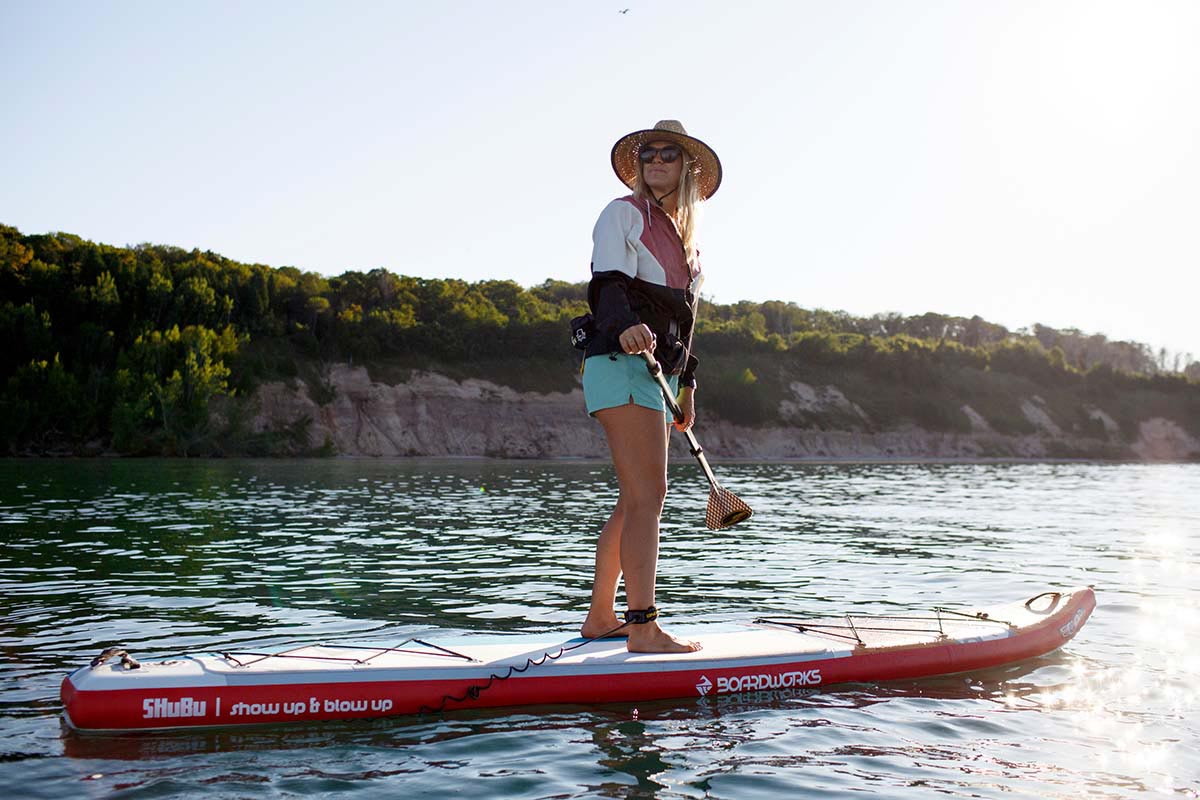
Beth Price Photography
We use affiliate links and may receive a small commission on purchases. Read more about us .
Inflatable stand up paddle boards (SUPs, for short) are taking the boating scene by storm, and it’s easy to see why. These compact vessels are easy to transport (no car rack required), surprisingly durable, stable, and efficient on the water, and versatile for activities like river expeditions, fishing, surfing, and just plain cruising. Below we break down the top paddle boards of 2024 (inflatable designs only), from recreational models perfect for beginners and casual outings to premium touring boards and activity-specific designs. For more information, see our buying advice and comparison table below the picks.
Editor’s note: We updated our stand up paddle board round-up on April 26, 2024, to add the Kokopelli Chasm-Lite as our top ultralight and packable pick. We also swept the guide to ensure our product selection is up-to-date with current prices and designs. Finally, we included sale prices at the time of publishing for all applicable boards, as many designs can be found at stellar deals most of the year.
Our Team's Stand Up Paddle Board Picks
- Best All-Around Stand Up Paddle Board: iRocker All-Around 11'
- Best Budget Stand Up Paddle Board : Tower All Around S-Class
- Best Touring Stand Up Paddle Board : Red Paddle Co Sport 11’3”
- Best Ultralight/Packable Paddle Board : Kokopelli Chasm-Lite
- Best Stand Up Paddle Board/Kayak Hybrid: Tahe 10’6” Beach SUP-Yak + Kayak Kit
- Best Multi-Person Paddle Board: Gili 15’ Manta Ray
Best All-Around Stand Up Paddle Board
1. irocker all-around 11’ ($750).
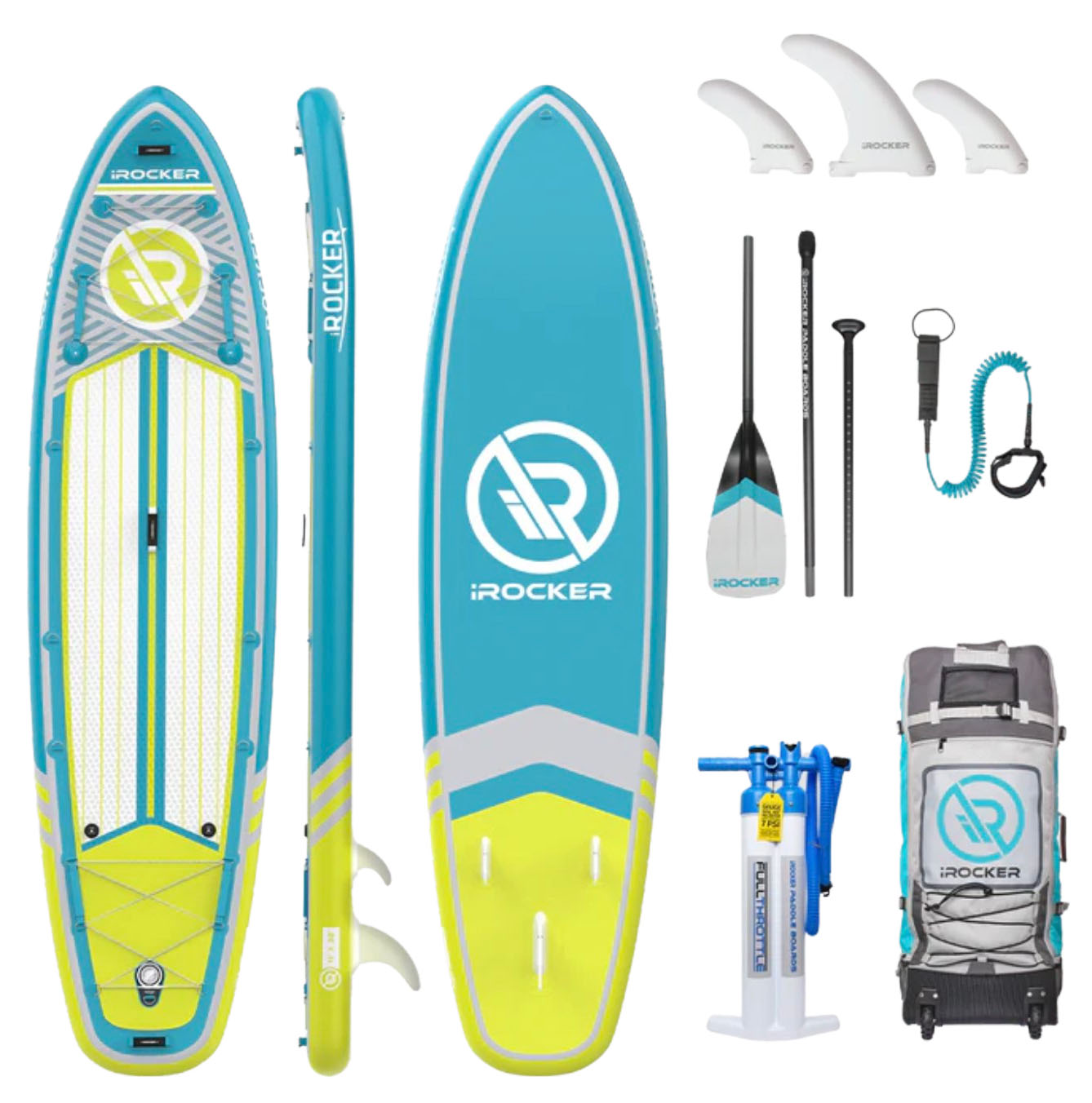
For the best combination of quality, affordability, and convenience, the iRocker All-Around tops our list of inflatable stand up paddle boards for 2024. In short, the All-Around is the full package for those just getting started: You get a premium board from one of the top brands in the industry, in addition to a leash, dual-chamber pump, removable fins, wheeled bag, and lightweight carbon fiber paddle. On-deck storage is fully functional for most uses, including an assortment of D-rings and cargo bungees, and the generous pad can even pull double duty as a yoga mat. It all adds up to a great starter kit that’s plenty durable to last you well into your paddling career, whether you’re out on the lake, down by the bay, or even catching a bit of whitewater.
The All-Around finds a nice middle ground between budget models and premium boards, which is also reflected in the $750 price tag (note: It's on sale for $350 off at the time of publishing). It's admittedly not the most high-performance SUP here—the Red Paddle Co Sport below is decidedly faster, and the Hala Rado is more stable in whitewater—but the iRocker is everything you'll need for flatwater paddling, and its build quality far exceeds that of more affordable designs. We also love the All-Around’s option for a single, twin, or tri-fin setup, which allows you to tailor stability and speed depending on your needs. Finally, owned and operated by paddlers, iRocker is known for their great customer service, along with a competitive warranty (one to three years depending on the board and issue). Experienced paddlers—including confident beginners—might also consider stepping up to the All Around 11' Ultra , which is pricier at $800 ($500 on sale) and has a lower weight capacity (290 lb.) but is nearly 5 pounds lighter and much more compact. See the iRocker All-Around 11'
Best Budget Stand Up Paddle Board
2. tower all around s-class ($849).
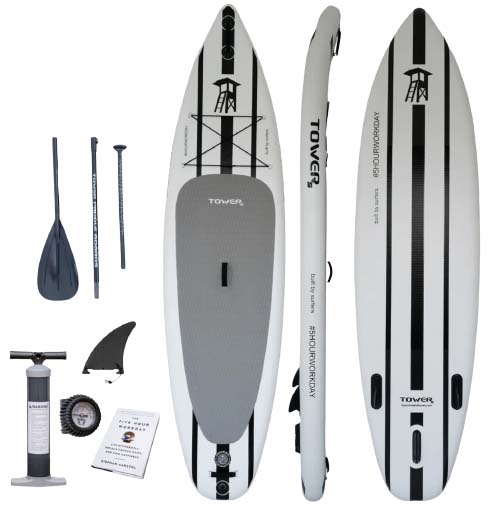
Budget paddle boards can run you as little as $200, but most are plagued with thin, single-layer construction that can result in durability and rigidity issues over time. While this can be serviceable for new paddlers who haven’t experienced the joy of a rigid, skookum board, we don’t recommend it for heavy use. If you’re looking to pinch pennies but don’t want to compromise on quality, the Tower All Around is a great place to start. With fusion construction that’s twice as thick as a single-layer board, the All Around offers similar durability and rigidity to most premium models here, including those from iRocker, Red Paddle Co., Isle, and more. For just $399 on sale (we've never seen it listed at full MSRP), that’s worth talkin’ about.
The Tower All Around is one of the least compromised budget boards on the market, but it is a little pricier than the competition (especially compared to the Roc Explorer below, which is sometimes available for as little as $200 on Amazon). And while it does come with all the necessary trimmings for the water—including a detachable fin, three-piece paddle, and hand pump—Tower noticeably omitted a travel backpack, which we’ve certainly missed when schlepping the board from our shed to the put-in (you can purchase one separately for $59 on sale). But this is a relatively small gripe in the grand scheme of things, and worth it to us for the All Around’s quality of construction and reliability. See the Tower All Around S-Class
Best Touring Stand Up Paddle Board
3. red paddle co sport 11’3” ($1,599).
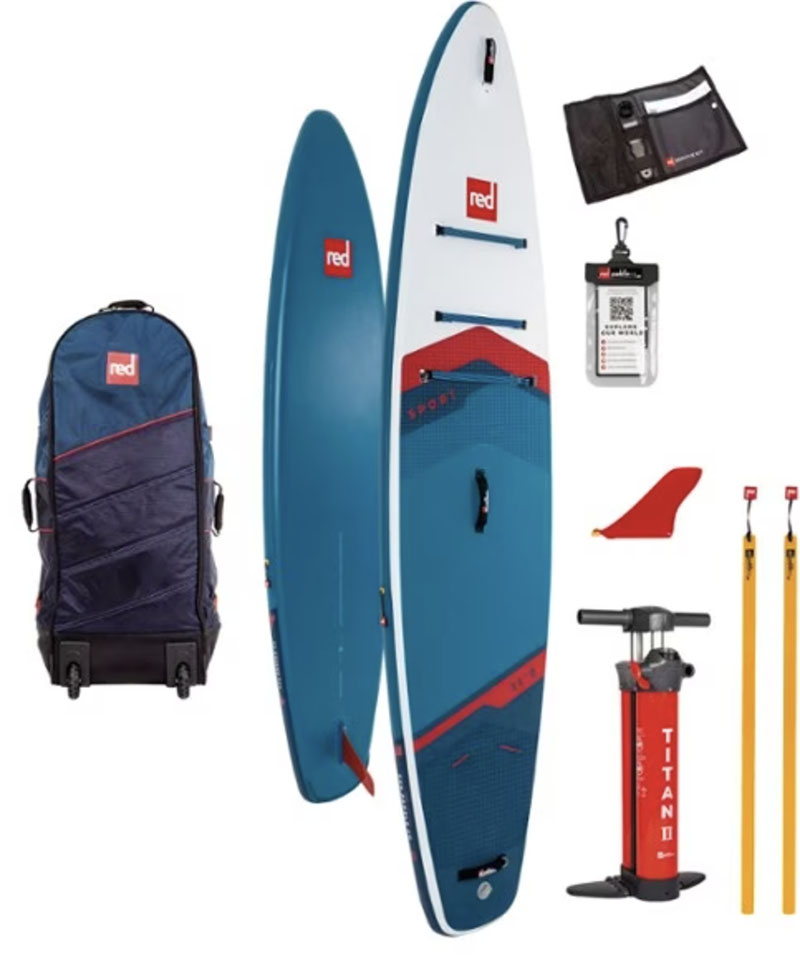
U.K.-based Red Paddle Co (RPC) is an industry leader in paddle board innovation and design, with a top-notch selection of inflatable paddle boards for everything from whitewater and windsurfing to yoga and racing. Their Ride ($1,299) is one of the most premium all-rounders, but the longer Sport is our top pick for paddlers looking to travel greater distances or at faster speeds. At $1,599 the Sport is undeniably expensive, but the result is a premium touring design that has few rivals. You get a relatively narrow, 32-inch width for cutting efficiently through the water, a single fin for tracking (traveling in a straight line), 4.7 inches of platform that keep you svelte and close to the water, and a Speed Tail for both efficiency and maneuverability. Finally, with multiple sizes—11’0”, 11’3”, and 12’6”—you can customize length depending on your weight (remember to factor in your gear as well).
It doesn’t get much more premium than a Red board, but given the Sport’s price point, you’ll have to ask yourself if you really need this level of performance. After all, touring models like the Thurso Surf Expedition and NRS Thrive below can get the job done for most paddlers at about half the price. But it’s hard to beat the durability of a Red board (they put them through extensive testing, including running over a board with a 22.5-ton tractor), and are all backed by a generous five-year warranty. Further, the Sport comes with add-on stiffening battens for each side rail, which give it more rigidity while still maintaining a fairly low weight (however, these are so difficult to slide in and out that we often don’t bother). All in all, the Sport is an ideal companion for fitness paddling or multi-day excursions, if you can stomach the cost. And for a larger deck to shuttle more overnight gear, the 12-foot 6-inch Voyager is a step up in size (it also comes in 12'0", 13’2”, and 15’0” lengths). See the Red Paddle Co Sport 11'3"
Best Ultralight/Packable Paddle Board
4. kokopelli chasm-lite ($999).
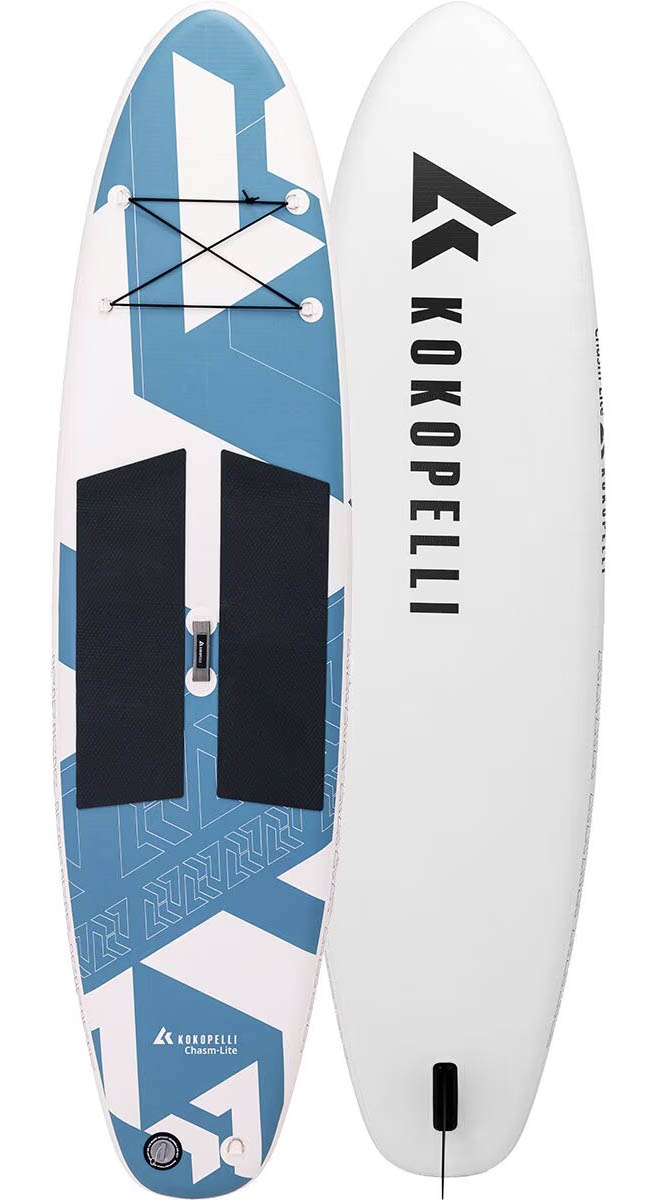
Oh, the places you'll go on a stand up paddle board. And when your board packs down into an easily totable dry-bag backpack, the adventure list grows even longer. Kokopelli is known for their ultralight packrafts , but the Chasm-Lite makes it clear their ambitions lie in getting off the beaten path on the water in any vessel. With a weight of just 12 pounds 14.4 ounces, Kokopelli touts the Chasm-Lite as the lightest paddle board on the market—and after extensive research, we haven’t been able to disprove that claim. The whole kit packs down into a bundle a little larger than a roll of paper towels (packed size is 16 x 9 x 8 in. for just the board). With this streamlined build, the hike to your favorite alpine lake becomes a whole lot easier.
That said, there are a few downsides to the Kokopelli’s light and packable design. First off, the drop in weight and ultralight materials come with sacrifices in durability compared to the board’s heavier brethren, which feature fusion or double-layer constructions that are much more confidence-inspiring and will hold up better over the long term. Its small size and relatively low load capacity (250 lb.) also make it unrealistic to paddle with abundant gear and a pet. And even though it’s pounds lighter than its closest competitor, it’s still double the weight of some packrafts, which are purpose-built for hauling deep into the backcountry. But SUPs arguably are the most versatile option for most—they're also just plain fun—earning the Chasm-Lite our vote as the best option for hitting the trail, paddle in hand. Of note: We previously had Pau Hana's 10-foot-10-inch Solo Backcountry ranked here, although it's around 2 pounds heavier and less packable than the Kokopelli. See the Kokopelli Chasm-Lite
Best Stand Up Paddle Board/Kayak Hybrid
5. tahe 10’6” beach sup-yak + kayak kit ($700).
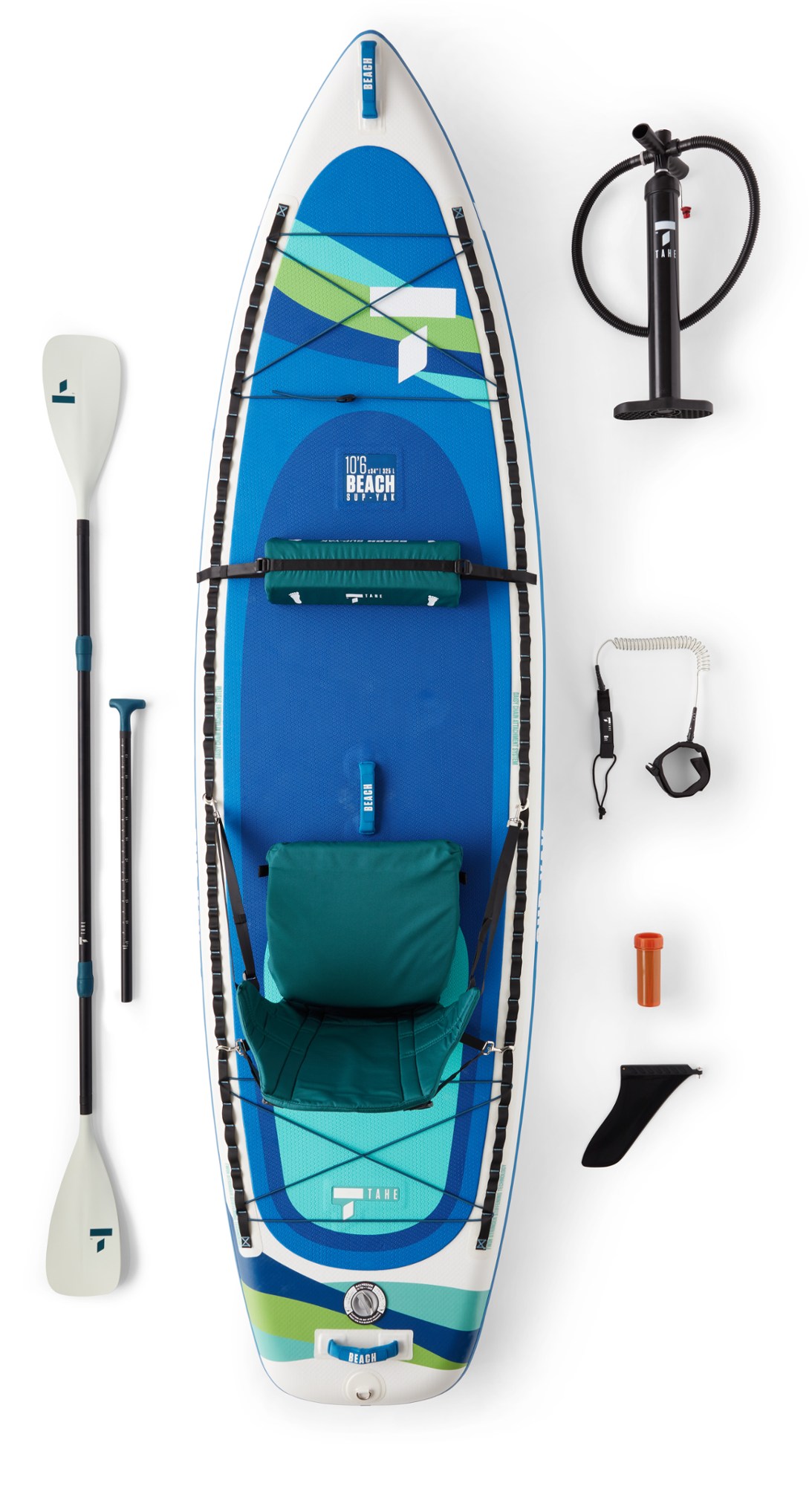
If you’re the kind of paddle boarder who likes to sit down from time to time, it’s worth looking into a hybrid SUP/kayak design. Tahe’s Beach SUP-Yak is our current favorite—for $700, you essentially get two activities in one. Without the included Kayak Kit, you get a standard-sized SUP with an extra-wide, 34-inch deck. Add the Kayak Kit, which includes a raised seat, footrest, and adjustable paddle, and you get a comfortable sit-on-top kayak. Rated for up to 300 pounds, the 10’6” Beach SUP-Yak is sturdy enough to handle you and your smaller loved ones (be it furry friend or child) with ease.
A lot of paddle board brands give you the option of adding a kayak seat to your order, including iRocker, Blackfin, Isle, and Thurso. But what we love about the Tahe is its daisy chain attachment system, which runs the length of each side and allows you to situate the seat exactly how you want it. The plush footrest is also a welcome feature for both comfort and performance—with something to push your feet against, you can move a lot of water with each stroke. Added up, there’s a lot to like about the Beach SUP-Yak, which also comes in an 11’6” version for larger paddlers. If you’re willing to spend a little more, the Isle Switch 2 ($995 full price and $795 on sale) offers similar features and versatility in a more premium package. See the Tahe 10'6" Beach SUP-Yak
Best Multi-Person Paddle Board
6. gili 15’ manta ray ($1,495).
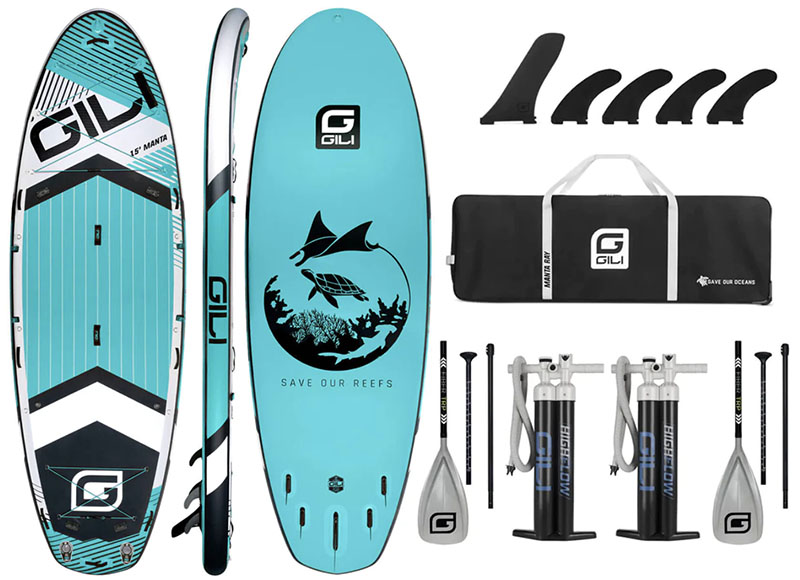
The vast majority of paddle boards are designed to suit one rider, and if you’re ambitious you might be able to sneak on a dog or small child, too. But for those who like to travel with a crew, a flotilla isn’t the only option. Gili's 15’ Manta Ray is built to handle a whopping five (or more) passengers, with a 56-inch wide and 8-inch thick platform that can accommodate up to 1,150 pounds. And it’s not just the size that matters: The Manta Ray’s thoughtful design includes two inflation valves (along with two pumps), two paddles, two large bungees, and five mounts for everything from cup holders to fishing rods or GoPros.
Nothing spells “party boat” quite like the Gili, which can also be employed as an improvised dock or roomy fishing platform. Of course the oversized board does have its compromises: At 52 pounds, it’s a lot to move around, and you’ll need a pretty dialed rowing team to get it anywhere fast. For smaller groups, Gili also makes the 12’ Manta Ray, which can accommodate up to 725 pounds. And while Gili's offering is a class act, it’s also worth checking out other multi-person paddle boards, including the Tower Xplorer 14’ (800-lb. capacity) and 15’ Isle Megalodon 2 , which has a similar capacity as the Manta Ray but lacks the Gili’s travel bag, second pump, and rear bungee. See the Gili 15' Manta Ray
Best of the Rest
7. nrs thrive 10'3" ($1,145).
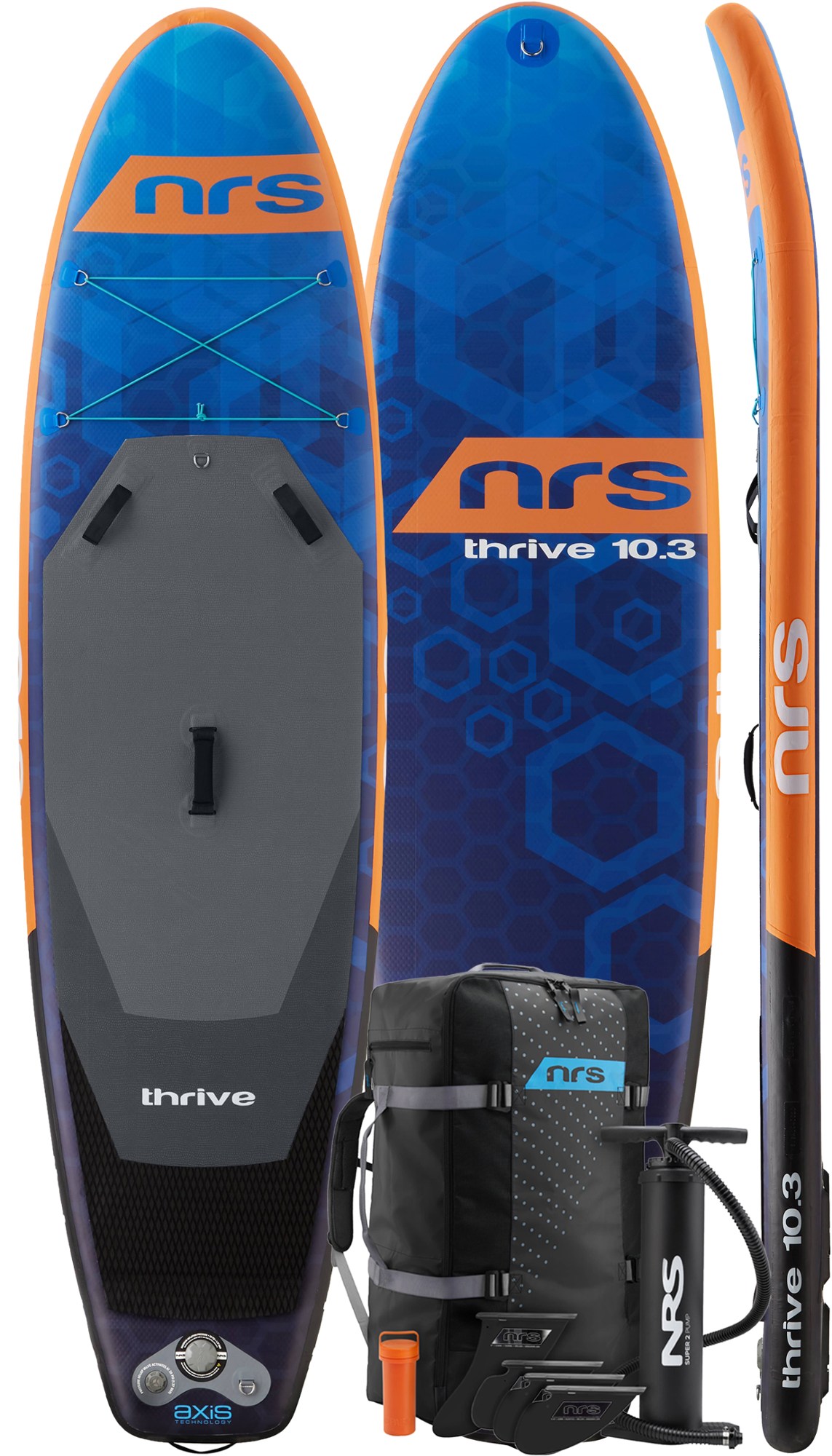
The iRocker All-Around above will get the job done for most recreational paddlers, but for the cream of the crop, look no further than the NRS Thrive. This is a primo stand up paddle board made by one of the top names in boating, with a highly durable construction and good assortment of features for everything from river running to multi-day tours. Unlike most boards here that inflate to 12-15 psi, the Thrive pumps up to a very solid 20 (higher psi = more rigidity), and a pressure release on the inflation/deflation valve guards against over-filling. And with two sets of fins—including a three-piece thruster set and a single touring skeg—you can tailor stability and speed depending on your needs, which adds a lot of versatility for new and experienced paddlers alike.
The Thrive retails for well over $1,000, but at $745 on sale—and sometimes available for even cheaper on closeout—it makes a lot more sense for new and seasoned paddlers alike. The lack of included paddle or leash takes it out of the running for our top spot, but the Thrive's premium construction still exceeds that of most (if not all) boards on our list. If you’re willing to spend up, a board like the Red Paddle Co Sport is a better (read: faster) choice for touring, and the Hala Rado below is a burlier option for serious river expeditions, with a full-coverage deckpad and 325-pound weight capacity (compared to the NRS' 200-lb. limit). But as a do-everything board, the Thrive is impressively well built and versatile, and availability in three lengths means you can get a good fit no matter your body or load size. NRS is a crowd favorite among boaters of all types, and all of their inflatable boards come with a three-year warranty. See the NRS Thrive 10'8"
8. Hala Rado ($1,199)
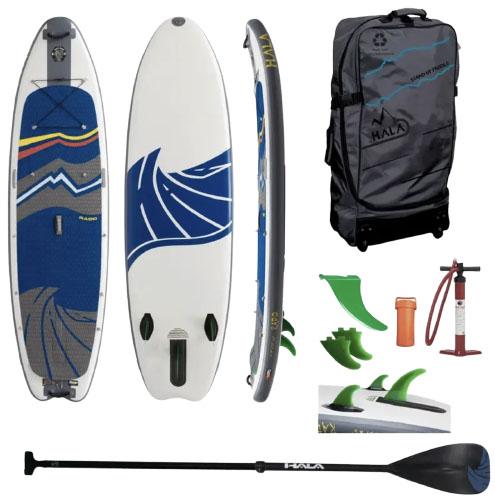
Designed and tested on the Yampa River near Steamboat Springs, Colo., Hala Gear’s paddle boards are some of the most finely crafted vessels on the market. The Rado is a premium all-rounder for expedition use, combining a rockered shape and retractable 9-inch fin (both great for tackling rapids) with a base that tracks well in flat water. Tack on a full-length diamond groove deck pad, accessories like an adjustable carbon paddle and removable fins, and a five-year warranty, and you have yourself one serious board. The Hala is admittedly overkill for recreational users, but it’s exactly what you want for remote multi-day trips.
At 10 feet 10 inches and 35 inches across, the Rado is ideal for larger paddlers or those who like to travel with a small companion or overnight gear. Hala also offers the 10-foot Radito (also $1,199), which features the same design but slightly smaller dimensions (the Radito is 34 in. in width). Compared to cheaper models here, Hala’s construction is particularly tough—most notably, they add a third, welded seam to the standard two glued seams, which increases puncture resistance and helps the Rado maintain pressure despite fluctuations in temperature. As a result, the Rado isn’t a lightweight SUP at 28 pounds 8 ounces, but for a quiver-of-one vessel that can tackle serious river trips and long-distance flatwater paddles with ease, look no further. Editor's note: The Hala is largely unavailable at the time of publishing, but we confirmed with Hala that more stock is expected by early June. See the Hala Rado
9. Isle Pioneer 3 ($695)
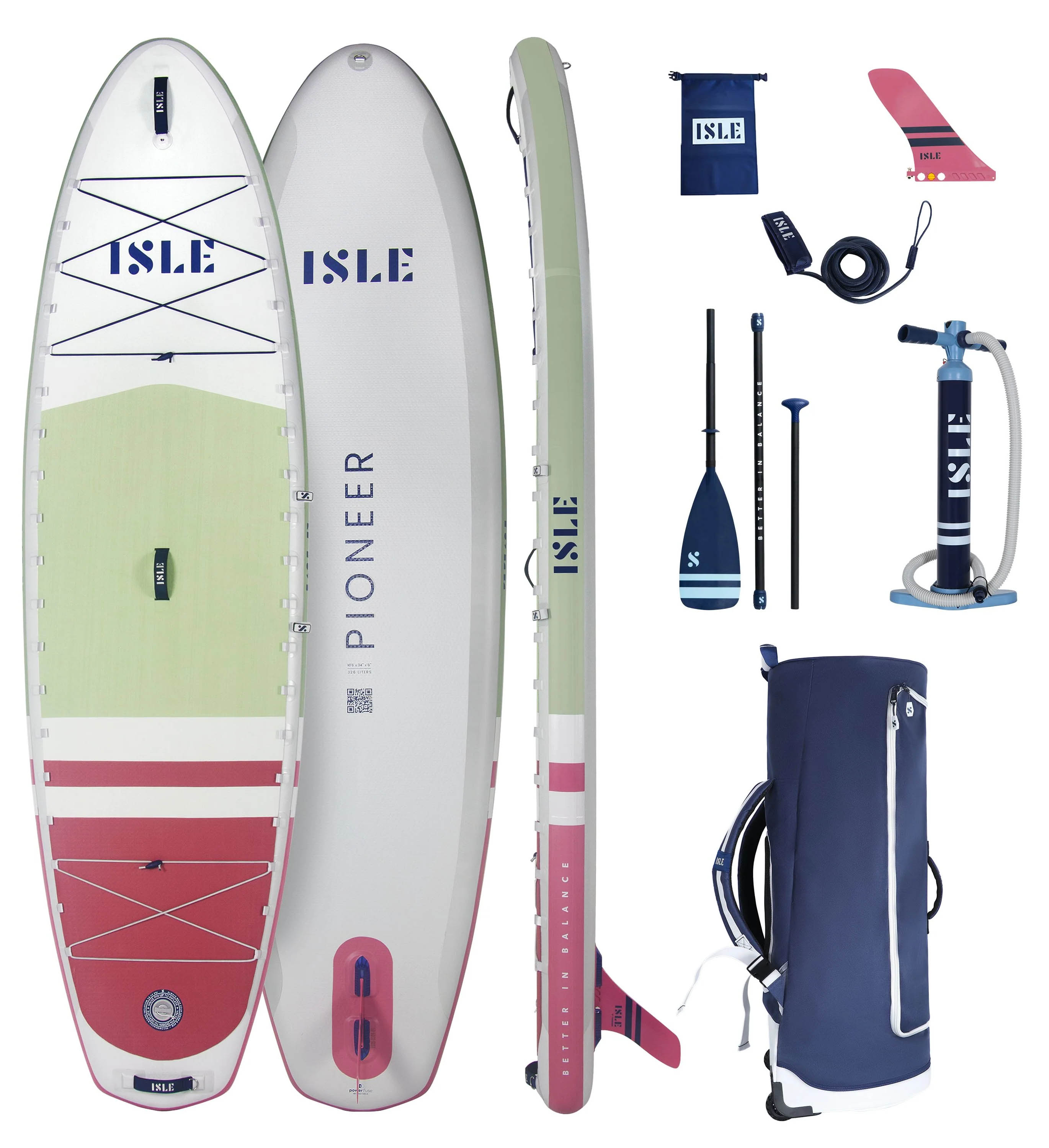
Built from the ground up by a pair of San Diego surfers, Isle has a strong reputation for quality, customer service, and thoughtfully designed products. They’re a great one-stop shop for mid-range to premium paddle boards, and their lineup is particularly easy to decipher thanks to a well-organized website with short yet descriptive blurbs, well-laid-out specs, and really helpful videos. The Pioneer 3 is their top all-rounder: It’s noticeably stable with a 6-inch thickness and extra-wide (34-in.) deck, and comes with everything you need to get out on the water, including a three-piece carbon hybrid paddle, removable fin, 8-foot leash, hand pump, and travel bag.
The Isle Pioneer 2.0 goes head to head with the iRocker All-Around above as our favorite board for new and recreational paddlers. We give the iRocker the edge for its higher weight limit (400 vs. 285 lb.), dual-chamber pump (which makes for much faster inflation), two size options, and three included fins (the Pioneer has just one)—all for around $200 less at the time of publishing. But the Isle certainly won’t disappoint for recreational paddlers, and we’re big fans of the modernized deck and side-rail aesthetic. It’s also worth mentioning Isle’s newer Pro series (including the Pioneer Pro ), which uses proprietary AirTech Prolite construction to offer over twice the rigidity of a standard SUP without compromising on weight or packability. See the Isle Pioneer 3
10. Bote Wulf Aero ($499)
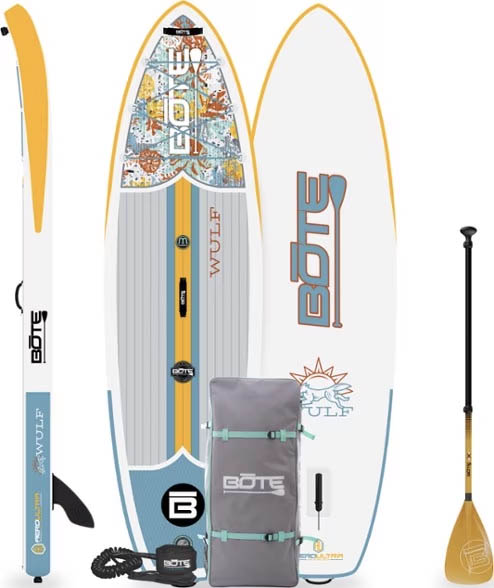
For recreational paddlers who want the ability to do it all, including fitness paddling, yoga, and casual flatwater cruising, a SUP like the Bote Wulf Aero is another quality choice. The Wulf has a fun deck design that consistently gets compliments and comes in a versatile size (10’4”) that’s ideal for paddlers up to 250 pounds—or a small adult paddler with a child or furry friend. You get the full suite of bells and whistles—multiple grab handles and D-rings, a front bungee, and a generous deck pad that we’ve found to be super grippy yet nicely cushioned for bare feet—and the fin attachment system is intuitive and secure. Finally, Bote is carried by REI Co-op, which means you can pop by your local store (depending on stock) and get a feel for the board before you buy.
Our main gripe with the Bote is its single-layer design, which has a relatively low max PSI and can flex a bit under weight (similar to the construction of the $700 Roc Explorer below). By contrast, the Tower All Around S-Class above ($399 on sale) features a more durable and stable fusion construction (also termed “double-layer” by some companies) that should hold up better over time. And for inflation, we consistently ditch Bote's single-chamber pump for our more premium (and double-chamber) iRocker pump, which gets the job done faster and more easily achieves a higher PSI. But gripes aside, we’ve been so pleased with our Wulf for everything from river floating to lake flotillas with the kids. For a more premium pick from Bote, their HD Aero is built with two layers of PVC for added durability and rigidity and tacks on features like a paddle sheath, accessory attachments, and a rear bungee. See the Bote Wulf Aero
11. Thurso Surf Expedition 138 ($899)
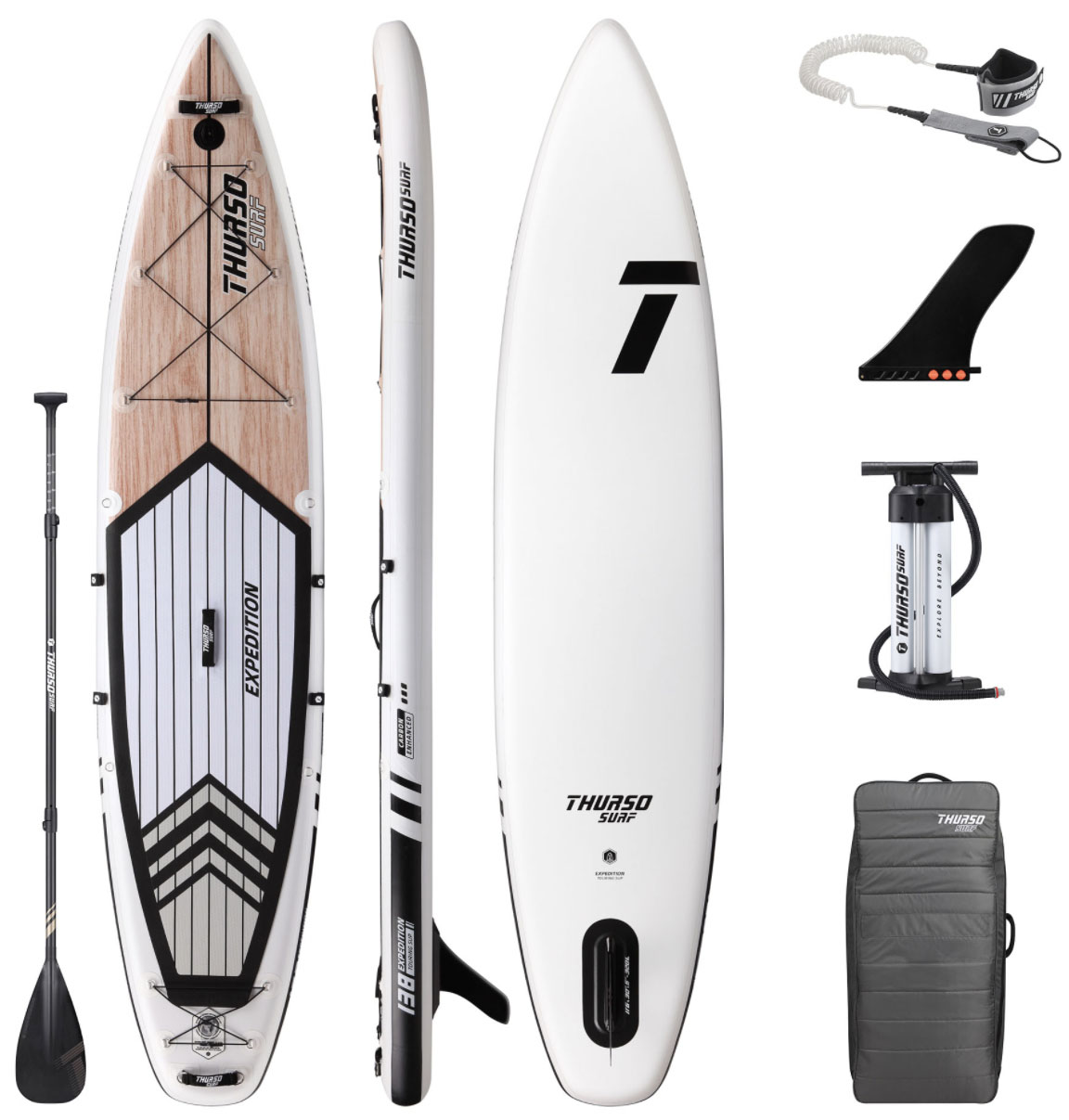
Paddlers who hit the water for long distances or multi-day trips need an expedition-ready feature set and proven performance, and the Thurso Surf Expedition 138 (which also comes in a 12’6” version called the Expedition 150) fits that bill nicely. The Expedition is impressively hardwearing with triple- and quadruple-layer PVC reinforcing the deck and sides (most boards have 1 to 2 layers throughout), which gives it rigidity on par with a hardboard. The Expedition also comes with functional and thoughtful features like a paddle holder, kayak seat attachment points, and an included carbon paddle. And the real draw for us is price: At $599 on sale ($899 full MSRP), the Expedition is one of the most affordable high-performance designs on our list and will get you out onto the water for less than much of the competition.
It’s important to keep in mind that with a touring/expedition board like the Expedition 138, you do lose some versatility for recreational cruising and activities like yoga (the board’s dimensions result in less stability overall). And unlike many all-rounders here, the Expedition also has a half-size traction pad, which makes it harder to paddle with your dog or kids on board. But within its class, the Thurso is an impressively versatile design, with speed when you need it and plenty of tie-downs when you've got expedition gear on board. For a less performance-focused model, check out the Thurso Surf Waterwalker , which is offered in three different lengths from 10 to 11 feet. See the Thurso Surf Expedition 138
12. Hala Asana ($799)
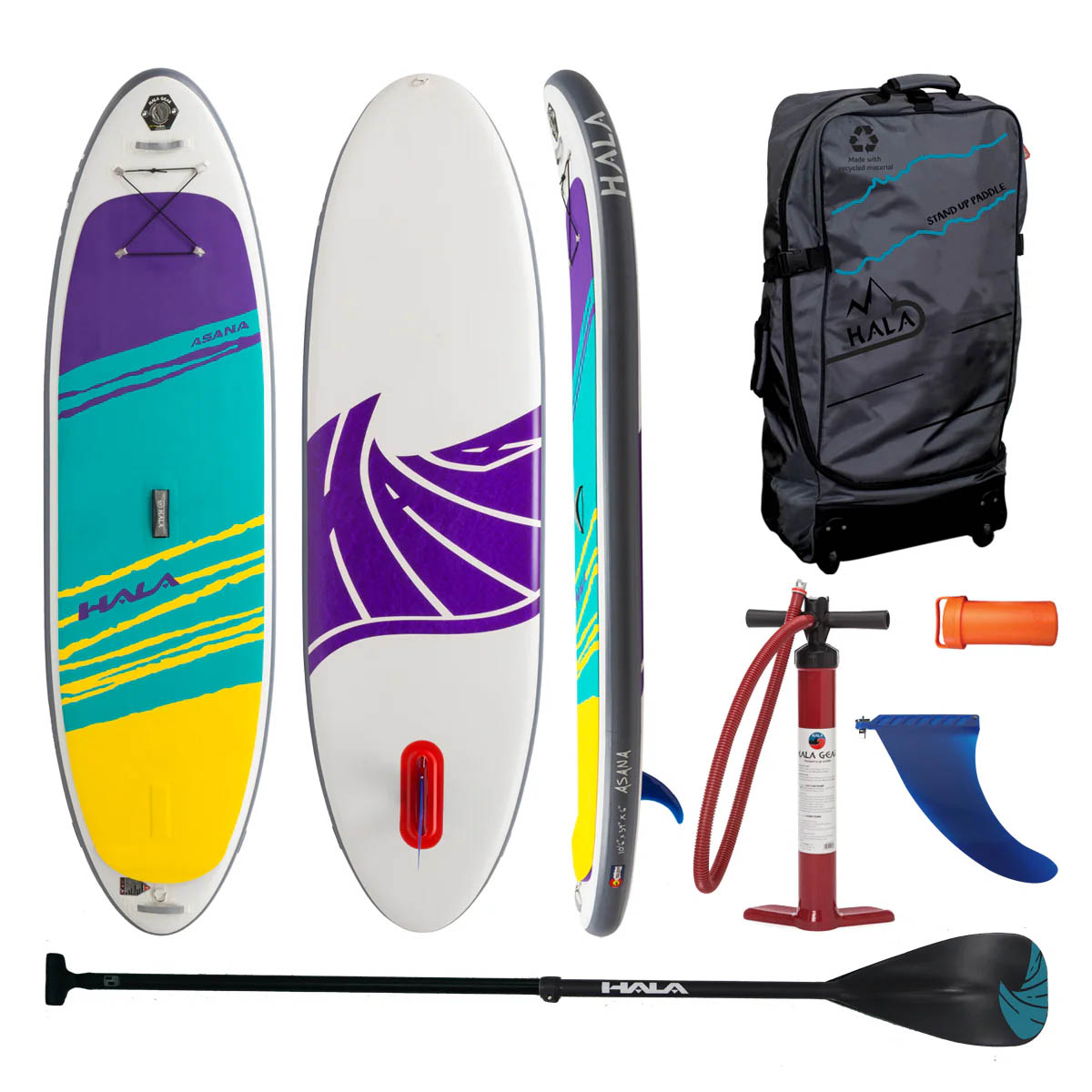
SUP yoga is all the rage, and while you could get away with doing sun salutations on most boards here, it certainly helps to have a tool purpose-built for the job. Yoga-specific boards typically have generous widths, spacious deck pads, and center handles that lay flat, so you don’t have an annoying bulge in the middle of your “mat.” The Hala Asana takes it a step further by including a front bungee for stashing your paddle and a D-ring under the nose for anchoring the board while practicing. And with your purchase, you also get an adjustable paddle with a lightweight carbon shaft (one of the best included paddles we’ve tested) and a spacious roller bag for easy transport to and from your vehicle.
The specialty build does come with some notable downsides. With a 34-inch deck and no side fins, the Asana will feel slightly boat-like while paddling, and you won’t be tracking anywhere fast. For reference, we’ve taken the Asana on Oregon’s lazy Upper Deschutes and had to paddle hard to keep up with our friend’s Boardworks Shubu . But for board-based activities, the Asana offers great stability, and we’ve loved the feel of the generous and plush deck pad. See the Hala Asana
13. Tower Xtreme 8” X-Class ($1,340)
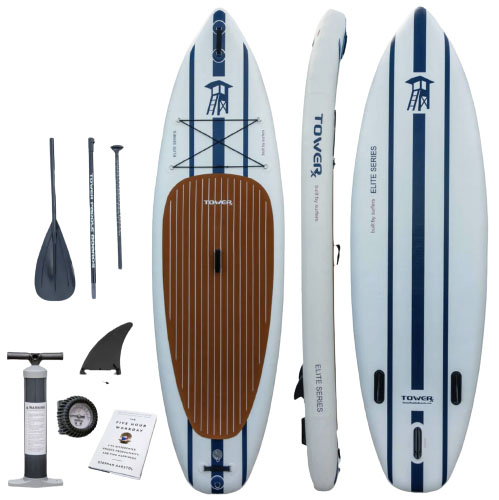
Tower’s All Around is our top-ranked budget board, but if we had to choose, we’d take out the Xtreme 8” X-Class nine times out of ten. The reason for this is the Xtreme’s generous dimensions, which give you a really nice and stable platform that can easily handle two paddlers, a dog, or some extra cargo. Most noticeably, the board is 8 inches thick, which adds a ton of flotation and stability compared to the majority of boards (which are 6 in. or thinner). You wouldn’t guess that you needed it, but after paddling the Xtreme, we’re fairly sold on the extra beefy design.
Importantly, the Xtreme is also a lot more durable than most boards here due to its double-layer, hand-glued construction. Technically, this also means that the Xtreme can be inflated to a very high pressure (up to 20 psi), although we haven’t been able to get it past 12 psi with the included pump. Weight is one of the biggest knocks of the Xtreme’s construction (it’s 29 lb.)—and the lack of a travel backpack really doesn’t help—but once the boat is on the water, this is a non-issue. All told, for larger paddlers or those who like the sounds of a stable ride, Tower’s Xtreme is well worth a look. See the Tower Xtreme 8" X-Class
14. iRocker Blackfin Model X ($750)
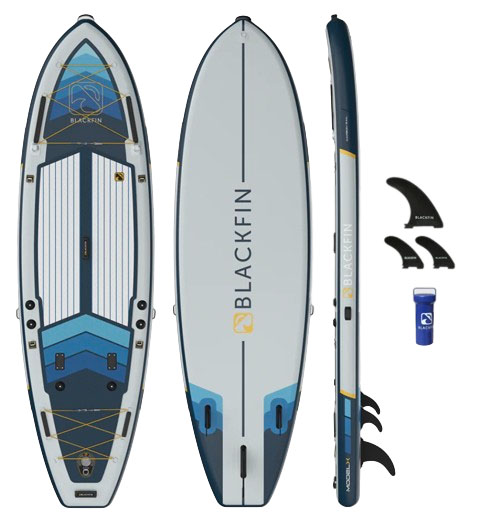
For those wanting to take to the open waters with a fishing pole, a stand up paddle board is a relatively light, easy-to-transport vessel that allows the option to sit or stand. Any stand up paddle board here would technically get the job done, but dedicated anglers will benefit from the added stability and array of attachment points that specialty models offer. Sporting a three-fin setup, 450-pound weight capacity, a whopping 20 D-rings, and carbon paddle and rail for added stiffness, the iRocker Blackfin Model X fits the bill nicely and is a true utility vehicle of a SUP. iRocker also makes it easy to tack on an assortment of compatible accessories, including a cooler deck bag, fishing rod holder, fishing rack, anchor, and even a kayak seat.
Our main gripe with the Blackfin is the lack of accessories included with purchase—$750 only gets the board and fins (note: It's on sale for $400 at the time of publishing), and tacking on a paddle, backpack, pump, and leash can put you north of $1,000. And with a generous 35-inch width and 6 inches between you and the water, the Blackfin Model X isn’t going anywhere super fast. If you need to travel a long distance to your fishing hole, it might be worth considering the Blackfin Model V instead, which is longer at 12’6” and features a narrower profile for more efficiency and speed. But for reeling in the day’s catch or paddling with a dog or child, the Model X’s spacious and stable deck certainly is a plus. Other dedicated fishing SUPs worth checking out include the Badfish Badfisher and NRS Heron , which adds 8-inch side bumpers to further boost stability. See the iRocker Blackfin Model X
15. Roc SUP Co. Explorer ($700)
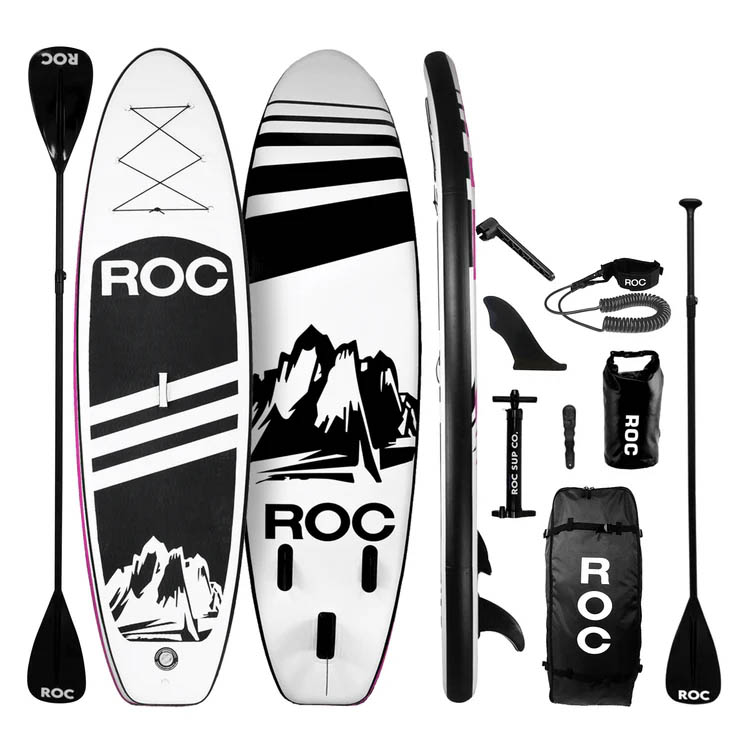
You won’t find us writing home about many “budget” boards, but the Roc earns a spot on our list for its surprisingly good combination of quality and affordability. This paddle board is lightweight at 17 pounds 9.6 ounces, stable for a wide range of paddlers (it has a weight capacity of 350 lb.), and costs just $220 on Amazon at the time of publishing. And like most other designs here, the Explorer comes ready to hit the water with an aluminum paddle, hand pump, leash, backpack, and even a small waterproof bag to keep your valuables dry. You can find other SUPs on Amazon for even less, but the Explorer is a great balance of quality and value, and Roc offers the added assurance of a dedicated customer service team and one-year warranty.
It’s true that the Roc Explorer is just a fraction of the cost of many of our top picks, but such a budget design does come with its fair share of trade-offs. Notably, you only get a few D-rings, one grab handle, and a relatively short, 10-foot length. The Explorer also uses single-layer construction, which isn't particularly durable and will lose its shape over time. But the Explorer is another great package deal for penny pinchers just getting started, and it’s for good reason that we frequently see it out on the water. See the Roc SUP Co. 10' Explorer
Stand Up Paddle Board Comparison Table
About our testing process.
Our adventurous team of reviewers at Switchback Travel saw stand up paddle boarding surge in popularity in recent years, and we couldn’t wait to jump on board—both literally and figuratively. Former senior editor Jenny Abegg collaborated with Beth Price of Beth Price Photography to put together our initial list featuring 14 of the top paddle boards in 2022. Based in the Pacific Northwest, Jenny isn’t deterred by long hikes to access serene alpine lakes and uncrowded waterways. Contributing editor Nick Mott took over the guide in 2024. Currently based in Montana, Nick has paddled all over the West, from the deep wilderness to the Yellowstone River in his backyard.
Our collective experiences on the water—along with feedback from contributors and the online paddle board community—helped us whittle down our list to the 15 picks you see above. When we put stand up paddle boards to the test, we look at basic characteristics like hull shape, board size, and weight. We also evaluate overall functionality in a variety of conditions, from glassy lakes to mellow whitewater, and take into account which accessories (if any) are included with purchase. To reflect the wide variety of paddle boards and paddle boarders, we’ve included everything from entry-level options for those just starting out to specialty designs for backcountry exploration. As the market changes, we will continue putting new and noteworthy designs to the test, adding any standouts to the list as we go.
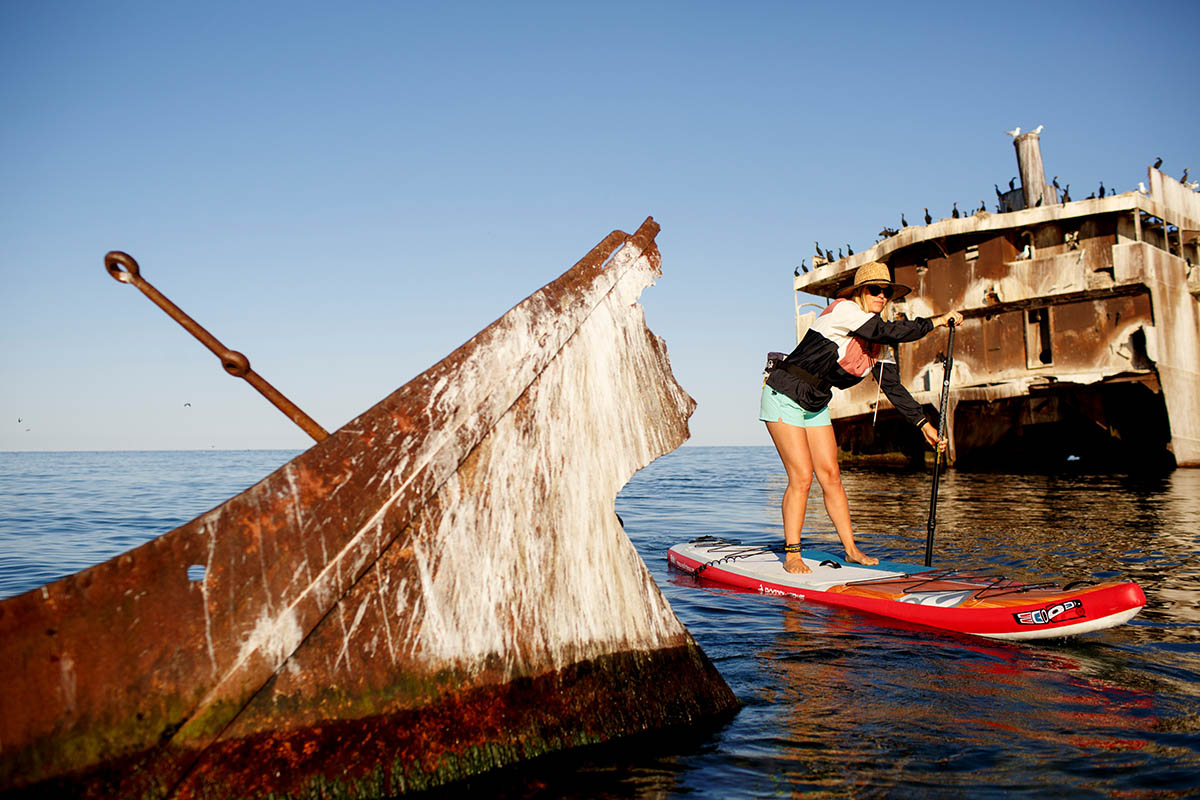
Stand Up Paddle Board Buying Advice
Stand up paddle board categories, sup pricing, inflatable sup dimensions and volume, hull shape: planing vs. displacement, weight and packability, construction and durability.
- PSI (Pounds Per Square Inch)
Pumps and Inflation
Inflatable sup accessories, stand up paddle boards for kids, solid vs. inflatable sups.
Stand up paddle boards (SUPs) run the gamut from entry-level cruisers ideal for flatwater floating to sleek 14-foot models built to slice efficiently through the water. To narrow down which style is best for you, you’ll want to identify what kind of water you’ll be paddling—flatwater, whitewater, ocean waves, etc.—and what type(s) of activities you’ll be doing while on your board—fishing, yoga, cruising, or multi-day tours, for example. To help, we’ve broken down our picks into three main categories: recreational, specialty, and touring. Recreational By far, the most popular style of paddle board is the recreational board, built for casual use, flatwater cruising, and mellow whitewater use. Recreational boards have a rounded, planing-style hull (for more, see our section on “ Hull Shape ” below), are between around 9.5 and 11 feet long, have widths of 30 to 34 inches, and generally come with three fins for added stability. If you’re going to own just one SUP, boards in this category are far and away the most versatile. And there’s no shortage of options available, from premium models like the iRocker All-Around 11' to budget boards like the Tower All Around S-Class.
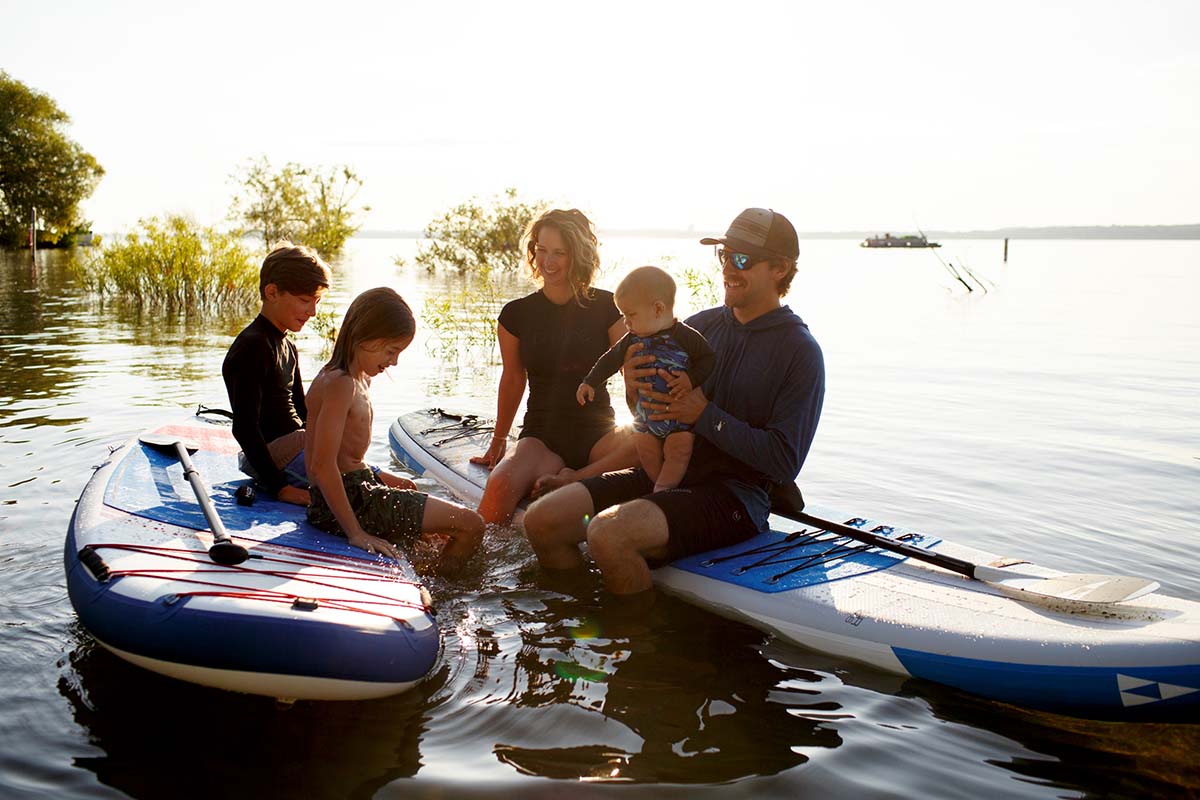
Specialty Our specialty category is a catch-all for boards designed for activities like yoga, fishing, surfing, and whitewater. For many of these activities, you can get away with using a recreational board, but committed yogis, anglers, surfers, and expedition-goers will value the sport-specific deck styles, attachment points, and extra features of a dedicated model.
More specifically, if you plan to do yoga on your board, you’ll want to look for a generous deck pad with a relatively flat surface (deep grooves will be uncomfortable against your skin), a center handle that lies flat (some come with handles along the edges instead), and a bungee system at one end to keep belongings safe. Anglers will want a board like the iRocker Blackfin Model X that features fishing rack attachment points, multiple bungee systems and an assortment of D-rings, and perhaps the option for a kayak seat. Finally, those tackling whitewater or heading out on long expeditions will be best matched with models like the Hala Rado, which features a single fin, durable construction, and no shortage of deck tie-down points. Touring Whether you use your SUP for daily fitness or multi-day camping trips, if you’re logging miles on the water, you’ll likely want a touring-focused design. In general, these boards are longer than recreational SUPs (usually in the 11-14-ft. range), narrower (less than 32 in. wide), and use a single fin for excellent speed and tracking. Some also feature a high weight capacity (for example, the Thurso Expedition can handle 330 lb.) and lots of bungees and tie-down points, which helps to accommodate extra gear for those who like to go far and fast. Most of these designs also have a tapered nose that still maintains a bit of a rocker, but the speediest feature displacement hulls like that of the Thurso Surf Expedition 138 .
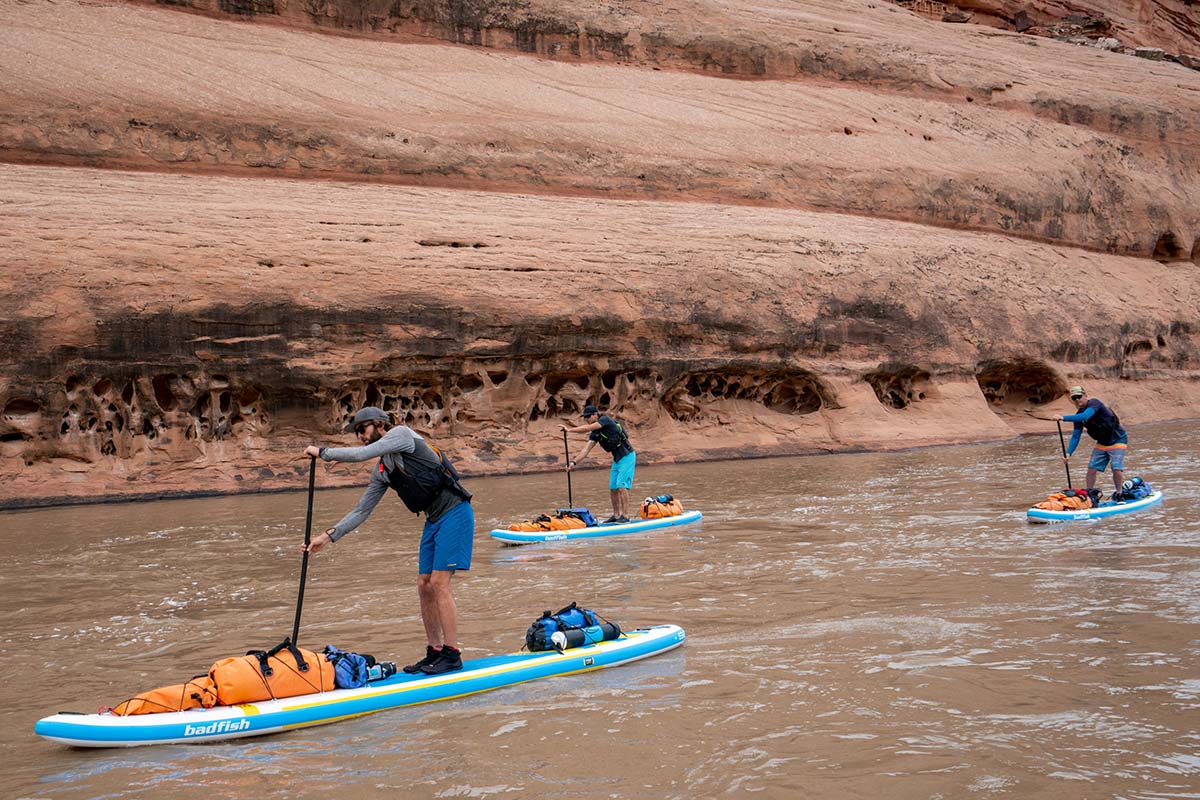
On our list above, we’ve included everything from massive, high-end boards like the Gili 15’ Manta Ray, which runs nearly $1,500 at full price, to entry-level designs like the Roc SUP Co. Explorer , which can be found on sale for only $220 on Amazon at the time of publishing. With paddle boards (as with most outdoor gear), you do get what you pay for: Budget boards typically have thin, single-layer constructions and come with heavy plastic or aluminum paddles. While these boards make inherent sacrifices in durability and rigidity, most recreational paddlers really don’t need anything more for casual floats. That said, if you’re looking for top-notch performance for activities like touring, yoga, or surfing, we recommend spending up for one of the more premium (read: pricier) models. Along with a more solid build, these boards will get you a design purpose-built for what you need it for—be it speed, white water-worthiness, or a flat and stable surface for downward dog.
If you’ve already started your research, you might’ve noticed that many brands feature sales on virtually all their boards. This is sometimes a strategy to make buyers feel like they’re getting a good deal, but that’s not to say there aren’t genuine steals to be found online. Above, we’ve indicated the full MSRP for every board on the list, along with the sale price—if available—at the time of publishing. If the board of your dreams seems too pricey, it's worth diving in a little more to see if you can find a discounted offering. Also, be aware that many of the higher-end brands offer excellent customer service and multi-year warranties, both of which are worth taking into account from a long-term investment standpoint.
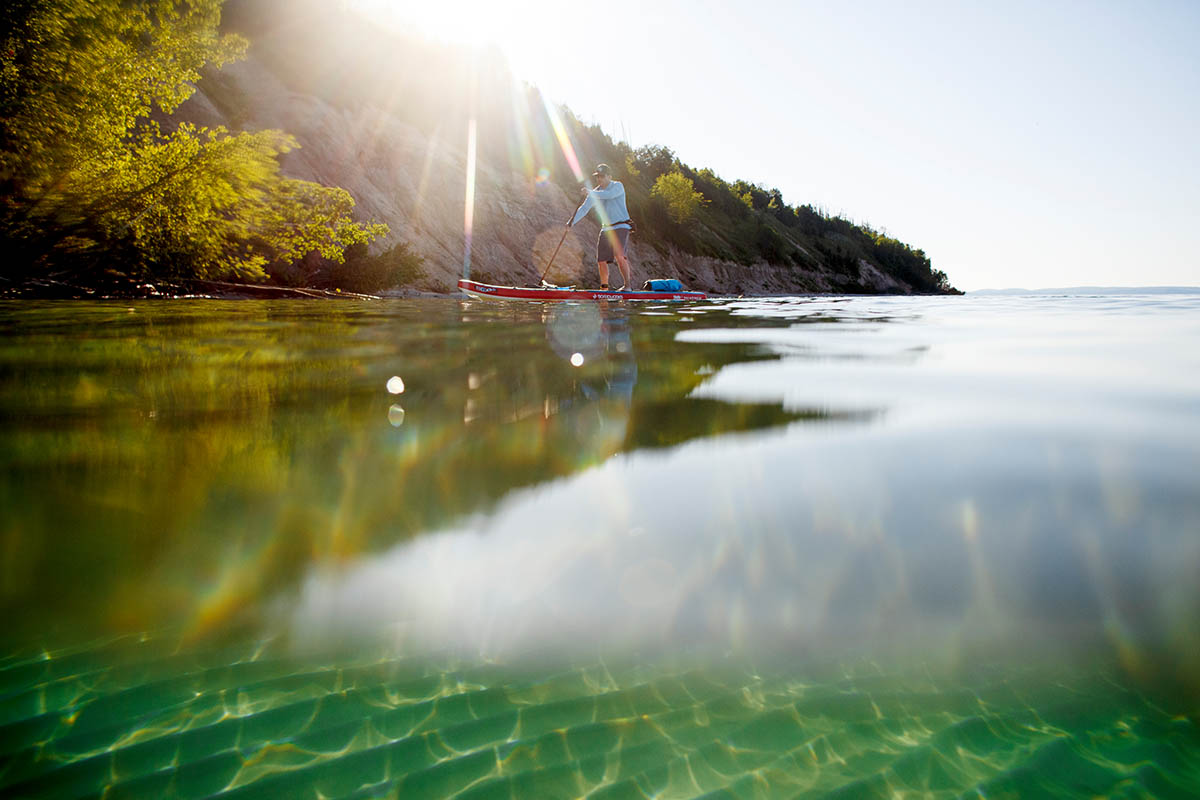
Length Most recreational paddle boards are between 9 and 11 feet long, while touring- and racing-focused designs can be as long as 14 feet. A basic rule of thumb is as follows: the shorter the board, the less surface area it will have and the more maneuverable it will be. Other dimensions like width and thickness matter too, but generally speaking, shorter boards excel on flat water where you don’t need the extra stability (a super long board can be overkill for casual paddling), while longer models travel straighter and faster and are favored for open water and touring.
In addition to the category of board and intended use, choosing the right length of your SUP depends on the weight of the person riding it. Many manufacturers provide a recommended weight range: The NRS Thrive , for example, recommends the 9’10” version for paddlers up to 180 pounds, the 10’3” version for paddlers up to 200 pounds, the 10'8" version for paddlers up to 250 pounds, and the 11' version for paddlers up to 275 pounds. Simply put, a shorter board is lighter and has less surface area, so heavier paddlers will push it further down into the water, making it less stable and more difficult to ride. Once you’ve settled on your desired style of board and even the specific model, you can choose a final length based on the paddler. And keep in mind that not all boards are offered in multiple lengths, but we certainly appreciate the option when they are.
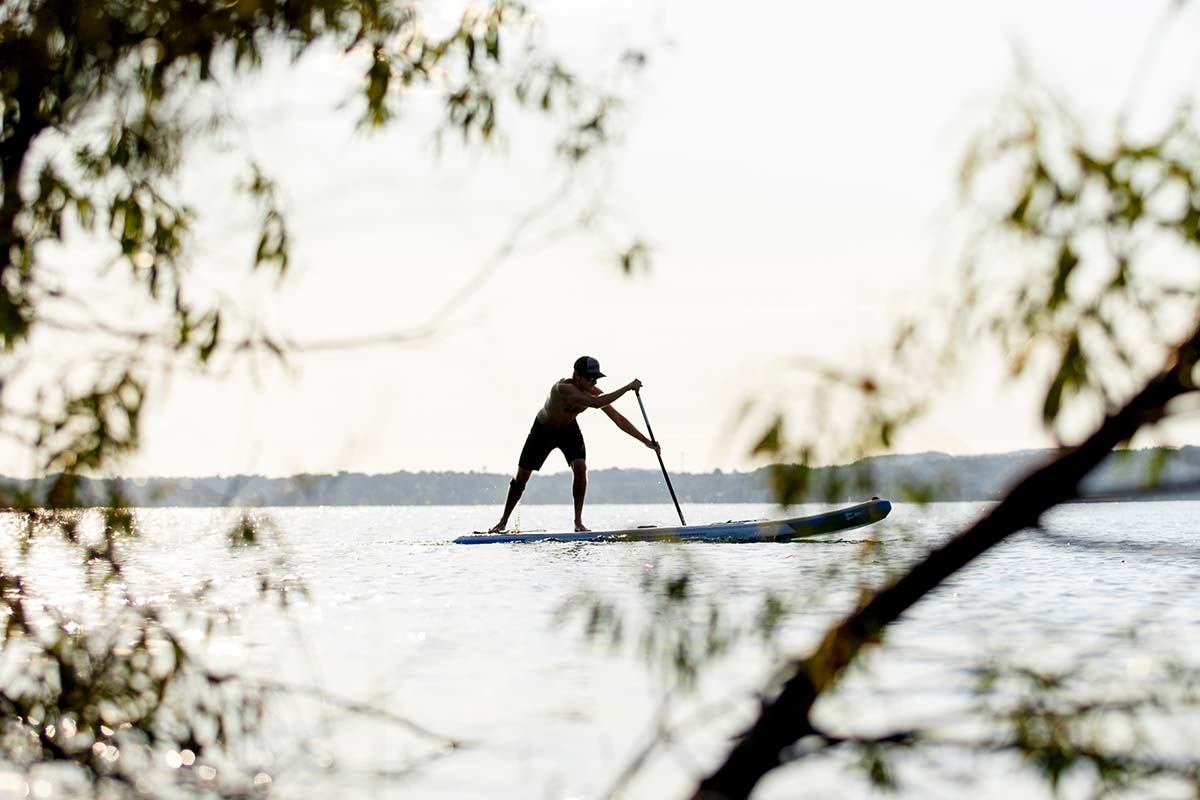
Width Most recreational and specialty SUPs are between 32 and 35 inches wide, while touring designs are as narrow as 25 inches. Again, generally speaking, a narrower board will be faster while a wider board will be more stable. If you’re just starting out, we recommend sticking with a board with a width around 32 inches, such as the iRocker All-Around 11' , which will provide ample maneuverability without making you feel unbalanced. Thickness Most inflatable stand up paddle boards are 6 inches thick, but our list spans from 4.7 to 8 inches. It’s important to find the sweet spot here: you’ll know a board isn’t right for you if you feel like you’re sinking (too thin) or like your center of gravity is too high off the water (too thick). In general, smaller paddlers will want to opt for a thinner board, while heavier paddlers will want to bump up to a thicker (6 to 8-in.) board. And finally, it’s important to keep in mind that many budget boards will create stability by increasing thickness rather than using higher-quality materials. It’s a shortcut, and certainly has its downsides—if a board is too thick, it can feel unwieldy and boat-like on the water.
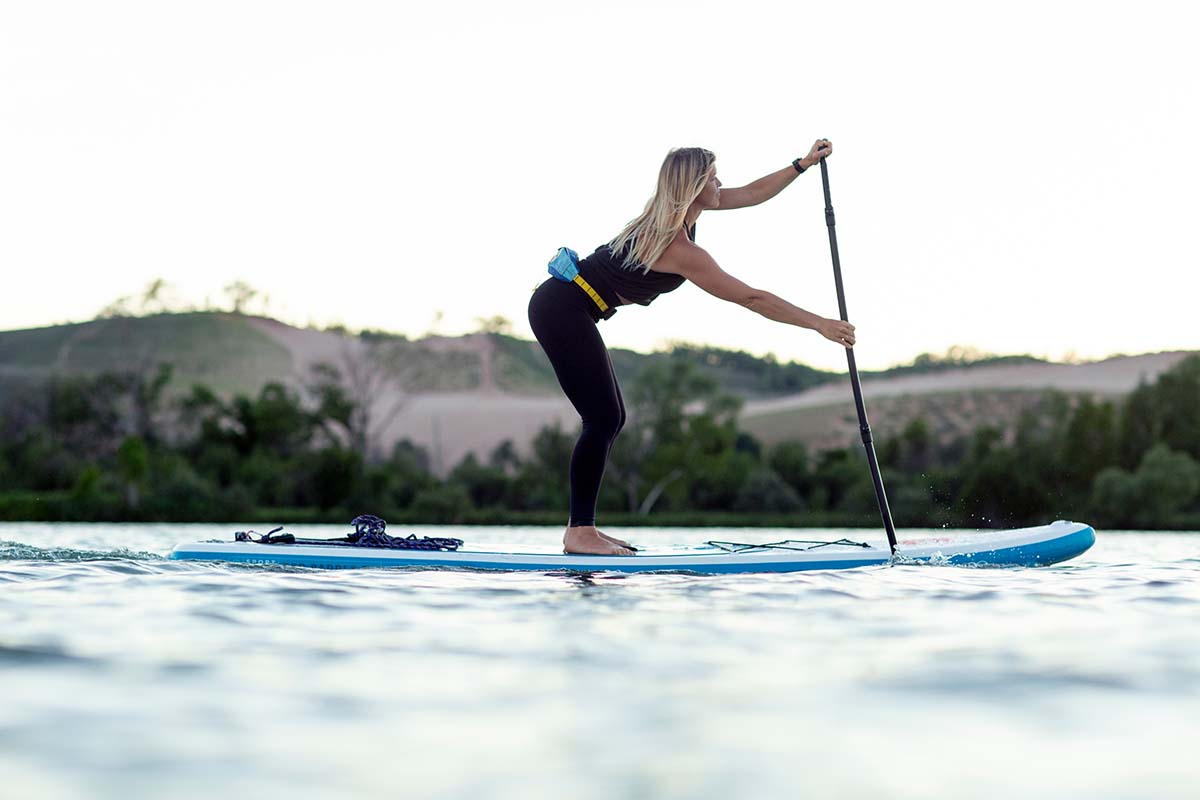
Volume An inflatable paddle board's volume is a measurement of its buoyancy and ranges from about 160 to 380 liters for inflatable models (keep in mind that this number varies for hardboards). A board with too little volume (especially one with a displacement hull) will drag and move inefficiently through the water, while one with too much will feel noticeably unstable, imbalanced, and difficult to control. As a general rule, most paddlers can multiply their weight plus the weight of their gear in pounds by 1.4 in order to determine their maximum volume. For example, a 180-pound paddler with 10 pounds of gear should look for board with a volume of 266 liters or less (190 x 1.4 = 266). And thankfully, most manufacturers specify a board’s weight capacity alongside its volume, which minimizes the guesswork.
Stand up paddle boards have one of two main hull shapes: planing or displacement. The lion's share of stand up paddle boards fall into the planing category, which means their nose is wider, flatter, and has a round, rockered tip to float on top of the water. This shape is great for stability and maneuverability and does a nice job keeping the board afloat on choppy water. SUPs with planing hulls are typically designed for recreational cruising as well as sports like yoga, fishing, and surfing.
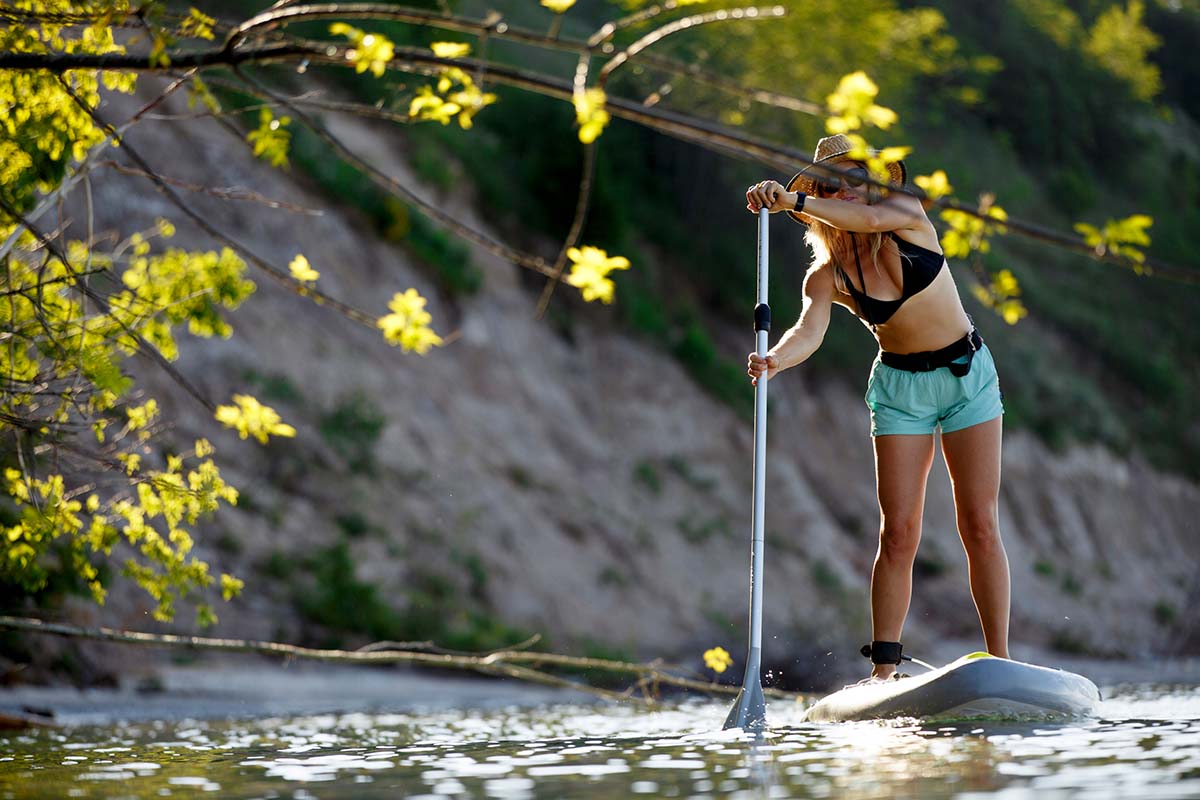
Displacement hulls, on the other hand, are pointed (similar to a kayak) and built to cut through the water with their aerodynamic shape. These are designed to go in a straight line and are a great match for those concerned with speed, with the major downside being less stability. For activities like touring, racing, or even logging fitness miles on your local waterway, a paddle board with a displacement hull is without a doubt the best match. Finally, some of the most versatile boards (the Red Paddle Co Sport 11’3” , for example) merge the two hull styles for a combination of both speed and stability.
Inflatable paddle boards range in weight from around 13 pounds (the Kokopelli Chasm-Lite tips the scales at 12 lb. 14.4 oz.). You can tell a lot about a board from it's weight—in general, those with beefier (read: more durable) constructions will weigh significantly more than those with single-layer builds. In terms of packability, the most compact boards fit into a carry-on-sized pack, while others are so large that they need a roller bag to transport. Weight and packed size won’t be top considerations for everyone, but they are critical for travelers, paddlers who plan to tote their paddle board long distances before putting in, or those limited on storage space in their vehicle.
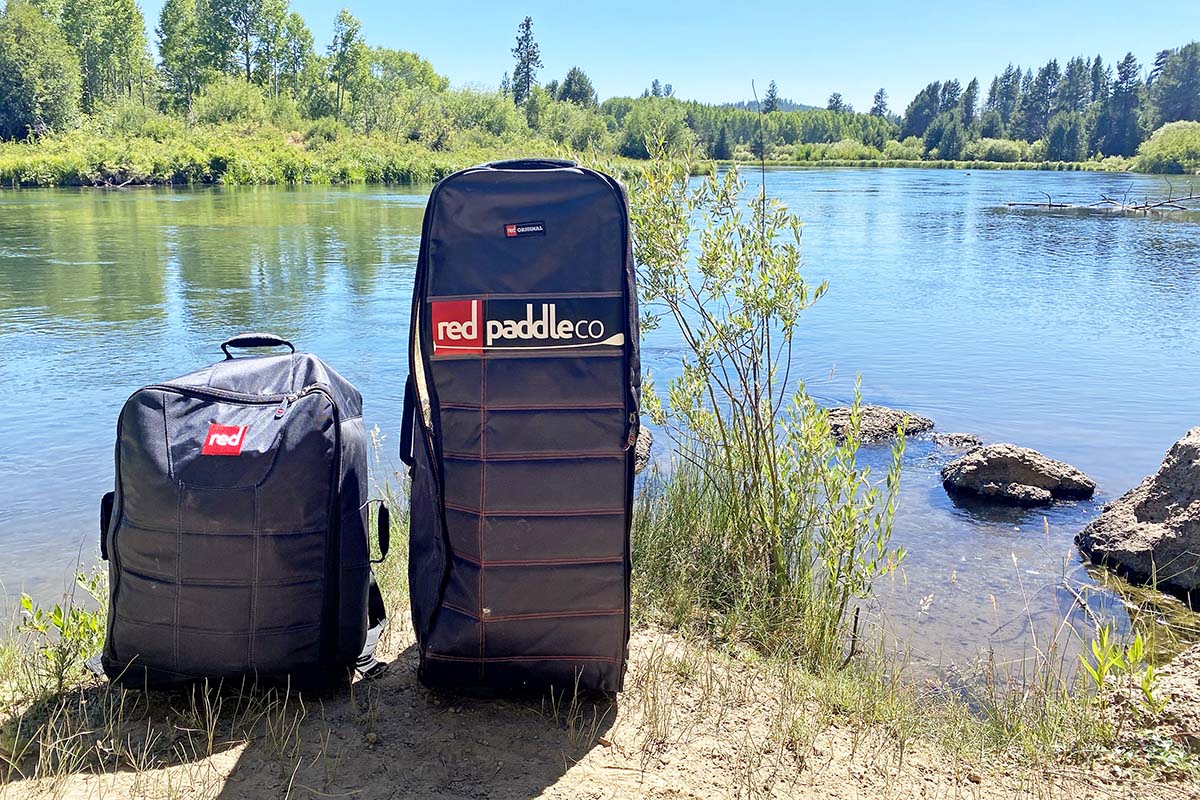
Despite their inflatable nature, stand up paddle boards are not your standard blow-up pool toy. In order to achieve rigidity on par with hardboards, inflatable models use an innovative technology called “drop-stitch” construction. Here, two sheets of fabric (the top and bottom) are connected by thousands of threads, which give the board its structure. The edges of these sheets of fabric are then joined by a narrow strip of material on each side (“rails”) and coated with liquid PVC. Higher-quality boards are most often made with two layers of PVC (dubbed “double-layer”), which increases durability and stiffness. At the premium end of the market, some manufacturers add a third or fourth layer or a hybrid layer (such as Red Paddle Co’s MSL Fusion, Hala's carbon stringer, or Isle's Airtech Prolite) to their construction, and some paddle boards even feature stiffening strips to add onto the rails for increased rigidity.
This might come as a surprise to many, but inflatable paddle boards are actually incredibly durable pieces of gear. In fact, there’s a big argument that they're more robust than hardboards, as they’re able to give upon impact and can be transported and stored away from the elements. Even budget-friendly, single-layer boards are reasonably hardwearing and long-lasting, and it’s rare to see inflatable SUPs form a leak from standard wear and tear. That said, it’s always important to keep a repair kit on hand (as we outline below), since one small leak can have major implications.
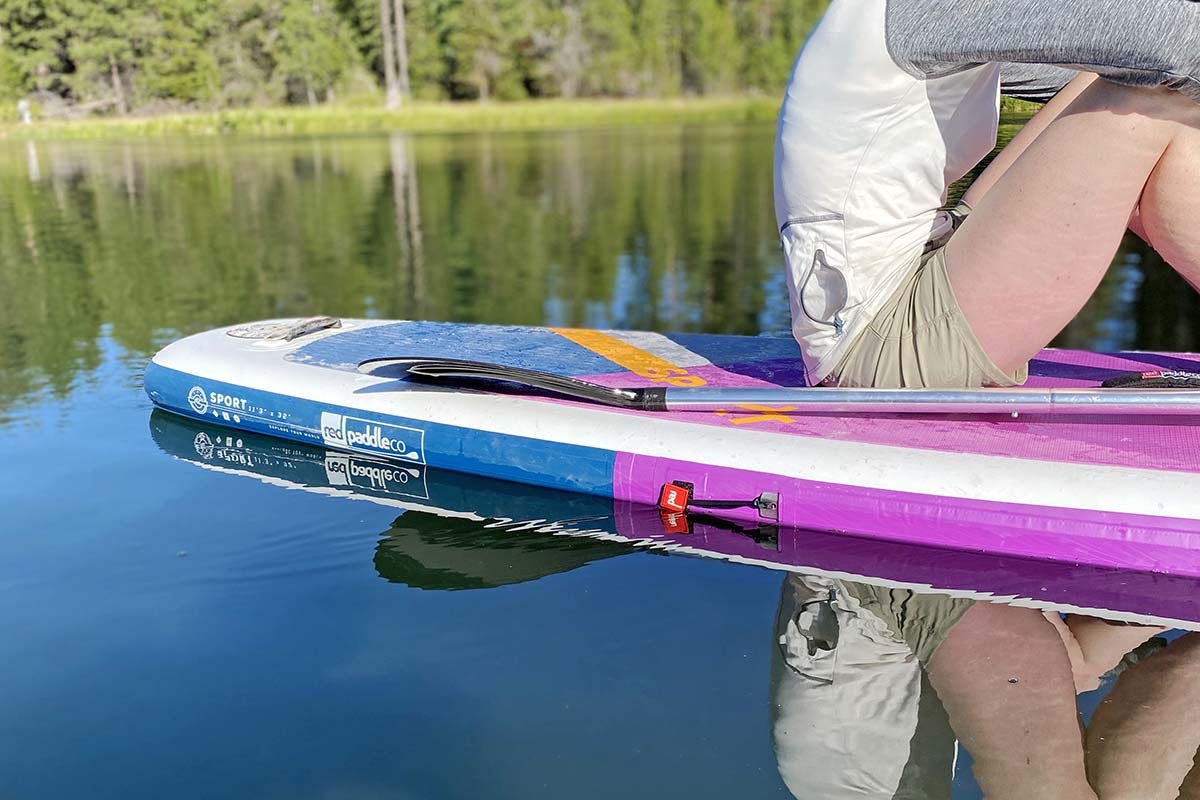
Every paddle board on our list comes with at least one fin, and many will have two or three. A single fin is great for flatwater paddling, moving in a straight path (also known as tracking), and keeping speed up (fewer fins means less drag). For this reason, most touring and racing models will have just a single fin, including the Hala Asana . Boards with three fins can be divided into a couple different categories—“thruster” setups have three equally sized fins, while 2+1 configurations have a large center fin and two small fins on each side—but for the purposes of this article, we’ve lumped them together into the tri-fin category. Tri-fin setups offer great stability and maneuverability but aren’t great at tracking and are often found on recreational and specialty boards. Finally, a twin-fin layout has a fin on each side but none in the middle, resulting in a highly maneuverable board and often great clearance in shallow water (side fins are usually smaller than a center fin).
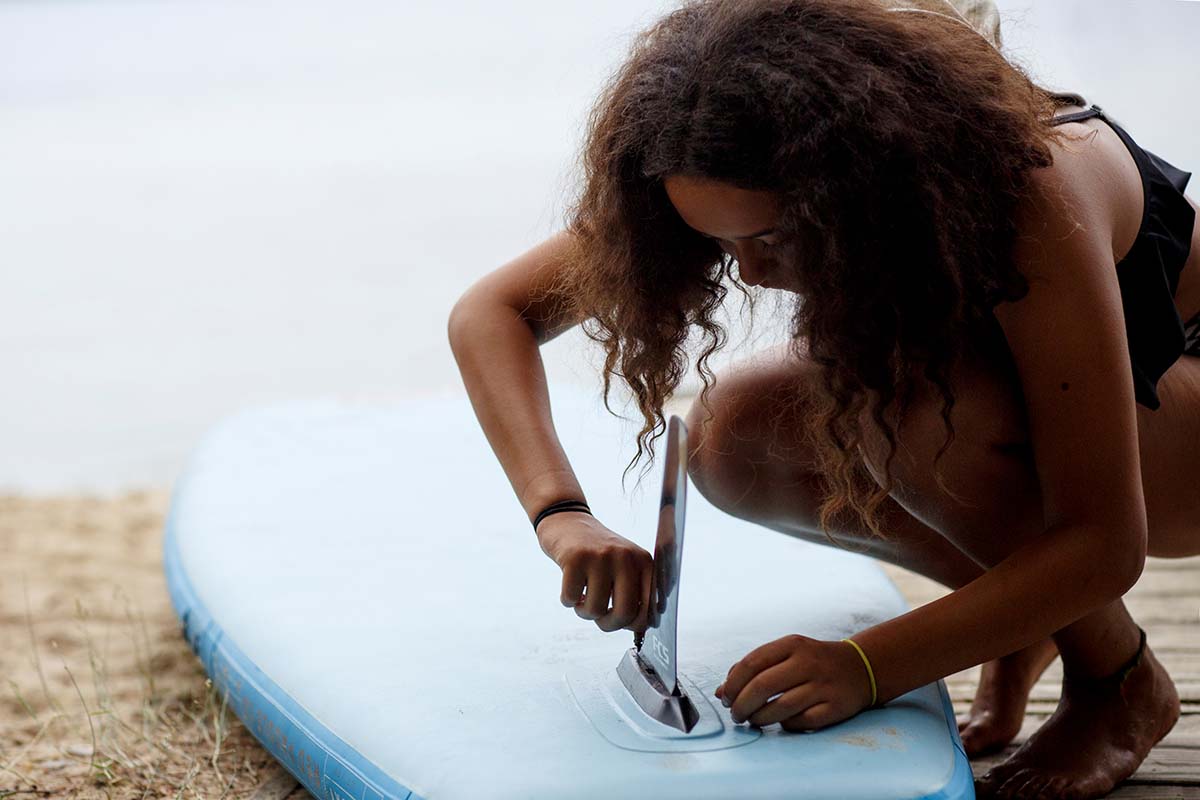
If you’re just starting out, it’s likely that you’ll opt for a board with a tri-fin setup, whether it’s a thruster or a 2+1. Some boards come with fixed side fins, while others have the option to remove or swap them out with those of different sizes (unless we specifically call out fins as fixed, you can assume they are removable). Removable fins are great for customizing your ride and recommended for intermediate to advanced paddlers: our favorite configuration is a removable tri-fin design—with this setup, you can run your board with a single fin, twin fins, or all three depending on your paddling needs and the water conditions. For the maximum amount of customization, it’s worth looking for a board with standard U.S. Fin Boxes so you can easily swap out a wide range of fins.
PSI (Pounds Per Square Inch)
It’s easy to get lost in the technical jargon regarding an inflatable paddle board's construction, but the good news is that every board comes with a simple clue that points to its overall level of quality: psi. Psi, or pounds per square inch, is a measure of air pressure: the higher the psi, the stiffer the board will be when fully inflated (with inflatable paddle boards, stiffer is better). Premium boards are often made with multiple layers and well-constructed seams and will be able to inflate to a higher psi, while budget boards typically have a lower air capacity. For reference, the maximum psi of a single-layer SUP will be around 12 to 15, while double-layer designs can have a psi of over 20.
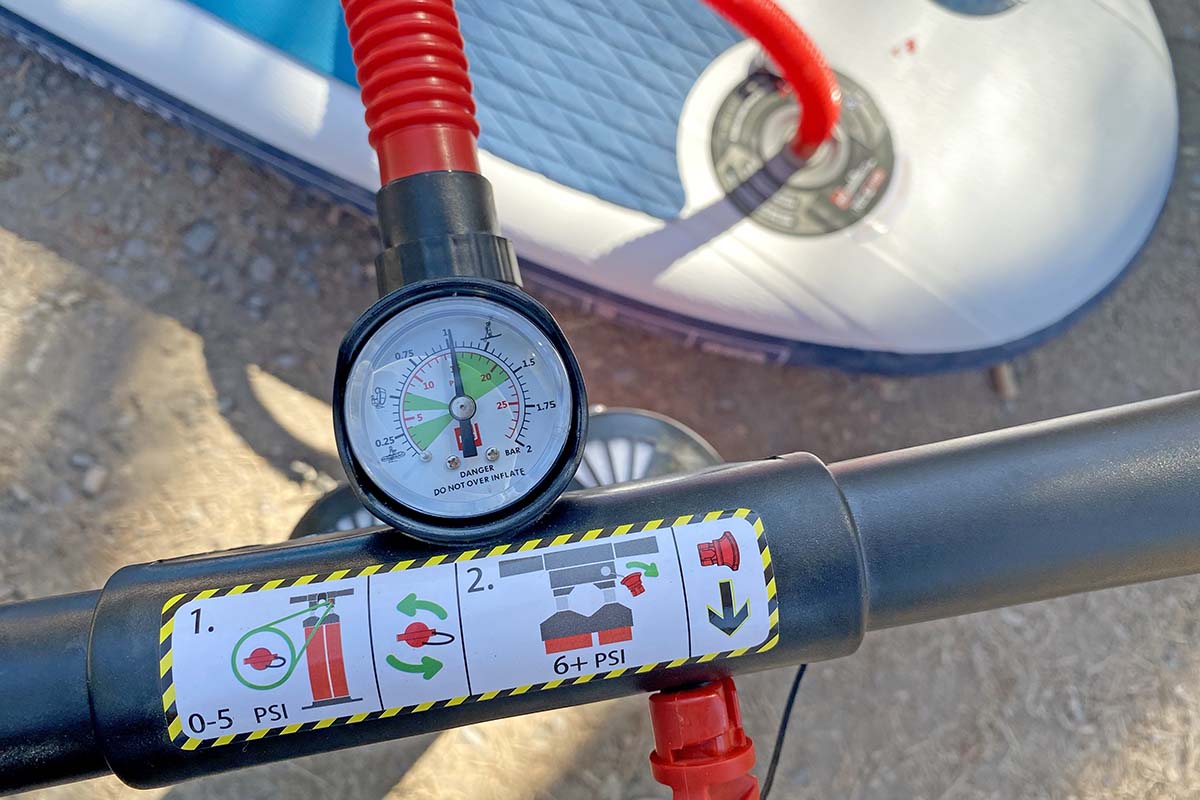
The vast majority of inflatable paddle boards come with a manual pump, which have one or two cylinders and are generally dual action, meaning you’re sending air into the board on both the down and up strokes. Most pumps have a built-in pressure gauge, and some even have two modes—high-volume and high-pressure—to help you inflate your board to the manufacturer-recommended psi. We vastly prefer dual-chamber pumps to the single-chamber variety, and in our experience, twice the cylinders is truly twice the performance. For example, we struggle to to inflate our Hala Asana to 10 psi with the included single-chamber pump, but with Red Paddle Co's Titan pump, we can get our Sport 11'3" to 18 psi without too much time or effort. Finally, those taking their board on longer expeditions will likely want a travel-sized design (like the K-Pump K-100 ) for maintenance and in case of leaks.
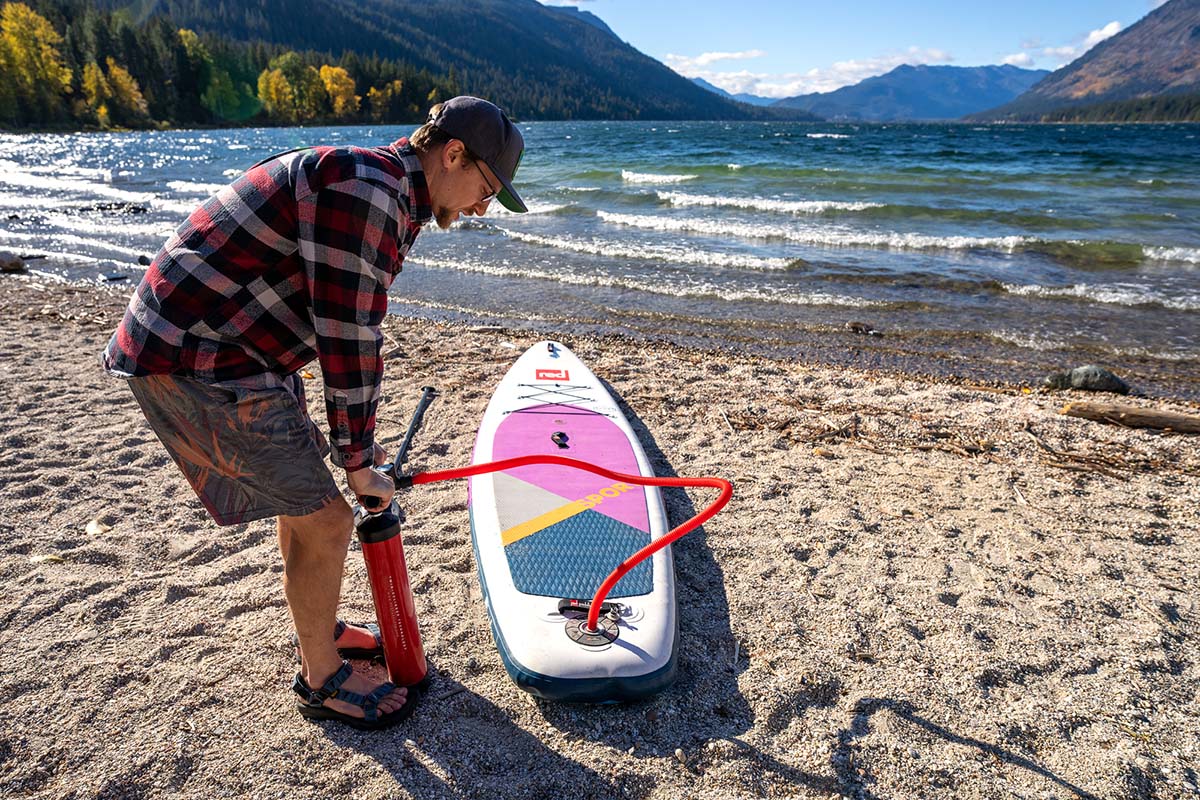
Some paddlers might find it worthwhile to invest in an electric pump, especially those who get out often or want to inflate their board to the maximum psi. Look at it this way: if you’re going to spend over $1,000 on a paddle board that’s valued for its rigidity, you might as well go the extra mile to make sure you’re getting the most out of your investment. Electric pumps are purchased separately and run the gamut from budget-friendly models like the $37 Advanced Elements 12 Volt Electric Pump to premium options like the Outdoor Master Shark II Electric SUP Pump (around $105).
In terms of functionality, most electric pumps plug into power during inflation (a standard wall plug-in, your car battery, or your vehicle’s cigarette lighter), although some have a built-in battery so that they can be charged at home and used without a power source in the field. Most electric pumps take a little less than 10 minutes for a standard-sized paddle board, and their hands-free nature means you can walk away and come back to a fully inflated board. And while electric pumps are certainly the more efficient option, you’ll want to read the specs before buying—some can inflate boards up to 20 psi, while others max out at 15 psi.
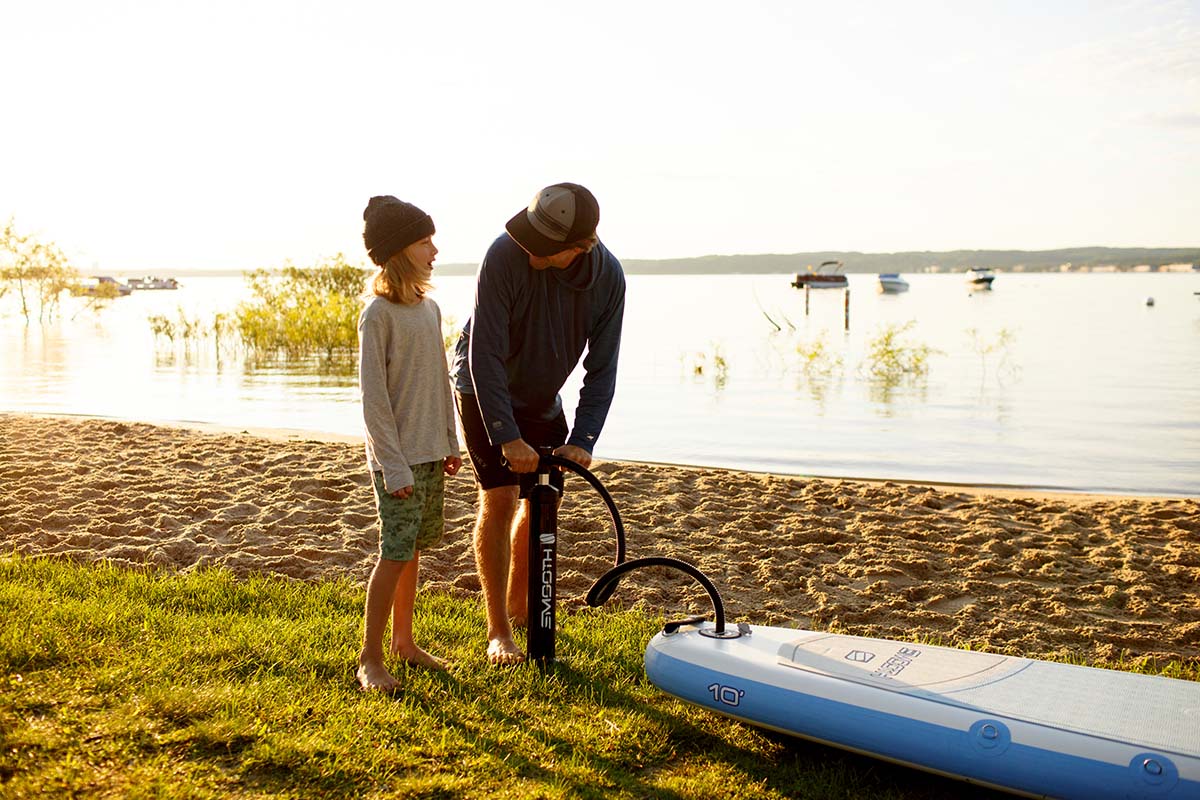
When shopping for a paddle board, it’s a good idea to take a close look at what’s included in your purchase. Most inflatable SUPs come with a backpack or roller bag for storage and transport along with a hand pump and fins, and many will also include a paddle, pump, leash, repair kit, and more. It’s important to keep in mind that all of these are essential pieces of gear, and if they don’t come with your board, you’ll almost certainly want to purchase them separately. Backpack/Roller Bag Nearly all inflatable paddle boards come with a backpack or roller bag for easy storage and transportation. We’ve found that the quality of these products varies significantly, and if you think you’ll be putting yours to good use by carrying your board for long distances or over rougher terrain, it’s a good idea to make sure it’s up to the task. In general, most included backpacks lack the adjustability and load-bearing suspension we’re used to seeing in backpacking packs and are typically only serviceable for short schleps from the car to the water. If you anticipate hiking before putting in, it’s worth considering an ultralight SUP like the Kokopelli Chasm-Lite, which comes in a streamlined package that packs down to a little larger than a roll of paper towels.
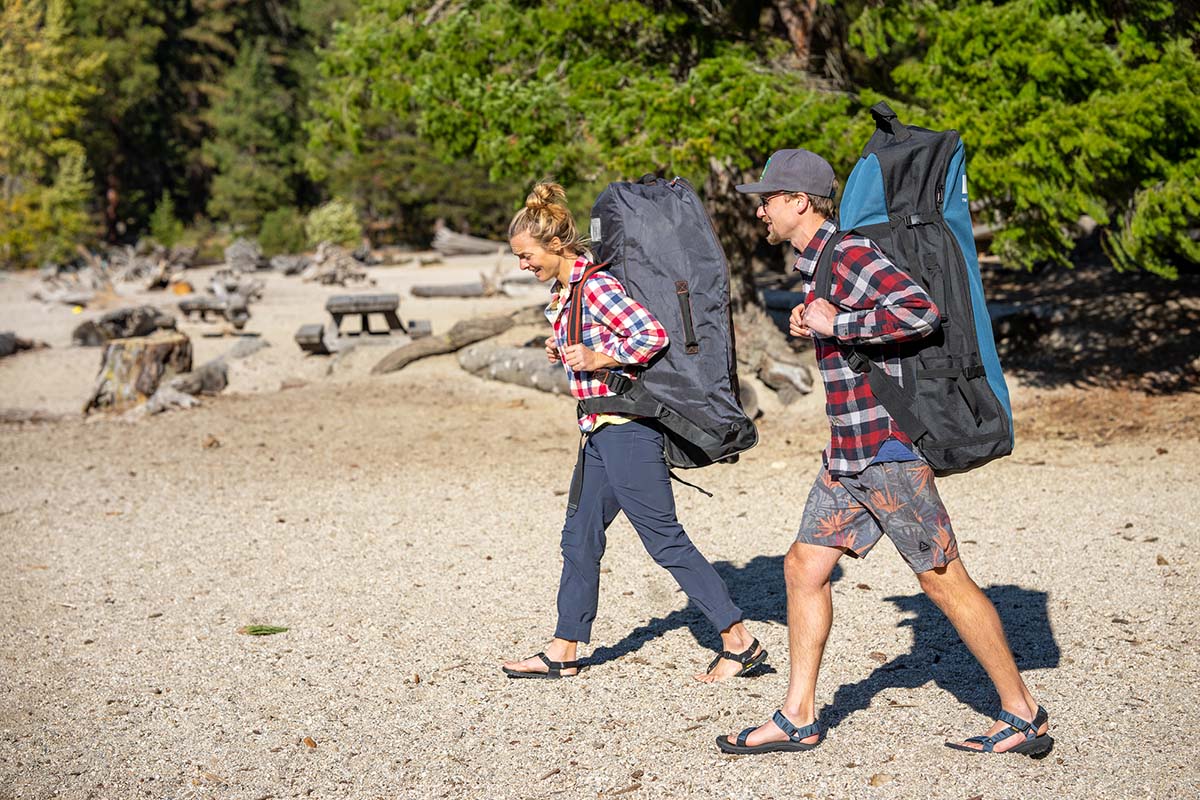
Paddle Most—but not all—stand up paddle boards on the list above come with a paddle, and these are typically two or three-piece designs and adjustable. Depending on the price of the board, paddles range from heavier plastic or aluminum to lightweight fiberglass or carbon. Most recreational paddlers choose to keep the paddle that comes with their board, but performance-focused SUPers headed out on longer or more intensive missions often upgrade to a lighter or more powerful model. Lightweight paddles are usually made with carbon shafts or blades (or both) to shave weight without compromising strength.
In selecting the ideal blade, you’ll want to consider the size, shape, and offset (the angle of the blade with respect to the shaft). In general, larger paddlers will want a larger blade (more power in the water), while smaller paddlers will be more efficient with a smaller blade. And as for fit: a good rule of thumb for recreational paddlers is to add 8-12 inches onto your height, or measure from the ground to the crook of your wrist when your arm is raised in the air.
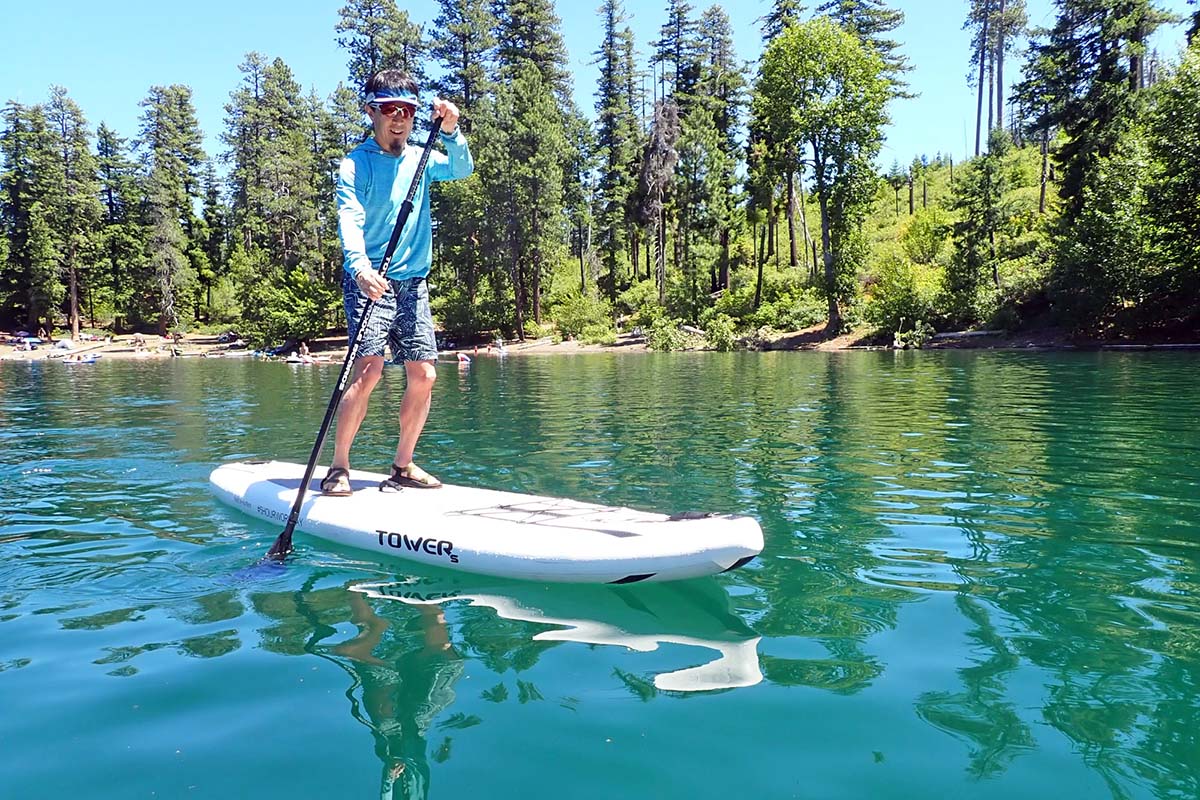
Leash The primary function of a leash is to keep your board attached to you in the event of a fall. These are less important in flatwater, but can be a matter of safety in the ocean or in fast-moving sections of river. Some boards will come with a leash, while others will require you to purchase separately. When shopping for a leash, we recommend looking for a model in the 8- to 10-foot range with a coiled cord that will drag less in the water. High-quality leashes will also include a swivel between the cuff and the cord, which keeps the cord from tangling.
Repair Kit Most inflatable SUPs also come with a small repair kit, which often includes items like PVC patches, a brush or cleaning solution (such as an alcohol swab), and sometimes even a valve tool to adjust your inflation/deflation valve(s). Interestingly, glue must be purchased separately due to shipping regulations, but you can find a product like Clifton's Urethane Adhesive at your local hardware store or on Amazon for relatively cheap. Getting a hole in your inflatable board isn’t the end of the world, but you’ll want to be well-versed in repair should you spring a leak on the water (NRS has a great how-to video here).
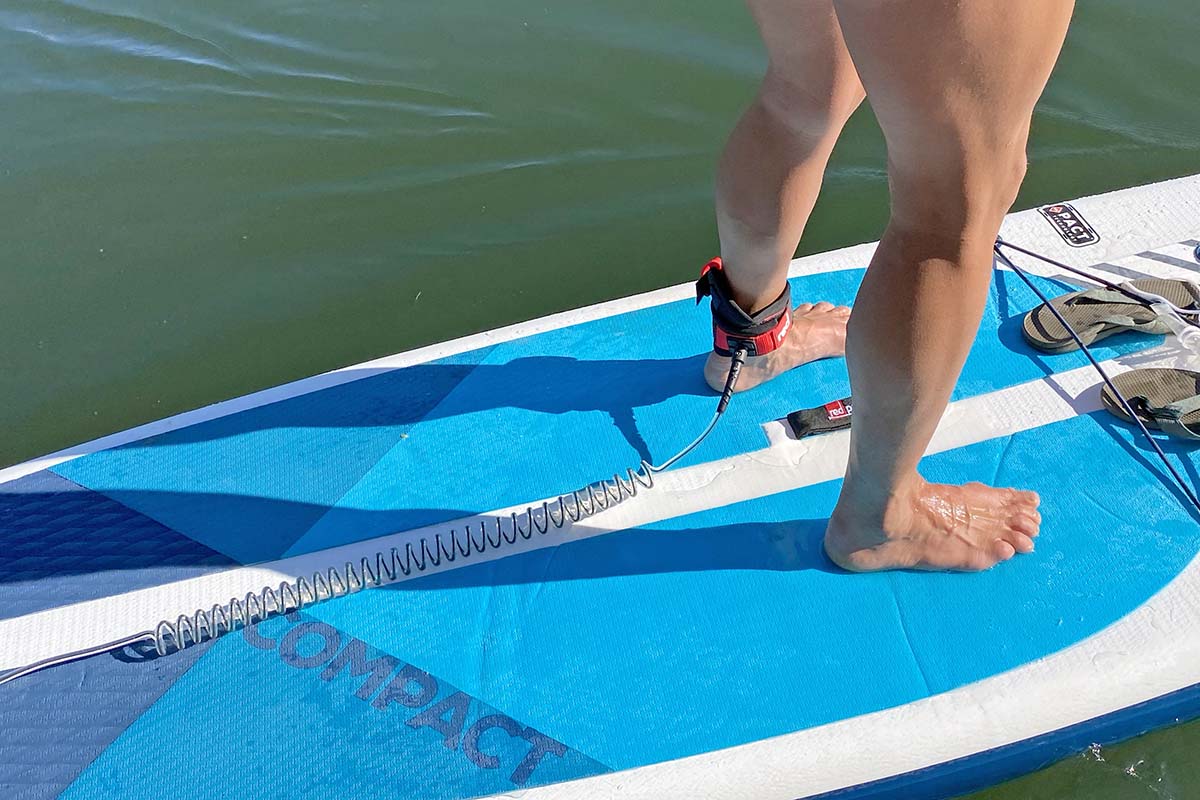
Additional Features
All stand up paddle boards are designed with features like a deck pad, carry handle, and leash attachment point, but there are a lot more bells and whistles worth considering. For instance, even casual cruisers will appreciate having extra rigging points, whether it’s a bungee tie-down or D-rings (or both) for stashing gear on deck. These are often located on the front or back of the board and great for securing your water bottle, sandals, or waterproof stuff sack full of valuables. Second, some boards feature mounts specifically designed to be compatible with fishing rod holders, GoPro cameras, coolers, kayak seats, and more, and these add-ons can often be purchased separately through the same manufacturer. For example, our favorite fishing SUP, the iRocker Blackfin Model X , has 20 attachment points and a fishing rack attachment that stores items like rods, a bucket, and a cooler.
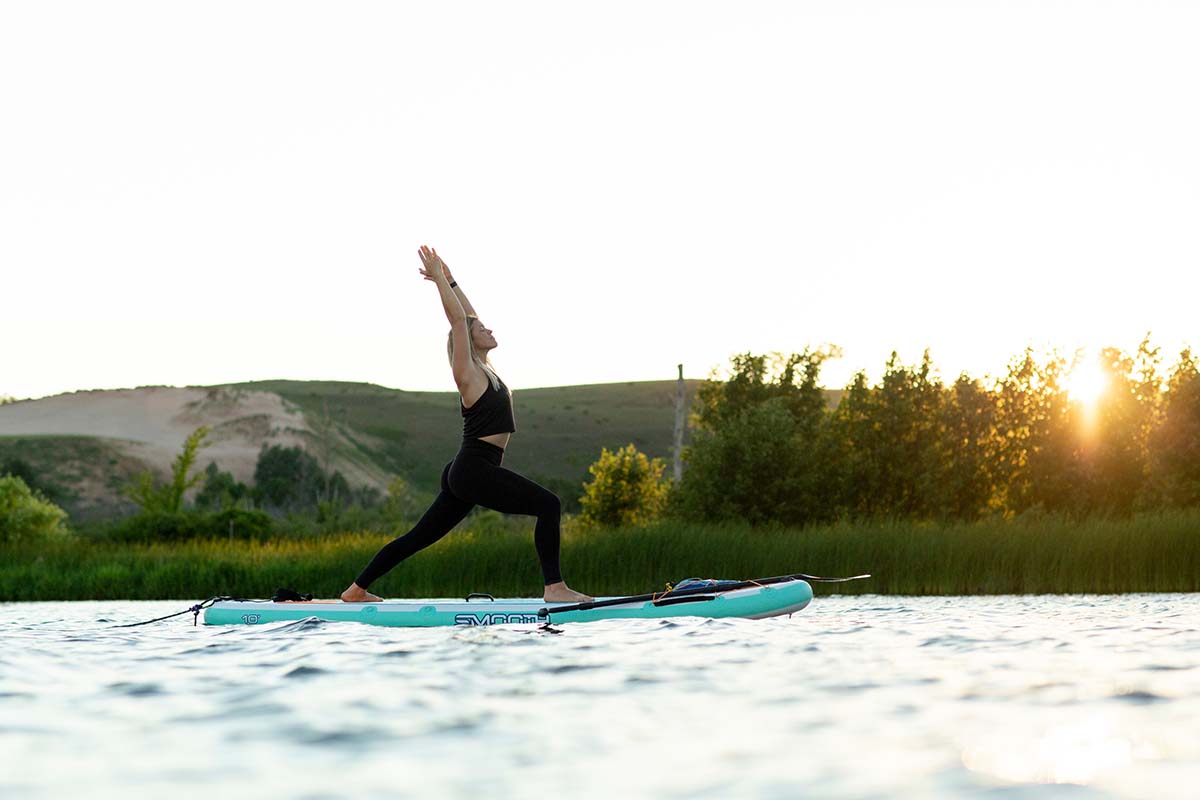
PFDs (Personal Floatation Devices)
Many paddlers wear a PFD (or personal floatation device) for safety—in fact, a good number of lakes and reservoirs require them. Because standard PFDs can be uncomfortable and restrictive, many paddlers opt for belt-style or inflatable vest designs that are low-profile. When shopping, you’ll want to look for a belt or vest with a Type III or Type V U.S. Coast Guard rating, like the Mustang Survival Fluid Manual Inflatable Belt Pack (Type III) or the NRS Otto Matik Inflatable PFD (Type V).
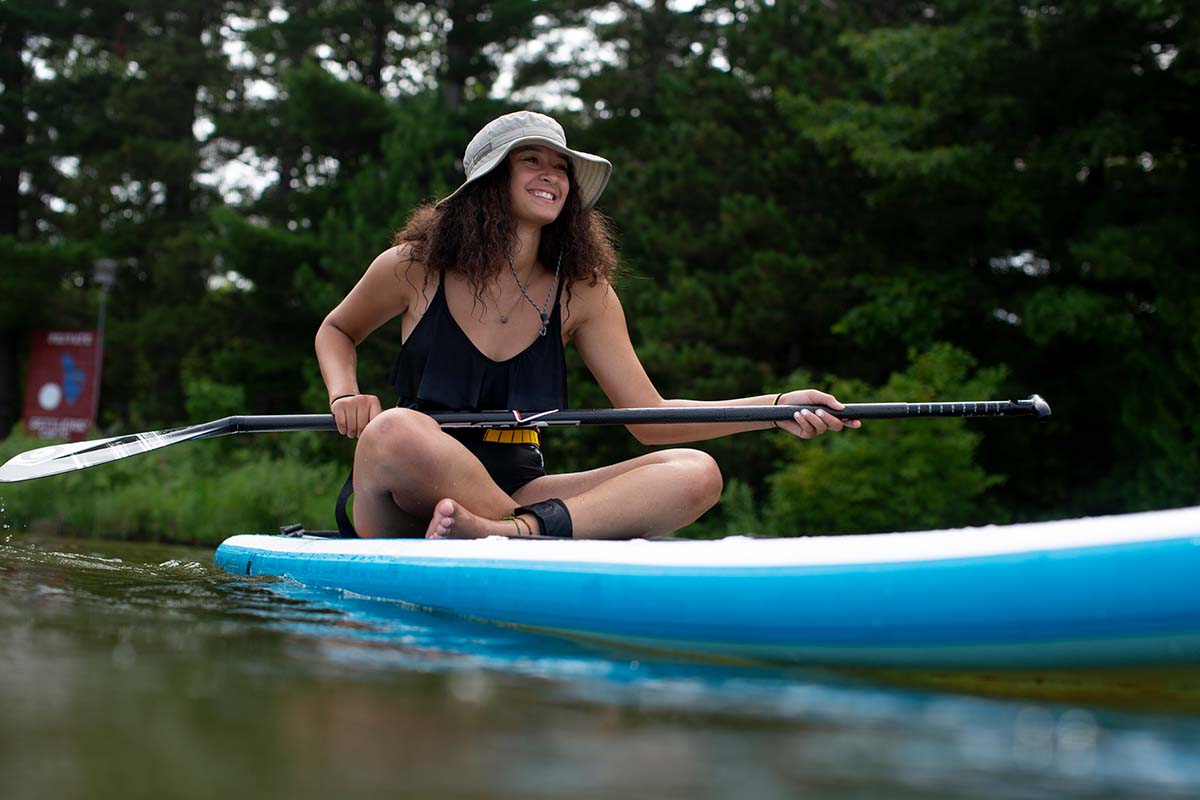
Stand up paddle boarding is an excellent activity to do with your family, but most smaller paddlers will find it challenging to maneuver standard 10- to 11-foot vessels. Thankfully, manufacturers now make paddle boards specifically for kids. Most kids-specific boards prioritize stability above speed, and are 8 to 9 feet in length, around 4 inches in depth, and weigh under 20 pounds. Unless you’re a particularly intrepid family, kids boards are a great place to focus on affordability over serious build quality. Keeping price in mind, a few of our favorite models include the Retrospec Weekender Nano ($230) and the Thurso Surf Prodigy Junior ($449). If cost is your most important factor, it’s also worth considering the Roc SUP Co. Explorer, a stable, 10-foot board that’s available for only $220 on Amazon at the time of publishing.
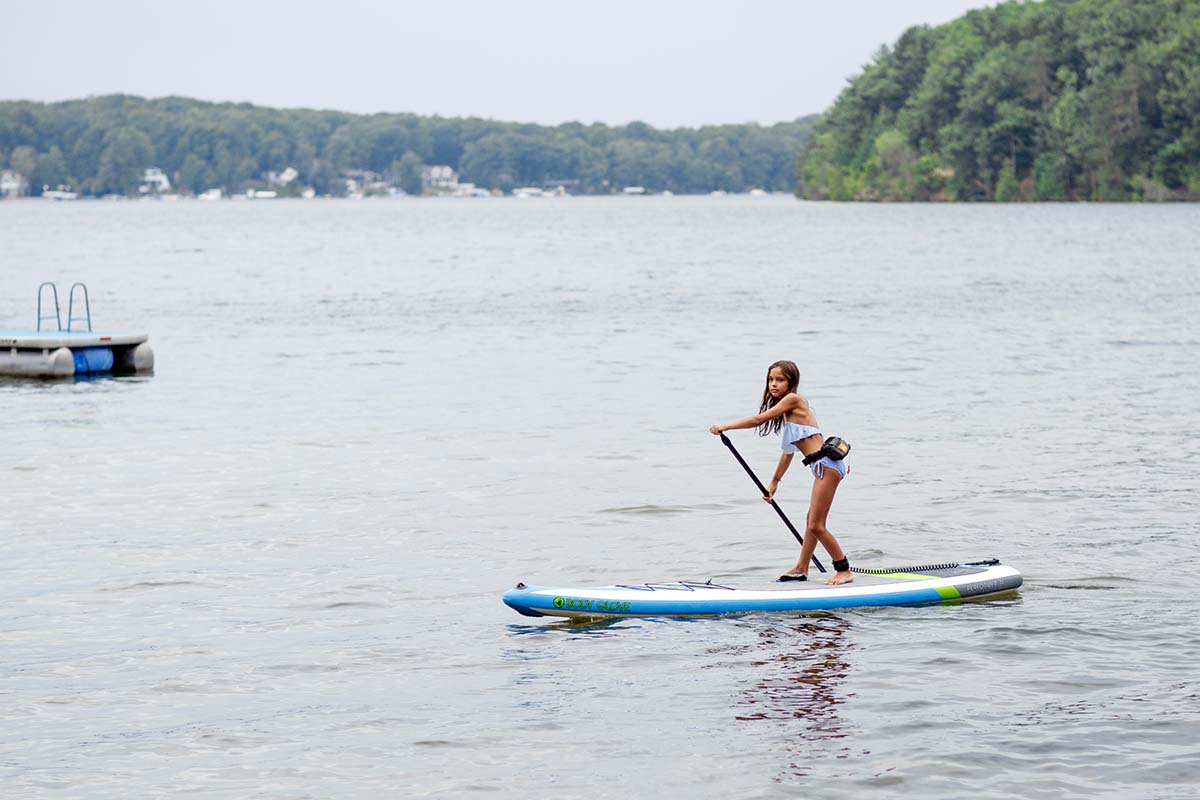
A major debate you’ll likely have when shopping for a stand up paddle board is whether you want a solid or inflatable construction. Solid boards (like the Pau Hana Malibu Classic 10'6" ) are usually made with an EPS foam core wrapped in fiberglass and epoxy (like a surfboard). Less common materials include carbon fiber, plastic, and wood. The benefits to solid boards are clear: they have little to no give, are more efficient in the water (less drag), don’t require any setup, and won’t pop. However, the obvious drawback is that hardboards don’t pack down, meaning you’ll need a roof rack or large truck bed for transport and ample storage space at home. In general, they’re slightly more expensive than inflatable models too, although costs are fairly comparable across the board.
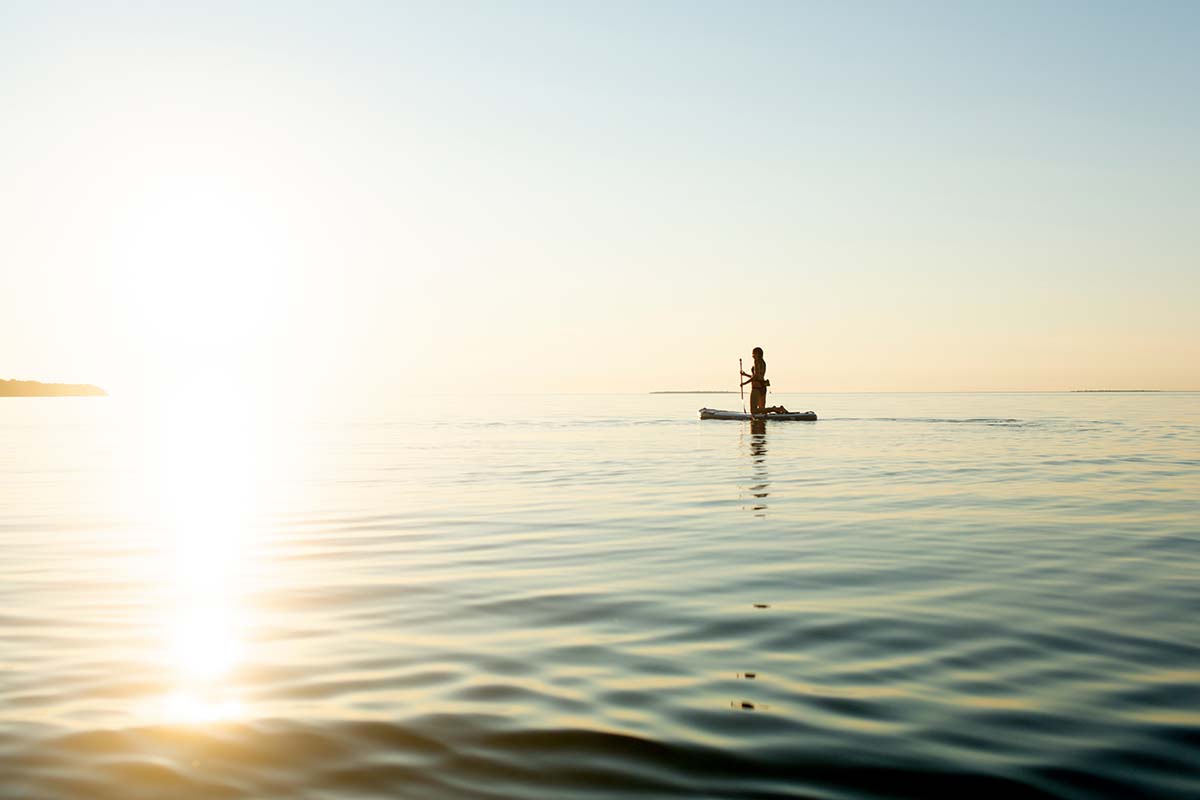
While hardboards certainly have their place, inflatable designs have taken the market by storm for a few main reasons. Most obviously, they pack down into a reasonable size and fit into an accompanying backpack or roller bag, which frees up valuable storage space and makes them much easier to transport. Second, due to their construction, inflatable paddle boards provide a bit more stability on both flatwater and whitewater, and their soft feel and flat surface (unlike the tapered top of a solid board) make them ideal for recreational cruising and activities like yoga. Finally, inflatable SUPs are generally both more affordable and longer lasting than solid paddle boards.
This article, including several photos in our Buying Advice, was done in collaboration with Beth Price of Beth Price Photography . Visit Beth's website to check out her beautiful work documenting outdoor life in northern Michigan. Back to Our Stand Up Paddle Board Picks Back to Our SUP Comparison Table
Read More From Switchback Travel
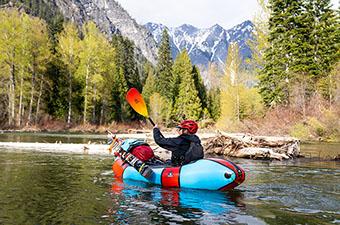
Best Packrafts of 2024
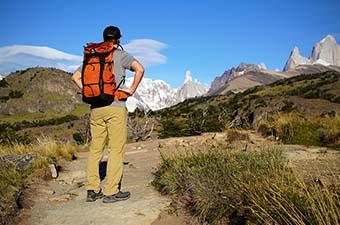
Hiking Gear Reviews
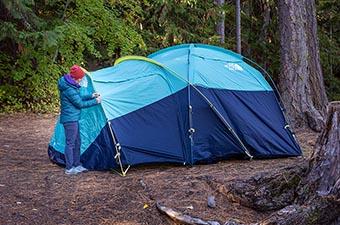
Best Camping Tents of 2024
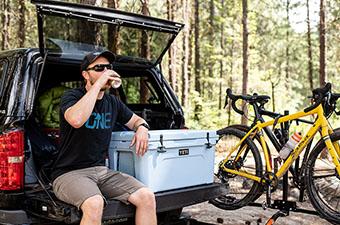
Best Coolers of 2024
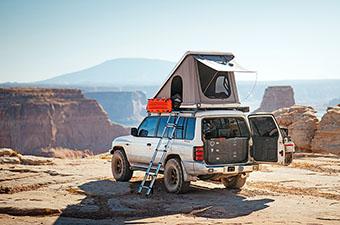
Best Rooftop Tents of 2024
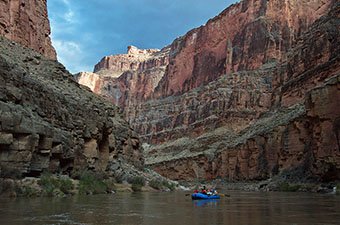
A Winter Float of the Grand Canyon
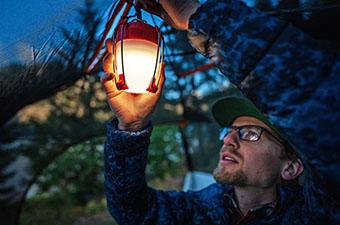
Best Camping Lanterns of 2024

Homegrown: Free Range Equipment
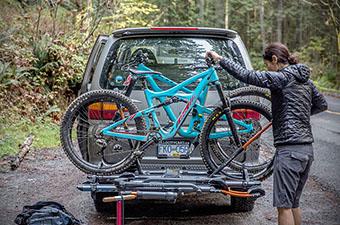
Best Hitch Bike Racks of 2024

Mobile Menu
Megamenu - desktop hamburger menu.
- Hiking Gear
- Backpacking Gear
- Biking Gear
- Camping Gear
- Footwear Reviews
- Climbing Gear
- Skiing Gear
- Winter Gear Reviews
- In-Depth Gear Reviews
- Hiking Shoes
- Hiking Boots
- Trail Running Shoes
- Mountain Bike Shoes
- Approach Shoes
- Climbing Shoes
- Beginner Climbing Shoes
- Mountaineering Boots
- Winter Boots
- Rain Jackets
- Down Jackets
- Synthetic Jackets
- Fleece Jackets
- Hardshell Jackets
- Softshell Jackets
- Windbreaker Jackets
- Ski Jackets
- Winter Jackets
- Hiking Pants
- Hiking Socks
- Trekking Poles
- Baby Carriers
- Running Vests
- Backpacking Tents
- Backpacking Packs
- Backpacking Sleeping Bags
- Backpacking Sleeping Pads
- Backpacking Stoves
- Backpacking Food
- Water Filters
- Altimeter Watches
- Handheld GPS
- Mountain Bike Helmets
- Mountain Bikes
- Mountain Bikes Under $1,000
- Mountain Bikes Under $2,000
- Gravel Bikes
- Bike Brands
- Kids' Bikes
- Hitch Bike Racks
- Camping Tents
- Rooftop Tents
- Camping Sleeping Bags
- Camping Mattresses
- Camping Chairs
- Camping Stoves
- Duffel Bags
- Rock Climbing Shoes
- Climbing Helmets
- Climbing Harnesses
- Climbing Quickdraws
- Belay Devices
- Climbing Ropes
- Climbing Backpacks
- Winter Gloves
- 4-Season Tents
- Ski Helmets
- Ski Goggles
- Ski Backpacks
- All-Mountain Skis
- Ski Bindings
- Backcountry Skis
- Backcountry Ski Boots
- Skis for Beginners
- Hardpack Skis
- Mirrorless Cameras
- Full-Frame Cameras
- DSLR Cameras
- Point-and-Shoot Cameras
- Travel Cameras
- DSLR Lenses
- Mirrorless Lenses
- Lofoten Islands
- Lofoten Hiking
- Hardangervidda
- Jotunheimen
- 10 Great Norway Hikes
- Public Huts
- Torres del Paine
- Chalten and Glaciares
- Lake District
- Patagonia National Park
- Milford Sound
- Abel Tasman
- Marlborough
- Great Walks
- Adventure Towns
Add adventure to your inbox
- Privacy Policy
- Terms of Service
© 2024 Switchback Travel. All Rights Reserved. No part of this site may be reproduced without our written permission.
- Search Please fill out this field.
- Manage Your Subscription
- Give a Gift Subscription
- Newsletters
- Sweepstakes
We independently evaluate all of our recommendations. If you click on links we provide, we may receive compensation.
- Travel Products
- Activity + Adventure
- Beach + Water Activities
The 10 Best Paddle Boards of 2024
For all-around performance, stability, and durability, check out our favorite options.
:max_bytes(150000):strip_icc():format(webp)/Kevin-Brouillard-Bio-Photo-e1e6e2d6ae6b4bdfa33d8b1b82bd2921.jpeg)
In This Article
- Our Top Picks
- Tips for Buying
Frequently Asked Questions
- Why Trust T+L
Travel + Leisure / David Hattan
Paddle boarding continues to grow in popularity — it’s beginner-friendly, cost-effective, and can be done solo or in a group. Stand-up paddle boards can be used virtually anywhere, from navigating coastal waters to exploring lakes and rivers.
While paddle boarding has a broad appeal, there’s a range of board types to choose. Some paddle boards offer versatile, all-around performance while others are geared toward racing or a specific activity. In choosing the best paddle boards, we evaluated products based on their stability, durability, versatility, ease of use, and performance in different types of water. We also factored in key considerations like portability and compatibility with accessories to find the best options for every user from beginners to pros.
Best Overall
Surftech lido stand up paddle board with paddle.
It offers all-around performance, a solid weight capacity, and user-friendly dimensions at a reasonable price.
The grooved cutouts in the deck pad are a bit pronounced.
For a versatile paddle board that’s built to last, look no further than the Surftech Lido. It’s made with Surftech’s Utility Armor construction, which employs a plastic heat-molded shell for durable protection around an EPS core, fiberglass, epoxy resin, and reinforced rails. Between loading and unloading, rocky shoreline, and sunken logs, the Lido can withstand plenty of wear and tear.
The mid-length board features a planing hull — a flat and wide design that enhances maneuverability and stability. Though it’s not a speed demon, the slightly tapered nose helps the board glide well across flat water and smaller waves. The Lido’s deck is also topped with Bloom foam, an algae-based material that’s sourced from fresh water sources at risk of algal blooms. Besides the sustainability benefits, the pad offers solid grip and cushion against the rigid board underfoot. Other notable features include bungees and multiple tie-downs and oversized leash plugs to easily add or remove between uses. Paddlers can transport the board with a security carry handle at the center of the deck or via a padded rear grab handle.
The Details: ABS/fused cell EPS foam and fiberglass/polyurethane sidewall | 126 x 32 x 5 inches | 28 pounds | 300-pound capacity | Single fin
Best Budget
Pau hana malibu classic stand up paddle board.
Durable, comfortable, and easy to use, this classic paddle board comes at a great value.
You’ll need to purchase a leash separately.
Among rigid paddle boards, the Pau Hana Malibu Classic Paddle Board is an affordable entry-level option. The board has a durable construction that features ABS plastic and Vacuum Formed Technology (VFT) that’s fitted around an EPS high-density foam core. Meanwhile, the Malibu Classic’s deck is equipped with a five-millimeter EVA pad for enhanced grip and support while paddling. Measuring 34 inches across, the board is considerably wide for its length, which elevates stability. Its 249-pound max capacity is adequate for most paddlers with room to take some cargo and gear out on the water, too. Though the Malibu Classic is a bit sparse on included features, it has an attachment point that’s compatible with cup holders, bungee tie-downs, and other accessories.
The Details: ABS plastic and EPS core | 126 x 34 x 4 inches | 31 pounds | 249-pound capacity | Single fin
Best Lightweight
Isle versa 2.0 stand up paddle board.
This rigid board delivers solid all-around performance in a portable package.
The weight capacity is on the lower end.
The Isle Versa 2.0 comes in two sizes — both boasting lightweight designs for easier transport and functionality. Weighing 26 and 29 pounds respectively, the board is on par with many inflatable models. The board’s wide body boosts stability, while the EVA traction pad offers support and friction-free comfort for the feet or knees. Though it’s well-suited for flat water, the Versa 2.0’s raised tail pad gives superior grip and a stable position at the back of the board to catch waves. Its shorter length also supports greater maneuverability to navigate obstacles and turn around with relative ease. The lightweight paddle board also features a pop-out carry handle in the center of the board that’s easy to hold. Made with military-grade materials, the handle is a secure attachment point for a cable lock. The Versa 2.0 comes with an adjustable carbon paddle and an eight-inch coil leash.
The Details: 125 x 32 x 4.5 inches or 134 x 33 x 5.2 inches | 26 or 29 pounds | 215- or 275-pound capacity | Single fin
Best for Touring
Boardworks raven touring all water stand up paddle board.
The board has superior glide and speed for seasoned paddlers looking to go the distance, quickly.
The top-notch speed comes at the cost of stability, so it’s less suitable for beginners.
The Boardworks Raven Touring All Water Stand Up Paddle Board delivers a sleek and speedy design for exploring the open water. The board’s flatter hull, pointed nose, 12.5-foot length, and extra thickness all help the Raven glide through the water with superb efficiency. Aided by the nine-inch touring fin, the board tracks and maneuvers well on the open water, though it’s a bit cumbersome to turn around in tighter quarters. The narrower touring board is most stable while moving, making it best-suited to active use rather than casual recreation. The EPX-V construction encompasses an EPS core enclosed by layers of fiberglass and bamboo veneers that add up to a lightweight and durable board design. Integrated lift handles help transport the lengthy board, while bungee tie downs in the front and rear help securely stow dry bags and gear.
The Details: EPS core, fiberglass, and bamboo | 150 x 29 x 6.7 inches | 31 pounds | 250–300-pound capacity | Single fin
Best Tandem
Pau hana big ez hawaiian vft stand up paddle board.
Wide, stable, and packing numerous mounting points for gear and accessories, this board can support company and cargo alike.
The ankle leash is sold separately.
The Pau Hana Big EZ Hawaiian offers ample capacity and deck area for two passengers or one paddler with their pup. The top of the board features a five-millimeter EVA pad for secure traction and ample cushioning to enjoy hours on the water. The Big EZ Hawaiian’s wider design also enhances stability, helping paddle rougher waters and accounts for pets or passengers who are resistant to keeping still. While the board doesn’t come with bungee storage, eight attachment points help integrate accessories like drink holders, tie-downs, and paddle clips for greater convenience and functionality. The Big EZ Hawaiian delivers lasting durability, too. Designed with vacuum formed technology around an EPS foam core and kevlar-reinforced rails, the board stands up to wear and tear. Meanwhile a self-regulating vent plug made from Gore-tex prevents pressure build-up that can damage the board.
The Details: ABS plastic and EPS core | 132 x 34 x 5 inches | 34 pounds | 350-pound capacity | Single fin
Best for Surfing
Sic maui saber.
Its longboard design is responsive and grippy for navigating waves and surf.
The maximum weight capacity won’t suit all paddlers.
The SIC Maui Saber is geared toward surf-specific paddle boarding. It has a lower volume than comparably sized paddle boards, which combined with the pinched rails and 4.1-inch thickness, helps the Saber skim over the water and carve out waves. The narrower tail and four-piece kick pad also enhance the board’s maneuverability by increasing responsiveness to foot pressure when turning. The deck is rigged out with a diamond groove EVA pad for traction, which is especially important as surfing requires more frequent changes in stance compared to flat water paddle boarding. The Saber has a removable 2+1 fin setup, allowing for greater customization. And the front of the board includes a camera mount to capture the adventure on the waves.
The Details: Rigid composite | 126 x 30 x 4.1 inches | 23.8 pounds | 210-pound capacity | 2+1 fin setup
Best for Fishing
Kaku kayaks 2023 voodoo.
Kaku Kayaks
The hybrid design offers the maneuverability of a kayak and the stability of a paddle board, plus the option to rig an electric motor.
The weight can make it challenging to transport solo.
The Kaku Kayaks 2023 Voodoo boasts a hybrid design and loads of features that are geared toward fishing. The hull is flatter than most kayaks, but deeper than a typical paddle board, which helps anglers navigate shallow waters and improves tracking. The nearly three-foot wide deck offers excellent stability while casting and moving about on the board. The Voodoo’s deck is fitted with rod holding channels, hatches in the bow and stern, and a removable chair that offers an ideal vantage point for paddling and fishing alike. It can also accommodate an electric trolling motor and 12-volt battery for extra zip. The 2023 Voodoo is also equipped with handles on the rails, bow, and stern, helping ease the effort of loading and transporting the 77-pound craft.
The Details: Rotomolded plastic | 156 x 35 inches | 77 pounds | 475-pound capacity | No fins
Best for Yoga
Cruiser sup balance yoga hard shell paddle board.
Cruiser SUP
This versatile board features a sizable deck pad for practicing yoga.
The board bag is sold separately.
The Cruiser SUP Balance paddle board delivers stability and traction for taking your yoga practice out on the water. It’s made with an EPS foam core that’s encased in an ABS/polycarbonate hard shell, giving the board a durable, lightweight design. The construction also features two valves to release air and pressure from the core, which prevents delamination and damage to the board. The deck of the Cruiser SUP Balance is equipped with a grippy and comfortable pad to feel stabilized during yoga poses.
The board’s 32.5-inch width is more spacious than a typical 24-inch yoga mat. There’s also a twin set of bungies — one on the nose and another on the tail of the board — for stowing a water bottle or other gear. Transporting the 31-pound board is simplified with an inset carry handle at the center of the deck, which doubles as an attachment for a cable lock.
The Details: Dura-Lite shell with ECO ABS/poly-carbonate construction | 126 x 32.5 x 5 inches | 27 pounds | 250-pound capacity | Single fin
Most Versatile
Bote hd 12-foot classic cyprus paddle board.
This board can accommodate a range of activities, paddling conditions, and skill levels.
The versatile performance comes at a fairly high price point.
The Bote HD 12-foot Paddle Board runs the gamut of uses for beginner and intermediate paddlers. The displacement hull design, which includes a deep-v nose that tapers into a flat tail, achieves an ideal balance between the efficiency and speed of a touring board and the stability of a recreational board. The HD’s deck is fitted with a BVA multi-textured pad that sheds water while providing ample cushion and traction. The combination of the spacious deck area and high weight capacity means there’s ample room for paddling with a child, pet, or gear. The HD is compatible with several Bote accessories, including a cooler, fishing gear storage system, padded seat, and a 12-volt battery power unit for integrating a trolling motor. The deck also includes sheath in the bow, stashpod drink holder, and bungees on both ends. There are multiple handles to ease transport of the 45-pound board, including a retractable front handle and grab handle at the center of the deck.
The Details: Gatorshell technology | 144 x 32 x 5 inches | 45 pounds | 315-pound capacity | Triple fins
Best Inflatable
Serenelife inflatable stand up paddle board.
Amazon
It’s an incredibly portable, all-in-one paddle board package.
It can take some effort to fit everything back into the carrying case.
Inflatable paddle boards are popular for their convenience and packability. Weighing just under 14 pounds, the SereneLife Inflatable Stand Up Paddle Board is one of the lightest models on the market. This lightweight design is plenty durable thanks to drop-stitch seams on the PVC material that can reliably stand up to rugged outdoor use.
It’s equipped with triple fins, which boost tracking and stability when using the ultralight board. Paddling with a pet or gear in tow is doable for most due to the board’s impressive 300-pound maximum weight capacity. The SereneLife board comes with everything you need to get out on the water: a coiled ankle leash, manual pump, aluminum paddle, patch repair kit, and carrying bag — making it a great inflatable option for beginners .
The Details: Fiberglass and elasticized fabric | 126 x 32 x 6 inches | 13.9 pounds | 300-pound capacity | Three fins
Tips for Buying Paddle Boards
Consider how you want to use your board.
Most paddle boards can be categorized as flatwater, touring, or surfing, though some blur the lines and embody characteristics from multiple typologies. Flatwater boards are generally the most versatile and provide all-around performance. They’re defined by their wider decks, flatter planing hull, and length between 10-12 feet. Touring paddle boards are usually 12 feet or longer and boast greater speeds and tracking. Surfing boards are typically under 10 feet in length for greater maneuverability and control navigating waves.
Choose a paddle board with the accessories you’ll need
If you go the inflatable route, at minimum, you’ll need a pump to inflate the board. However, choosing a board that comes with a repair kit, carrying bag, or ankle leash is worthwhile to improve the board’s longevity and ensure safety.
For rigid paddle boards, accessories are primarily geared more toward different activities, such as fishing, yoga, or camping. Some companies design boards to be uniquely compatible with their own accessories (like a paddle holder to free up your hands, integrated lure carriers, mounts for action cameras, and more) whereas others offer more universal attachment points for storage bags, bungee cords, and ankle leashes.
Other accessories are more practical in nature, like water bottle holders. Paddle board fins can come as an accessory, with detachable varieties offering greater flexibility when paddling different conditions and water bodies. There are also straps and carts to take the hassle out of carrying boards down to the water.
Having a paddle board with a compatible weight capacity is essential. The width and length of the board will impact how it handles and its intended use. “The narrower the board, the faster you will go” Lindsay Myers, intrepid explorer and travel expert, says.. Shorter boards tend to have better maneuverability, whereas longer boards deliver higher speeds for racing and touring. Meanwhile, mid-length boards are typically more versatile in their performance and use.
“The key things to look for in a beginner board are stability, versatility, and ease of use,” Myers says. Boards with wider dimensions and rounded noses can provide greater stability for newbie paddlers. Choosing a versatile board that’s designed to perform in flat and choppier water offers room to grow and hone your skills before needing to upgrade to a new board.
Rigid paddle boards take up space, even the shorter varieties. Storing indoors is recommended for optimal protection, and racks or suspension systems tuck boards out of the way if space permits. “Or you can simply lean it on its side against a wall,” Myers adds., “But never have it stand on its nose.”
If storing outside, “keep away from sun, moisture, and heat,” she continues. And before storing it long-term, be sure you thoroughly clean it, removing any salt, dirt, or debris.
A high-quality paddle board can last many years. Components like fins, handles, and bungee cords may require replacement, but a board can last decades with proper care. Inflatable paddle boards generally don’t last as long but can remain in use for five or more years depending on frequency of use and regular maintenance.
Why Trust Travel + Leisure
Kevin Brouillard is a contributing writer at T+L specializing in outdoor gear and apparel. For this article, he researched dozens of stand-up paddle boards to find the best options for different activities, features, and budgets. He also interviewed Lindsay Myers , a NYC-based travel expert and intrepid explorer, to find out what to look for when choosing a paddle board.
Love a great deal? Sign up for our T+L Recommends newsletter and we’ll send you our favorite travel products each week.
:max_bytes(150000):strip_icc():format(webp)/TaylorFoxHeadshot-7375be27aedf4b0ea0e0189a4befe7d0.jpeg)
Related Articles
The Best Standup Paddleboards of 2024
If you're considering an inflatable standup paddleboard for exploring lakes, rivers, harbors, or even the ocean, check out our list of the best SUPs of the season.

Standup paddle boarding is one of the fastest-growing water sports of the past decade . The market is flooded with high-quality standup paddleboards, and our buyers guide can help you choose the best, whether you are a seasoned paddler or just starting out.
Standup paddleboarding, or SUPing, is the act of standing (or sitting or kneeling) on a solid epoxy or inflatable plastic board tapered at both ends and using a paddle to move through the water. Whether you’re floating on a mellow river or lake, navigating Class 2 rapids, or exploring coastlines, a SUP offers freedom and exposure you don’t get in a boat or kayak.
Paddleboards are similar in shape to a long ocean surfboard but also have fins that are removable or fixed on the bottom, which help the board track well in the water while being steered.
Inflatables, which we focus on here, are a great option because when they’re deflated, they can more easily fit in a closet, trunk, or truck bed. You can even take them on airplanes. Inflatable designs have benefits on the water, too, like durability against rocks or other debris.
Some paddlers use their boards for multiday adventures, while others race, fish, surf ocean waves, do yoga, run whitewater, hike to glacial tarns, or hang out with friends and family at the local reservoir. Our experts take all of these uses and scenarios into account when evaluating paddle boards.
Over the last 3 years, we’ve had the pleasure of testing 14 awesome boards out on lakes and rivers from Colorado to Utah to Texas. Our editors and contributors are constantly seeking out the latest and the greatest to include in our buyer’s guide.
Below you’ll find our list of the best inflatable standup paddle boards of 2024. We’ve grouped them into categories to help you find the paddle board that’s right for you. Be sure to check out the buyer’s guide , FAQ , and comparison chart at the end of this article if you need more help choosing.
Editor’s Note: For our March 7, 2024 update, we’ve added the iRocker Blackfin Model V . Previously recalled due to seam sealing issues, this board reemerges defect-free as one of our favorite paddleboards. We’ve also included comprehensive advice for maintaining and repairing your paddle board.
- Best Overall Standup Paddleboard: Hala Rado
- Best Budget Standup Paddleboard: BOTE Breeze Aero Classic Inflatable Paddle Board
- Runner-up Best Standup Paddleboard: iRocker Blackfin Model V
- Best Standup Paddleboard for Yoga: Boardworks SHUBU Solr
- Best Ultralight Standup Paddleboard: Kokopelli Chasm Lite
- Length 10'10"
- Width 35"
- Thickness 6"
- Weight capacity 325 lbs.
- Weight (inflated) 28.5 lbs.
- Fin setup 2 plus 1, removable
- Tie-down points 14 (including two metal D-rings)
- Features Retractable center 9" Green Stompfin, EVA deck pad, raised rear stomp pad, 2 plus 1 fin setup
- Accessories Adjustable carbon paddle, hand pump, removable fins, backpack roller bag, repair kit

- Many tie-down points
- Unique rocker profile increases stability and maneuverability in whitewater
- Retractable center fin
- We wish Hala would consider switching the 12 soft rigging points to D-rings for greater durability and ease
- Constructed for dynamic, aggressive paddlers so might not be worth the investment for simple flatwater cruising
Colorado-based Hala Gear is known for making high-quality, innovative SUPs, and the Hala Rado ($1,399) is one of its bestselling boards of all time. With a slightly longer length, playful tail shape, and sturdy deck (helpful for both balance and towing gear), this all-around board continues to top our list.
The Hala Rado is a 10’10” board, designed to function well in both whitewater and flatwater. It has a unique progressive rocker profile, meaning a slight upward curve from the tail to the nose of the board helps the board more easily and aggressively maneuver and surf whitewater and waves. The design also has a swallowtail shape at the tail for better performance in moving water, allowing agility and balance.
In terms of features, we love that this board has reinforced grab handles on the bow and rear. There is a center handle that’s soft and flattens and two cloth side handles, too. And while the bungee tiedown area on the nose is on the smaller side, there are plenty of other rigging points on the board — 12 soft rigging points plus two tail and nose D-rings.
The brand also pioneered a patented retractable fin system called the Stompbox . It keeps the center fin safe and in check in faster-moving, obstacle-ridden waters. If the spring-loaded fin comes into contact with the river bottom or rocks, it slides up into the board. And the full SUP package features a Grafik carbon paddle.
While the Hala Rado board is on the heavier end, that’s mainly due to the burlier construction, with a double-layer PVC drop-stitch and a PVC stringer that runs through the board. It also means this board is built with a greater weight capacity — to be rigged down with gear for multiday trips from simple campouts to longer expeditions or to carry multiple people on a lake paddle.
Thanks to the size, construction, and performance across flat and whitewater, this board ranks high and is definitely geared toward more dynamic paddlers. But it will also work great for beginners who plan to primarily paddle on rivers. If you’re looking for a shorter and lighter board, check out Hala Rado’s mini-me, the Hala Radito .
BOTE Breeze Aero Classic Inflatable Paddleboard 10’8″
- Length 10'8"
- Width 33"
- Weight capacity 250 lbs.
- Weight 20 lbs.
- Fin setup 2 plus 1 removable center fin
- Tie-down points 11
- Features 10-inch removable center fin, center handle for carry, handles on nose and tail, fixed bungee strap on nose, four D-rings on side rails, 1 D-ring on tail
- Accessories 3-piece paddle, repair kit, hand pump, backpack travel bag

- Relatively lightweight
- Great price
- Side bite fins are not removable
- Not the top choice for whitewater adventure
Our Florida-born editor and avid paddler confirms this home-based brand produces quality boards for flatwater, ocean, and canal paddling — and our testing proved so.
The BOTE’s Breeze Aero Classic Paddleboard ($700) is no exception. It’s a middle-of-the-pack-sized board with great versatility and an economic price tag compared to most of our favorite SUP designs.
This SUP is constructed with military-grade PVC plus more than 10,000 composite stitch fibers along the interior core to enhance the board’s rigidity. A BVA foam pad lines the top of the SUP for added comfort.
With a slightly rockered nose, the board handles uneven waters well. The additional small side-bit fins are fixed to help the board track even in waters that are too shallow for the removable 10-inch center fin.
BOTE even came up with an innovative attachable shoulder sling that clips to the side of the Breeze Aero Board and adds another carry option.
All of those thoughtful design details at less than $700 make this one of the best inflatable standup paddle boards for the price.
iRocker Blackfin Model V 12’6″
- Length 12’6”
- Width 32"
- Weight capacity 485 lbs.
- Weight 30 lbs.
- Fin setup 3 removable
- Tie-down points 20 D-rings, 2 Bungees
- Features Sand Spear mounting points, seat attachment points, triple-layer PVC construction, reinforced seams
- Accessories 3-piece paddle, triple-action hand pump, carrying bag

- Tandem capacity
- Fins install without tools
- Includes repair kit
- Mounting points for seat
- Challenging to maneuver when loaded down with all 3 fins attached
- Not the best board for beginners
We’ve paddled on and tested the Blackfin Model V ($899) now for several years running. But the 2023 updated SUP was the first time we got our hands on this paddle board after seal issues that caused a subsequent recall (which affected the Model X, XL, and V) were fixed.
In terms of paddle boards, the Blackfin Model V is a stellar, all-around touring SUP example: it’s got triple-layer PVC, carbon rails, and reinforced seams. The board is 12’6″, 32″ wide, and can carry up to a whopping 485-pound weight limit. This is where it shines above other 12’6″ boards. It can carry a heck of a lot of weight and is streamlined enough that advanced paddlers will enjoy it just as much as those who have only been paddling for a few seasons.
Because of its shape and tapering at the tail, along with the center fin and twin fin setup, this board excels in offering speed and good tracking in the water, even in windy or choppy conditions. We wouldn’t recommend this board for beginners, though it does offer stellar stability, and at 32″ wide, could still accommodate those with less experience.
Those who will get the most out of this SUP are intermediate to advanced paddlers who want to tour all day, paddle farther distances, paddle fast, or paddle tandem. For our test of the updated Blackfin Model V, we focused on inspecting the board, and treating it like we would any other SUP: inflating and deflating with both a manual and electric pump, cleaning it after use, and storing deflated and folded.
We didn’t treat it with kid gloves but treated it like we would any other SUP in terms of testing, inflation, and storage. The board has a high-pressure value, similar and standard with other SUPs, and a recommended PSI of 12-16. (Between 12 PSI on the low end and 17 PSI 2 times when carrying about 40 pounds of extra weight on board.) We inflated/deflated this board over 20 times to ensure no issues off the bat with the seams or seals. So far, so good.
The Blackfin Model V goes back on our top 5 favorite list of SUPs. More importantly for anyone still concerned about quality or durability, it comes with a 2-year general warranty, 3 -year seam warranty, and 1-year accessory warranty (for components like the fins and 3-piece paddle).
Boardworks SHUBU Solr
- Length 10'6"
- Thickness 4.75"
- Weight capacity 260 lbs.
- Weight 21 lbs.
- Fin setup Single fin, removable
- Tie-down points 4 (D-rings that anchor the bungee strap)
- Features 3 grab handles
- Accessories Adjustable 3-piece paddle, backpack roller bag, hand pump, leash, repair kit

- Expansive thick cushion across top
- Comfortable carry handles
- Need more tie-down points for multiday trips
- Not our first choice for whitewater
The SHUBU ($1,029) has a moderately spear-headed nose and one removable fin, and we found it tracks well in the water. On a few day trips to SUP some high-altitude mountain lakes, with conditions varying from glassy to choppy waves, we noticed this design managed the range of conditions well.
This board is a great choice for water yogis and shoe-free paddlers. The deck pad is covered in a layer dubbed “Honey Fomb,” which looks like honeycomb and feels like a thick, therapeutic yoga mat. A whopping three-quarters of the board is topped with this cushion, which makes standing, sitting, kneeling, or practicing Warrior II Pose that much more comfortable.
Even our GearJunkie testers who typically wear closed-toe water shoes — and have never wanted to take them off while SUPing — loved the Honey Fomb. The texturized, squishy cushion proved to be a game changer beneath bare feet.
The SHUBU board has three carry handles in the center, at the nose, and at the tail. Four tie-down points are connected with a bungee cord, which is enough space to hold a dry bag, shoes, and a water bottle for a day trip. It was definitely one of our boards of choice for day excursions.
At 21 pounds, it’s also a good option if you’re looking for a relatively transportable SUP for hikes. The one downside was a lack of tie-down points. Otherwise, it’s a great all-around SUP, especially for yogis.
Kokopelli Chasm Lite
- Length 10'
- Width 30"
- Weight Capacity Unknown
- Weight 12.9 lbs
- Fin setup Single
- Tie down points 4
- Features EVA deck pad, welded D-rings, bungee
- Accessories pump, paddle, leash, pack

- Extremely light and packable
- Great stability and performance for size
- Easy to pack, portage, and carry
- Quality paddle
- Small pump design
- Carry-on size
- Only single fin
- Smaller deck pad area
- Not most durable
In 2022, Kokopelli — a packraft brand based in Colorado — set out to make the lightest, most packable SUP package on market. And it succeeded. The Kokopelli Chasm Lite SUP ($999) weighs under 13 pounds for the 10-foot board, and the entire package (bag, SUP, paddle, pump) weighs under 20 pounds total. It is a feat of innovation.
But not only is this small SUP light and highly packable, but it’s also capable and fun. We paddled on this board in testing mostly on flat water, in a wide range of temperatures and elevations, with and without gear. We tested its max PSI and max weight limit. The board is slightly shorter (10 feet) and narrower (30-inch width) than some and only has a single fin setup.
But, everything about how this board packs down, moves, and functions on the water is stellar. It’s not a board for beginners; it’s a board for those who want to hike or portage out to more remote lakes and destinations.
What started out as a bold and lofty idea from the brand on Kickstarter has manifested into something real — really light, really packable, really well-designed, and really fun. The Kokopelli Chasm Lite is at the top of our list when it comes to the lightest weight SUPs we’ve enjoyed thus far.
For an in-depth run down, check out our full review of the Kokopelli Chasm Lite .
iROCKER All-Around 10′ Ultra Paddleboard
- Weight 19.8 lbs.
- Fin setup 2-fin, removable
- Tie-down points 4 D-rings plus front and tail bungees
- Features 2 removable 2 x 9 in fins, EVA deck pad, offset carry handle in the center plus carry handles on nose and tail, bungee cords on nose and tail
- Accessories 5-piece carbon paddle, iROCKER 12V Electric Pump , 10-inch coil leash, backpack travel bag

- Anchored bungees are located on both the nose and tail
- Coil leash included
- Not a good option for multiple paddlers
- No manual pump is included
Even after just a few paddles, it was hard not to love this board. iROCKER’s new Ultra Series takes the definition of “lightweight” and ups the ante — this board ($849) was redesigned to be under 20 pounds.
The Ultra Series includes an All Around 10′ and 11′ lead with big design changes to the materials. The All Around Ultra Series 10′ isn’t just light but is also 50% smaller, packed down in a redesigned carry bag.
In testing, this board performed great. Because it’s shorter in length, stability may be a learning curve for some paddlers depending on personal preference. We actually liked riding a shorter board and found it easy to maneuver, even in waves.
But the brand does recommend this design for shorter (5′ 5″ and below) and lightweight paddlers.
There are D-rings and extra on-deck bungee storage for strapping down gear. A creative addition we haven’t seen before — two extra handles attached between two of the D-rings on the nose also hold the bungee cords.
Rather than three fins, the twin-fin configuration is an update that allows the board to be folded in half when deflated (often a center fin’s mount is bulky even with the fin removed), which works great. And while the All-Around board was made to be lighter, it doesn’t sacrifice durability — it’s still made with drop-stitch construction.
Then comes the carrying bag; featuring padded shoulder straps, a rolltop design, and plenty of storage made it another favorite component of this SUP. One of the biggest pros (and possibly cons) is the lack of a manual pump: Ultra instead included a 12V electric pump for faster setup. Basically, plug it into a 12V outlet or AV port (like in a car, truck, or RV), choose the correct setting for the board’s PSI, and you’re set. Ours took less than 10 minutes to inflate.
Take a look at this board if you want something super packable and light for paddling at home or traveling. Overall, this is among the lightest, most compact inflatable designs we’ve tested.
Read our full review of the iROCKER Ultra Series All-Around 10′ Paddleboard.
Pau Hana Endurance Air
- Length 12'
- Weight capacity 300 lbs.
- Weight 24 lbs.
- Fin setup 1
- Tie-down points 23 D-rings, 23 Seamount attachment points
- Features PVC drop stitch exterior, double-layer PVC side rails, EVA deck pad
- Accessories Hand pump, backpack travel bag, paddle

- Large enough for 1-4-day expeditions (carrying rider plus gear)
- Lots of attachment points
- Stable when paddling
- Hard to pump to maximum PSI
Our tester was hesitant to use an inflatable paddle board for a 110-mile trip, but was pleasantly surprised at the performance of the Paul Hauna Endurance Air ($1,249). The board tracked steadily through windy chop and glassy flat water, proving itself “expedition worthy” while retaining the portability of an inflatable SUP.
A cargo net keeps your gear secure for the long haul, and 23 D-rings offer plenty of options to ensure you’ll get the whole rig balanced to your liking. Weight distribution (and redistribution) is key for maximum efficiency as conditions change, and this board supported 3 days of supplies, plus our 200-pound tester with ease.
Inflating this SUP to its recommended PSI is not a quick task. It took our seasoned tester over 15 minutes to fill this 250L board, but it never needed to be topped off during the 3-day testing expedition. While the Endurance Air’s weight limit is sufficient for a 3-day trip, it doesn’t have the 415-pound capacity of its non-inflatable cousin.
Weight limit aside, this SUP does a good job of combining the portability of an inflatable board and the performance of a hard board. If you’re looking for a SUP up to the rigors of multiday expeditions, but won’t load your rig down during your road trip, the Endurance Air offers a great compromise. There are lighter, more packable inflatable boards, but you’ll be hard-pressed to find one that performs as well during long days on the water.
For a more in-depth look at this inflatable touring board, check out our full review of the Paul Hana Endurance Air .
Badfish SUP Flyweight
- Thickness 5"
- Weight capacity 230 lbs.
- Weight 18 lbs.
- Tie-down points 6
- Features Bungee straps, center handle, handles on nose and tail, unique Velcro strap for water bottle in center, integrated GoPro mount
- Accessories Hand pump, backpack travel bag, coil leash, multi-piece paddle

- Best for solo paddlers and lighter loads
- Super lightweight
- Streamlined and fast
- Not ideal for carrying multiple paddlers or heavier cargo loads
- The slightly narrower and leaner design makes the board not as stable in whitewater, wakes, or waves
At only 18 pounds, the Badfish SUP Flyweight ($1,199) is among the lightest designs out there. A new addition to the brand’s lineup, the design is streamlined, easy to charge, easy to lift, and easy to inflate. We found the inflated board remains stable when wakes move across smooth water, and the pointed nose helps drive the SUP forward.
We didn’t think the weight would make much of a difference, but we definitely noticed that lifting up this nimble SUP and carrying it to the water’s edge was faster and easier compared to heavier models.
While hand-pumping the SUP, we also noticed the job didn’t seem to take as long — perhaps because the volume we aimed to fill was a bit lower. Deflating doesn’t take long either. The board folds up with ease and maintains a compact shape for transport.
The Velcro strap for a water bottle is an awesome idea — usually, we clip ours to a D-ring or tie-down point with a carabiner. The only hangup we have is making sure we don’t accidentally smack our foot on our water bottle (we prefer a Hydro Flask for keeping the water cold) or tripping on it when a wake suddenly ripples over, since it’s toward the center of the board.
Right away, we received compliments from passersby on the bright stripes and colors of the top. The Badfish SUP is light, fast, and fun! While the price is on the higher end, we know Badfish SUPS are extremely durable, well-constructed boards designed with top-of-the-line materials. If going light is your top priority, it’s the best standup paddle board you can buy.
BOTE WULF Aero 10 ‘4’
- Length 10'4"
- Width 34"
- Fin setup 1 removable (10"), 2 fixed
- Tie-down points 7
- Features Three carry handles, fixed bungee strap on nose, 1 D-ring on tail
- Accessories 3-piece aluminum paddle, backpack-style bag, hand pump, coiled leash, repair kit

- Excellent stability and stiffness
- Good maneuverability
- Generous, comfortable, and grippy deck pad
- Great value
- Small attached fins get deformed and must be straightened
- Aluminum paddle prone to damage and is slippery
- Rudimentary travel bag
Don’t be dissuaded by the entry-level designation, as the BOTE WULF Aero 10 ‘4” ($499) is a quality board that just happens to be inexpensive and easy to maneuver. Unlike some other beginner boards, this board arrives with the full gamut of standard features including an EVA foam deck that runs the length of the board.
Our own Seiji Ishii put the WULF Aero through its paces over the course of 3 months. He found this board stiff and stable once inflated with the included single-chambered pump (though he switched to an electric pump after several inflations in the hot Texas sun). Once in the water, the WULF Aero provides a solid 34-inch wide platform for the uninitiated paddle boarder to successfully track a straight line without too much effort. This board is equipped with two fixed fins and one removable center fin.
The WULF Aero tips the scales at lightweight 20 pounds and the entire package including a pump, paddle, and carrying bag is only 30 pounds. Three handles make getting the board down to the water no sweat. The pump and carrying bag are adequate and functional, though the single-chambered pump isn’t the most efficient, and the carrying bag is very simple, but this helps keep the WULF Aero more affordable.
A wide and stable board isn’t going to be the speed demon that more experienced paddlers are looking for, but the user group the board is aimed at will benefit from stability. The included three-piece aluminum paddle isn’t the lightest or most durable, and it became very hot after some time in the sun. These complaints are pretty minimal when you take the WULF’s very approachable price into consideration.
If you’re new to the sport or simply looking for an affordable board everyone can use at the lake this summer, the BOTE WULF Aero is a great option that doesn’t cut any corners where it counts.
Red Paddle Co. MSL 10’6″ Ride SUP
- Length 10' 6"
- Thickness 4.7"
- Weight capacity 220 lbs.
- Weight 21.9 lbs.
- Fin setup 2-fin, fixed
- Tie-down points D-ring on tail, 2 elastic straps on nose, 1 adjustable bungee strap with two D-ring anchors
- Features 3 carry handles, accessories mount
- Accessories Backpacker roller bag, hand pump

- Super innovative minimal backpack carry system
- The fins are fixed so travelers don't need to fuss with managing extra accessories
- Paddle not included
- Lacks tie-down points for overnighters and heavier loads
- Fins are not removable (for some paddlers, the lack of adjustability is a downfall)
Plainly put, Red’s MSL board ($1,499) performs great in a variety of conditions. It’s beginner-friendly (and expert-friendly), and it will last for years if you treat it well.
What really sets this package apart is the innovative roller backpack design. There’s an option to fully isolate the shoulder harness from the rest of the roller backpack, leaving behind a simple system of straps that attach horizontally and vertically around the SUP.
You won’t have pockets to carry extra items, and you’ll need to plan ahead for how you’ll attach everything to your board rather than leaving random items beachside (like the pump and shoulder harness). But for a streamlined paddle day, this arrangement is great.
Measuring 10′ 6″, this board has drop-stitch construction, a generous EVA-textured-grip deck pad, and the brand’s proprietary flexible, molded fins called the iFin. This means you don’t have to fiddle with installing, remembering your fins and nuts and bolts, or making repairs. Basically, you could drive your car over the SUP and the fins wouldn’t break. The duo-fin setup stays fixed to your board so there’s no setup or breakdown.
In terms of size and weight, this board is on par with others on our list. It can hold up to 220 pounds, is wide enough to provide balance and stability, and weighs in at nearly 22 pounds. It’s not the lightest, but relative to the durability it’s fairly easy to carry, portage, and travel with.
There’s a flat bungee system on the bow as well as an updated sidewall and material construction. The new bungee system works great and is being implemented on all future SUPs. The board looks and feels a bit more streamlined than its predecessors.
Overall, we’ve found it to be one of the best standup paddle boards for stability. For use on the nearby lake, mellow rivers, or the beach, it’s a great all-around board.
BOTE HD Aero Inflatable Paddleboard
- Length 11'6"
- Weight capacity 315 lbs.
- Tie-down points 10 D-rings anchor the bungee straps plus 4 D-rings along sides, D-ring on nose, 2 D-rings on the top
- Features Bungee straps on nose and tail, 10-inch center fin, four D-rings on side rails

- Higher weight capacity for hauling gear on tours
- Compatible with a huge range of accessories that are especially great for anglers, birders, and tours like the SUP paddle seat
- Ample tie-down and attachment points
- Additional accessories add up so budget accordingly
- Not a SUP weight we'd want to hike far with
BOTE’s HD Aero Paddleboard ($1,149) is a modified version of the brand’s Breeze Aero , our budget pick. But the HD Aero has a redesigned deck and grab handle, updated side rails, and the brand’s HD construction. This refers to the board’s updated overall construction to increase stability while keeping the board’s weight low. The base is wide, and the shape is slightly rockered.
We took the higher-end HD Aero out for several spring paddle excursions in central and western Colorado. On our first day out on this board, we noticed two things: the rigid, reinforced stitching and construction (including the tough military-grade PVC) and the slightly heavier weight than our go-to board at home (we typically paddle a 10’6″ board, which is a whole foot shorter). Both of these qualities are huge pluses in our book.
For an 11’6″ board as stable as this one, 30 pounds is a fine weight. The three-fin system and fin placement are spot-on, and the board feels balanced and even. And the BVA foam deck pad was comfortable.
This board propelled smoothly through flat water, even with gear strapped to the bow. It’s a fun board to paddle, especially on overnight trips when you want to cover some ground (er, water).
The design also offers tons of creative storage solutions, like the paddle sheath, a slot on the nose that holds the blade of your paddle so you can free up your hands — perfect for anglers. The brand has developed plenty of functional accessories to pair with those attachment options.
If you’re looking for a longer board that puts stability and portability at a premium and costs under $1,100, this is a great option.
ISLE Pioneer 2.0
- Weight capacity 285 lbs.
- Tie-down points 12
- Features 3 grab handles, bungee cords on nose and tail
- Accessories 3-piece paddle, backpack travel bag, hand pump, coil leash

- Economic price point
- Fixed side fins mean you don't have to worry about forgetting or losing hardware
- Velcro paddle holders are super unique
- Ideal for one paddler (versus multiple passengers)
- Not our choice board for overnighters or whitewater due to lack of D-rings
ISLE’s Pioneer 2.0 SUP ($795) has been a popular model for a few years running, mainly thanks to its all-around, beginner-friendly shape, great balance, and accessible price point. Why do we like it? It works for both beginners and more experienced paddlers, the price is relatively lower compared to other designs, and ISLE didn’t skimp on quality materials.
An added bonus we haven’t seen on other designs: the Pioneer has two Velcro straps along the right side of the board for attaching and carrying your paddle. Carrying the SUP and paddle all in one go leaves your other hand free for carrying a dry bag or cooler.
The Pioneer, pumped up to its recommended PSI, felt super stable in the water. It offered good maneuverability and a comfortable soft EVA deck pad — one of the best we’ve felt on an inflatable SUP. We often paddle barefoot if we’re not in sandals, so foot comfort is a priority. The Pioneer was also super balanced in flatwater (both in mild and windy conditions).
Compared to other SUPs, we liked this one most for its comfort and control on the water. Paddlers of all experience levels will have a good time on this board. If you’re looking for quality and stability and plan on paddling frequently, this board is versatile and works on flatwater or waves.
Read our full review of the ISLE Pioneer 2.0.
Paddle North Portager Paddleboard
- Length 11' 6"
- Weight capacity 350 lbs.
- Fin setup Single center fin, removable
- Features 10" center fin, bungee straps on nose, single bungee strap on tail, 2 carry handles in center and on tail
- Accessories Backpack roller bag, hand pump, 3-piece paddle, coil leash

- You can upgrade to the Hybrid Kit which includes a kayak seat!
- Narrow hull for tracking in water
- Only 2 carry handles
- Not many tie-down points in the back so not our first choice for overnighters
One of our staff members started using this board years ago for family lake outings and loves the 11’6″ length model. Minnesota-based Paddle North makes especially gorgeous, wood-grain-style inflatable boards. To match their local waters, a lot of Paddle North’s boards are geared toward river touring. They have a stiffer, rigid feel, and they excel in lake and river cruising.
Plus, the Portager ($899) has the highest weight capacity of all of our SUPs we’ve tested here — up to 350 pounds. The Portager XL even carries up to 650 pounds.
The design features a sharp, tailored nose for slicing through windier or moving waters. (Inflatable boards sit higher on the water, which can decrease tracking ability, so the hull nose increases the speed and tracking.) And the design is slightly wider to make room for gear on deck.
It’s made with 1.2mm drop-stitch PVC, and has a three-layer seam-joining system to provide as much durability as possible. The Portager is a good choice if you’re looking for something with the portability of an inflatable with the style of an epoxy surfboard and the capacity to carry heavy cargo.
NRS Thrive Inflatable SUP Boards
- Length 9' 10"
- Weight capacity 180 lbs..
- Weight 23 lbs.
- Tie-down points 7 D-rings
- Features 4 carry handles, bungee straps on nose, back stomp pad, EVA deck pad
- Accessories Hand pump, 4 fins total for variation, backpack travel bag, repair kit

- Durable reinforced rails
- Rigid D-rings for tie-down points
- 2 unique angled soft handles on EVA deck pad
- Not many D-rings in the back for loading and balancing gear out
- No bungee straps on the tail
- Other SUPs are even lighterweight (but not inflated to be as rigid)
The heavy-duty NRS Thrive ($1,245) — which comes in 9’10” to 11′ sizes — is a do-it-all SUP that’s stellar for multiday tours. The D-rings and handles are plentiful and versatile, making strapping down gear and transport easy. Our tester used the 10’8″ Thrive for an overnight canyon trip across mostly non-wake water.
In a unique design, two cushioned handles are angled 45 degrees from the board edges on the upper section of the EVA deck pad, which are helpful for ergonomically carrying and maneuvering the SUP — like pulling it onto a beach — and serve as extra strap-down points while paddling. One of our testers was able to strap his camera in a Pelican case to the 45-degree angled handles, which most SUPs don’t have —a nice feature for the gear you want easily accessible.
This SUP’s mid-center cushioned handle is prime for single-person carry, and another non-cushioned handle on the tail assists for two-person carries. Five D-rings on the board’s nose — one is beneath the nose (on the underside of the SUP) — and another D-ring on the tail provide multiple tie-down points.
The Thrive SUP held its air — it inflates to a stocky 20 PSI for super rigid performance — and never dipped below the surface, even when loaded with gear and two adult paddlers.
A personalized pump includes multiple adapters for other SUP valves. The fins are removable — ideal for storage and rocky bottoms — and the SUP tracks well without the need to constantly alternate lead arms.
GILI Sports AIR 11’6 Inflatable Paddleboard
- Length 11’6’’
- Weight capacity 295 lbs.
- Fin setup 2 plus 1 center fin
- Tie-down points 9 D-rings
- Features Paddle holder, 3 grab handles, front and rear bungee storage
- Accessories Paddle with adjustable aluminum shaft, nylon blade

- All-in-one kit
- Lower weight capacity for the weight of the board
- Slightly narrower width (not for beginners)
A budget choice for beginner paddlers, GILI Sports touts that “you can buy a cheaper SUP, but you can’t buy a better one!” At $545, we found this true with the AIR 11’6 Inflatable Paddle Board model.
Quality components and good on-water performance were apparent with the first paddle. The board inflates to 32 inches wide and supports nearly 300 pounds. But it still paddles fast on flat water or in moderate waves.
GILI uses a “military strength” PVC as its main material, and with a high-pressure valve, the AIR inflates to a taut platform that feels like a hard board underfoot. It’s 6 inches thick and has an extra-large traction pad that we found comfortable and supportive on the lake.
The company includes everything needed for a beginner to get on the water and learn to SUP, including a paddle, pump, leash, and a nice backpack with pockets for the fins and other gear. The board folds up and stows away in the pack in minutes, making it transportable on a trail to the beach or for storing out of the way at home.
Standup Paddleboards Comparison Chart

How We Tested Standup Paddleboards
On top of extensive research, we enjoy putting these SUPs to the test. We took these SUPs on meandering river outings, through turbulent whitewater, and on calm waterways through canyons. We hiked our SUPs to high-altitude mountain lakes, paddled on wide-open reservoirs, and loaded them up for multiday trips.
Hailing from Crested Butte. Colo., contributor Morgan Tilton is an avid paddle boarder every summer. While a day on the lake is always fun, Morgan prefers to err on the side of adventure. Morgan has completed a self-supported first SUP descent down the 100-mile wild whitewater of the Escalante River, in Utah, giving her a unique perspective to evaluate SUPs for their cargo-carrying and touring abilities.
Based out of Denver, Editor Mary Murphy frequently tests the latest paddle boards on the local lakes, regardless of conditions, and enjoys multi-day tours whenever she gets the chance. Her experience with a range of boards allows her to make useful, relevant comparisons.
For this guide, we looked at the overall construction, durability, and features of each standup paddle board across a range of prices and applications. Our metrics for each board included quality, construction, and value. We put a huge focus on inflatable standup paddle boards and all-around models. They are a great option for all experience levels, have a variety of uses (flatwater and whitewater), and don’t require special racks or extra storage.
We tested all of the boards on this list — with and without gear bags strapped down — to get a feel for how the boards handle at different weights. We also call out the quality and functionality of the included accessories like pumps, paddles, and carrying bags.
In addition, we consider the newest, highest-rated, most popular, and bestselling models on the market today.

Buyer’s Guide: How to Choose a Standup Paddleboard
Types of standup paddleboards.
A variety of standup paddleboard designs exist that are tailored to specific activities and user goals. Boards can also have hybrid designs that work well for a variety of applications.
These popular boards work for many types and experience levels of paddlers from whitewater to flatwater. But the designs do not excel at a specific type of paddling such as racing or whitewater.
The majority of the SUPs in our guide are all-around boards, given the designs are often suitable for beginners, families, groups, individuals, and laid-back paddling in addition to more aggressive missions. All-around SUPs can be solid or inflatable, and we focus on inflatable designs in this guide.
SUPs for whitewater are typically inflatable, which increases the durability while running against rocks, trees, or other debris. While they’re lengthier than a river surfboard, they’re generally shorter than the longest SUPs that are speed- or race-oriented on flatwater.
Touring (Flatwater)
Touring boards are made to be stable and move fast in water for paddling over long distances. The shape, or hull, is pointier to displace the water. Touring SUPs can be solid or inflatable.

For greater stability, fishing-oriented SUPs are often wider, which makes them a tad slower than narrower boards. These boards also usually have plenty of attachment points for angler accessories. Fishing SUPs can be solid or inflatable.
The length of the SUP is longer, and the width is narrower. The longer design helps the board track straighter. The three primary race categories are 12′ 6″, 14′, and everything that’s longer than that. The shape, or hull, can be pointier to displace the water (called a displacement hull), which is good for flatwater races and long distances. Or, a planing hull sits more on top of the water, which is useful for choppy or ocean water.
If you frequent the ocean and want to surf waves, you can do so on a SUP. These designs are usually shorter in length and narrower for maneuverability.
Solid vs. Inflatable SUPs
Solid designs.
Performance-wise, solid SUPs travel stronger through water and with more stability compared to a lighter, air-filled inflatable. A rigid board is typically made of EPS foam that’s reinforced with fiberglass and epoxy. The blend is durable and fairly light.
Another solid material option is to invest in a carbon fiber board if you want an even lighter-weight, stiffer build. Carbon fiber is pricier. Designs can also incorporate wood, which is aesthetically attractive. Those options include bamboo, which is strong, light, and less expensive than carbon fiber. Other types of wood include cedar, paulownia, and beetle-kill pine.
Generally, rigid boards have a broader range of shapes and sizes compared to inflatables. If you do go with a solid board, be sure you have the proper transportation setup, like a vehicle rack, as well as a place to store the full-length board year-round.
Inflatable Designs
Inflatable SUPs usually are made of plastic with reinforcements, such as along the rail and beneath where the paddler stands. They are pumped up with air for use, similar to pumping up your bike tires before a ride. The materials of the deck pad are soft underfoot.
Inflatable designs are super popular because they’re easier to store and transport than a solid board. But they do require energy and time to inflate every single time you use the board. Typically, it takes us about 10 minutes to pump up a board — it’s a great warmup before a paddle. It can raise your heart rate and make your biceps burn depending on the PSI needs of the day!
They are also generally less performance-oriented than rigid boards in regard to speed and stability.
Inflatable SUPs are a great choice if you will be in low water depths or near rocks, sharp sticks, or logs because they can absorb and handle abrasion and impact better than a solid board.
Shape or Hull
The hull is the shape of the board. There are generally two types of shapes for SUPs, which are in simple terms rounder and pointier.
Wide and Blunt (Planing Hull)
This SUP design is flatter and rides toward the surface of the water. The wider, rounder nose (and tail) and overall shape are stable and easier to turn. Planing hulls are used for all-around SUPs. These shapes are generally good for whitewater, surfing (the shape is similar to a surfboard), and practicing yoga on a SUP.
Narrow and Pointed (Displacement Hull)
A displacement hull is narrower, and the nose is pointier so the board efficiently, smoothly cuts through the water, and tracks well. The tail is often flat instead of round. Flatwater or touring and race-specific boards typically have a displacement hull. This design is a good choice for competitions, events, and speed-oriented workouts or covering long distances.

Length and Width
With boards, the length and width correlate to overall volume and weight capacity. Overall size influences how nimble a board is in waves or whitewater (relative to the paddler size and cargo weight) as well as the board’s stability.
If ocean surfing is your focus, go shorter. For an all-around board, choose a moderate length. If your priority is long-distance tours, opt for a long board.
Otherwise, if you weigh 140 pounds (and want the board to be extra speedy or maneuverable), you have the option of choosing a shorter length — and therefore less volume — board. If you weigh at or over 180-200 pounds — or if you want to paddle with a dog, child, or partner — consider a longer length and wider board.
Also, consider if you want to travel super lightweight such as on short day trips. Or, if you need plenty of storage for cargo, such as dry bags and a cooler.
In general, here are the guidelines of a short, moderate, and longboard:
Short length (less than 10 feet)
Medium length (10 to 12 feet)
Long length (greater than 12 feet)
Widths range from nearly 25 inches to 35 inches or more. Adding width increases the volume, which improves stability, as well as capacity for hauling gear. Narrower boards have less drag, move faster, and can more easily pivot.
Generally, we recommend a slightly larger board to new paddlers to offer more stability.
The most common size boards are 10′ 6″ or 11′. But there are plenty of lengths, shapes, and sizes beyond that range.
If you’re shopping for a family, you can save buckets by purchasing one longer, wider board instead of two (or four). For instance, two 140-pound adults can comfortably fit on an 11′ board (the fit and weight limit will vary by brand). Like kayaks , there are even tandem-specific models out there (ranging from 12 to 15 feet in length).
Weight and Weight Capacity
Inflatable SUPs generally weigh less than solid boards. All of the inflatables in our guide weigh under 31 pounds. The heavier boards include the 31-pound NRS Thrive Inflatable SUP Board and the 30-pound BOTE HD Inflatable Paddle Board. The lightest board is the 12.9-pound Kokopelli Chasm Lite , followed by the 18-pound Badfish Flyweight.
The weight capacity is how much a SUP can safely carry including paddlers, pets, catch, or cargo.
When you trim a SUP’s grams, typically the board has a lower capacity for weight overall, however, there’s not a direct correlation so pay attention to those numbers. For instance, the NRS Thrive Inflatable SUP model has a 275-pound capacity. The BOTE HD Inflatable Paddle board weighs a tad less, has a greater overall volume, and can carry 315 pounds.
The Badfish SUP Flyweight can tote up to 230 pounds, and the iROCKER All-Around 10′ Ultra Paddleboard can carry 260 pounds. The lowest weight capacities among our choice SUPs are the NRS Thrive Inflatable SUP Board and the NRS STAR Phase Inflatable SUP Board that can each carry 180 pounds.
On the highest end of weight capacity, the Portager can carry 350 pounds. The upgraded Portager XL even carries up to 650 pounds.
The deck pad covers the top of the SUP where the paddler will sit or stand. Coverage varies per board, and some boards have wider, longer patches of pad than others. The material blend is unique to each brand but often includes plastic.
The materials offer traction and grip, and they generally feel soft and cushioned. However, that doesn’t mean you can’t get burnt from friction! If you plan to paddle whitewater or uneven water, don’t be ashamed to wear knee pads, especially on a long trip.
One of our favorite deck pads is on the Boardworks SHUBU Solr . The deck pad is covered in a layer dubbed “Honey Fomb,” which looks like honeycomb and feels like a therapeutic, thick yoga mat. A whopping three-quarters of the board is topped off with this cushion, which makes standing, sitting, kneeling, or practicing Warrior II Pose that much more comfortable.
All-around or whitewater boards typically have a deck pad that covers the majority of the board’s surface and at least covers the center to the tail, given the paddler will be making more dynamic paddling strokes and moving around to shift weight on the board. For instance, the Hala Rado is nearly entirely covered in an EVA cushioned deck pad, which is even topped off with a 1.5-inch raised stomp pad in the back, similar to the upturned tail you see on a skateboard deck.
In comparison, the EVA deck pad on the iROCKER All-Around 10′ Ultra Paddleboard is split in the middle with two strips where the paddler is likely to stand, which helps trim down weight. The deck pad is also strategically placed on the Paddle North Portager Paddleboard , marking where a paddler can stay centered on the board.

The SUP rail is the edge around the board. The rail materials can vary and the shape can be rounder or more angled.
Rails are good to pay attention to because they can often be the first place on a board that can get dinged or begin to deteriorate through use. It’s good to know how to repair a rail and to have your repair kit on a trip.
Many SUPs are designed with a well-cushioned, ergonomic carry handle in the center of the SUP, so you can carry it under your arm. There can also be carry handles at the nose and tail. Some carry handles are more comfortable than others, and not all are cushioned.

Tie-Down Points and Bungee Straps
Various tie-down points exist on SUPs. Many designs feature bungee cord nets fixed to the front or back of the board (or both).
For overnight paddle trips and whitewater trips, our favorite feature is stainless steel D-rings — they’re easy to clip or thread tie-downs into, reliable, and super sturdy.
Other rings include soft rings, which are not as quick to thread, and plastic rings, which are not as durable as stainless steel.
Certain SUP designs feature specific attachment points for brand accessories tailored to certain sports like fishing and touring. The BOTE HD Aero Paddleboard is compatible with removable rack receivers for the brand’s tackle rack or bucket rack accessories for anglers.

Fins beneath the board near the tail help a board track well (read: stay straight) in the water and help increase stability. Sizes and shapes vary. The longer the fin, the more influence it will have on tracking and stability. In contrast, shorter fins are great for shallower water like low-volume rivers, certain beaches, or areas with lots of vegetation like seagrass. Often folks refer to fin size in regard to the length of the fin or how much it protrudes into the water.
Lots of paddle brands offer removable and interchangeable fins for various types of water. Certain boards have a mix of both fixed and removable fins, like the ISLE’s Pioneer 2.0 SUP , which has two fixed side fins and a removable larger center fin.
A removable fin attaches to a board via a fin box or plate, which is where the end of the fin slides or snaps into place. Note: not all fins are compatible with all types of fix boxes.
A variety of fin configurations exist:
Single fin: One single, usually longer fin that is placed in the center
3-fin: Three fins that are equal in length and size and spaced evenly apart
2-fin: Two fins that are equal in length and size and space evenly apart
2 plus 1: One single larger fin in the center and two smaller fins on either side
If you know you want to take your board out on both flatwater and whitewater (or the ocean), invest in a brand that has a surf fin in its lineup.
Some brands also offer spare fins with a purchase.
The majority of SUPs include a paddle with purchase but not all. Generally, an inflatable SUP includes a multi-piece or three-piece paddle that breaks down and fits well in the travel bag. The length is adjustable.
A paddle has a handle at one end, connected to the shaft, and then a blade (which goes in the water) at the other end. Nicer paddles have more ergonomic handles.
Paddle shafts are usually made of aluminum, glass fiber, carbon, or Kevlar. Carbon is the most performance-oriented because it’s lightweight and strong, and the investment could be worth the long haul.

A leash is helpful if you fall off your board and don’t want it to float away, especially if it’s breezy or there happen to be wakes, or if you pushed the board away as you toppled over. A leash is also a tool used by flatwater racers, given they are moving faster. Many SUPs are made with a leash attachment point like a D-ring.
Some SUP packages include a coiled leash, which attaches to the board. The other side of the leash is padded and Velcros around the paddler’s ankle, such as the one made by BOTE ($44).
However, there is major contention nationwide regarding the safety of whether or not a leash should be used on a SUP (and on a river surfboard), especially in turbulent, quick-shifting, debris-laden water. The industry lacks universal standards regarding this piece of gear. Fatalities have occurred due to leashes getting lodged in underwater debris when a SUPer falls off in fast-moving river water.
To help increase a paddler’s ability to disconnect themselves from their setup multiple brands have designed quick-release leashes such as NRS ($64), Hala ($80), and Level Six ($50).
If you purchase a quick-release leash, be sure to practice and confidently know how to effectively and efficiently use it in the water.
And no, a leash doesn’t replace the buoyancy and safety of a PFD (personal flotation device). Be sure to follow the PFD, or life jacket, regulations where you plan to SUP.

Travel bags are usually included in the package for an inflatable SUP, and they often have a backpack design with padded shoulder straps. Nicer travel bags even have durable wheels so they can be rolled. Typically, the bags have zippered pockets, too.
The bags are a great way to keep all of the accessories in one place including the fins, hand pump, and patch kit.
The most unique travel bag design we’ve seen is the one made by Red Paddle Co., which comes with the MSL 10′ 6″ Ride SUP . Great for minimal approach hikes, the SUP offers the option to fully isolate the shoulder harness from the rest of the roller backpack, leaving behind a simple system of straps that attach horizontally and vertically around the SUP. For a streamlined paddle day, this arrangement is great.
Another top consideration to look at when purchasing a board is what comes with it.
This wasn’t always the case, but many boards are now sold with a paddle, fin, pump, and travel bag included in the package.
Buying the board and paddle together saves time, research, and often money. And at the very least, these combo packages ensure you’ll get an adjustable paddle that works with your board.
Transporting Your SUP
Inflatable SUPs can be deflated, rolled up, and easily stashed inside a truck bed or inside your rig.
If you plan to transport a SUP on the outside of your vehicle, be sure the board is completely locked down and secured. For instance, Thule makes a SUP roof rack and Viking Solutions makes a truck bed rack.
SUPs that are sketchily or incorrectly fixed to vehicles can fly off and into the windshields of rigs behind them. Be sure your board is correctly affixed!

The SUPs featured in our gear guide range from $699 on the low end to $1,399 on the high end. Typically, SUPs cost around $1,000.
If the board you love is out of your price range, wait for a sale. You could rent or demo the board you like through your local retailer until you find the one you like.
Some outfitters will even sell off their demo fleet boards after a couple of seasons. These are all great options for setting yourself up for success. Wait, plan, invest.
In terms of quality, especially with an inflatable SUP, it will be well worth it in the long run.
Caring for Your SUP
There are a few common practices you should know once you invest in an inflatable SUP.
- Never leave your board sitting out in the sun. This can degrade the strength of the material over time, delaminating the board. Not to mention, UV rays could cause the surface and colors of your board to fade.
- Always inflate to the recommended PSI. You want to keep the maximum weight in mind if you have two riders, whether two adults or an adult, and cargo (dog or kid). If you are a heavier rider and want more stability, feel free to inflate to the maximum recommended PSI when starting out.
- Invest in some boat cleaner for your SUP. An inflatable boat cleaner is designed to remove any dirt, oxidation, and marks from a SUP or kayak (works on PVC or urethane materials). Alternatively, you can wipe down your board after use with a damp cloth. This is crucial if you are paddling frequently in saltwater. We always carry a soft microfiber towel in the trunk.
- Inspect the valve and board before you go. Most SUPs nowadays include a repair and patch kit, but no one wants to have to deal with that on the water. Always inspect your board before you head out for the day.
Repairs, Repair Kit, and Product Lifespan
It’s not every day that you have an opportunity to watch a 7-year-old bomber SUP finally bust at the rails from general wear and tear, as one of our editors did last summer.
Product Lifespan
Based on our experience, you could generally expect the lifespan of a premium whitewater SUP to reach around 7 years. That’s if the board is built with double-glued, mechanically welded seams — and it’s not been hammered by pup feet or dragged across asphalt. According to Hala Gear, the standard minimum life expectancy on all of the boards they produce is the same timespan.
That said, the final blowout was a solid reinforcement of the red flags of wear-and-tear, general maintenance, as well as prevention of a blowout.
In the Field: Beware of Heat
First things first; heed that warning label: Do not leave your inflated SUP in direct sunlight regardless of the board’s age.
On a sunny summer morning, rays slowly baked our editor’s veteran SUP, which was anchored on a beach during a multiday paddle trip, 12 miles from the takeout. A seam started to leak air, which was audible, and bubbles were visible along the rail.
Carry a Repair Kit
Always carry at least one repair kit, and know if the supplies are an adequate quantity to fix your SUP plus the other boards in your group in a gear emergency.
Our editor’s repair kit included PVC (polyvinyl chloride, a type of plastic) glue and circular PVC patches that she cut in half with a pocket knife to maximize the coverage.
The single fix required nearly all of the kit’s supplies, which had been previously unopened. (Be sure to not touch PVC glue with your bare skin.)
Inspect Your SUP
After returning from that multiday trip, our editor pumped up her SUP for a short river lap one toasty afternoon, walked inside for 5 minutes, and returned to a completely blown rail.
If you see signs of air bubbles around the edge of the SUP (which she had) don’t take ‘em lightly — they could burst.
Store in a Cool Place
That goes for storage, too. A popular option can be to keep your SUP inflated and hang it between outings, but make sure the rack or pulley system allows the board to rest in the shade.
Overall, stashing the plastic at a cooler temperature and out of unnecessary UV rays can help extend its lifespan.
Repair Kits: What’s Included
Many standup paddle board bundles these days include a repair kit.
Prepacked repair kits from manufacturers include:
- A brightly colored, solid waterproof case
- PVC patches
- Valve tool that can tighten or loosen the valve point on your SUP
How to Use Repair Kit Supplies
If air is leaking out of the valve, use the valve tool to tighten it by giving a small clockwise twist. The majority of the time there is a leak, it’s coming from the valve, where dirt can get lodged.
A valve tool can also loosen the valve enough to pull it up so you can clean out any debris.
Not all valve tools are interchangeable across valves — so carry the one that came with your board!
Some PVC patches are rectangular and others are circular. Either way, make sure you have a generous amount on hand. If you need to fix even a small hole along the rail, the patch will likely need to extend several inches on either side of the hole in order to fully secure the leak.
Warranty Plan and End of Product Life
Check your SUP’s warranty plan. Our editor’s board had a 5-year warranty, so the incident fell beyond that timeline.
Some brands, including Hala Gear, will take back retired SUPs and reuse the materials to keep waste out of landfills — like repurposing the deckpads as floor mats. Or using the interior drop stitch for educational videos and displays.
There is no “best” brand.
However, some SUP brands have been around long enough that we’d consider them at the top of the market. The list is short: NRS, Blackfin, Starboard, BOTE , and Hala Gear . More top brands are emerging, including ISLE (founded in 2008) and Glide and Atoll (both founded in 2014).
As noted in the intro, the inflatable SUP market has skyrocketed over the past 6 or so years. Why? Inflatable boards are fantastic. You don’t need a special roof rack, garage, or special straps to carry a 12-foot, 40-pound piece of gear around.
All you need is an oversized backpack and some space in your trunk. Inflatable boards, by nature, deflate and pack down small. They’re easy to travel with, are fairly easy to care for and maintain, and come in at a great price.
Even better, almost all inflatables (all the ones we’ve listed) come in a package: SUP, paddle, backpack, fin, and pump. There’s no need to buy any SUP gear separately.
That being said, the quality of inflatables does vary widely based on materials, construction, and design. The stability and feel of the board are a little different.
If you know you want to invest in the sport or are going to be paddling in extremes (cold or whitewater), you’ll want to spend extra time researching a board’s construction (welded seams, thicker PVC) and performance in your intended environment.
Of the paddle boards we’ve tested and reviewed, we’d mark the 11′ 6″ BOTE HD Aero as the most stable on our list. This is due to its width, sidewalls, weight capacity, and overall construction. This is a middle-of-the-pack, not-too-heavy, and well-balanced board that measures a full 34 inches across.
It’s got lots of D-rings for strapping down gear, or a kayak seat if you are looking to feel extra grounded and stable on your board. And the HD Aeros also clocks in at a great price point for its size.
It’s worth noting that if you are looking for other stable board choices, fishing expeditions, yoga SUPs , and touring boards are commonly a bit wider across. Any board that is 34-36 inches across is a good choice.
Of course, other factors contribute to stability. But, width and sidewall depth as well as overall shape are the big ones.
The best SUP for beginners is the one that fits you best. For most people, that’s a board that is larger so it has a higher weight capacity and provides more stability to accommodate riders of different weights (say, if you’re sharing a board with your partner). We frequently recommend an inflatable model as a first board due to its durability and ease of storage.
Contrary to newbie beliefs, inflatable boards are very durable, can pack down small, are convenient and easy to use and store, and are usually more budget-friendly. Even better, if you learn on an inflatable SUP, you’ll have great balance for when you decide to tackle ocean or whitewater paddling or upgrade to an epoxy board.
Our recommendation would be to look for an inflatable board at least 10′ 6″ or 11′ in length, with a weight capacity of at least 230 pounds.

The Best Kayaks for Beginners in 2024
The sport of recreational kayaking has been rapidly growing over the past several years, and there are hundreds of kayak options on the market. Here are the best kayaks and the gear you need to get started.

The Best Dry Bags of 2024
We tested and reviewed the best dry bags of 2024, including the YETI Panga 75 Dry Duffel and top picks from SealLine, NRS, and more.

Mary Murphy is the Managing Editor of GearJunkie. She has been writing about hiking, running, climbing, camping, skiing, and more for eight years, and has been on staff at GearJunkie since 2019. Prior to that, Mary wrote for 5280 Magazine in Denver while working as an outdoor instructor teaching climbing, kayaking, paddleboarding, and mountain biking. Based in Denver, Colorado, Murphy is an avid hiker, runner, backpacker, skier, yogi, and pack-paddleboarder.

Based among the awe-inspiring peaks of Crested Butte, Colorado, Morgan Tilton is a Senior Editor for GearJunkie honing the SnowSports Buyer’s Guides alongside warmer coverage. More broadly, she’s an adventure journalist specializing in outdoor industry news and adventure travel stories, which she’s produced for more than a decade and more than 80 publications to date. A recipient of 14 North American Travel Journalists Association awards, when she’s not recovering from high alpine or jungle expeditions she’s usually trail running, mountain biking, or splitboarding in Southwest Colorado, where she grew up and lives today. From resort to backcountry and human-powered to motorized travel, she loves sliding across snow.
Follow Us On
Subscribe Now
Get adventure news and gear reviews in your inbox!
Join Our GearJunkie Newsletter
Gear Top Stories Deals

Best Compact SUPs for Travel, 2024
It’s a well-known fact that water makes up 71% of our earth’s surface, which is great news for a stand-up paddleboarder who likes globetrot. No matter where you go in the world, you’re almost sure to find a body of water just begging to be paddled. And, the fact that our inflatable paddleboards are so much more portable than their epoxy counterparts makes exploring new waterways easier than ever.
However, not all inflatable SUPs are made equal in terms of traveling ease. Some are pretty heavy, and some don’t pack down as small as others. So, if you’re a paddler who wants a board that can accompany them on vacations or hikes into alpine lakes, these, sometimes overlooked, attributes are at the top of your priority list. Unfortunately though, ‘travel-ability’ is one thing that’s really hard to infer from specs lists or a few product photos. It’s the main reason we spent so much time thoroughly testing these boards to determine how well they traveled. We wanted to find out if they’re easy to hike with, able to be navigated through an airport, or packed tightly in a gear-loaded car. And, while it did take a significant amount of time to narrow down our list of Best Compact SUPs for Travel, we’re confident that any one of these boards can check the boxes for any paddler that’s got a case of wanderlust.
Before we take a deeper look into our list though, let’s take a moment to understand the criteria that we considered while testing each of these SUPs to determine if they could hold a spot on this page.
What Makes a Great Travel SUP
When we’re deciding if a SUP belongs on this list, we run it through a bit more extensive testing than we would for a more standard product review. Of course, we still take a board’s on-the-water performance into account, but we pay extra close attention to the following characteristics:
Pack Dimensions
This is one of the most important aspects to consider when shopping for a travel board, and unfortunately, it’s not usually listed in a SUP’s spec section. And, if you’re someone who’s looking to fly with their SUP often, this information is invaluable. Some of the more advanced compact SUPs on this list can pack down as small as a 2’ x 1’ backpack, and can sometimes (extra emphasis on ‘sometimes’) pass as a carry-on item – depending on the airline and your gate agent’s mood.
Pack dimensions are also important for SUP hikers that like to strap their SUP on their back and reach some never-paddled-before alpine, or generally remote, lakes. Here, there’s a fine line to walk between a small enough pack to be wearable, and too small of a pack that ends up being uncomfortable. Dimensionally small does not always mean ultra-light and if the weight of your board and accessories aren’t well distributed, hiking up a mountain can get really uncomfortable really fast.
Pack Weight
Traveling with a heavy SUP just sucks. I don’t really want to sugarcoat it; there’s nothing worse than trying to haul 35+ lbs down a trail or through an airport (especially if you’re already dealing with your regular luggage). None of the boards on this list exceed 23 lbs for this very reason.
Pack Fit/Comfortability
If we’re not testing exclusively for travel-friendly SUPs, this is something that we sometimes overlook. Most standard SUPs have roller bags, and there are just very few instances that you’d actually need to carry your SUP on your back if it’s only going from the garage to the trunk, and then to a local paddling spot. However, if you’re hiking your SUP or walking through an airport, odds are you’ll need to backpack it. The boards on this list come with backpacks that are well-padded on the back and shoulder areas and come equipped with sternum and hip straps to help distribute the load. We wore these packs for longer stretches of time and took more than a couple of them on 3+ mile hikes to ensure that the straps won’t dig or rub you the wrong way.
Performance
As always, performance is huge to us. It’s great if a SUP is lightweight, can be packed down pretty small, and is relatively comfortable to wear, but if the performance isn’t up to par, then everything else goes out the window. Imagine going out for a paddle in a gorgeous new environment, with tons of areas to explore, but your board is unstable or slow, or difficult to maneuver. It would undoubtedly put a damper on the experience and have you coming back to shore much sooner than you would on a higher-performing SUP.
Admittedly, durability is something that’s more difficult for us to determine. It’s one of those things that may take several seasons of putting boards through the wringer to accurately gauge, but for now, all of the SUPs on this list are constructed with more advanced construction techniques and are built and sold by companies with excellent reputations, warranties, and customer service. Frequently traveling with your SUP can put a bit more strain on it than just occasionally chucking it into the car. Airplanes in particular come with their own ‘roughness’, with being at the mercy of baggage handlers, and it was important to us that we recommend travel-SUPs that can hold up through some abuse.
Obviously, all of the SUPs that we’ll list below have their own unique differences, but these overall criteria are the main attributes that they have in common. Without any further ado, however, let’s jump right into our list. Below, are the Best Compact SUP for Travel.
Best Compact SUPs for Travel
- 1 – Blackfin CX Ultra
- 2 – Red Paddle Co. 11’/9’6 Compact
- 3 – iROCKER Cruiser Ultra
- 4 – Nixy Huntington Ultra-compact
- 5 – Honu Byron
- 6 – Sea Gods Skylla
- 7 – Atoll 11’
- 8 – Paddle North The Portager
1. Blackfin CX Ultra ( See Full Review )
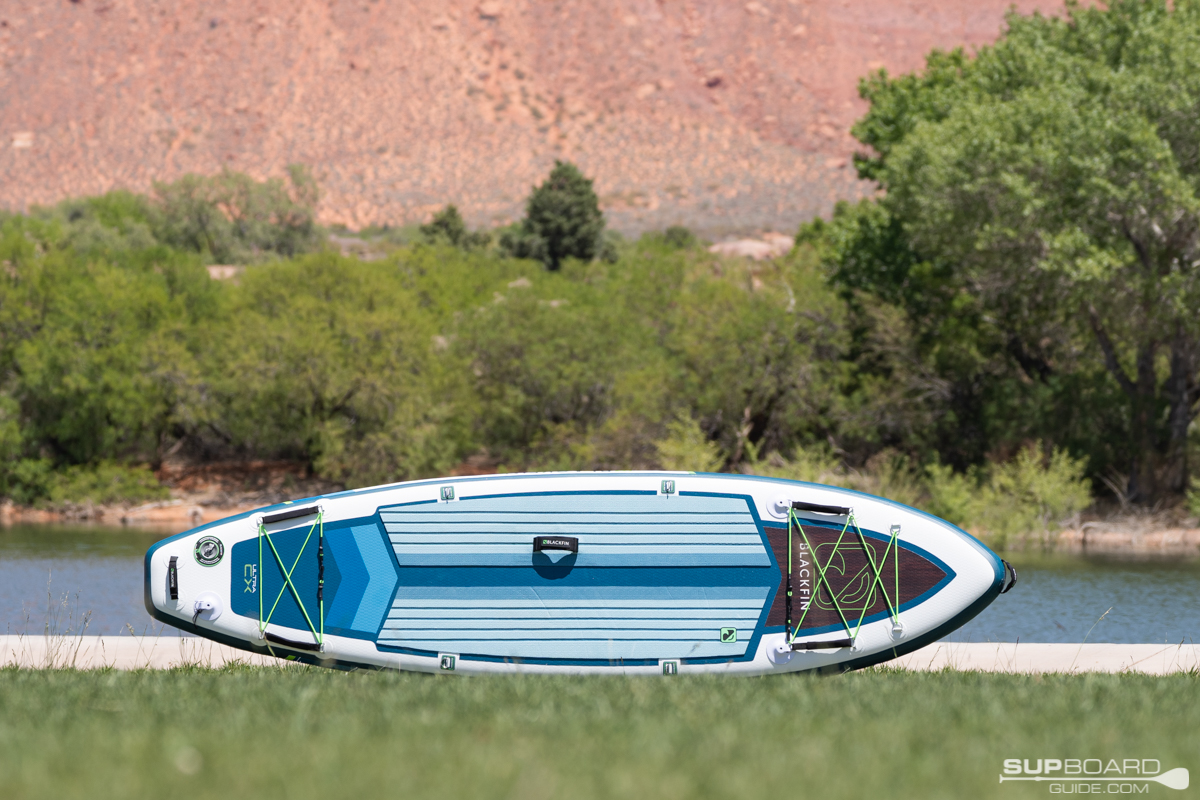
- Extremely compact design fits into a 2’x’1 backpack
- Lightweight SUP at 19.8 lbs with a comfortable backpack = easy to carry on an light hike or through an airport
- Can be packed small enough to pass as a carry-on item in some airports (though your paddle will need to go in a checked bag)
- Rigid construction contributes to good performance on the water
- Stable design that’s still agile and responsive, a good balance between stability and performance
- 5 piece paddle has a bit more movement in the connection joints than we’d like
- This SUP only comes with an electric pump, meaning you’ll have to rely on a power source to inflate your SUP
The Blackfin CX Ultra is part of iROCKER’s new compact SUP series. Each SUP in this series packs down extremely small and comes in our new-found favorite SUP backpack. It also comes with iROCKER’s 12V Electric Pump, which has held a spot on our Best Electric Pumps list for several seasons in a row.
Of course one of the most notable things about this SUP is that it’s able to fold in half, before being rolled up. This, in combination with its 5-piece paddle, enables this kit to pack down astonishingly small into the Ultra-series backpack, which ends up having a 2’ x 1’ footprint. Because of this, the CX Ultra fits nicely into a loaded-up car, and can sometimes even pass as a carry-on for some airlines (if packed correctly).
More than that though, the included bag is one of the most comfortable SUP packs we’ve ever tested. The shoulder and back straps are well padded and come equipped with a sternum strap, while the overall size of the pack helps to distribute the weight evenly. It’s a great SUP pack for hiking due to its comfortability. However, this SUP does not come with a manual pump, which means that you’ll need to invest in a hand pump if you’re planning on taking this SUP into remote locations away from your car or power source. Alternatively, you could invest in iROCKER’s portable battery pack, but carrying the electric pump and the battery pack in one bag with your SUP and accessories does get heavy to haul on longer hikes.
When it comes to performance, the Blackfin CX Ultra checks all of our boxes. It’s rigid and responsive while still being stable enough for entry-level paddlers. Though its quick and agile nature will let more advanced paddlers have fun too.
In short, this well-constructed, 19.8 lb SUP is a great investment for paddlers looking to travel with a high-performance SUP, but don’t want to be bogged down with a large, heavy gear bag.
2. Red Paddle Co. 11’/9’6 Compact ( See Full Review )
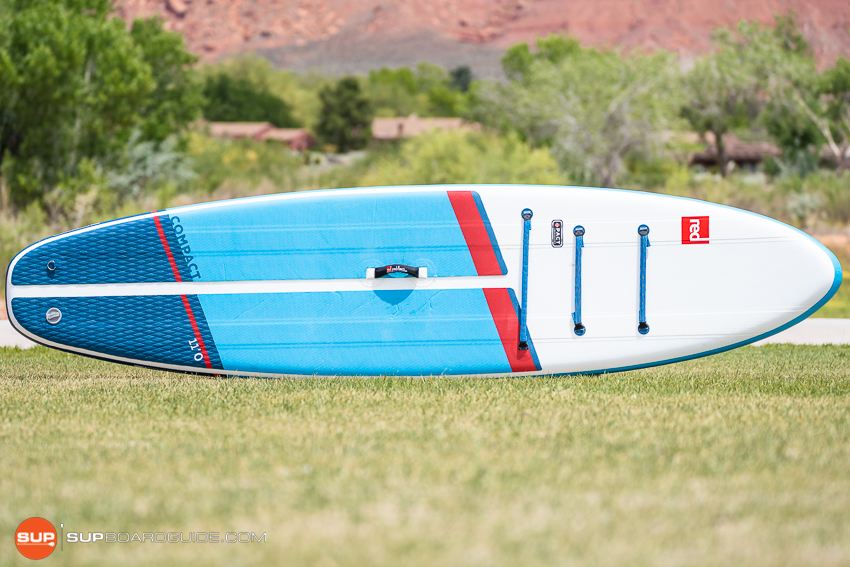
- Folds tightly into a compact backpack
- 4.75” thickness lowers the paddler center of gravity and gives this SUP a hardboard-like feeling
- Is shipped with Red Paddle Co.’s Titan II Pump, the most efficient handpump on the market
- Extremely lightweight at just 18.5 lbs, which is nearly unrivaled in the category of 11’ iSUPs
- Twin fin system makes for nice manueverability without hindering tracking
- 5 piece paddle is super solid because RPC angled the joining sections
- Red Paddle Co MSL construction is one of the best in the industry
- We’d appreciate more padding on the shoulder straps, as the backpack can be unfcomofrtable to carry for longer periods of time
- Not the most rigid SUP we’ve ever tested, though this doesn’t massively affect it’s performance for us
Red Paddle Co. is a detail obsessed brand, and their 9’6 and 11’ compact SUPs serve as tangible proof of this fact.
Like the Blackfin CX Ultra, the 11’ and 9’6 Compacts have split deck pads, which allow them to be folded up the middle (hotdog style) before being rolled up. However, Red Paddle Co. has made this, sometimes challenging, packing job a little bit easier on their most recent Compact series by sectioning out their deck pad horizontally as well, giving the board pre-determined ‘folding points’ that the paddler won’t have to wrestle with.
Once folded around the included Titan II handpump, the Compact fits nicely into the Red Paddle Co. Compact bag. While this bag is similar in size to the Blackfin CX Ultra that we discussed above, it does have a little bit more depth to it, which causes it to protrude outward from your back a bit further. This, combined with the very lightly padded shoulder straps, can make this bag a little uncomfortable to wear and carry for longer hikes – though this is really our only ‘qualm’ with this board. We really like how small this bag is, as it can be stored under the backseat of a truck and is super easy to bring through an airport with little fuss.
Where the Red Paddle Co. Compact really shines for us is in the performance category; this SUP has been Justin’s personal favorite for about 2 years now. One highlight is that this SUP is only 4.7” thick (others are typically 6” thick), which lowers the paddler’s center of gravity and offers a more stable feeling in chop or waves. And, combined with Red Paddle Co.’s rigid, woven drop stitch construction and quad stringer system, the Compact feels a lot more like a hardboard than other inflatable SUPs. We also love the maneuverability that comes with their twin fin system, as it gives the compacts such a fun, playful feel.
One final accolade to the Red Paddle Co. Compacts is that their included 5-piece paddle is the most solid 5-piece paddle we’ve tested due to Red’s carefully angled design at the joining points.
So, while a SUP from Red Paddle Co.’s compact series is definitely a sizeable investment compared to other compact iSUPs, it would make a great choice for a paddler that wants the highest performance possible out of an expertly designed compact SUP.
3. iROCKER Cruiser Ultra ( See Full Review )
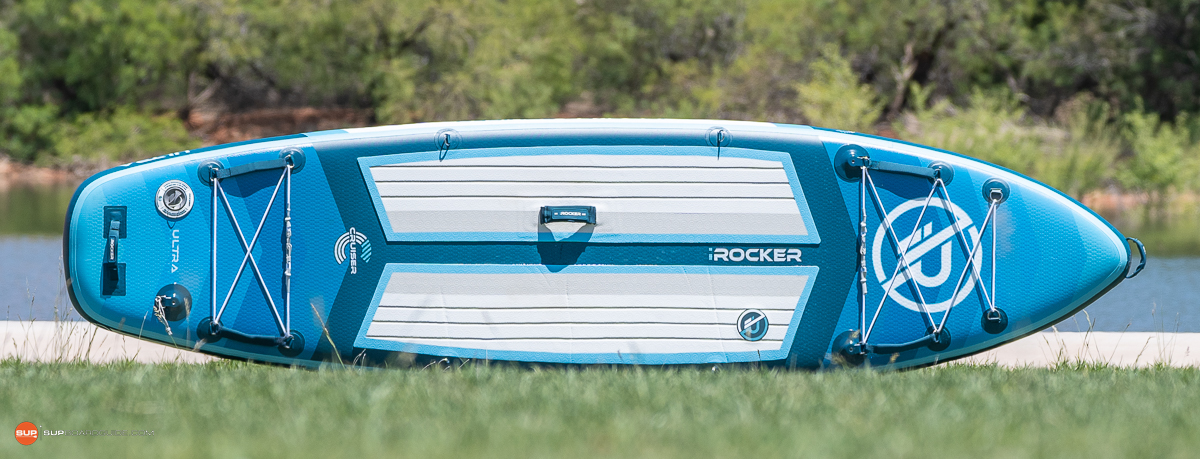
- Lightweight 21 lbs, easy to carry on your back to a more remote body of water
- Folds into iROCKER’s new compact backpack that measures about 2’ x 1’
- One of the most stable compact SUPs we’ve tested – good for paddlers who are new to the sport or wanting to bring along some gear
- Highly maneuverable on the water, even for an all-around, but also has great tracking capabilities
- Performance is more responsive and a step above most other stability-oriented boards
- Is Shipped with iROCKER’s 12V Electric Pump
- Measured a hair narrower than it’s spec’d width. Not a huge deal, but it’s not quite as stable as iROCKER’s Cruiser Original
The iROCKER Cruiser Ultra comes from the same ‘Ultra series’ as the Blackfin CX ultra that we discussed above. However, the two differ in performance.
Although the Blackfin CX Ultra and the Cruiser Ultra are both spec’d to be about 33” wide, the Cruiser Ultra’s wider tail and rounder nose make it noticeably more stable than its counterpart. As expected, it is also a touch slower and less nimble. However, due to its rigid, cross-woven construction, the Cruiser Ultra is a hair more responsive, and concurrently less stable, than iROCKER’s original Cruiser. Still, it’d make a great choice for an entry-level paddler in need of a travel-friendly, compact SUP or a more advanced paddler that wants to bring along gear or pets.
And, as we stated earlier, the Cruiser Ultra can be folded in half the same way as the Blackfin CX Ultra and fits into the same 2’ x 1’ compact backpack. It’s comfortable to carry, and also comes with iROCKER’s Electric pump, though again, we’d recommend investing in a manual pump if you intend on hiking this SUP significant distances to paddle, otherwise, iROCKER’s portable battery pack would work as well.
In general, though, the Cruiser Ultra really does share a ton of similarities with the Blackfin CX Ultra above. However, it does serve as a more stable compact option for paddlers who need a bit of extra volume, whether that be to mitigate any entry-level paddler wobbles or to provide support for gear and passengers.
4. Nixy Huntington Ultra Compact ( See Full Review )
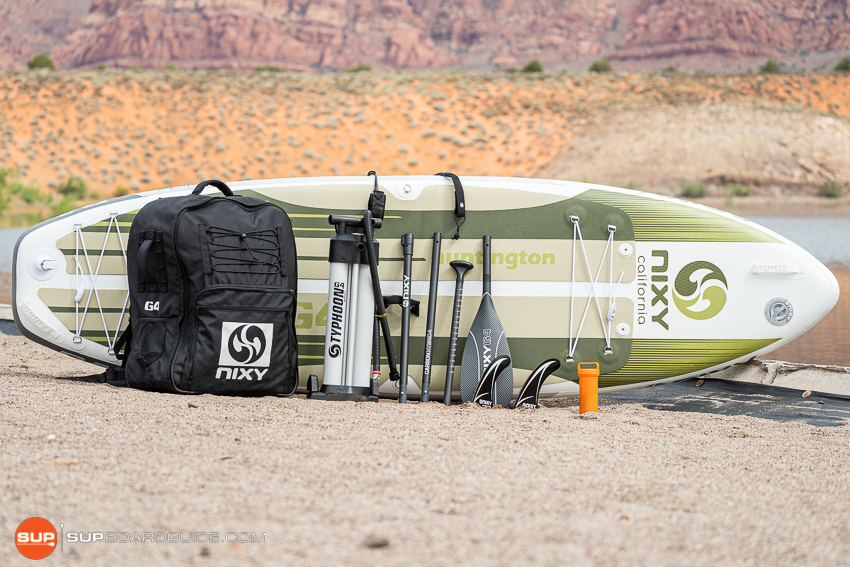
- Nimble, maneuverable SUP at just 9’6, but still forgivingly stable at 32” wide
- Packs down into Nixy’s compact backpack, which is comfortable to carry and has tons of organizational space
- 4-piece paddle is a bit more solid than a 5 piece paddle, and we love that it’s made entirely of a carbon fiber hybrid
- One of the more comfortable backpacks to carry on a short hike
- Built with Nixy’s rigid and lightweight construction that makes for higher performance, and more responsive feel on the water
- At 9’6, this SUP is mainly limited to shorter paddlers
The Nixy Huntington Ultra Compact was one of the earlier compact SUPs on the market, and it has easily withstood the test of time.
Like other compact SUPs on this list, the Huntington Ultra Compact has a split deck pad which enables you to fold it in half before rolling it up into the included compact backpack.However, this compact bag is a little big larger than others and has an array of organizational pockets, which is super nice if you’re packing all of your paddling gear in one bag. There’s plenty of room for a towel, wetsuit, a change of clothes, or other smaller items that you choose to bring with you. Because of this, and its comfortability, the Huntington Ultra Compact backpack is great for hiking. One last thing to note here is that the actual size of the folded SUP is much smaller than the bag itself, so if you need it to be even more compact for a flight it’d be a good idea to get it tightly wrapped at the baggage counter.
Part of the reason that the bag is larger is that the Huntington Ultra Compact’s paddle breaks down into 4 pieces, rather than 5, which obviously makes the sections a little bit longer. Of course, the upside to this is that the paddle feels really solid since there aren’t as many weak points. It also helps that Nixy’s included paddle is made entirely of a lightweight, rigid carbon fiber hybrid.
Performance-wise, The Huntington Ultra Compact is great if you’re a smaller-midsize paddler. This SUP is only 9’6, which is on the shorter side, especially for paddlers above 5’9. As expected, its shorter length does make it extremely sporty and maneuverable, while its impressively stiff but lightweight construction makes it very responsive. However, the Huntington Ultra Compact is more rounded on the nose and wider through the tail, so while it is stable, it’s also a little bit slower than other 32” wide SUPs.
The Huntington Ultra Compact would be a good option for smaller paddlers who don’t need a compact SUP that packs down super small, but just need a SUP that’s easier to store and fit in the trunk or backseat of a car. I’d also recommend this SUP for paddlers who need a little more versatility out of their compact bag.
5. Honu Byron ( See Full Review )
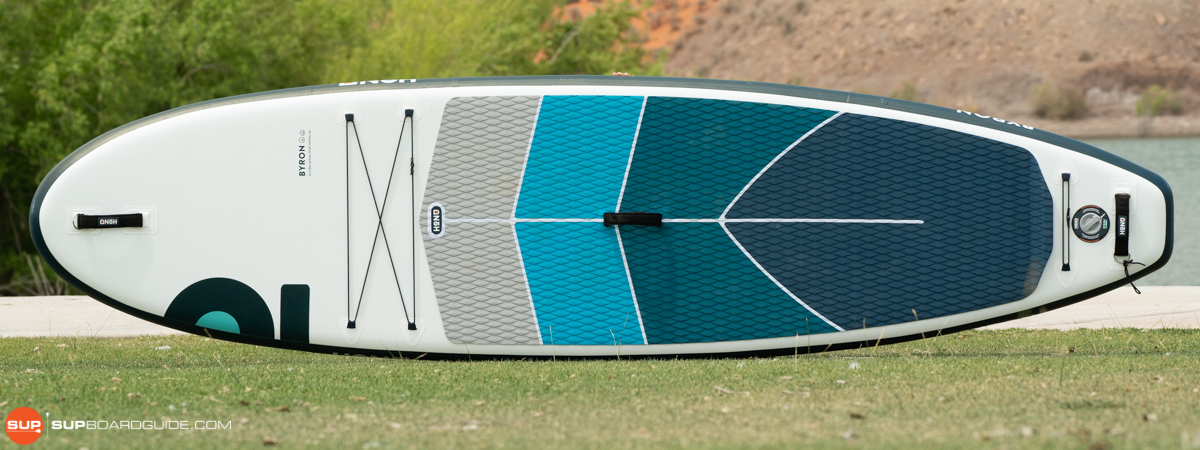
- High-performance all-around; this SUP feels like a sporty hardboard on the water
- 4.7” thickness lowered your center of gravity for more stability in waves and chop
- Honu’s impressive construction makes this one of the most rigid 4.7” thick boards we’ve ever tested
- Lightweight at just 16.9 lbs, this board is extremely easy to throw on your back and carry to a more remote lake or beach
- Does not pack down into a ‘compact’ backpack like others on this list, but because it’s so light, it is relatively easy to travel with and offers fantastic performance
The Honu Byron, while not a dedicated compact SUP, is still extremely travel friendly thanks to it’s lightweight and minimalist design.
At just 16.9 lbs, the Byron is the lightest SUP on this list. Being that the rest of the SUP kit only consists of a lightweight roller bag, an FCS fin, and a coiled leash, Byron’s pack remains comparatively lightweight and easy to carry. And, while this SUP pack is not small enough to be a carry-on, it would be a relatively lightweight checked bag for air travel. It’s also surprisingly comfortable to carry on shorter hikes, though the placement of the wheels can get annoying during longer treks.
The main reason that the Byron made this list, aside from the fact that it’s extremely lightweight, is because its performance and construction are extremely impressive. The Byron, light the Red Paddle Co. Compact series, is only 4.7” thick, but it is significantly more rigid. In fact, the Byron outperformed the Red Paddle Co. 11’ Compact in our bend test (read more about that in the Byron’s individual review ), despite being inflated to a lower PSI. This SUP feels extremely similar to a hardboard, and we love that’s light and quick, and extremely maneuverable.
So, although the Byron is not fully a ‘compact’ SUP, it is still easy enough to travel with or hike into a more remote lake, and the performance is top-notch. One final thing to note though is that the Byron does not come with a paddle, but you can bundle one of Honu’s paddles (they’re great, we love them) with your SUP for a discount.
6. Sea Gods Skylla ( See Full Review )
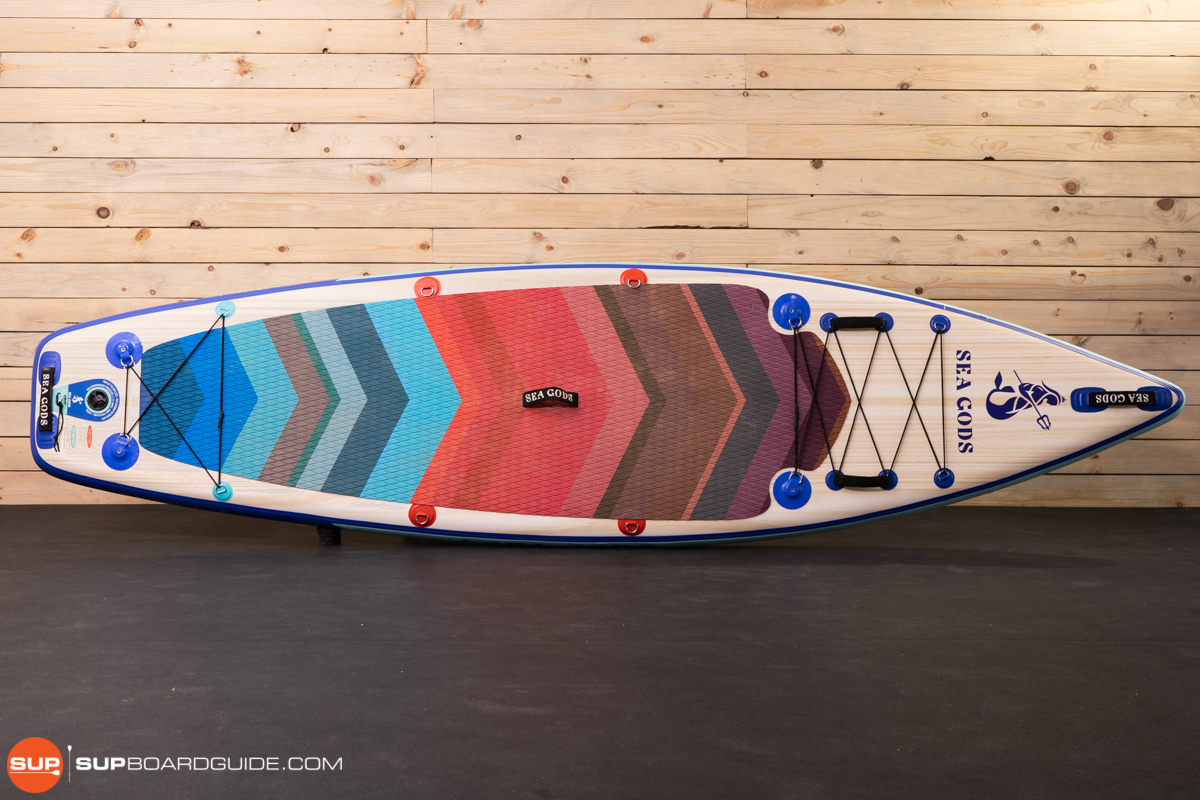
- Extremely stable but also among the faster boards on this list
- Sea Gods cross-woven drop stitch construction makes the Skylla lightweight at just 19.5 lbs, but also their stiffest iSUP
- Included roller backpack is comfortable to carry on short-moderate hikes and has extra space for towels, snacks, or other accessories
- Comes with a higher quality 3-piece carbon fiber paddle
- This SUP is definitely larger than other compact options, but it;s still lightweight and comfortable enough to carry on a hike or wheel through an airport
The Sea Gods Skylla is also not a dedicated ‘compact’ SUP that folds in half ultra-small, but it is very lightweight despite it’s larger size.
At just 19.5 lbs, the Skylla is extremely easy to carry and is even lighter than the iROCKER Cruiser Ultra that we discussed above, despite being dimensionally larger. The Skylla is extremely stable with its 33” width carried back through its wide-set tail, though its tapered nose cuts down drag and lets it pick up a bit more speed than a typical all-around. It’s one of the best all-around/touring cross-over boards we’ve ever tested, and we love that it nicely balances maneuverability with tracking. It’s a good, efficient board to paddle for longer distances, but you’re still able to paddle with pets or load up with camping gear.
And, because the Skylla is so lightweight the total pack weight isn’t astronomical either, which makes it a little easy to throw on your back for a hike. The backpack itself is comfortable as well since Sea Gods made sure to add plenty of padding to the back and shoulder sections. We also love that they placed the wheels opposite of the shoulder straps, as otherwise, the wheels on your lower back can get annoying when you’re carrying the pack for longer distances. Of course, there are sternum and hip straps as well, which work nicely to distribute the load of a larger pack. It’s made out of study material too, which would make us more comfortable checking this SUP in at the airport.
Overall, the Skylla is a great travel-friendly option for paddlers who want a bit more of a touring-board style than dedicated compact SUPs are able to offer.
7. Atoll 11’ ( See Full Review )
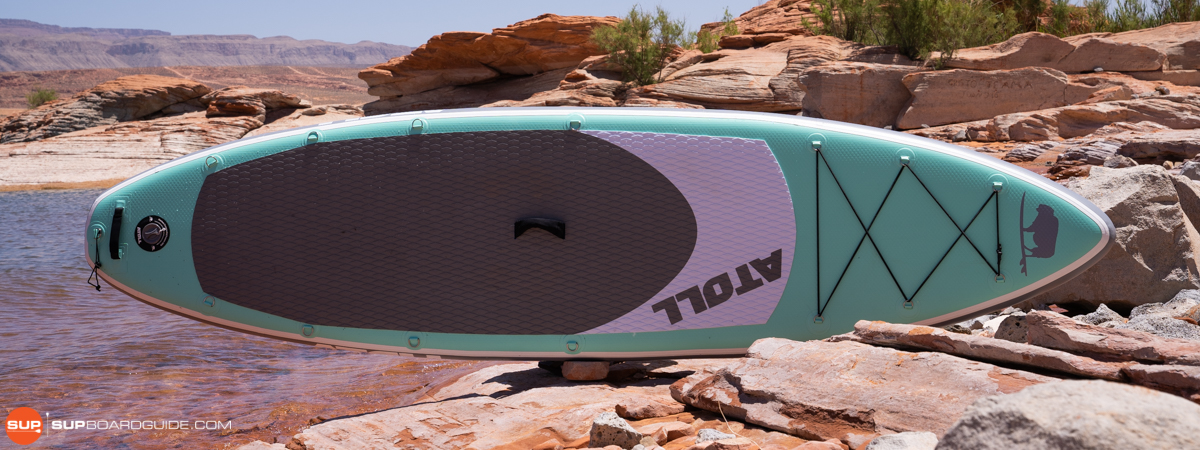
- Performance is a good balance between a touring SUP and an all-around; it’s relatively fast, but also easily manueverable and has a decent amount of stability
- Atoll has left gear storage and customization up to you with 8 extra D-rings
- Being 21 lbs, this SUP is on the lighter side and is easy for most paddlers to carry on their back or down to the water
- Backpack is pretty comfortable for longer walks to the water
- Atoll does not use the most advanced construction techniques or stock the highest quality accessories, but this is still a good, travel friendly, entry-level SUP
The Atoll 11’ is a simplistic and affordable ‘jack of all trades’ type of SUP, though it’s lightweight build and comfortable backpack earned it a spot on this list.
The Atoll 11’ is just 21 lbs, making it very manageable to carry on your back. The total pack weight is relatively light as well since this SUP comes with just a single fin, a light fiberglass paddle, and a coiled leash. Because of its pack weight and comfortability, the Atoll 11’ remains one of our top recommendations for SUP hikers that don’t prefer a split deck pad or a 4-5 piece paddle that typically comes with dedicated compact boards.
The construction on the Atoll 11’ isn’t as high-tech as others on this list, but it still performs well, especially at its affordable price point. It’s relatively quick as an all-around SUP and its single dolphin-style fin set-up keeps it easily maneuverable. It has a comfortable level of stability as well that is forgiving for entry-level paddlers, and supportive for paddlers who bring along extra gear or bring a pet on board.
However, we do want to note that while this SUP pack is great for hiking, the material may not be heavy-duty enough to withstand the abuse at an airport. We’d recommend getting this bag wrapped before checking it for your flight.
In short, the Atoll 11’ is a great option for paddlers who want a travel-friendly SUP on a budget without making big sacrifices in performance or quality.
8. Paddle North The Portager ( See Full Review )
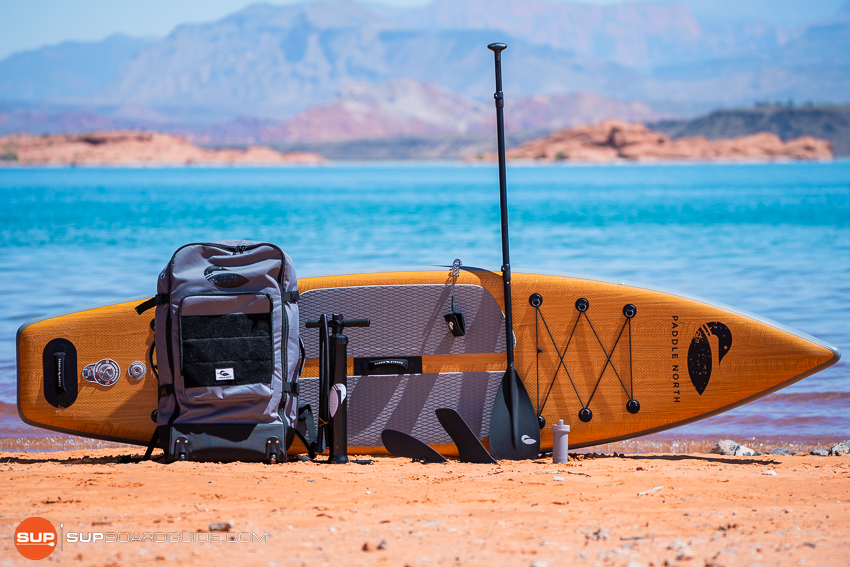
- Has a built-in pressure regulator which helps mitigate the risk of your SUP’s pressure getting too high when left out in the sun
- Good touring, all-around crossover; the Portager is relatively fast but isn’t unstable or difficult to maneuver
- Lighter weight at 21 lbs, it’s easy rough to transport and carry
- Rigid construction makes for good performance and a good ability to haul gear
- We would have appreciated a lighter weight fiberglass paddle rather than aluminum
- Deck pad is fairly small, but this is one way that Paddle North was able to keep this SUP light
The Portager is another affordable, but good quality option for paddlers looking for a travel-friendly SUP that almost broaches touring board territory.
Being 11’6 x 33”, the Portager is plenty stable for a wide range of paddler sizes and skill levels, but at just 21 lbs, it’s still easy to carry and doesn’t take a ton of effort to load on your back. However, its pointed nose helps keep this board quick on the water while its hatchet-style fin keeps it directional.
Comfortability-wise, the Portager’s pack isn’t too bad to haul on a shorter hike. However, there’s not much padding on the shoulders or back areas, and the straps can start to dig in if you’ve got a long walk to the water. I do like that this backpack has a nice front pocket, and the velcro section is a nice touch. It pairs with Paddle North’s paddle challenge patches, which operate on an honor system but are a great idea to get the paddling community engaged and focused on common goals.
Most notable about the Portager though is its built-in pressure regulator. While it does require regular upkeep, the regulator stops your board from being over-pressurized when sitting out in the sun or in hot conditions for extended periods of time. This is a great addition if you’re paddle camping for a few days and need to keep your SUP inflated, as it helps to mitigate the risk of a seam rupture due to too much pressure.
The pressure regulator, and its lightweight build, earned the Portager’s spot on this list, as we think it’s a good option for campers who frequent hot, sunny climates, like SUPBoardGuide’s home here in southern Utah 🙂
Tips for Traveling With Your SUP
Traveling, in general, can be anxiety-inducing, so throwing a SUP in the mix can only add to that. Of course, the best way to combat this is to go in with a plan and know what to expect.
Know your Airline’s Bag Restrictions
Over the last 2 years, it seems like airlines have made a lot of changes to their Bag Restrictions. With some making travelers pay for carry-on items, and others changing their size limitations. It’s hard to know exactly what’s in clear to throw in the overhead bin.
When it comes to compact SUPs, there are some that can pass as a carry-on, if packed correctly. However, even with these SUPs, you will need to check at least one bag anyway since a paddle is often not allowed to be carried onto the plane.
No matter what though, it’s always good to get thoroughly familiar with your airline’s baggage rules and pack and plan for your SUP accordingly.
Protect your Pump and Paddle
While your SUP itself can take a good beating, the more fragile items in your SUP pack are your pump and paddle. We recommend wrapping these items inside your SUP as you’re packing it up. The tough PVC will provide a lot of protection and help to stabilize everything whether you’re flying or hiking into a body of water.
Opt for a Manual Pump
This is probably the only time we’ll ever favor a manual pump here on SUPBoardGuide, but it does help to lighten your overall load. An electric pump is always going to be heavier than a manual pump, and this is especially important if you’re hiking with your SUP. There’s also the added risk that an electric pump would get damaged if taken through an airport, which would obviously render your SUP useless when you arrive at your destination.
Get A High-Quality Backpack (or wrap it)
All of the SUPs on this list come with backpacks that are sturdy enough to withstand plenty of rough handling. However, if you do have any doubts, it doesn’t hurt to switch it out for a large, heavy-duty duffle bag. Alternatively, you can ask for your bag to be wrapped before checking it in.
Summary of Best Compact SUPs for Travel
We think being able to easily travel with your SUPs is one of the best perks of inflatables. If you’ve ever paddled with an epoxy board, you know that it is a hell of a hassle, and comes with constant worrying that your board will be in several pieces upon arrival.
And, while all of the SUPs on this list will be especially great for traveling due to the criteria we discussed in the beginning, the truth is that nearly an inflatable is ‘travel-friendly’ to a degree. As long as it folds down into a bag, it can ultimately be toted anywhere with just some careful planning and mindfulness.
The bottom line is that there is an endless amount of gorgeous places to paddle all over the globe, and it’d be a shame if we didn’t venture to at least a few of them.
As always, we hope you’ve found this page helpful, but don’t hesitate to reach out to us in the comments below with any questions.
Safe Travels!
- Latest Posts
SupBoardGuide
Latest posts by supboardguide ( see all ).
- OutdoorMaster Shark II Electric SUP Pump Review | Tested - May 24, 2024
- Isle Switch Pro Review (2024) - May 21, 2024
- Isle Switch Compact Review (2024) - May 14, 2024
Leave a Comment Cancel reply
Save my name, email, and website in this browser for the next time I comment.
Best Compact Paddle Boards for Traveling (2024)
By David De Haan
Last update: October 24, 2022
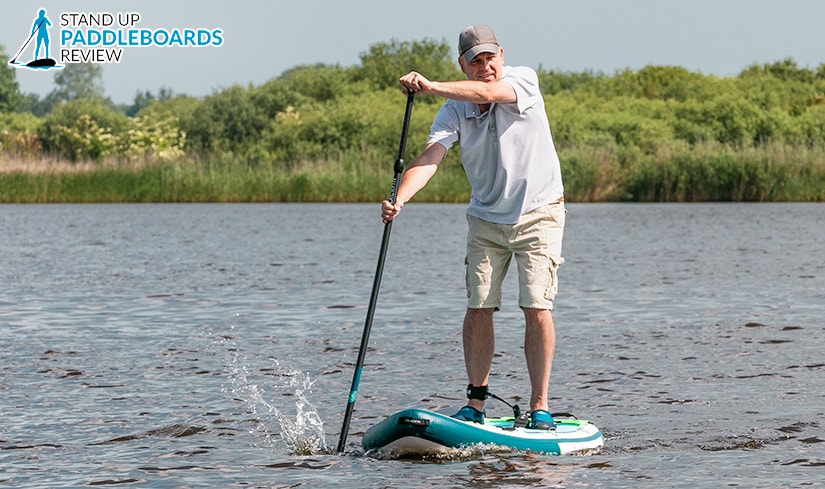
Do you need a compact stand up paddle board for traveling or remote adventures? The new breed of inflatable paddle boards are smaller and lighter than ever before.
I’ve tested the top compact SUPs on the market to see which gives the best performance for its size . My top pick for smaller paddlers is the Blackfin CX Ultra . For larger paddlers, the iRocker All Around 11’ Ultra is a good alternative.
Compact paddle boards have a unique design that means they roll up to around half the size of a regular inflatable paddle board. This makes them easier to transport, but is their performance on the water up to scratch?
Read my compact inflatable paddle board reviews below to find out!
Best Compact Paddle Boards Compared
For Small Paddlers
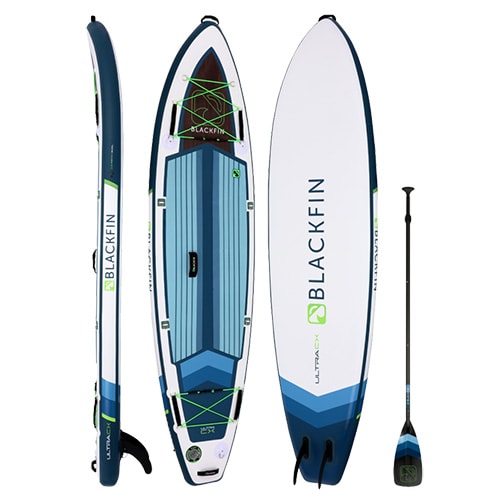
Blackfin CX Ultra
Fast, Maneuverable Board For Light Paddlers
This stylish board is stable enough for small paddlers and performs great on the water. The deck pad is especially comfortable, but larger paddlers may find it too unstable.
For Tall Paddlers
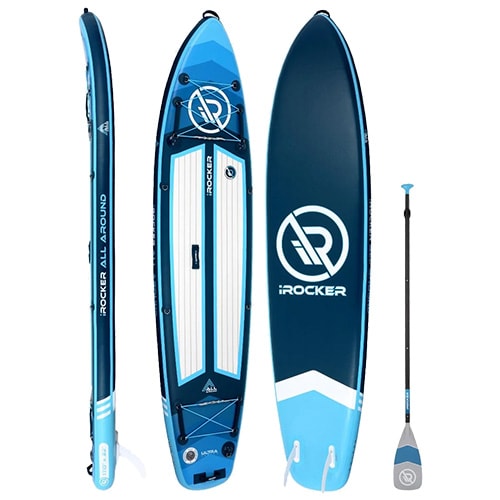
iRocker All Around 11’ Ultra
Stable Board With Good Performance
A great all-around board for larger paddlers and comes in a gorgeous range of colors (although the 10’ Ultra may be better for smaller paddlers).
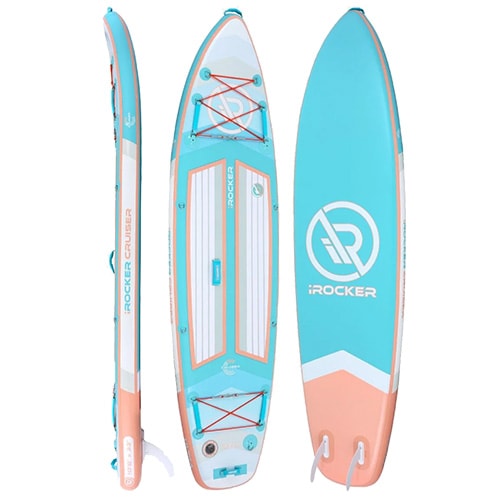
iRocker Cruiser Ultra
Stable Board With Large Weight Capacity
The Cruiser is a great board for beginners and families. It’s very stable and has a big capacity for a compact board. This does make it slower than other boards.
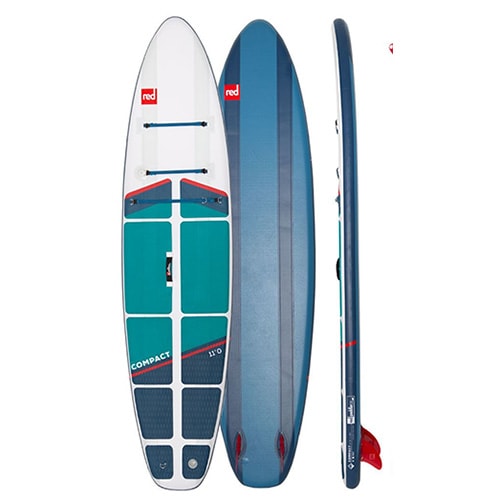
Red Paddle 11’
Expensive, But Great All Around Performance
Most compact boards don’t perform quite as well as their regular counterparts. This is the exception. It glides effortlessly and packs down into a surprisingly small pack. The board that does it all—for a price.
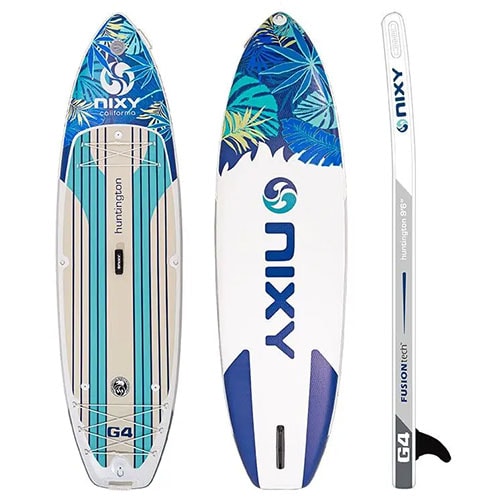
Nixy Huntington Ultra Compact
Great Value, Short Board
This 9’6 board is packed with features and is great value for money. It packs down small and offers decent performance for shorter paddlers, though taller people may find it too squirrely and unbalanced.
Most Lightweight
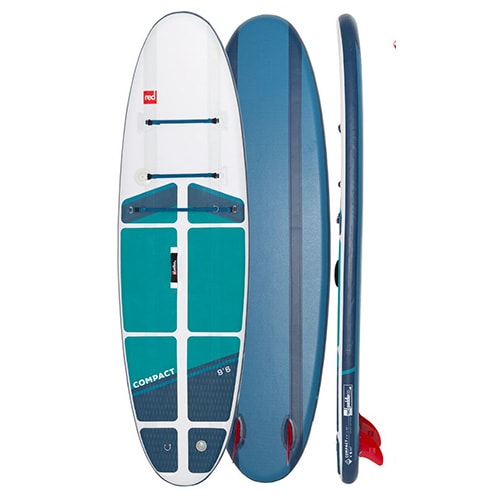
Red Paddle 9’6 Compact
Tiny, Lightweight SUP for Small Paddlers
The smallest adult inflatable SUP on the market! The low weight capacity means it won’t suit everyone, but small paddlers will appreciate how well it performs for a short board.
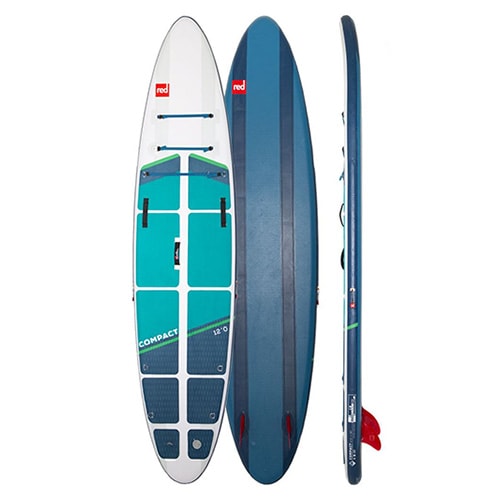
Red Paddle 12’ Compact
Compact Board Designed For Touring
A board that’s designed for adventurous paddling and remote expeditions. This isn’t a board for beginners, but experienced paddlers will appreciate the smooth glide and comfortable backpack.
The Best Compact Paddle Boards of 2024
Check out my inflatable paddle board reviews below to find out which of these SUPs is the best compact paddle board for traveling.
1. Blackfin CX Ultra—Best Compact Paddle Board for Small Paddlers
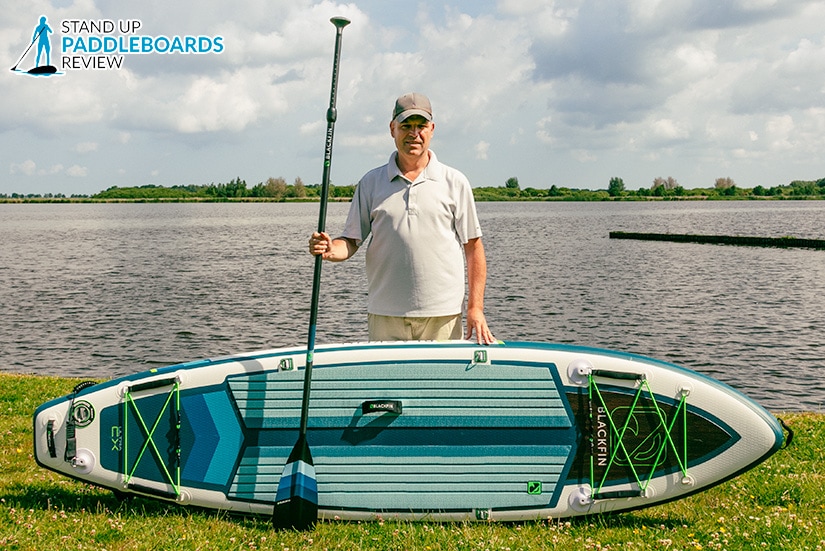
The Blackfin CX Ultra is the same length as its cousin, the Blackfin X, but it’s much narrower—32.5-inches compared to the standard 35-inches. While I rate the regular model as one of the most stable boards for its length, I found the CX felt unstable for someone of my height and weight.
Then my wife jumped on board. She loved the CX! For her, it was plenty stable enough and fast and maneuverable in the water. The long fins meant it tracked well, too. It just goes to show that no board is perfect for everyone – the CX could actually be one of the best inflatable paddle boards out there for lighter paddlers who want something more compact.
Finding a SUP board that’s suited to your size, height and weight is absolutely crucial, and our testing proves that.
We both really liked the soft, comfortable deck pad and the stylish design – upon closer inspection, we discovered that the deck pad is actually thicker than that of other inflatable stand up paddle boards. The quality of Blackfin’s inflatable boards is top-notch, so I have no doubts that the CX Ultra is durable enough for years of regular use.
The CX Ultra comes with a premium accessory pack. You get an electric pump, leash, pair of fins, and a five-piece carbon paddle with a nylon blade. I particularly liked the backpack. It’s super compact, but the roll-top design means you can expand the capacity to give you extra space for stashing clothes or other gear. There are plenty of pockets, plus a handy pouch for smaller accessories.
If you want a decent around inflatable stand up paddle board that’s compact and suited to lighter paddlers, this could be it.
- Stable and fast: Small paddlers will find the CX stable and easy to paddle (if you are the correct size and weight for the board). The smaller size makes it very maneuverable, and it’s surprisingly fast in the water!
- Large deck pad: The CX’s deck pad is nice and soft. It’s thicker than the deck pads on other boards, which makes it more comfortable for paddling long distances.
- Beautiful aesthetics: This board is gorgeous! I love the dark brown, wood print nose and the green accents. It’s really eye-catching.
- High-quality accessories: The CX comes with an electric pump, carbon fiber paddle (with a nylon blade), leash, and fins. I really like the design of the backpack—it’s comfortable and very practical.
- Unstable for larger paddlers: While my wife loved the CX Ultra, I found it too unstable.
Check Price of the Blackfin CX Ultra
2. iRocker All Around 11 Ultra—Best for Larger Paddlers
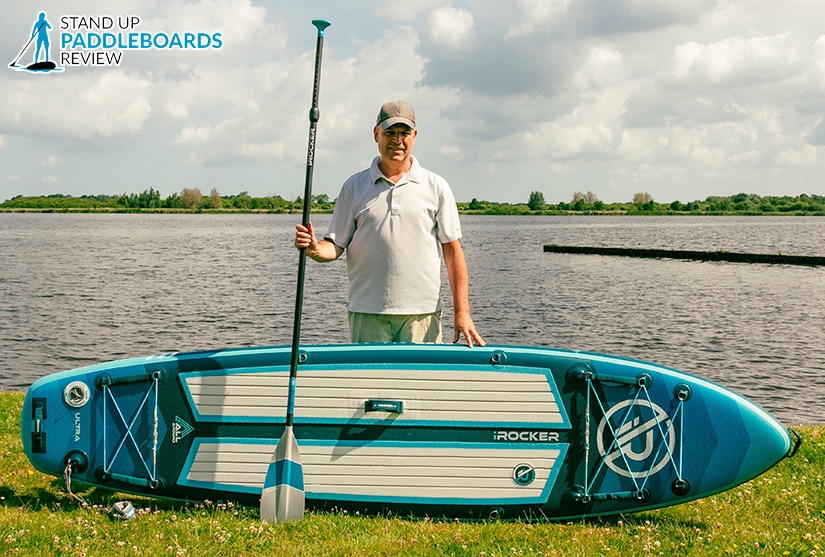
The iRocker All Around 11 Ultra was a more stable board for me. It wasn’t as stable or as fast as the regular All Around 11, but I was happy with its performance given its compact size.
However, my wife found it much less stable than the Blackfin CX Ultra, perhaps because of the extra length or maybe because the board sat higher on the water due to her lighter weight.
Based on our testing, I’d recommend tall paddlers try the All Around 11 Ultra and smaller paddlers stick to the Blackfin CX. Alternatively, shorter paddlers (under 5’ 5”) may find the All Around 10 Ultra to be more stable and easier to paddle.
This paddle board features a cool gradient design on the nose and comes in a choice of 5 colors. I love that the paddle and backpack match the board color and design. The iRocker All Around 11 Ultra is cheaper than the Blackfin CX but you still get an electric pump, so you can save your arm muscles for paddling! It’s a good all around inflatable SUP for larger paddlers who still want a compact inflatable.
- Good performance: For a compact board, I was pleased with how fast and smooth the All Around 11 Ultra was. I expected to sacrifice more performance compared to the regular board, but this wasn’t actually the case.
- Moderately stable: I’m 6’1” and found this board to be stable enough for me. If you’re a complete beginner, you may prefer the Cruiser Ultra, which I also tested and reviewed below
- Great range of colors: I love the design of this board. The blue color scheme is my favorite, but they all look stylish. Even the accessories are color-coordinated!
- Shorter paddlers may struggle: My wife found this board to be pretty tippy. I’d recommend small paddlers stick to a shorter board like the Blackfin CX, particularly if you’re new to paddle boarding.
Check Price of the iRocker All Around 11 Ultra
3. iRocker Cruiser Ultra
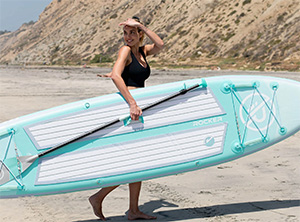
The iRocker Cruiser Ultra is a great beginner board. At first glance, it looks similar to the All Around 11, but it’s shorter (10’6”), wider (33”), and has a broader tail. This makes it a lot more stable.
I wouldn’t recommend this board for advanced paddlers. The shape of the board makes it slower than other models and it takes more effort to paddle. Like the regular Cruiser board, it’s best suited to families and those who want a stable board for practicing yoga or other activities.
Compact boards have lower weight capacities than their regular SUP equivalents. The Cruiser Ultra has one of the largest capacities I’ve seen for a compact board (300 pounds), which makes it a good choice for larger paddlers. You can even use it for fishing, as there’s plenty of storage, plus action mounts to install rod holders.
- Very stable: The wide design makes the Cruiser very stable. I’d recommend it for beginners or paddlers who want a board the whole family can use.
- Large weight capacity: The Cruiser has one of the highest weight limits of a compact board. This makes it a good choice for heavier paddlers. I also think it would make a decent platform for occasional fishing.
- Plenty of attachment points: As well as 3 action mounts (for attaching your GoPro, fishing rods, etc.), there are 14 D rings and two areas of bungee rigging. I like that you can remove the bungee cord (e.g. if you want to practice yoga).
- Slower than other boards: The Cruiser’s stable design means it requires a bit more effort to paddle than other boards and it’s slower in the water.
Check Price of the iRocker Cruiser Ultra
4. Red Paddle 11’ Compact
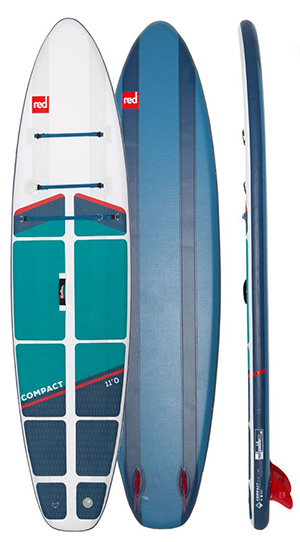
The 11’ model is Red Paddle Co.’s mid-sized compact SUP, and the one I’d recommend for most users. It’s the same length (11’) and width (32”) as the iRocker All Around 11 Ultra, but much thinner—4.7 inches rather than 6 inches.
Despite this, the board feels really solid on the water. It glides nicely and because it’s so lightweight, it’s easy to get up to speed. The tracking is pretty good too. The capacity is large enough for most paddlers and if you’re tall, like me, you won’t find it too unstable. In fact, I think even a beginner paddle boarder would do fine with this board, as long as you don’t mind a few dunkings during your first couple of trips out!
Red Paddle boards aren’t cheap, but their construction is second to none. This is reflected in the performance, which feels more akin to a regular inflatable stand up paddle board than a compact board.
It’s not just the board that’s more compact. Red Paddle Co has created a five-piece travel paddle that fits neatly in the 22-inch backpack. Even the pump is smaller!
In my opinion, the dual-chamber pump is currently the best SUP pump on the market. I challenge you to test the Titan 2 side-by-side with an electric pump—you’ll be surprised at just how quick and easy it is to inflate your board!
The only downside to this board is the price. It’s definitely not going to be in everyone’s budget, and I think there are other boards that are better value. But if you have the money and want the best of the best, this is it.
- Excellent performance: I love that Red Paddle Co. has taken on the challenge of creating a compact board that performs as well as a regular SUP. The amount of engineering and time that’s gone into this design is incredible.
- Top-quality accessories: As well as the efficient Titan 2 pump, you get a carbon hybrid paddle and a cleverly designed travel backpack.
- 5-year warranty: Red Paddle boards have a market-leading warranty. Make sure you register your new board to get the full 5 years.
- Expensive: This board gives you the best of both worlds—performance and convenience—if you’re willin
Check Price of the Red Paddle 11′ Compact
5. Nixy Huntington Ultra Compact
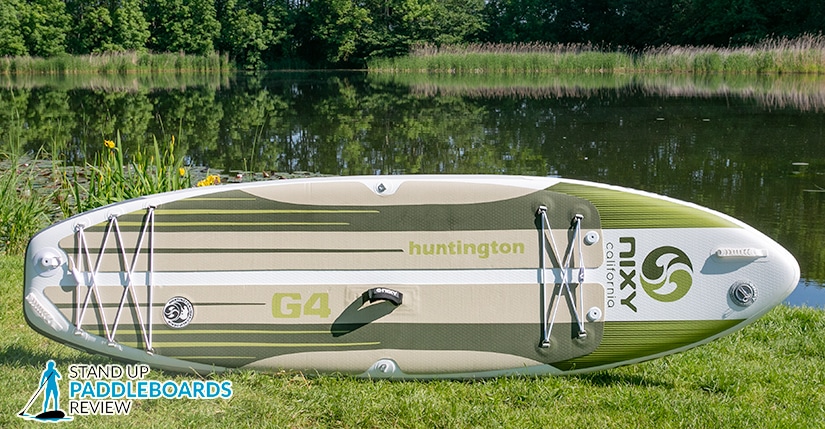
The Nixy Huntington Ultra Compact is one of the lightest, most compact paddle boards on the market. It has a similar spec to the Red Paddle 9’6 Compact, but is less than half the price.
The board itself weighs under 19 pounds and the total weight including the backpack and accessories is just 30 pounds. This makes it a good choice if you want to take it on a plane. If you remove the board from the carrying bag, you could even pack it and the accessories into your suitcase.
The Nixy Ultra Compact is also a good option for remote SUP adventures. It’s light enough to hike with and comes with a quality manual pump, so you don’t need to be near a vehicle to inflate it.
On the water, my wife found the board maneuverable and easy to glide. It’s a little tricky to balance, but if you’ve been paddle boarding a while, you should find it stable enough.
This board may be small but it’s packed with many of the same features the larger boards have, including action mounts, removable bungee storage, and D rings to attach a kayak seat.
I think Nixy’s boards are great value for money and the Huntington Ultra Compact is a versatile board for small paddle boarders.
- Very compact and lightweight: This board is small enough to pack in your suitcase or carry on your back for miles.
- Good performance for smaller paddlers: I’d recommend this board for shorter, smaller adults and teenagers. For larger paddlers, such as myself, I’d opt for a larger model for extra stability.
- Great value for money: I really rate Nixy’s boards in terms of value for money. This is a quality board, and you get lots of features for the price. You can often pick one up on sale, too!
- Manual pump: If you were hoping for an electric pump, you’ll be disappointed. However, Nixy’s triple-action pump will suit adventurous paddlers who want to take their board off the beaten track.
Check Price of the Nixy Huntington Ultra Compact
6. Red Paddle 9’6 Compact—Most Lightweight Paddle Board
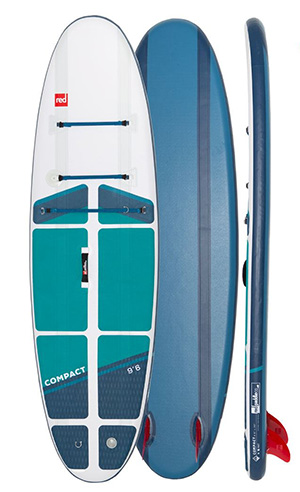
The Red Paddle 9’6 Compact is the smallest SUP in Red Paddle Co.’s compact range. It’s also the most compact, lightest SUP I’ve found. If weight and portability is your primary concern, this is the board for you.
The board itself weighs just 16 pounds. Together with the backpack and accessories, you’re looking at 28 pounds total weight. While that’s heavier than a day pack, I’d be comfortable hiking with it for several hours—especially if there’s a deserted lake or beach at the end!
That said, for me, personally, this board is a little too short. Red Paddle Co.’s patented Rocker Stiffening System (RSS) means it’s rigid enough to take my weight, even though I’m close to the weight limit (210 pounds), but the 11’ board is more stable and comfortable to paddle.
You get the same premium accessories as with the 11’ Compact, and they all pack neatly into a travel backpack that’s not much bigger than a carry-on bag.
- Lightest board on the market: You can’t beat this board for weight and portability.
- Good performance (for smaller paddlers): This board feels more stable and less squirrely than the Nixy. It glides nicely for its size, and I think average-sized and small paddlers will really rate its performance.
- Comfortable travel backpack: This backpack is one of the most comfortable SUP carrying bags I’ve come across, as well as being the smallest. I love that you can adjust the height and lumbar support to customize the fit. This helps reduce the pressure on your lower back and makes it comfortable to carry.
- Low weight capacity: This board has a much lower weight capacity than others. That said, Red Paddle’s MSL construction and patented stiffening system make me confident to load it up to the max.
Check Price of the Red Paddle 9’6 Compact
7. Red Paddle 12’ Compact
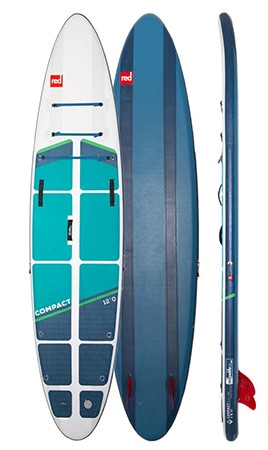
If you want a compact board for touring or exploring, then this is it. The Red Paddle 12’ compact is the biggest of their three models. It’s 12 feet long and 32 inches wide. The slender design means it cuts through the water smoothly and efficiently, letting you glide effortlessly.
The extra length and weight capacity (265 pounds) also gives you more space to stash the kit. I think this would be an awesome board for paddling long river stretches (where you have to hike to or from the start/end point) or for carrying into remote mountain lakes or beaches.
The backpack is a little bigger than that used for the 9’6 and 11’ models, but it’s still around half the size of a standard SUP backpack. It has the same customizable lumbar support and adjustable height, which means you can tailor the fit, so it’ll be comfortable to carry, however long your walk in is.
- Designed for touring: I love that Red Paddle Co. has designed a compact board specifically for touring, rather than just sticking to the family SUP market.
- Compatible with FCS fins: You can switch out the two off-set fins for aftermarket fins to customize your setup for the water conditions.
- Large storage area: The adjustable cargo system lets you store small or large bags with ease. There’s also a set of four D rings at the tail of the board, which you could use to secure additional items.
- Not for beginners: While this is a great board for experienced paddlers, I wouldn’t recommend it for beginners. You’ll find it too unstable and hard to handle. That’s not a criticism of the board, it just reflects who it’s designed for.
Check Price of the Red Paddle 12′ Compact
Why Buy a Compact Paddle Board?
Regular inflatable paddle boards are small and light enough to transport in your car and carry short distances, but if you’re travelling further afield, a compact paddle board may be a better choice.
Compact paddle boards come with comfortable backpacks that are around half the size of a regular SUP backpack. They’re light enough to hike with or carry on a bike, motorbike, or scooter. You may also want to buy a compact paddle board if you’ll be taking it on vacation or you have very little storage space at home.
What’s the Difference Between a Compact Paddle Board and a Regular Paddle Board?
Compact paddle boards have a unique design. The inflation valve, carry handles, and fin are all positioned away from the center line, and the deck pad is often split down the middle. This means that you can fold the deflated board lengthways before rolling it up. Due to the design, compact paddle boards have a different fin setup—2 side fins instead of a center fin.
The paddle is also designed to fit into a smaller bag. With a regular inflatable paddle board, you typically get a 3-piece paddle. With a compact board, you get a travel paddle that breaks down into 4 or 5 pieces.
The boards are typically lighter and thinner than a standard paddle board. This means they have a lower weight capacity, though all the boards in this round-up will comfortably carry a single adult.
How to Choose a Compact Paddle Board for Traveling
Here’s what to consider when shopping for a compact inflatable SUP.
Is The Board Lightweight and Compact When Deflated?
The compact paddle boards in this review weigh between 16 and 22 pounds. This isn’t a lot lighter than regular boards – for comparison, the Atol 11’, my favorite all-around inflatable paddle board, weighs 21 pounds – but every little helps! If weight is a primary concern, then I’d recommend the Red Paddle 9’6 Compact.
If you’re going to be transporting your board on a bike or hiking with it then pack size will be a key consideration. The travel bag needs to be short enough that it allows you to sit comfortably on your bike and doesn’t hang down over your butt when hiking.
That’s the big difference between a compact and regular paddle board. Compact boards can fit in a 22-inch long pack. Travel packs for regular boards are around 38-inches or longer.
Does It Come as a Complete Kit?
Many paddle boards are sold without a paddle or other accessories, so paddlers can customize their setup. If you’re flying or hiking with your board, then you need all your kit to fit in one bag – not possible if you have a standard paddle. However, most compact paddle boards come with everything you need to get out on the water, including a travel paddle.
One decision you’ll need to make is whether you want an electric pump or a hand pump. Electric pumps make it easier to inflate your board, but if you don’t have a vehicle or battery to hand, they become useless.
If you know you’ll be using your SUP in remote locations or taking it on vacation when you won’t have a power source, I’d recommend choosing a compact board with a high-quality manual pump.
Does It Come with a Good Quality Travel Bag?
If you’re planning on carrying your paddle board any distance, you want a comfortable travel backpack. Your board may be lightweight, but it’ll still feel heavy after hiking for an hour!
Look for comfortable, adjustable straps, and a padded waist belt, so you can take some of the load off your shoulders. If you’re short and slim, then the length of the travel bag and adjustability of the straps will be particularly important.
How is the Performance?
The big question is, do these compact boards perform as well as a regular inflatable SUP? Based on my testing, the answer is no.
I was impressed by just how well the boards I reviewed did perform in the water, based on their size, but the equivalent (non-compact) models had the edge in terms of stability, speed, and price. The weight capacity of compact boards is also lower, which may be an issue if you’re a larger paddler or you want to carry lots of gear.
If pack size and weight isn’t an issue, then I’d recommend getting a regular inflatable SUP. However, you won’t lose too much in terms of performance if you pick the right compact paddle board for you.
The performance of a board varies considerably, depending on the weight and height of the rider. My wife and I had very different experiences of the boards we tested. I’ve tried to give an indication in my reviews as to which boards will suit different types of paddlers, but you know your own build and skill level the best!
Can You Travel with a Paddle Board?
Yes, you can travel with a paddle board! I think the Blackfin CX Ultra is the best compact travel paddle board.
What is the Smallest Stand Up Paddle Board?
The Red Paddle is the smallest, most lightweight board for adults. It weighs just 16 pounds and packs into a travel bag measuring 22” x 16.5” x 12.5”.
How Do You Transport a Paddle Board with a Small Car?
The easiest way to transport a paddle board in a small car is to choose a compact inflatable sup. Once deflated, you can pack it into your trunk alongside your other gear.
If you want a compact inflatable stand up paddle board for travelling, I’d recommend any of the boards in this roundup. They’re all excellent boards from manufacturers that I rate.
Your decision will most likely come down to which board you think will perform best for you. This will depend on your size and weight. I rate the iRocker All Around 11’ Ultra for larger paddlers, but for shorter folk, the Blackfin CX Ultra gets my top spot.
What will you use your compact board for? Let me know in the comments!

Ask a Question Cancel reply
Save my name and email in this browser for the next time I ask a question.
Best Inflatable Paddle Boards Best Cheap Paddle Boards What Size Paddle Board Do You Need?
About us Contact us
© SUP Scout 2024

- SUP Buying Guides
Best Compact Travel Paddle Board | Our 2024 Top Pick
- August 14, 2023
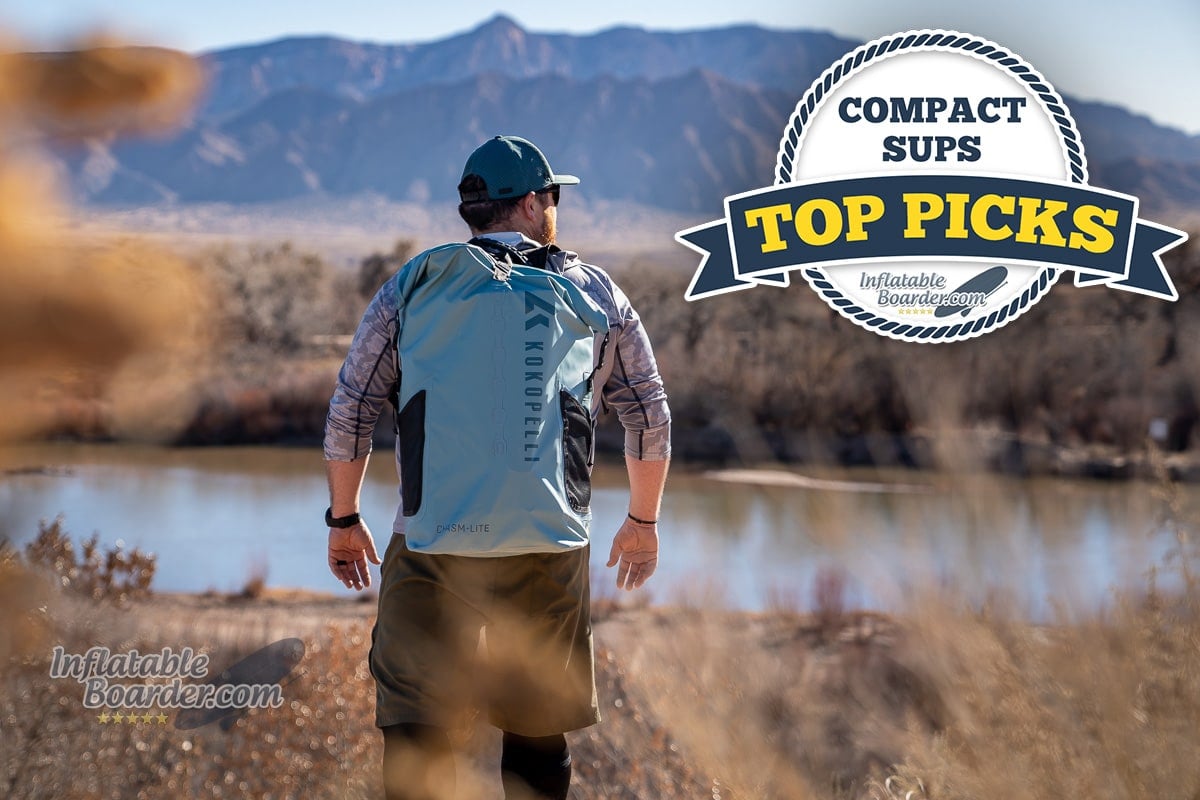
Inflatable Stand Up Paddleboards have always been known for their easy storage and transportation thanks to their ability to deflate and their light weight. In recent years, several brands have fully embraced the idea of portability with the creation of some seriously compact iSUPs that travel even easier than “regular” iSUPs. With the advancement of materials and construction, these compact iSUPs are small enough to go anywhere with you (literally anywhere, even as carry-on luggage!) without sacrificing their performance characteristics.
We’ve tested and compared the top compact iSUPs on the market today and put together this list of our favorites. Each one has its own strengths and weaknesses, so we categorized them based on what they are best for, rather than ranking them against each other. Keep reading to see which compact travel iSUP is right for you!
Best Compact & Travel iSUPs Comparison Chart
Irocker all-around 11’ ultra: best all-around compact isup.
11’0” x 31” x 6” | 21.6 lbs Bag Size: 21”x16”x10” | Kit Weight: 33.3 lbs Read Full Review Here
The iRocker All-Around 11’ Ultra iSUP earns our pick for the Best All-Around Compact iSUP because it does a fantastic job of balancing size, weight, stability, performance and versatility in a highly affordable package.
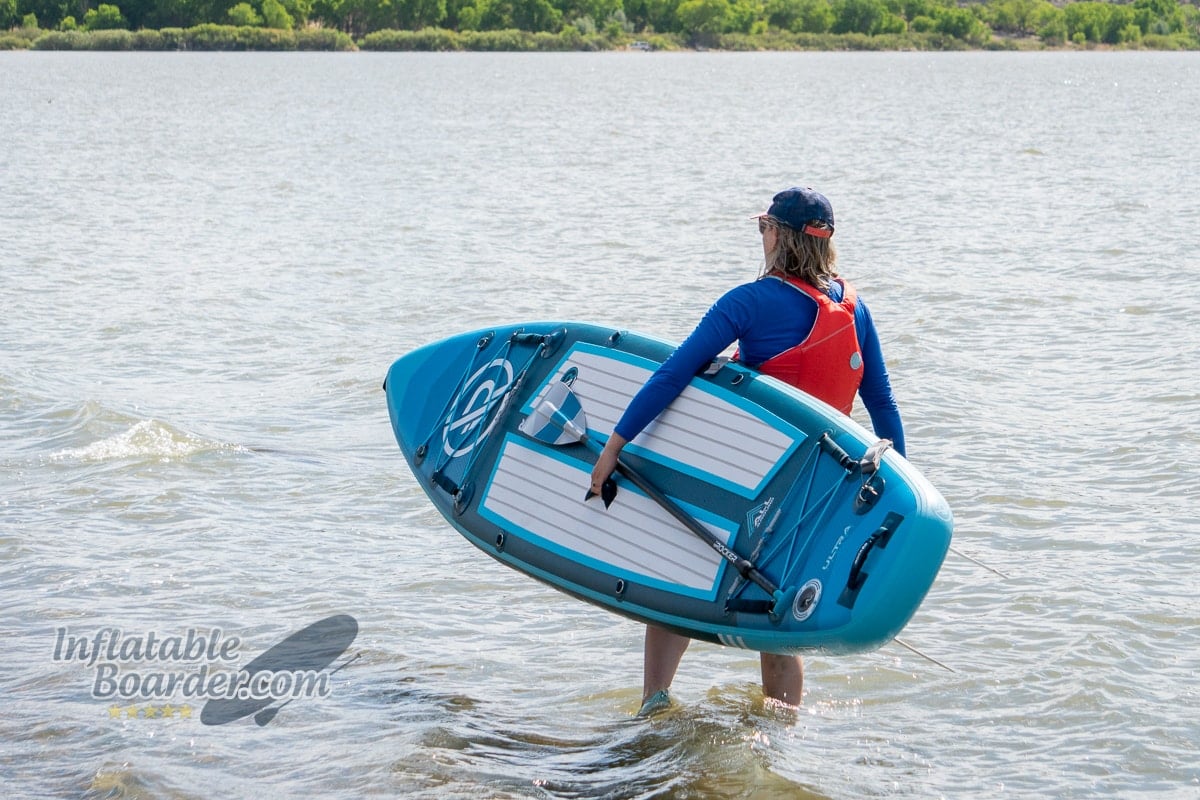
The iRocker All-Around 11’ Ultra uses woven drop stitching and a dual-layer lightweight PVC tarpaulin to keep the weight just under 22 lbs for this 11’ long, 32” wide iSUP. Those same advanced materials also make it incredibly stiff for its weight. When you combine that with the twin 9” fins you get a sleek, easy to transport, and high-performing paddleboard. It even has lots of additional features like dual cargo areas, dual passenger handles, kayak seat compatibility and multiple threaded accessory mounts. Just to top things off, it comes standard with iRocker’s excellent electric pump.
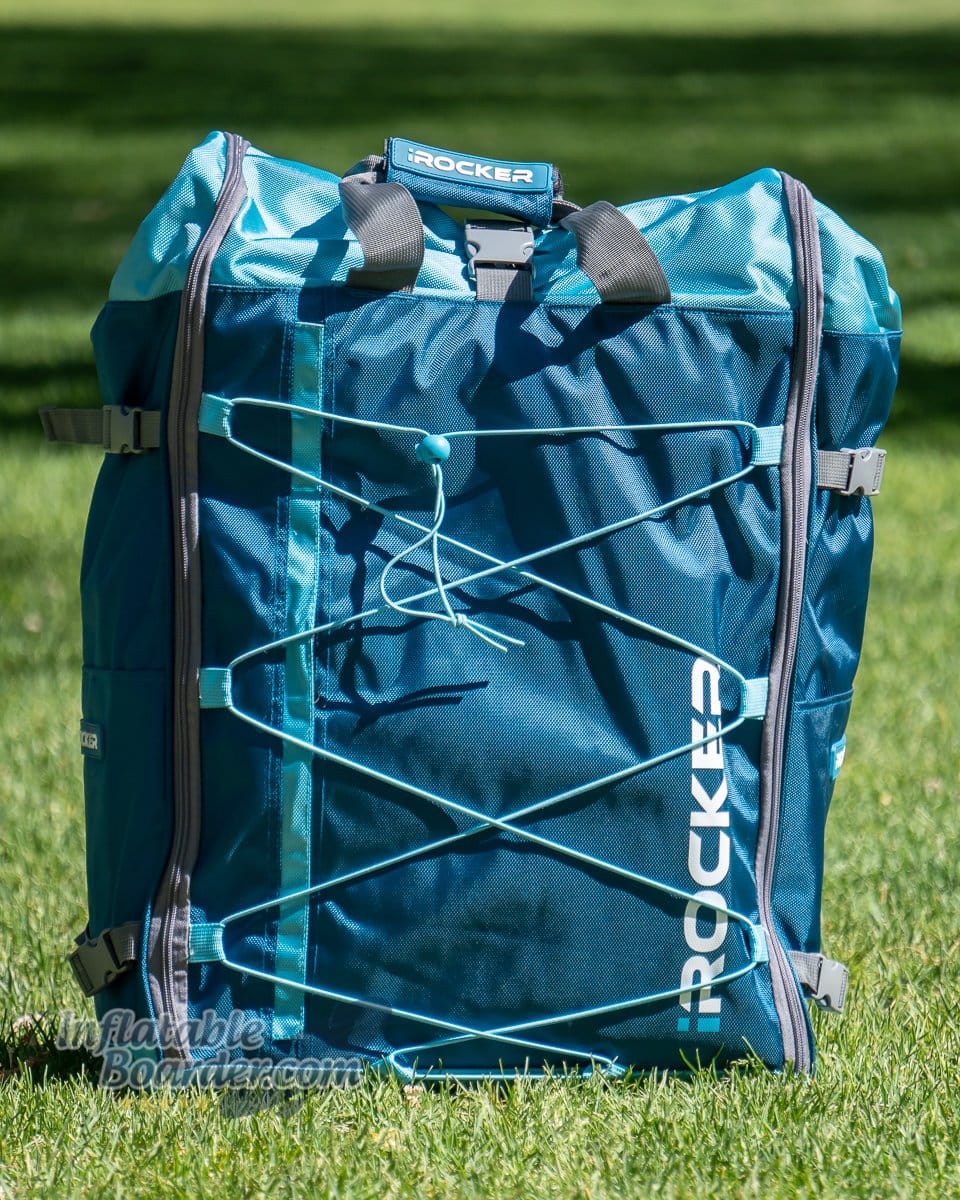
Bottom Line: The iRocker All-Around 11’ Ultra is a true all-around iSUP with great performance and value in a small package.
Blackfin XL Ultra: Best Compact iSUP for Fishing & Larger Paddlers
11’6” x 34” x 6” | 23 lbs Bag Size: 21”x16”x10” | Kit Weight: 35 lbs Read Full Review Here
The Blackfin XL Ultra was just released last summer and it’s already making a splash as a fantastic compact iSUP for fishing and larger paddlers.
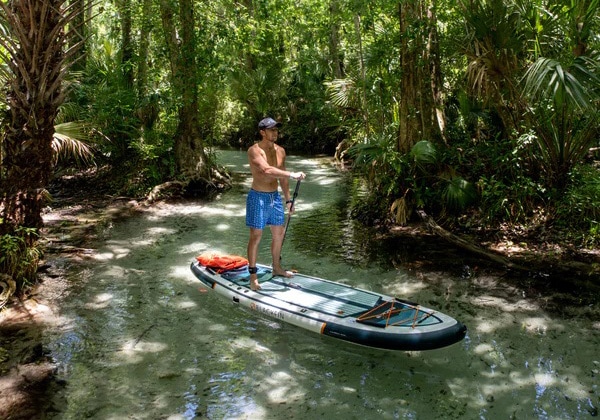
The Blackfin XL Ultra is a full-size fishing iSUP at 11’6” x 34” x 6”, but packs down into the nearly-half-size Ultra backpack for easy transportation and storage. In addition to being full-size, the XL Ultra is full-featured with multiple cargo areas, threaded mounts, and two Scotty-style rack mounts at the rear of the board.
The rigid construction and 34” width make the XL Ultra extremely stable, even in choppy conditions, and the twin fin system is tool-less and allows the board to track incredibly well.
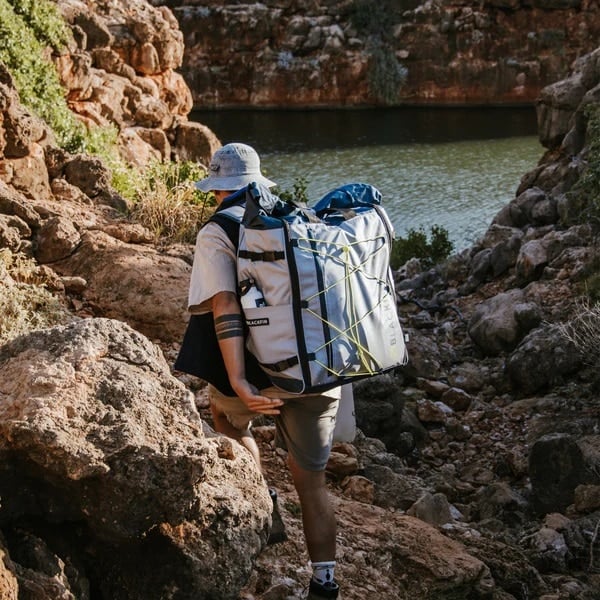
Bottom Line: The Blackfin XL Ultra is the best compact iSUP for anglers and larger paddlers.
Red Paddle Co. Compact 12’ : Best Touring Compact iSUP
12’0” x 32” x 4.7” | 22.4 lbs Bag Size: 22” x 16.5 x 12.5” | Kit Weight: 34 lbs Review Coming Soon
Red Paddle Co. is known for their innovative designs, excellent construction quality and high performance on the water. The Red Paddle Co. Compact 12’ takes advantage of all of these to be the Best Compact iSUP for Touring.
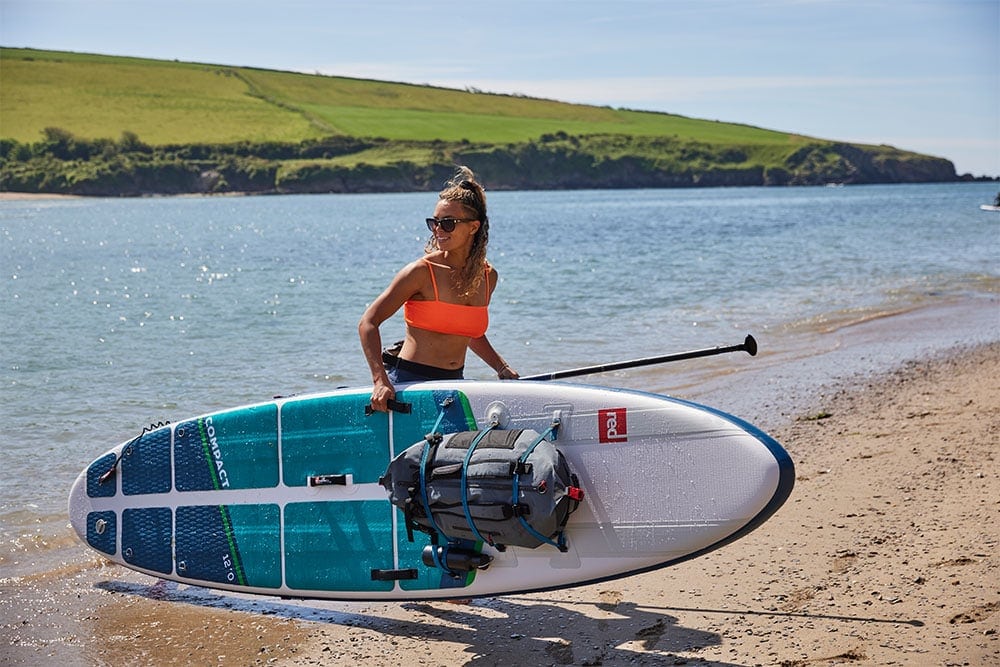
There’s so much to say about the Red Paddle Co. Compact 12’ that I’m not going to be able to fit all here. The Compact 12’ is the largest board on our list and is the only one that is truly a touring iSUP capable of a multi-day trip. The MSL Fusion construction with full-length stringers is lightweight and stiff, and the 4.7” thickness keeps the total board weight low, while also lowering your center of gravity for improved stability. The twin click-fins are easy to use (and easy to customize with other fins as desired) and the included Titan II is one of the best hand pumps on the market for speed, efficiency, and durability.
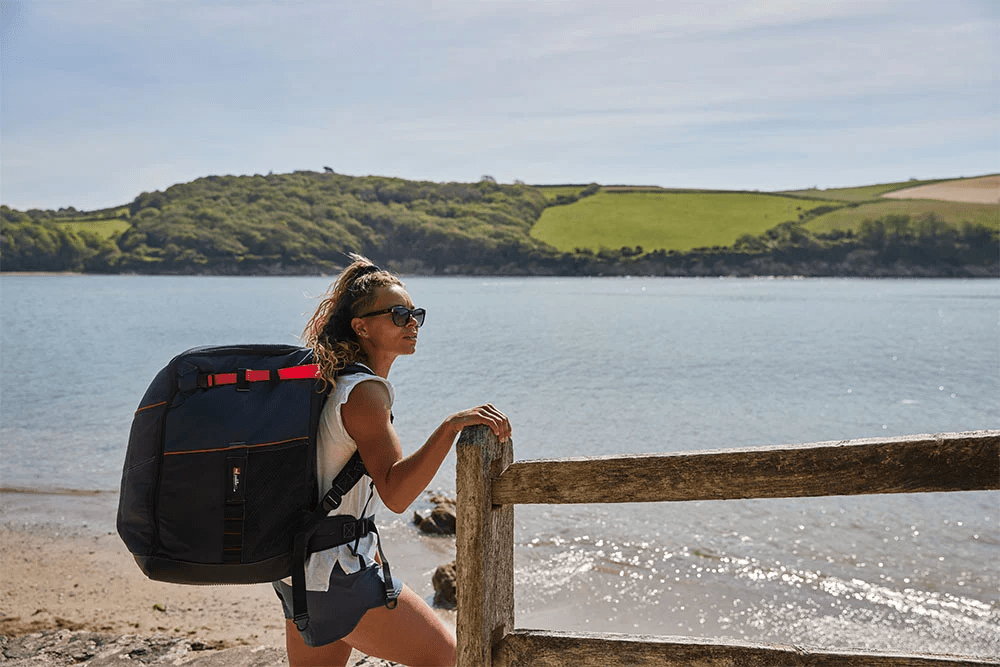
Bottom Line: If you need a compact travel iSUP and plan to get away from it all for a few days at a time, the Red Paddle Co. Compact 12’ is the ticket for you.
Kokopelli Chasm-Lite: Most Compact and Best for Hiking
10’0” x 30” x 6” | 12.9 lbs Bag Size: 22” x 14” x 10.5” | Kit Weight: 20.2 lbs Read Full Review Here
Think of a compact iSUP. Now think smaller and lighter. Now you have the Kokopelli Chasm-Lite . The Chasm-Lite is the lightest, most compact iSUP available today and is the Best choice for Hiking to those picturesque mountain lakes.
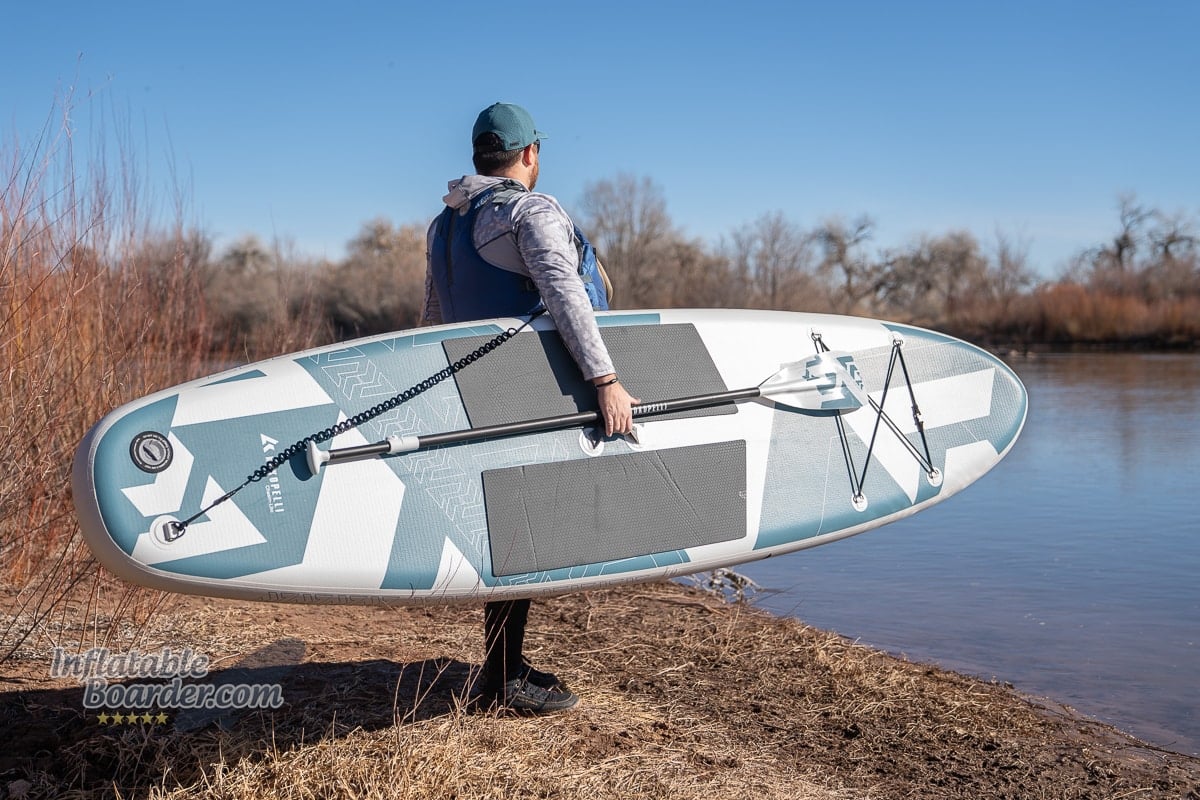
The Kokopelli Chasm-Lite draws from a long pedigree of high-performance packrafts and blends it with modern lightweight drop stitch materials to create the near-impossibly light (12.9 lbs) iSUP. The Chasm-Lite is the smallest board on our list at 10’ long and 31” wide, but it is still surprisingly stable. The included drybag backpack not only easily packs the board, 4-piece paddle, mini pump, and your other accessories, but still has plenty of room for water, lunch, jacket, and all of your other day-hiking needs. The Chasm-Lite kit is so small that it can even fly as carry-on luggage for many airlines.
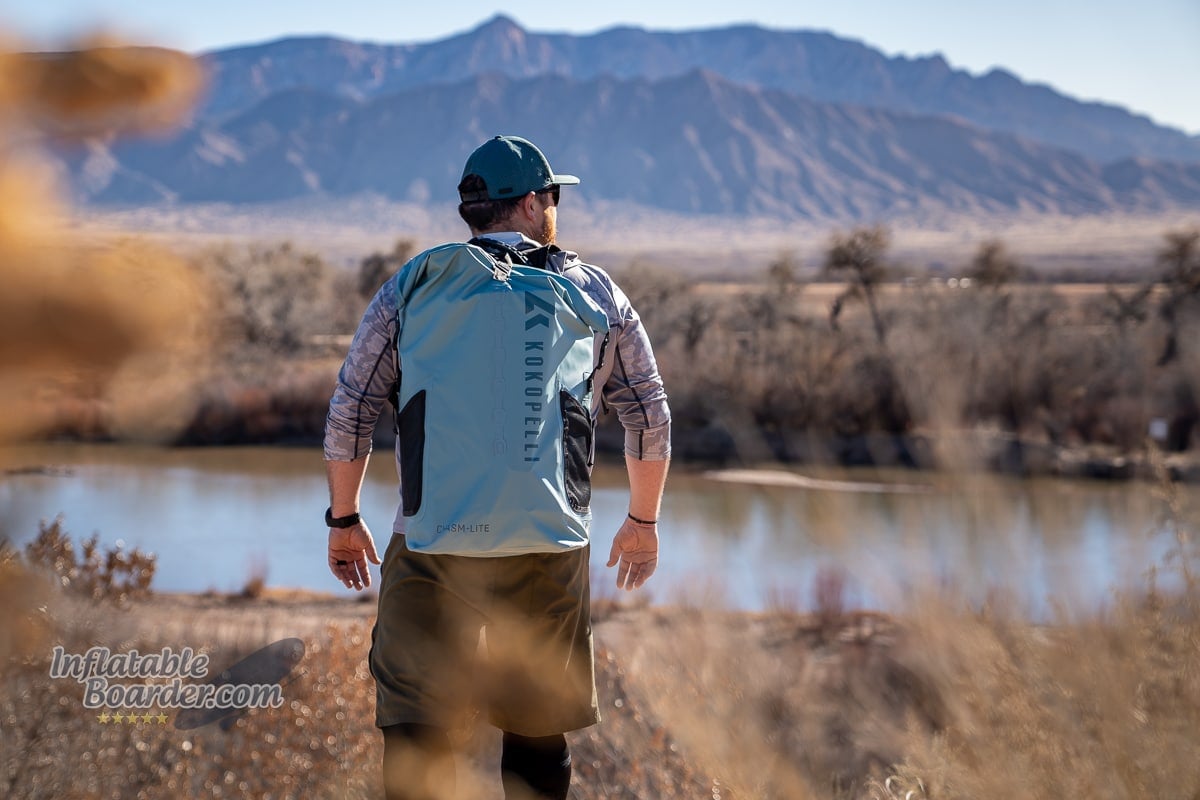
Bottom Line: The Kokopelli Chasm-Lite is the smallest, most packable iSUP around and is the obvious choice for hikers chasing the blue lines.
iRocker Cruiser Ultra: Best Compact iSUP for Beginners
10’6” x 32” x 6” | 21 lbs Bag Size: 21” x 16” x 10” | Kit Weight: 32.7 lbs Read Full Review Here
The iRocker Cruiser Ultra focuses on stability and maneuverability, while still staying extremely versatile and affordable, making it our pick for Best Compact iSUP for Beginners.
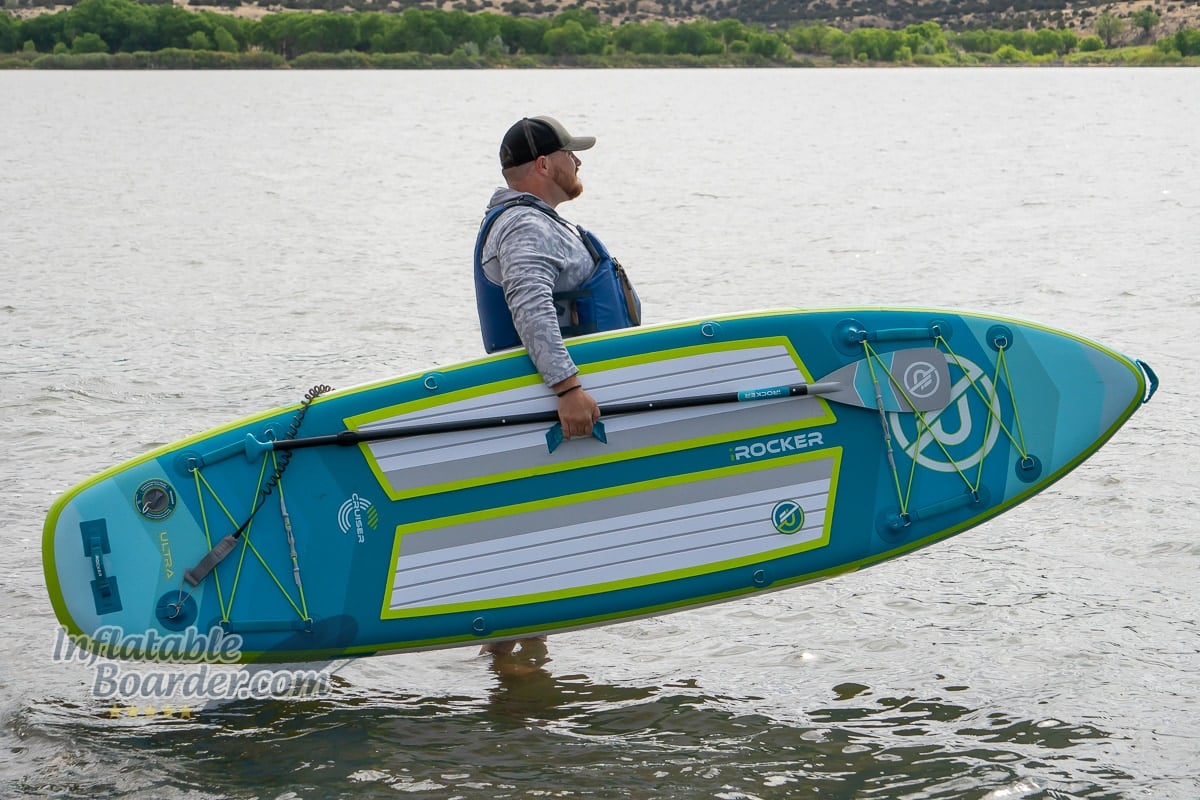
The iRocker Cruiser Ultra is wider than the other iRocker “Ultra” SUPs, and its wider, square, tail make it extra stable on the water. At 10’6” long and 32” wide it’s a great size for nearly all paddlers without being too long or wide for shorter paddlers, while still being large enough for taller paddlers (truly I find this size to be the “Swiss Army Knife” of board sizes). The Cruiser Ultra has multiple cargo areas, passenger handles, threaded accessory mounts, and is kayak seat compatible. It also comes standard with an electric pump to make inflation a breeze.
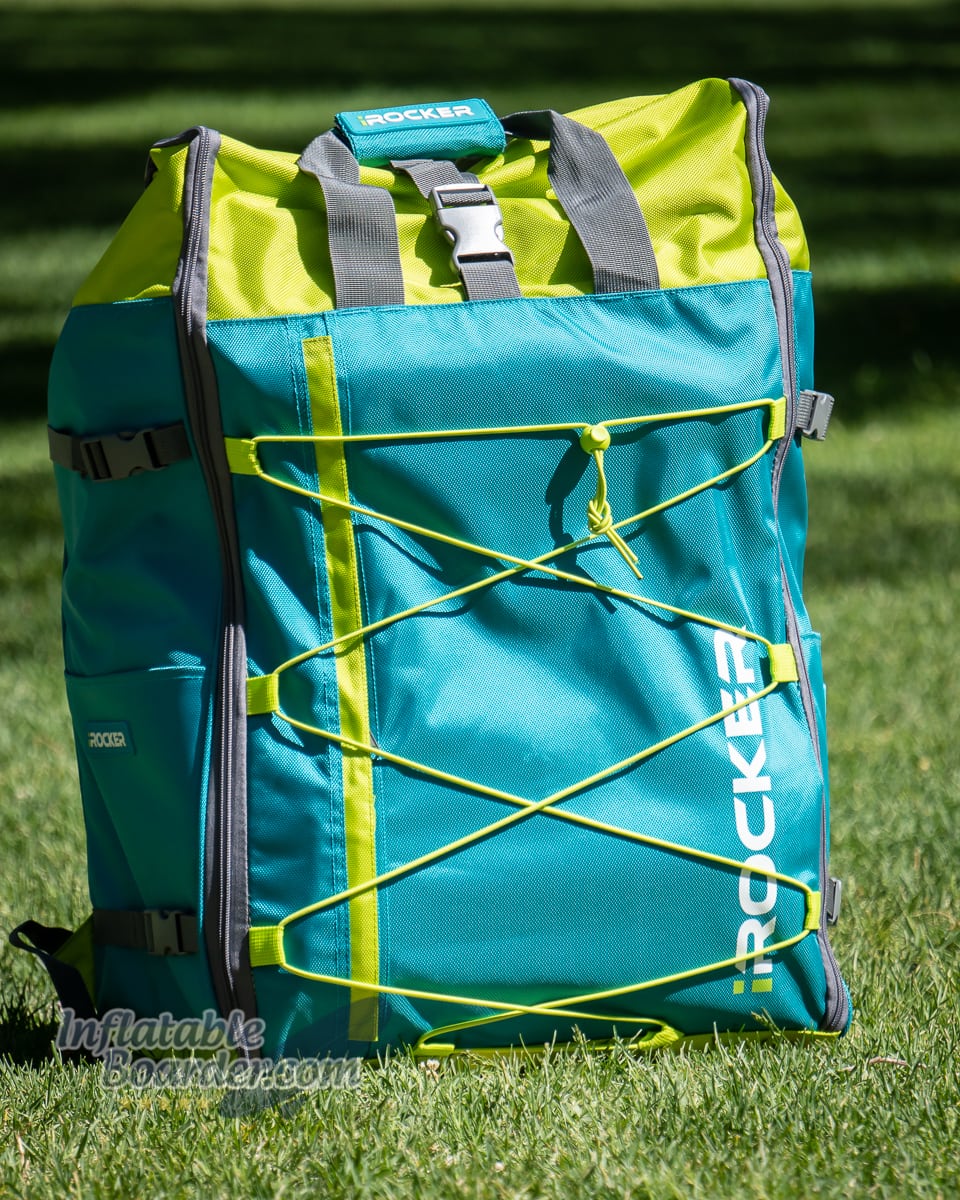
Bottom Line: The iRocker Cruiser Ultra has everything a beginner paddleboarder needs in a small package for a great value.
Nixy Huntington G4 Ultra Compact: Best Compact for Surfers and Dog Lovers
9’6” x 32” x 6” | 18.8 lbs Bag Size: 25” x 19” x 12” | Kit Weight: 30lbs Review Coming Soon
The Nixy Huntington G4 Ultra Compact iSUP has something that no other compact iSUP does – a nearly full-coverage deck pad. At almost 7’ long, this deckpad makes it possible to comfortably stretch out, or bring along your favorite four-legged friend with confidence.
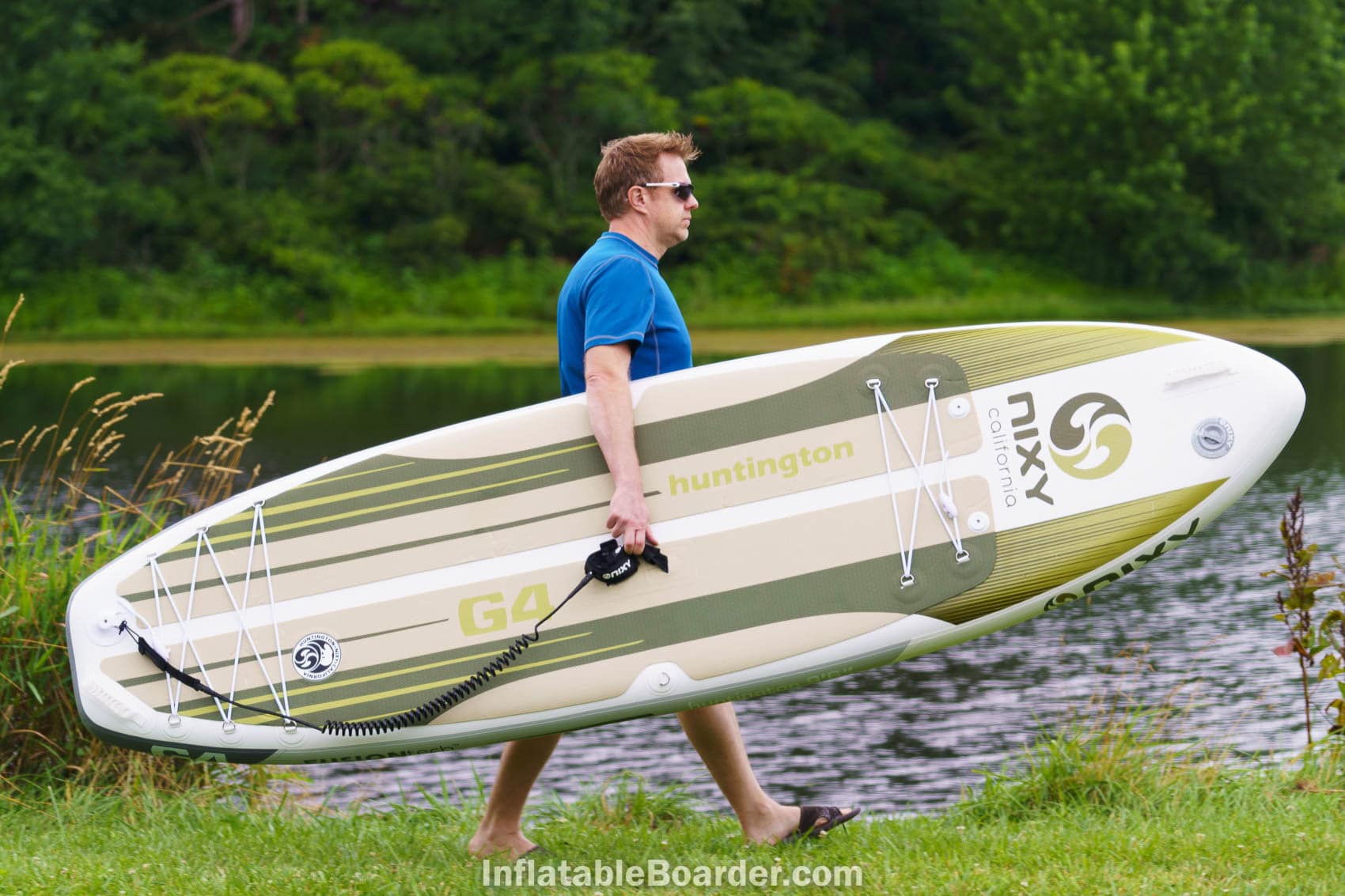
In addition to the extra-large deck pad, the Nixy Huntington G4 Ultra Compact also has multiple cargo areas, three threaded accessory mounts, and is kayak-seat compatible. The shorter length of just 9’6” and long-reaching deck pad (all the way to the tail!) also makes it a great option for those that like to catch the occasional wave.
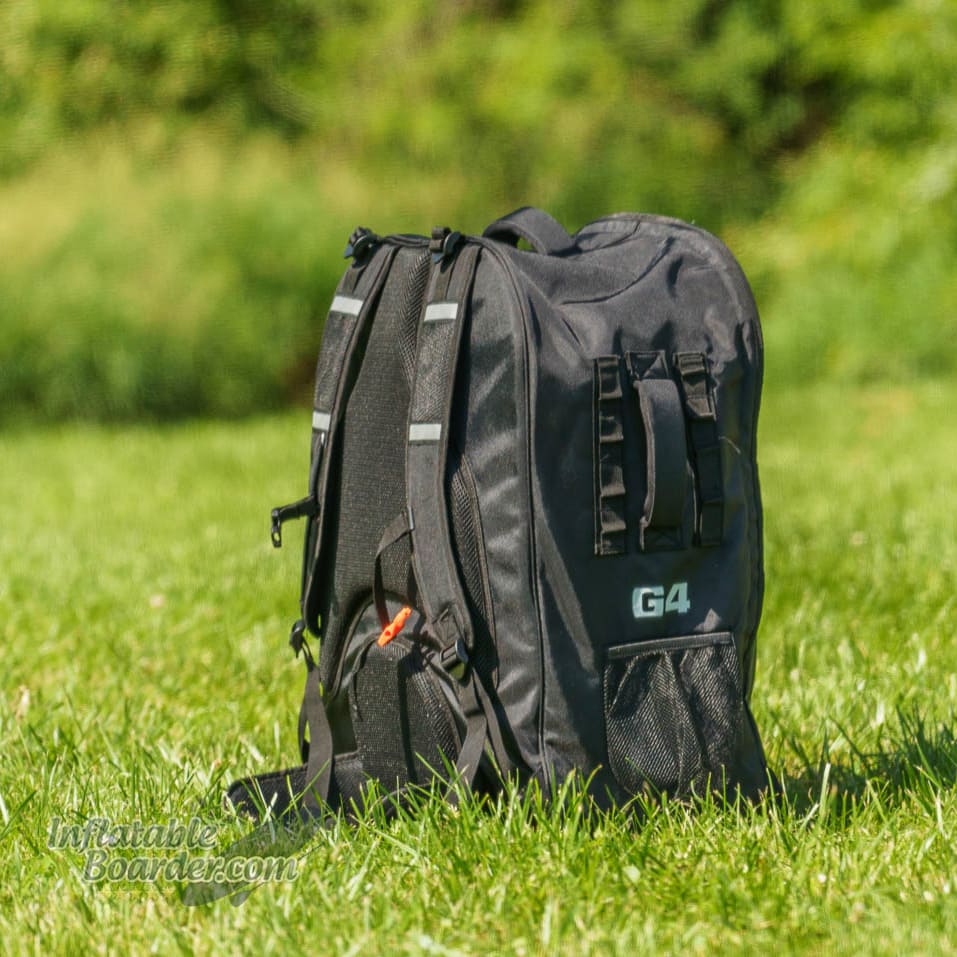
Bottom Line: The Nixy Huntington G4 Ultra Compact is the Best Compact iSUP for paddling with your pooch or catching the occasional wave.
Compact and Travel Inflatable Stand UP Paddleboard FAQs
What is a compact isup.
Compact iSUPs aren’t measured by their inflated size, but rather by the overall size and weight of the kit when deflated and packed into its transportation bag. Compact iSUPs typically fold in half along the centerline before folding, allowing them to fit into a backpack-style bag that is around half the size of a traditional iSUP bag. Compact iSUPs are also made with higher-end, lighter-weight materials to help reduce the weight of the board. Accessories are also modified in order to best fit in these smaller bags.
What to look for when choosing a Compact iSUP?
Choosing a Compact iSUP starts the same as selecting a “regular” iSUP. You want to match the size, shape, and features of the paddleboard to yourself and your style of paddling. Once you know what size and features you need, then you can select a Compact iSUP based on its weight and packed size to meet your travel needs. Compact iSUPs are quite easy to fit into cars and other ground transportation, however most will still need to be checked-luggage on flights.
What accessories work with Compact iSUPs?
Compact iSUPs will work with any compatible accessories that work with “regular” iSUPs. All of the compact boards on this list have a standard Halkey-Roberts valve (fits most hand and electric pumps), threaded mounts use a standard M8 bolt, and the fin boxes are the same as the “regular” size iSUPs available from the same brands. These compact paddleboards do include compact paddles. Rather than shrinking the paddle, though, it is made of either 4 or 5 sections (instead of the regular 3 sections) so it can pack easily into the smaller bags.
Recommended Gear for Compact Inflatable Stand Up Paddleboards
While the compact iSUPs on our list come as kits with almost everything you need to be on the water, there are a few extra things that can make your paddling safer and more comfortable.
- PFD – A PFD (Personal Flotation Device), sometimes called a life jacket or buoyancy aid, is a critical piece of safety equipment while on your SUP and may be required by local law. There are thousands of options for PFDs, and it is important to choose one that not only fits you well, but is designed for paddling. For Compact iSUPs I like to use an inflatable belt-pack PFD inflatable belt-pack PFD that is lightweight and small enough to pack with your board.
- Dry Bag – Not everything we bring with us on our SUPs should get wet. Soggy sandwiches and waterlogged phones can ruin a good day out on the water. A small dry bag to fit your phone, keys, and other small personal items is an easy addition to your compact iSUP. See our Best SUP Dry Bag reviews here .
Final Thoughts – Best Compact iSUPs
Just like any “regular” iSUP the Best Compact SUP is really going to depend on your exact needs, and just like any “regular” iSUP, compact SUPs will vary greatly depending on size, shape, material, construction, etc. While this list isn’t exhaustive of all compact iSUPs available, we think it provides a representation of the best quality, best performing compact inflatable stand up paddleboards from the best brands around. So now the only question is – where will you take your Compact iSUP first?
Ask A Question or Give Feedback Cancel Reply
Name *
Email *
Post Comment
iROCKER SPRING SALE!
Save Up to 25% on Select SUPs
- More Networks
Every product is independently selected by (obsessive) editors. Things you buy through our links may earn us a commission.
Best in Class
- The Very Best Personal Blenders The Very Best Personal Blenders
- The 17 Very Best Work Bags for Women The 17 Very Best Work Bags for Women
- The Very Best Face Moisturizers The Very Best Face Moisturizers
- The 12 Very Best Loafers for Women The 12 Very Best Loafers for Women
- The 11 Very Best Fanny Packs The 11 Very Best Fanny Packs
- The 9 Very Best Slippers for Men The 9 Very Best Slippers for Men
- The 11 Very Best White T-shirts for Men The 11 Very Best White T-shirts for Men
- The Very Best Washable Rugs The Very Best Washable Rugs
- The 10 Very Best Cooling Pillows The 10 Very Best Cooling Pillows
- The 15 Very Best Women’s Deodorants and Anti-perspirants The 15 Very Best Women’s Deodorants and…
- 23 of the Very Best Sex Toys for Couples 23 of the Very Best Sex Toys for Couples
- The 9 Very Best Face Washes for Acne The 9 Very Best Face Washes for Acne
- The Very Best Body Oils The Very Best Body Oils
- The 18 Very Best Bath Towels The 18 Very Best Bath Towels
- The 13 Very Best Play Mats for Babies and Kids The 13 Very Best Play Mats for Babies an…
- The 9 Very Best Callus Removers The 9 Very Best Callus Removers
- 14 of the Very Best Olive Oils 14 of the Very Best Olive Oils
- The 10 Very Best Rice Cookers The 10 Very Best Rice Cookers
- The 8 Very Best Toners The 8 Very Best Toners
- 18 of the Very Best Hair Masks 18 of the Very Best Hair Masks
- The 11 Very Best Shampoos The 11 Very Best Shampoos
- The 13 Very Best Ergonomic Office Chairs The 13 Very Best Ergonomic Office Chairs
- The 15 Very Best Makeup Removers The 15 Very Best Makeup Removers
- The 12 Very Best Mattress Toppers The 12 Very Best Mattress Toppers
- The 13 Very Best Wireless Bras for Large Breasts The 13 Very Best Wireless Bras for Large…
- The 16 Very Best Body Lotions for Dry Skin The 16 Very Best Body Lotions for Dry Sk…
- The Very Best Body Pillows The Very Best Body Pillows
- The 10 Very Best Hard-Side Suitcases The 10 Very Best Hard-Side Suitcases
- The 10 Very Best Silk Pajamas for Women The 10 Very Best Silk Pajamas for Women
- The 7 Very Best Nonstick Skillets The 7 Very Best Nonstick Skillets
- The 9 Very Best Women’s Parkas The 9 Very Best Women’s Parkas
- The Very Best Men’s Underwear The Very Best Men’s Underwear
- The 10 Very Best Electric Toothbrushes The 10 Very Best Electric Toothbrushes
- The 9 Very Best Safety Razors (and Blades) The 9 Very Best Safety Razors (and Blade…
- The 10 Very Best Lighted Makeup Mirrors The 10 Very Best Lighted Makeup Mirrors
- The 15 Best Women’s Raincoats The 15 Best Women’s Raincoats
- The 12 Very Best Sheet Pans The 12 Very Best Sheet Pans
- The 13 Very Best Cashmere Sweaters The 13 Very Best Cashmere Sweaters
- The Very Best Body Washes for Dry Skin The Very Best Body Washes for Dry Skin
- The 11 Very Best Face Exfoliators The 11 Very Best Face Exfoliators
- The 15 Best Women’s Hiking Boots and Shoes The 15 Best Women’s Hiking Boots and Sho…
- The 9 Very Best Beard Trimmers The 9 Very Best Beard Trimmers
- The 19 Very Best Bed Pillows The 19 Very Best Bed Pillows
- The 8 Very Best Over-the-Counter Mouth Guards The 8 Very Best Over-the-Counter Mouth G…
- The Very Best Coffee-Subscription Clubs The Very Best Coffee-Subscription Clubs
- The 15 Very Best Pillows for Side Sleepers The 15 Very Best Pillows for Side Sleepe…
- The 16 Very Best Bras The 16 Very Best Bras
- The 11 Very Best Pieces of Rolling Luggage The 11 Very Best Pieces of Rolling Lugga…
- The Very Best Carry-on Luggage The Very Best Carry-on Luggage
- The 9 Very Best Memory-Foam Pillows The 9 Very Best Memory-Foam Pillows
The 10 Very Best Stand-up Paddleboards
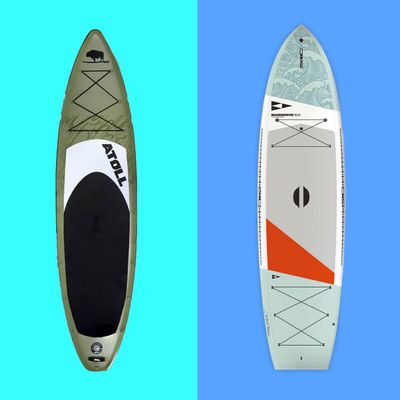
Like mountain biking , running , and hiking , stand-up paddleboarding became many people’s favorite pandemic pastime, including mine . To help you choose the right board to suit your lifestyle, we spoke with six paddleboard experts, including instructors, athletes, race directors, retailers, a designer, and a stand-up-paddle coach, to find out what features separate a great paddleboard from a mediocre one and what they recommend for a range of activities and skill levels.
“Buy the right board for your needs and ability,” says Byron Kurt, founder of the World Paddle Association . While a rigid SUP built for performance can cost a few grand, you can find a decent inflatable for a few hundred dollars if your primary focus is recreational use. However, all our experts cautioned against opting for too inexpensive a board because they degrade much quicker. “Pay a little more, and you’ll get better quality and more performance,” added Kurt, which is why most of our picks are between $750 and $1,000.
Jill Jaques, the owner of Deep Blue Yoga in Seattle, Washington, shared another piece of buying advice: “You won’t just be buying a board,” she said. “A lot of boards come with a paddle and leash, but not a life jacket . Get the best, most comfortable life jacket you can afford so that you’ll want to wear it.”
We looked for options readily available online, but as with cars, gaming consoles, and commuter bikes , continuing global-supply-chain issues are still causing some SUP models to be low in stock.
Best overall | Best less-expensive | Best for occasional use | Best solid | Best for families | Best for yoga | Best kayak hybrid | Best inflatable for touring | Best for kids | Best solid all-around for racing
What we’re looking for
Build: All of our experts agree: you can’t deny the smooth feel of a solid board. “Hard boards will perform better because they’re more rigid,” says Kurt. “The advantages are speed, efficiency, and glide — you can get further with the same output you would put into an inflatable.” But they have disadvantages: They’re usually more expensive, easier to ding up, and harder to store.
For recreational use, inflatable SUPS will suit most people better because they’re easier to store and transport and tend to be more versatile and user-friendly. If you want to travel, hike to a lake, practice yoga, or use your board in various conditions, you’ll be better equipped with an inflatable SUP.
Intended use: The hull — or shape of the SUP — comes in two basic styles: a planing hull or a displacement hull (some boards blend a combo of the two). A SUP with a planing hull is wide and flat, and usually has a rounded nose, making it optimal for most activities because it sits on top of the water, is easier to maneuver, and typically has more stability. They’re usually best for beginners but can also be enjoyed by intermediate and advanced paddlers. A SUP with a displacement hull is shaped more like a kayak, with a narrower tapered nose designed to better slice through the water and increase efficiency. These SUPs are best for touring, racing, and fitness.
Most inflatable SUPs come with a manual pump. However, some work better than others. “If it’s in the budget, get an electric pump for your inflatable,” says Jaques. Typically, electric pumps with the correct pressure range of 15 to 20 PSI are in the $100-to-$200 range, and the OutdoorMaster Shark Electric Pump ($139) is a favorite among paddlers.
Dimensions: The best length, width, and thickness of a paddleboard will depend on your body type, ability, and the style of paddling you plan to do. Smaller boards, suitable for kids and surfing, will be under ten feet. All-around SUPs, best for multi-purpose use, are generally between ten and 12 feet long. Anything over 12 feet typically suits racing and touring, where maintaining efficiency over long distances is key.
Many people focus on length, but it’s only one factor to consider, says Robert Stehlik, founder and designer at Blue Planet Surf in Honolulu. “A longer board will track better (a.k.a. go straight better); a shorter board will be more maneuverable,” he says, adding that width makes a board stable, while a narrower board will be faster. The experts say a stand-up paddleboard between ten and a half feet and 12 feet long and 29 inches and 33 inches wide is the ideal size range for an all-arounder. We didn’t pay too much attention to thickness as six inches is fairly standard in most inflatable SUPs.
Weight capacity: How much weight a stand-up paddleboard can hold is determined by its volume — the more volume a board has, the more weight it can support. Not buying a board with the right volume is a common mistake made by first-time buyers, says Bill Ennis, paddleboard instructor trainer and owner of Dig Paddlesports in Hurricane, Utah. If you choose a board with too much volume for your weight, it won’t sit low enough in the water, resulting in less stability. Overweighting a board down will make it too low, causing drag and making it harder to paddle.
When picking out a paddleboard, consider your weight plus the weight of any other gear, people, or pets you plan to put on the board, and choose a weight capacity that corresponds to your needs.
Best overall stand-up paddleboard
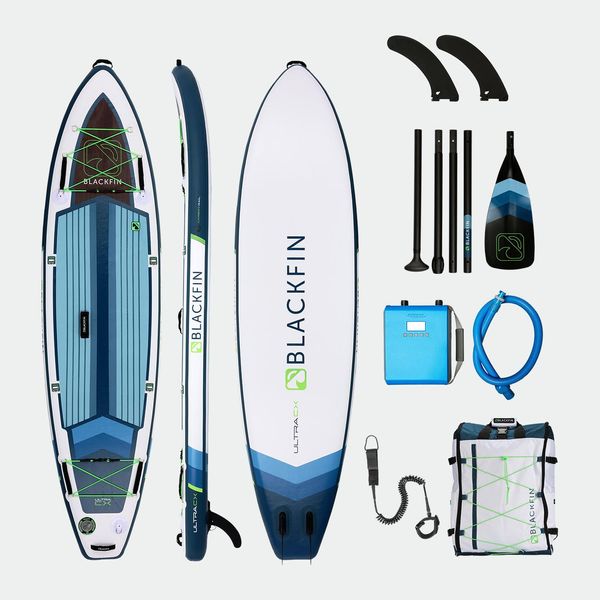
Inflatable | All-around | 10’ 6” x 32.5” x 6” | 320-pound capacity
The Blackfin CX Ultra is a supremely versatile inflatable SUP for nearly any adventure, whether you’re cruising or crushing it. It’s the mix of agility with stability that we think makes this board a top performer. It’s lightweight (as in under 20 pounds), so it’s easier than most to carry when you have a short hike ahead of you, and the backpack design is refined and compact, so not only is it more comfortable to haul around, it’s easier to store, too.
This speedy and stable board comes with everything you need to get out on the water, including a carbon fiber paddle and electric pump — a big bonus to avoid tired arms. It’s got bungee tie-downs on the front and back that can hold enough gear for a first overnighter, but can clip off to free up more deck space for yoga. For those new to paddleboard yoga, it might not be wide enough to balance on — yet — but with practice it will be. “As folks gain more experience they’ll find they can paddle boards that previously felt ‘tippy” with no problems, and may even prefer the agility and ease of paddling a narrower board,” says Jaques. The CX Ultra has two removable longer side fins, but no center fin. It still tracks well, however, and the setup adds a fair amount of stability and maneuverability to the board and makes it ideal in conditions where a center fin might drag on rocks or sand.
Best (less-expensive) stand-up paddleboard
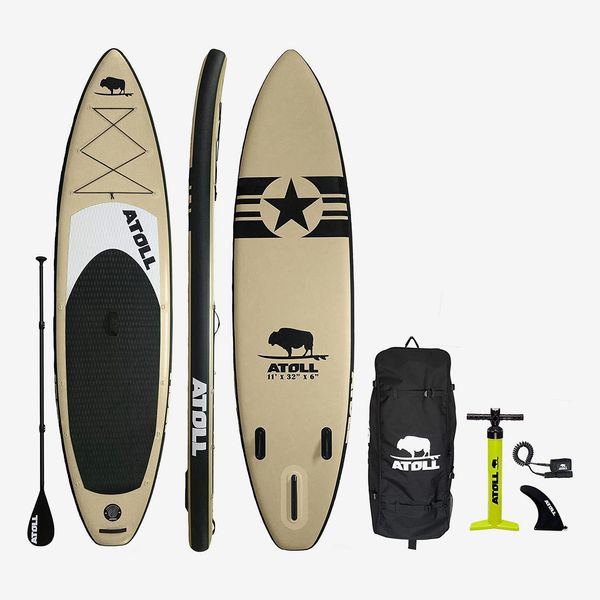
Inflatable | All-around | 11” x 32” x 6” | 315-pound capacity
The Atoll 11’ is a durable all-around paddleboard that’s slightly heavier and longer than our top overall pick, the CX Ultra, making it ever-so-slightly less maneuverable but still a worthy vessel for most paddling conditions. One advantage of the Atoll SUP is that along with the two small fixed side fins, it comes with a removable center fin, which helps the board track better. There are tons of D-rings (15) and bungee-cord storage on the front, but not the back. The board design is modern and fresh, and the board color matches the accompanying paddle and backpack, which makes the whole kit look extra sleek. The Atoll comes with everything needed to get started, including a leash and carbon-wrapped fiberglass paddle — accessories that are sometimes lacking with midrange boards.
Best inflatable stand-up paddleboard for occasional use
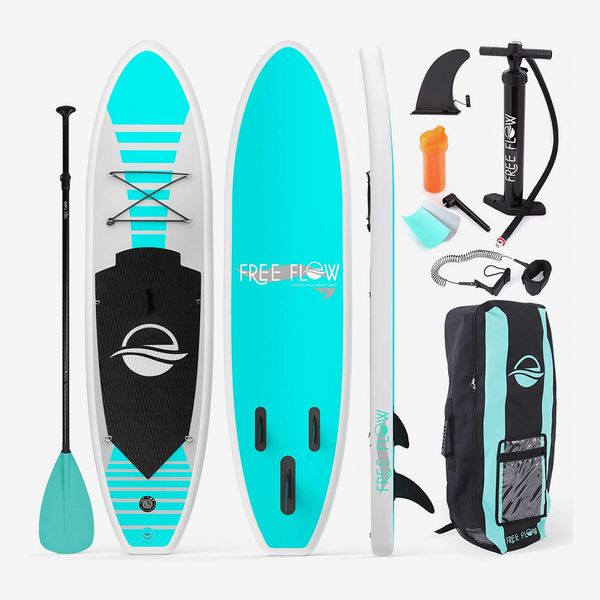
Inflatable | All-around | 11’ x 33” x 6” | 330-pound capacity
If fun is your goal and you aren’t overly performance-driven (or plan to use your SUP only a handful of times a year), the SereneLife SUP is an all-around recreational board that comes in well below $500. It’s tough to find a reliable board at this price, but thousands of reviewers back the SereneLife inflatable. When The Strategist curated a list of the best-reviewed stand-up paddleboards of 2019 , the SereneLife SUP had more than 800 five-star reviews on Amazon; now, it has more than 15,000.
The dimensions will fit most people just fine, and the shape is excellent for both lake paddles and splashing around in some light waves. The board features two fixed side fins and a removable screw-in center fin, which isn’t as easy to install as a quick-lock fin, but it’s a nice feature regardless. There’s bungee tie-down storage for hauling gear, a roomy deck pad, and the wood-grain motif is stylish (it’s even more eye-catching than some of the higher-end boards we considered). It includes the entire setup: aluminum paddle, leash, pump, repair kit, and decent enough backpack. If you prefer a more rounded shape or a different design, there are a few other SereneLife options .
Best solid stand-up paddleboard
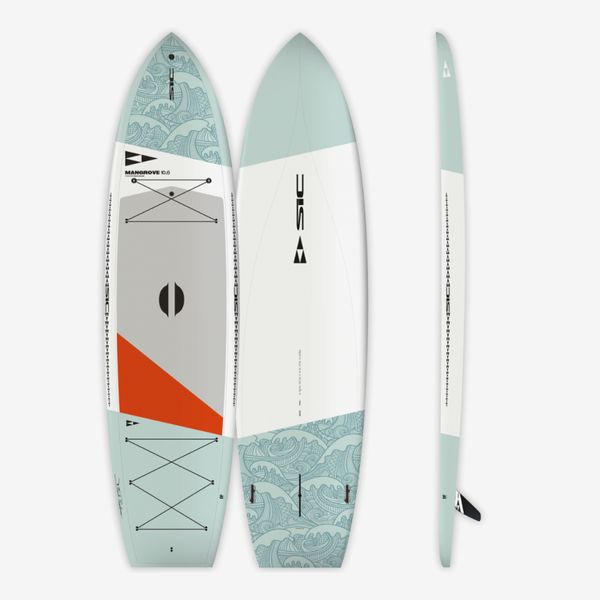
Solid | All-around | 10’ 6” x 32” x 6.1” | 200-pound capacity
All of the experts we spoke to called SIC Maui an industry leader in stand-up paddleboards, and the rigid ten-foot-six-inch Mangrove model is one of the most versatile boards in its lineup. This SUP is good for beginners to advanced paddlers because the length makes it easy to maneuver, the flat bottom gives it stability, the displacement hull allows it to plow through water — and there’s still enough room to squeeze on a kid and a bit of gear. This board is stable and smooth for recreational paddling, a short touring trip, fitness, and yoga, with a textured deck pad for grip and bungee cords for storage.
An EPS core (durable, rigid foam) is sandwiched between oak-wood laminate and wrapped in fiberglass, making it built to last for years on the water, especially for new paddlers. “Beginners should opt for fiberglass because it’s going to be less brittle than carbon fiber,” says racing paddleboard coach Nicole Stimpson . The Mangrove comes with one removable center fin, but it’s fitted with two side-fin boxes to outfit it for paddling in shallow water (however, you’ll have to purchase the two side fins). It also doesn’t come with a leash or paddle, but that’s pretty standard for hard SUP boards.
Best stand-up paddleboard for families
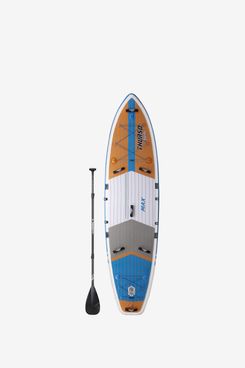
Inflatable | All-around | 11” 6” x 34” x 6” | 370-pound capacity
The Thurso Max is like a typical all-arounder but bigger, suitable for cruising just about anywhere and less intense touring expeditions. My family is in love with ours because despite its larger size (it’s a foot longer and a couple inches wider than a standard all-around SUP), it’s still easily maneuverable and provides excellent stability, even when loaded down with dry bags full of gear, a squirmy child, and a large dog. We use this SUP on rivers, coastlines, ocean bays, and lakes, where it’s stable enough to jump off and get back on.
This spacious board isn’t as speedy as some of the more streamlined SUPs, and at around 30 pounds, it’s on the heavier side, but it’s durable, extremely rigid for an inflatable, and feature-packed. It has D-rings galore (16), plenty of deck room, and a seat can be added to make for comfortable kayak-style paddling. It has three removable fins that lock firmly into place (a setup that allows you to configure the board for different conditions), bungee-cord storage at the front and back, a grippy, full-length deck pad, seven carrying handles, and a camera mount. The Max stows in a rolling backpack and comes with a repair kit, a leash, a carbon shaft paddle that’s lightweight yet strong, and a dual-chamber pump. However, it’s still a bit of a workout to inflate given its size, so investing in an electric pump will save both time and your arms for paddling.
(Disclosure: I have contributed to the Thurso blog, offering advice on how to plan an overnight SUP camping trip , but that wasn’t until I’d already purchased and paddled with the Max for nearly three years.)
Best stand-up paddleboard for yoga
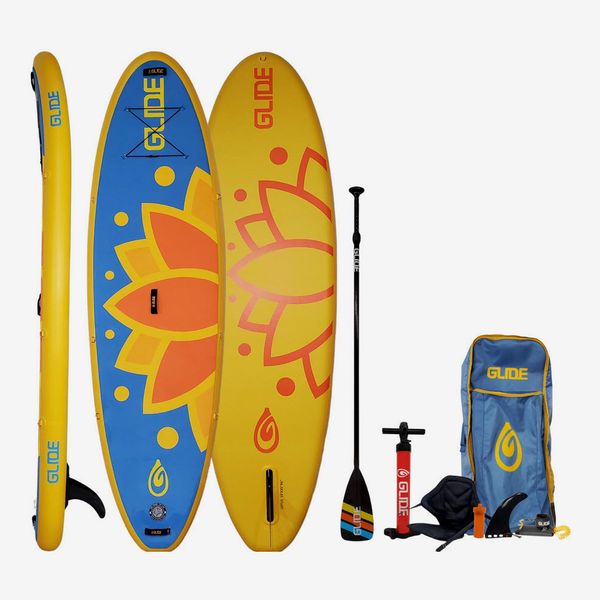
Inflatable | Yoga | 10’ x 35” x 6”| 400-pound capacity
To confidently practice your Vinyasa flow on the water, your stand-up paddleboard needs to be wide, flat, and stable, and, much like your favorite yoga mat , it needs to have good grip. Both the paddleboard yoga instructors we spoke to recommended going with an inflatable SUP. “For yoga, an inflatable is great because it’s a lot softer. It’s not as hard on your body when you’re doing certain moves, and it’s a lot more forgiving if you fall,” says Carleen Birnes , SUP yoga teacher and co-founder of Chesupeake in Severna Park, Maryland.
The Lotus Glide stand-up paddleboard got multiple shout-outs from our experts. It’s the personal favorite of certified paddleboard-yoga instructor Jill Jaques, who has been guiding yogis out on the water for a decade. “They’re super durable, have great features for yoga like a full-length deck pad and extra width, and they’re made in the USA,” she says. The added width makes it optimal for balancing poses because it won’t rock side to side as much, and the removable center fin makes it easy to stash in the storage bag.
Best kayak stand-up paddleboard hybrid
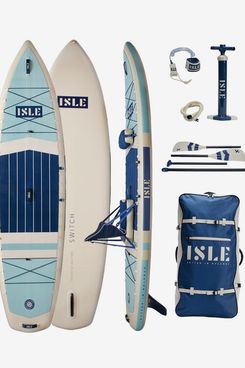
Inflatable | Hybrid | 11’ 6” x 35.5” x 6” | 425-pound capacity
If you plan to sit as much as you stand, the versatile Isle Switch converts from a SUP to a kayak with the addition of a clip-on seat and footrest and can be configured for tandem-kayak use. The inflatable seat is the cushiest we’ve seen, with a fiberglass-reinforced back that is supportive for a full day on the water. Webbing loops run the length of the board, allowing the rider to position the seat and other accessories where and how they want.
At under 20 pounds, it’s ultralight, yet can support 425 pounds of weight — the highest capacity of any of the inflatable boards on our list. The traction pad runs the entire length of the deck, offering good grip if you’re piling kids or dogs onto the board or want to use the SUP for yoga, and there’s plenty of storage room for gear. The flexible 9-inch single fin is easily removable, and the board design is slick looking, especially in the seafoam color. The Switch comes with a convertible paddle, storage bag, repair kit, pump, leash, and small dry bag for essentials.
Best inflatable touring stand-up paddleboard
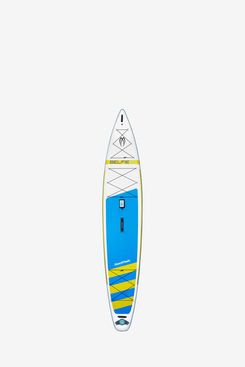
Inflatable | Touring | 14’ x 30” x 6” | 350-pound capacity
If you want an inflatable SUP that can handle a multi-day excursion or prefer a board that can cut through the water quickly, the Badfish Selfie 14 is your best bet. “I gravitate toward boards that are going to give me more performance for each paddle stroke,” says Bill Ennis, owner of Dig Paddlesports in Hurricane, Utah, which is why he opts for a touring board with a longer length and narrower nose like the Selfie. Badfish boards are also durable, says Ennis, who uses them in his rental fleet, where they hold up well despite significant wear and tear.
The Selfie 14 is stable, smooth, and fast, and whether you’re planning your first overnighter or heading out on a week-long trip, this board is suitable for lake, ocean, and river expeditions. The three bungee cords (most SUPs have one or two) and 19 stainless-steel D-rings make configuring gear more manageable, and when loaded down, it’s well balanced with a refined shape that can handle choppy water. The three removable fins are easy to install, and allow you to configure the board for different conditions, but there’s also the option to use an extra screw for added security, ensuring you won’t lose a fin mid-journey. The Selfie does come with a pump, leash, and backpack, but there’s no paddle included, so you’ll have to purchase one separately.
Best stand-up paddleboard for kids
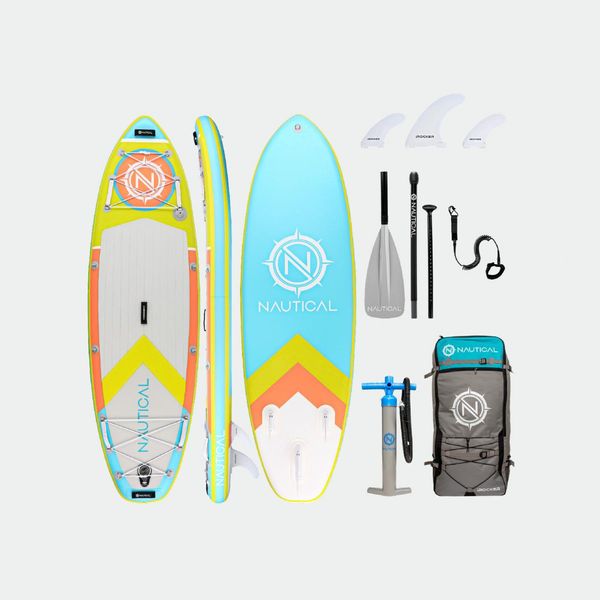
Inflatable | All-around | 9’ x 31’ x 6” | 220-pound capacity
The nine-foot Nautical board perfectly suits people under five feet tall. Some kids’ SUPs are eight feet long, but you’ll get more use out of your investment with the Nautical board as the extra length gives kids more room to grow into while still being highly maneuverable for little paddlers.
This SUP comes in four fun colors with everything typically included in a full-sized setup to get your child on the water: leash, paddle, pump, and carrying case. There’s bungee cord storage on both the front and back of the board so kids can haul their own adventure gear, and the three removable flip-lock fins are easy for kids to figure out. Plus, there’s an action mount for a camera and tons of D-rings, and the lightweight paddle floats (beware of kids’ paddles that don’t float because they’ll inevitably get lost while children get the hang of SUPing). Grab handles are at the front, middle, and back, so if your child’s arms tire out, you can hook up to the front handle for towing. The backpack doesn’t come with wheels — they’re an add-on — so if your little one can’t pack around 20 pounds yet, wheels are an upgrade worth considering.
Best solid all-around racing stand-up paddleboard
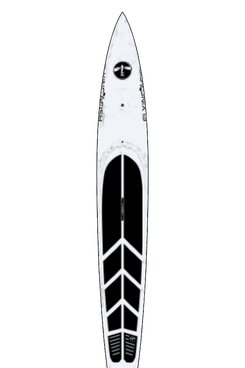
Solid | Racing | Custom | ~300 pounds
“I race on a Flying Fish,” says Birnes of the custom stand-up paddleboard makers in Stuart, Florida. “It’s really fun to be able to design your own race board, and do it online,” she says. “What appeals to me is that they’re made in America, and this custom board is basically the same price as if you were to buy a high-end production board.”
If you want to get into racing, having a paddleboard that fits and is dialed into your needs is ideal, especially for smaller people who might have difficulty finding SUP gear for their size. On the Freedom board, you choose everything from the length to the width, thickness, colors, deck pad, bungee cords, and more. The Freedom is the most versatile race board by Flying Fish, and if you plan to surf, ride downwind, and navigate both choppy and flatwater, it’s a solid bet.
Our experts
• Carleen Birnes, co-founder of Chesupeake in Severna Park, Maryland, stand-up paddle instructor, yoga teacher, and SUP race director • Bill Ennis, co-owner of Dig Paddlesports in Hurricane, Utah • Jill Jaques, stand-up paddle-yoga teacher, instructor trainer, and owner of Deep Blue Yoga in Seattle, Washington • Byron Kurt, founder and president of the World Paddle Association • Nicole Stimpson, SUP race coach, certified stand-up paddle instructor trainer, and sales manager at Chesapeake Light Craft in Annapolis, Maryland • Robert Stehlik, founder of lead designer, Blue Planet Surf Gear in Honolulu and stand-up paddleboard instructor trainer
The Strategist is designed to surface the most useful, expert recommendations for things to buy across the vast e-commerce landscape. Some of our latest conquests include the best acne treatments , rolling luggage , pillows for side sleepers , natural anxiety remedies , and bath towels . We update links when possible, but note that deals can expire and all prices are subject to change.
- the strategist
- sporting goods
- best in class
- outdoor leisure
Every product is independently selected by (obsessive) editors. Things you buy through our links may earn us a commission.
Deal of the Day
Micro sales, greatest hits, most viewed stories.
- The 11 Very Best Shampoos
- The 8 Very Best Toners
- All of the Best Father’s Day Gift Ideas
- Somehow, Everyone in My Neighborhood Has This Strange (But Wonderful) Clock
- What Nikki Glaser Can’t Live Without
- What Ben Van Leeuwen Can’t Live Without
Today’s Top Clicked
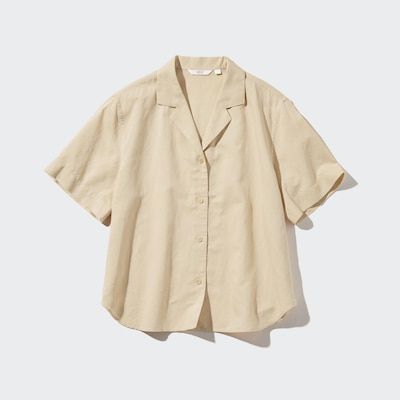
Article updated on April 28, 2024 at 9:00 AM PDT
Best Stand-Up Paddle Boards for 2024
Get ready for summer with a stand-up paddle board.
Our Experts

CNET’s expert staff reviews and rates dozens of new products and services each month, building on more than a quarter century of expertise.
What to consider
Solid vs. inflatable board
Not all stand-up paddle boards are inflatable; some are solid, which makes for easier setup but not necessarily transportation. Solid boards may also be better for the ocean because of their durability.
Purpose of owning a paddle board
Some paddle boards provide for more speedy transportation across the water, while other paddle boards are built for yoga or offer more stability. The best stand-up paddle board for you depends on how you'll be using it.
How much do you want to spend on a paddle board? There's a range of prices.

Summer is inching closer, and if you like being by the water, you will need the right equipment to make the most out of it. Paddle boarding is a very relaxing water activity, and you can pick it up fairly quickly. All you need to start is a good paddle board.
Whether you're an advanced paddle boarder or just getting started, we've rounded up the best stand-up paddle boards to get right now. We've included varied picks for different levels, including rigid and inflatable options, as well as picks that offer speed, balance, and value. You can have a lot of fun paddle boarding if you pick a board that fits your goals and values.
Best stand-up paddle boards
- Very stable
- Easy to transport
- Comes with a comfortable backpack
- Compatible with inflatable seat
- Can be a multifunctional board
- There are more affordable stand-up paddle boards
Best overall paddle board
Bote breeze aero.
A great paddle board should have these three qualities: stability, maneuverability and durability. On top of that, most people also look for a good return on their investment. The Breeze Aero from BOTE checks a ton of boxes for what your average paddler wants in a new, quality SUP. Not to mention, it's one good-looking board.
The BOTE Breeze Aero provides balance, speed, durability and maneuverability all in one SUP package. Speaking of packages, you also get additional gear with the board like a paddle, pump, repair kit, fin and travel bag. The BOTE Breeze Aero backpack was my favorite from the bunch. Not only is it spacious, but there's comfortable padding in the shoulder straps, so it's comfortable to haul around on your back. It's also a lot easier to transport than a solid paddle board, along with the other inflatable boards on this list.
This SUP feels fairly light, weighing in at around 20 pounds. That being said, it measures 10 feet 8 inches long and 33 inches wide, making it feel just as stable as any solid paddle board. I never felt like I was going to tip over, even when gliding over large wakes.
One of my favorite things about this board, besides its stability, is its compatibility with BOTE's inflatable seat. It instantly transforms your paddle board into a mini makeshift kayak. If you get the kayak paddle to go along with it, you have yourself a multifunctional board.
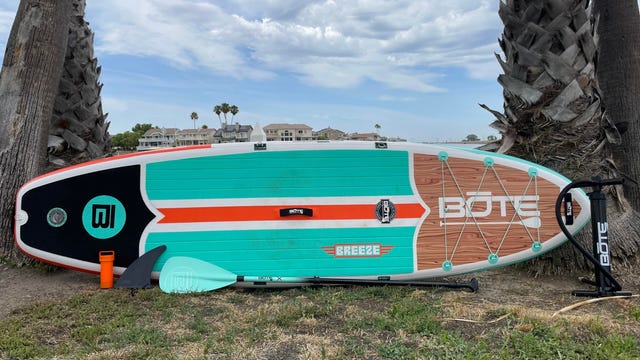
- Comes with four-point bungee to strap things down
- Not as fast as other boards
Best solid paddle board
Connelly voyager 2.0.
The Connelly Voyager SUP was my first paddle board and what a great board it is. I began taking it out to the beautiful (but chilly) Lake Tahoe to learn how to paddle board. Thanks to the stability and quality of the Connelly Voyager, balance wasn't an issue when winds picked up, and I was hard-pressed not to fall into the 57-degree water.
The wider and longer a board is, the more stable it will be. The Connelly Voyager is 10 feet 6 inches long and 32 inches wide. It weighs 34 pounds. It has a four-point bungee near the top to strap down a cooler, shoes or any other gear you want to bring along with you. The Connelly Voyager is also designed with a ding-resistant thermo shell and thermo shell seam reinforcement for maximum durability.
Speed isn't necessarily this SUP's forte, but it also doesn't offer the drag that the yoga and fishing paddle boards do. It is great for stability and tracking. Keeping a straight path with the Connelly Voyager is a breeze, and it effortlessly glides over boat wakes or small waves.
It doesn't come with any extra accessories, but it's sold in stores like Dick Sporting Goods where you can go pick out your own paddle and additional gear you may want. Because the Connelly is sold at such an affordable price compared to other solid boards, you're able to spend the extra money on accessories to beef it up. This board is an all-around great pick for any skill set, including beginners who are just dipping their feet in the sport.
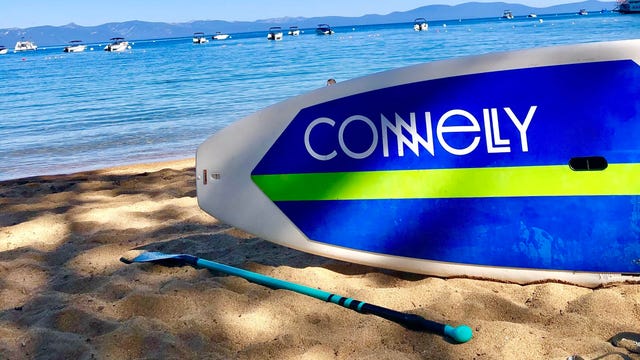
- Good for beginners
- Comes with waterproof phone case
- Lightweight
- Harder to balance than other SUPs
Best lightweight paddle board
Retrospec weekender 10'.
Retrospec is a popular paddle board brand you might have seen advertised on your Instagram or Facebook feeds. The Weekender model is its entry-level board, and I was really impressed with how nice the board is for the price. Hands down, this is one of the best paddle boards you can get for your money.
The Weekender 10' paddle board is 10 feet long and 30 inches wide. It has a single-layer PVC design with drop stitch tech. It comes with all the additional accessories you'll need, including a pump, three detachable fins, ankle leash, paddle, backpack, repair kit and even a waterproof phone case you can hang around your neck. I also love the colors the Weekender 10' is available in. I think it offers the most versatility in style compared with the other boards.
That waterproof case was a game-changer for taking photos and didn't come with any of the other paddle boards I tested. It may be a small addition, but it's a testament to the value you get with the Weekender 10'.
The Weekender 10' is incredibly lightweight, weighing 17 pounds, and easy to carry around. On the water, it glides with ease and is great for speed. You can gain good momentum with this board. That said, it was a little harder to balance than other SUPs. After 10 to 15 minutes on the board, you find your footing and find the hang of it -- even if you're a beginner. I think it's a great, all-around paddle board with an incredibly wallet-friendly price tag.
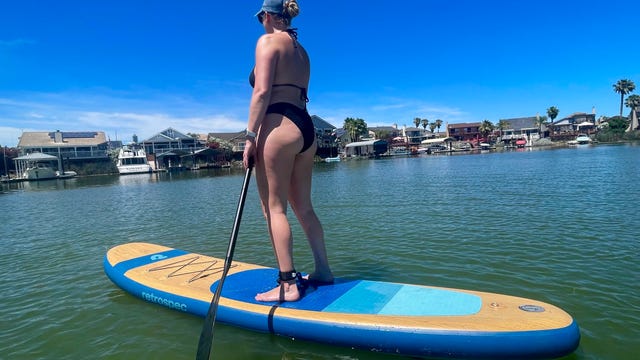
- Easy to balance
- Has padding material
- Fin may be complicated to attach
Best inflatable paddle board
Isle pioneer 2.0.
My first impression of the Pioneer 2.0 is that it's equally as speedy as it is easy to balance. After being used to my own board for so long, it took me a few minutes to find my footing and get comfortable with a few models during my testing process. I immediately clicked with ISLE's Pioneer 2.0 paddle board like I'd been riding it for years. It offers a fun, sturdy ride for all skill levels and is especially great for beginners.
The Pioneer 2.0 has a double-layer drop-stitch construction and measures 10 feet 6 inches long by 34 inches wide. It's a little heavier than the smaller models on this list at 24 pounds. It has front and rear bungee cords allowing you to store coolers, shoes, a jacket or other belongings you want to take paddling with you.
I found the nose of the Pioneer 2.0 does a great job of staying up out of the water. I kept my phone and shoes strapped under the front bungee and they stayed nice and dry. There are also two small straps attached to the side so you can secure your paddle when you're taking a break on the water which I greatly appreciate.
One of my favorite things about the Pioneer, besides its smooth ride, is the padding material. Other boards I've tested are made with extra-grippy, textured traction pads that without a doubt help with traction. The traction pad on the Pioneer 2.0 is made with a soft, smooth fabric-like material that offers great traction and is more comfortable -- especially when you're on your knees (a big plus for beginners).
The Pioneer 2.0 comes with a carbon hybrid paddle, hand pump, storage/travel bag, fin and leash. The travel bag comes with straps on the inside to secure your board, a good touch I don't see very often. The fin is a little more complicated to put on than other boards, but that's hardly a con, just something worth mentioning.
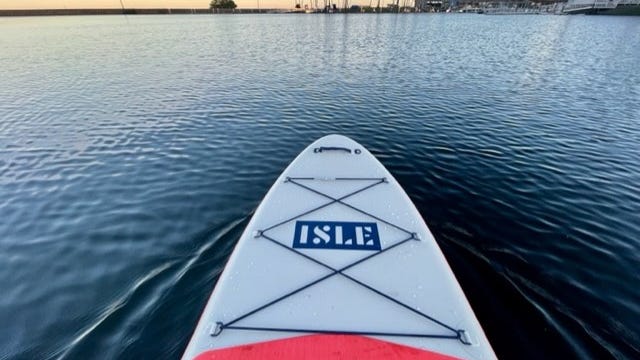
- Great for travel
- Comes with chargeable electric pump
- Easy to maneuver
- Comes with good paddle
- Model of board is good for specific heights only
Best paddle board for travel
Irocker 10' all around ultra.
The iRocker brand is fairly popular among riders and for good reason; it offers a range of different models and quality boards at affordable price points. I tested the 10' All Around Ultra SUP and found it to be a great travel-friendly, lightweight board to take with you on a pre- or post-paddle adventure.
Measuring 10 feet long and 32 inches wide and weighing 19.8 pounds, this inflatable SUP easily folds down to fit into a backpack that's more compact and preferably sized than others that I've tested. It's also a lot more carry-on friendly for travel. Rather than a tall and skinny SUP backpack, the iRocker bag is more square and sits more comfortably on my back. I'm a shorter rider and tend to feel like I'm going to fall over when I carry a heavy, tall SUP backpack.
In the water, the iRocker All-Around Ultra board is easy to maneuver and smoothly coasts along the water at a quick speed without much effort. I'm also a big fan of the paddle. It's made with carbon fiber and ergonomically designed to get good pushes in the water. It's also the only five-piece paddle I've tested, making it more compact and easy to pack.
The board has a woven, drop-stitch construction and features bungee cords both in the front and rear allowing you to secure all your gear. There are even four D-rings along the sides of the board so you can strap down a seat or cooler. For the bottom of the board's base, there are two long fins for easy tracking that connect to tethered flip locks. It's a fin-lock system I've never seen before, and it makes it easier to secure your fins to the board.
Last but certainly not least, it comes with a chargeable electric pump that makes inflating your SUP way easier. After a taxing hike to the lake, an electric pump is a huge help. Even if you're going right outside your house, an electric pump comes in really handy.
Pro tip : The 10' board is best for people 5 feet 5 inches tall and under, so taller riders should opt for the 11-foot model.
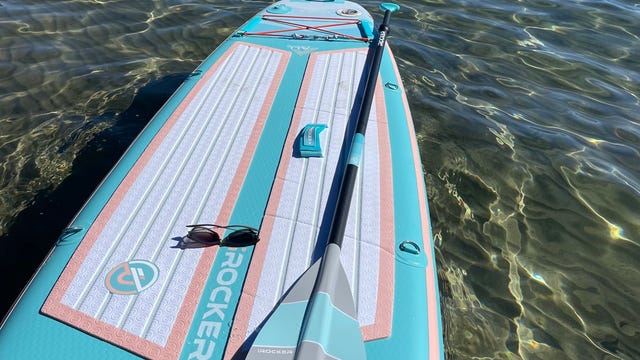
- Good for paddlers who like to travel long distances
- Lightweight for its size
Best paddle board for touring
Infinity e-ticket touring.
The adventure paddler who likes to travel long distances will love the sleek and functional design of the Infinity E-Ticket Touring paddle board. As Infinity says itself, this SUP has the performance aspects of a race board, but the generous widths and style of a touring board.
Inspired by the 2015 Blackfish model, the E-Ticket SUP has a wide, square-shaped tail and a wide-pointed nose for even more added stability and maneuverability. It promotes high speeds through glassy waters and allows you to stay stable when it gets choppy.
It's made with carbon Innegra glass and closed-cell EVA foam in the foot pad for a dry and comfortable grip. Another great thing about the deck is that it's recessed, promoting a lower center of gravity to help with stability. It's also surprisingly lightweight for its size. It's available in four sizes from 11 feet 6 inches to 14 feet long and with weights ranging from 26 to 32 pounds.
Paddles, ankle leashes and any other extras are sold separately, but I think the price of this touring board is fair enough that you can opt to spend money on added accessories without breaking the bank.
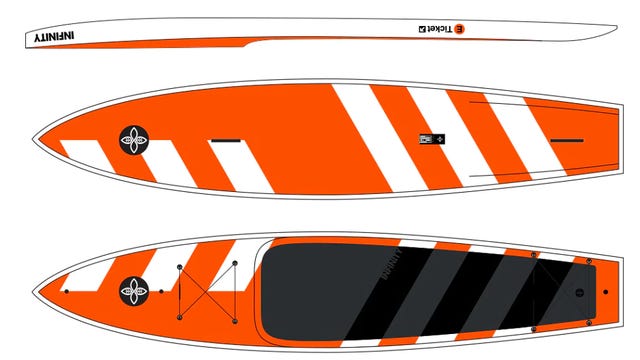
- Lots of accessories, including a magnetic cup holder for compatible accessories
- Good for fishing
- Designed to keep water out
- Rear and front bungee straps
- Heavier compared with other boards
Best paddle board for fishing
Bote rackham aero.
The ultimate functional paddle board award goes to the Bote Rackham Aero 11', and it's also the best paddle board for fishing. It's one of the most decked-out paddle boards I have ever seen, and it's compatible with add-on fishing accessories to upgrade your set-up.
There are two inflation nozzles on the Rackham Aero; one in the front for the nose and sides and one in the back for the base. It's almost like a paddle board and kayak hybrid because the edges are raised, enclosing you in a little boat-like SUP. This design also helps keep water from collecting on the top, keeping your belongings safe and dry.
That's just the start of what the Rackham Aero can do. The board is designed with add-ons like the cooler tie-down points, several D-rings, accessory mounts and even a magnetic cup holder (compatible with Bote Magnepod accessories ). It also includes a sheath for both your paddle and a sand spear for easy storage while you fish. I should also mention it's the only paddle board with rear and front bungee straps, allowing you to secure your items at both points. It has everything a paddling fisher might need to enjoy their time on the water.
Staying stable while you fish won't be a problem on the Rackham Aero, even if you're trying to hook a big catch. Its recessed base and 36-inch width help keep you perfectly balanced. You shouldn't expect to win any SUP races on the Rackham Aero -- it's not very fast, especially when you have all your gear strapped on.
The board weighs 36 pounds, and the case is around 50 pounds with the board and all the accessories packed in. It's definitely heavy, but the bag has small wheels attached to the bottom like a suitcase, allowing you to easily roll it during transport.
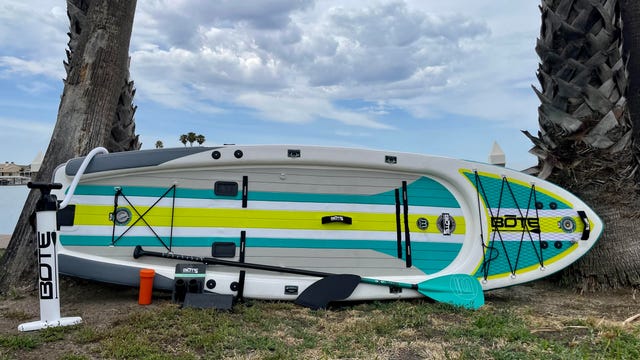
- Good for yoga
- Nonslip crocodile-grooved foot pad
- Larger board is a plus for some, but may not be for all
Best paddle board for yoga
Aqua marina dhyana.
Yogis who want to take their craft to the water may be interested in a paddle board specifically designed for yoga. As peaceful as yoga can be, there's something about the water that makes it even more centering. The secret to a nice yoga paddle board is a wide and long base to balance on. My personal favorite is the Dhyana paddle board from Aqua Marina.
Balance is made easy with its 11-foot by 36-inch dimensions. It's the most stable SUP I tested next to the fishing paddle board. Unless I was practicing a difficult yoga move I hadn't done before, I felt like I was never going to fall off that thing. Although it's such a big board, I was pleasantly surprised with its lighter 22-pound weight. Compare that with the BOTE Rackham, which is the same dimensions but 14 pounds heavier.
The Aqua Marina Dhyana is made with PVC, drop stitch technology and a nonslip crocodile-grooved foot pad that covers almost the whole board so you can use a ton of space. The foot pad is softer than the padding on traditional paddle boards, making your different yoga poses feel more comfortable.
Not only that, but the crocodile grooving allows you to keep better traction. As you can imagine, it gets pretty slippery out there on the water. Also, there isn't a handle protruding out from the middle of the board, allowing you to sit or lay comfortably when you're in ground poses.
Besides your standard inflatable paddle board accessories like a pump, leash, backpack, fin and paddle, you'll also receive a yoga board strap to carry your board like a yoga mat, a paddle holder to use while you do yoga and a connection strap you can use to hook your paddle board to other objects.
For yoga teachers or paddlers who want to recruit more friends, Aqua Marina also offers a 9-foot 6-inch dock to which you can connect up to eight boards. (This is where that connection strap comes in handy.)
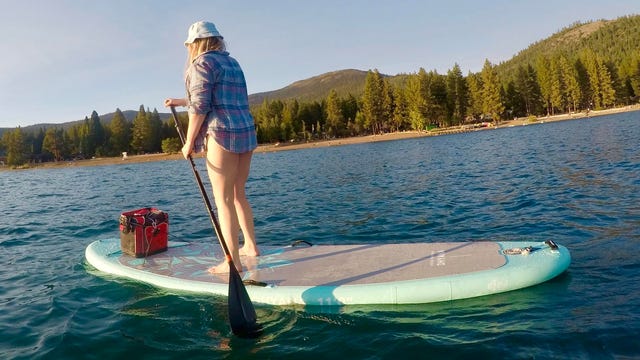
- Comes with accessories
- Nice paddle
- Easy to gain speed
- Smalls size could be a con for some
Best budget inflatable paddle board
High society zg inflatable sup.
Since this post was created, High Society has remade the ZG Inflatable SUP and added kayak compatibility and two action mounts. We tested the previous model; the newer one is available for pre-order now.
From the mile-high state comes the High Society ZG inflatable paddle board. It offers a nice balance of stability and speed, and boy did I love how zippy this board was. I could gain speed and keep it with little effort, often trailing ahead of my paddle partner, who was taking the BOTE Breeze for a spin.
The High Society ZG SUP package includes all the accessories needed for an inflatable board, including a pump, travel bag, detachable fin, repair kit, paddle and an ankle leash. The High Society paddle was my favorite of the ones I tested. Paddles tend to loosen up at the handle, allowing them to twist and turn as you paddle through the water. The High Society paddle stayed sturdy and didn't twist an inch.
The ZG paddle board is 10 feet 6 inches long and 32 inches wide. It's made with commercial-grade PVC that's been through a multistep inspection for quality assurance. The grip on the deck of the board is similar to that on the premium Infinity E-Ticket Touring board, with a diamond grooving that helps slippery feet gain better traction.
Another strength of this inflatable paddle board is its ability to keep water from the deck. Its rocker profile keeps the nose of the board poking slightly upward, which helps prevent water from soaking your belongings.
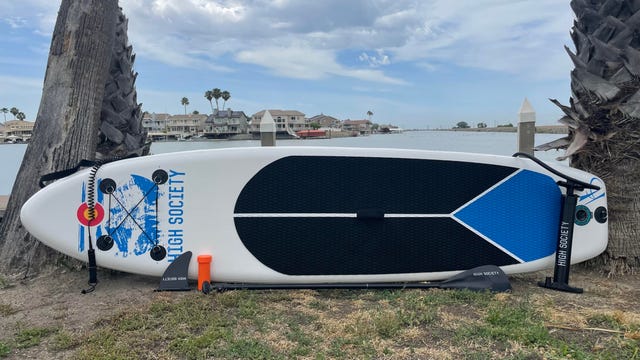
How we test
CNET health and wellness editors pick the products and services we write about based on editorial merit. Each paddle board was tested individually on the same body of water to determine speed, tracking and balance performance. Tests were completed when wind conditions were below 10. SUP was inflated to its suggested PSI, typically between 10 to 15.
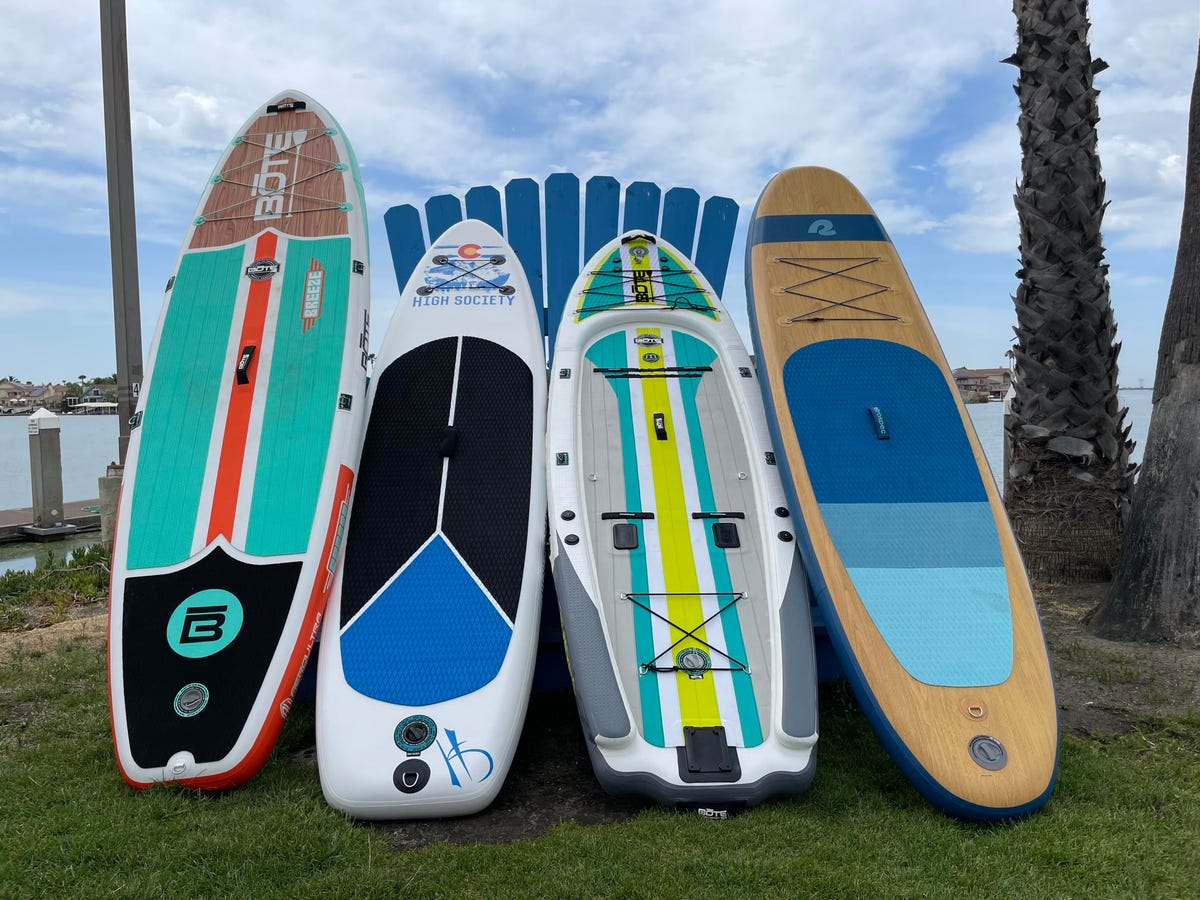
Factors to consider when choosing a paddle board
Solid vs. inflatable.
There are two kinds of paddle boards you can buy, inflatable or rigid, aka solid. One isn't better than the other -- it will primarily depend on your current circumstances and what you're looking to get out of your board.
Solid paddle boards tend to be better for the ocean because they're more durable and can likely withstand the hit from jagged rocks and coral reefs. They're also more stable when you hit choppy waters, boat wakes and waves. They're also usually heavier, harder to transport and more difficult to store.
Inflatable paddle boards allow you to easily store it in small spaces like apartments, studios or the trunk of your car. They are also easier to get to the water, especially if you don't own a truck or vehicle with roof racks.
Functionality
You can buy specific types of paddle boards you can buy that are ergonomically designed for certain activities. There are different lengths, widths and styles to maximize functionality.
- Touring : Touring paddle boards are meant to go long distances over flat water and enable you to cut through choppy waters without trouble. They tend to be long with pointed noses to maximize speed but are wider than a racing board to help you feel more balanced over a long period of time.
- Racing : Racing paddle boards are built for speed. They are usually long, skinny and agile for great maneuvering. Expect to pay over $1,000 for a quality racing paddle board.
- Yoga : Yoga paddle boards are longer and wider than your average SUP, so you can feel more balanced while practicing your poses. The foot pad also tends to take up a lot of the board's surface area, so you have plenty of space to move around in.
- Fishing : Fishing paddle boards are like yoga SUPs in that they are longer and wider for better balance. They also typically have a recessed deck to help lower the center of gravity and improve balance. Not to mention, more D-rings to hook your fishing gear to.
- Multi-person : Most paddle boards fit up to 250 to 300 pounds. Paddle boards meant to fit more than one person are quite large, wide and can sit up to 20 feet long.
- Leisure : The average paddle boarder wants to glide through the water and balance without falling off. A paddle board can range between 10 to 11 feet long and offers a nice combination of speed, stability and maneuverability.
You can find a wide price range with paddle boards, so you can enjoy the sport on almost any budget. Inflatable boards tend to be more affordable than hard-top ones, while performance and racing boards are among the most expensive you can buy. For a good paddle board, prices start around $300 and go all the way up to $2,000 or more.
Once upon a time, I lived in a one-bedroom, 750-square-foot apartment and bought a 10-foot paddleboard. Did I have a detached garage? No. Did I have an abnormally large storage closet? No, I didn't have that either. Not understanding the sheer size of a paddleboard, I didn't take storage into account. I had to buy wall mounts to hold my paddle board above my bed, almost like a makeshift headboard. Before I knew it, my place felt like a beach house in the middle of Reno, Nevada.
Moral of the story is, make sure you have the storage space for a solid SUP before you buy if that's the kind you're leaning toward.
Stand-up paddle board FAQ
Is a longer or shorter paddle board better.
That depends on what you want to use it for. Shorter boards are slower but easier to maneuver and carry around. Longer paddle boards tend to be faster but weigh more than shorter boards. Boards under 10 feet long are best for kids or people who want to surf.
Which paddle boards are the most stable?
The wider your paddle board, the more stable it's going to be. If balance and stability are your main concerns, keep an eye out for an SUP that's 33 inches wide or larger. Keep in mind, wide paddle boards are slower than long, narrow paddle boards.
How long will an inflatable paddle board last?
If properly stored and taken care of, your inflatable paddle board can last five to 10 years. Most inflatable boards also come with a repair kit if you experience a puncture.
Fitness Guides
- Best Elliptical
- Best Treadmill
- Best Rowing Machine
- Best Exercise Bike
- Best Peloton Alternative
- Best Adjustable Dumbbells
- Best Home Exercise Equipment
- Best Smart Home Gym Workouts
- Best Weightlifting Shoes
- Best Walking Shoes for Men
- Best Walking Shoes for Women
- Best Running Shoes for Men
- Best Running Shoes for Women
- Best Compression Socks
- Best Foam Roller
- Best Massage Gun
- Best Smart Scale
- Best Mirror Workout
- Best Fitness Workout Apps
- Best Fitness Trackers
- Best Chest Strap Heart Rate Monitors
- Tonal Review
- Theragun Review
- Best Protein Powders
- Best Protein Shakes
- Fitness Supplements that Work
- Best Pre-Workout Supplements
- Best Creatine Supplements
- Best Foods for Building Muscle
- Best Weight Loss Programs
Gear-obsessed editors choose every product we review. We may earn commission if you buy from a link. Why Trust Us?

The 7 Best Inflatable Standup Paddleboards Combine Capability and Portability
Boards that can span 10-plus feet yet pack down to the size of a small suitcase.
Inflatable SUPs in their earlier adaptations had a reputation for being a flimsier version of a hard board (think floating air mattress), but today’s higher-end inflatable paddleboards rival the performance of hard boards. Budget-friendly inflatable SUPs offer just as much fun for a third of the price (and space) of a hard board.
So whether you’re seeking serenity on calm water or chasing thrills on the open ocean, you can do so with a paddle in hand. Go fast and far with a touring board or do some downward dogs with your four-legged friend on a stable, beginner-friendly board.
Best Inflatable Standup Paddleboards
- Best Overall SUP: BOTE HD Aero
- Best Budget SUP: ROC Paddle Board
- Most Portable SUP: iROCKER All-Around Ultra
- Best Stability SUP: RETROSPEC Weekender Plus
- Best for Beginners SUP: BOTE WULF Aero
The Expert: With two decades of standup paddling experience, I’ve paddled throughout the South Pacific along coastlines in Fiji, French Polynesia, and Hawaii, as well as Australia and California. My grandparents used to paddle competitively, and my grandfather carves custom paddles professionally. Whenever I pick up a paddle in their presence, I am coached extensively. My love of the ocean inspired me to create The Salt Sirens , a website dedicated to ocean sports, and I am a guidebook author for Moon Travel Guides. My writing has appeared in outlets like The Standup Journal, Travel + Leisure , AFAR , Vice , Lonely Planet and more.
What to Look For in an Inflatable SUP
While there are some great all-around boards, inflatable SUPs have become increasingly specialized for activities like fishing , surfing, and touring. First think about how you’ll use your board—casual flat-water cruising, fishing , camping , or catching waves.
More Cool Stuff To Consider: Best Inflatable Kayaks • Best Waterproof Bluetooth Speakers • Best Flippers to Dive, Snorkel and Swim • Best Backpack Coolers
Perhaps most important for inflatable standup paddleboards is length, since it has the greatest bearing on overall performance. Generally, the longer a board is, the better it glides and the greater its capacity to carry heavy loads. Touring boards and those for fishing are longer. In fact, long-distance racers will often ride boards 14 feet or longer; SUPs for surfers (and for kids) are shorter, as these boards tend to be more agile. Many surfers use boards that measure just 7.5 feet. For most recreational paddlers, lengths should fall between 10 and 12 feet.
Don’t forget to double check the weight capacity. Is it just for you or will there also be camping or fishing gear, or maybe even a dog or cooler along for the ride?
Boards are often designed for different activities—tackling whitewater, fishing, practicing yoga, or leisurely touring. This is most evident in the shape of the board. Standup paddleboards meant for touring tend to be long and narrow, allowing them to paddle fast and straight. Paddleboards meant for yoga, beginner paddlers, or general use tend to be wide with a round nose, prioritizing stability.
If a standup paddleboard is too heavy for you to carry and launch, it’s likely to collect dust in a corner. Choose a paddleboard that’s manageable to carry, but note that lighter boards can often be made from less durable materials. Lighter boards will often have a single-layer PVC outer shell with a linear drop stitch inside to give the board its firmness. Heavier and more durable boards might have layered PVC, welded seams, and a more complex system to make them stiffer.
Portability
One of the best things about inflatable SUPs is their portability. If it’s just a short hike from your car to the water, weight may not be a big factor. But if you have a long haul to get to the water or if you will be traveling with your board, that may change the equation. Most inflatable SUPs come with a backpack for easy transport, and some carriers even have wheels.
Paddleboard Accessories
The standup paddleboard itself is only part of the sport. Many inflatable standup paddleboards come with accessories like a paddle, fin(s), pump, and leash. The paddle is essential, and you’ll want one that’s adjustable by length if multiple people will be using the board. Note that paddle length is determined by the paddler’s height. You'll want to be sure your fin or fin system is compatible to your board, and that you have a leash to tether you to the board.
Invest in a high-quality personal flotation device, like a life jacket or inflatable belt-pouch, for safety. The Unites States Coast Guard requires paddlers to wear one when venturing outside of surfing, swimming, and bathing areas.
Most inflatable standup paddleboards come with a hand pump to inflate the board. If you’re short on time and would rather spend your energy paddling instead of pumping, there are electric pumps (figure about $1oo-$150) that cut down the effort it takes to inflate your board.
How We Evaluated Inflatable SUPS

To find the best inflatable SUPs, I relied on my personal experience using inflatable SUPs that are featured in this roundup, as well as many that ultimately did not make the cut. I tested boards in a variety of water conditions and got feedback from other paddlers who had different paddling preferences and abilities from mine.
With the surge of new inflatable SUP brands on the market, I wanted to make sure I wasn’t missing any main contenders. I combed through reviews on consumer websites and paddling forums. Resources like Paddling Magazine and Session Magazine helped me find brands I might not have considered.
The number one thing I look for in a paddleboard is its performance followed by value for money, durability, and intended purpose. Added features like storage and carrying systems also played into consideration. I did not feature boards that seemed as cumbersome as a hard board, as that defeats the purpose of an inflatable.
BOTE HD Aero

The BOTE HD Aero is my ‘Best Overall’ for three main reasons: versatility, sturdiness, and maneuverability. It’s stable enough for beginners and agile enough to grow into, making it a worthwhile investment if you want a one SUP quiver.
It’s great for a quick workout on calm water yet it can also handle longer distances. As for the details? I love the use of ample bungee storage space at the nose and tail, the non-slip deck, and paddle strap to tuck the paddle away.
The package includes a hand pump, fins, leash, travel bag, and three-piece paddle. BOTE also sells a range of compatible accessories for the board like a trolley rack, cooler, and hands-free carry system.
ROC Paddle Board

The ROC Paddle Board is ideal for paddlers who want to dip their toes into the sport without making too splashy an investment. Fun for calm conditions, this board is easy to inflate, lightweight, paddles well, and is surprisingly stable.
Though you won’t gain much speed on the ROC Paddle Board, it’s a fun cruiser. In fact, this SUP would be the ideal fit for families going on a vacation and who want a one-size-fits-most board to share around.
The board comes with a paddle, hand pump, leash, carrying bag, fin system, and small dry bag that can clip to the bungee storage areas. If you plan to store this board fully inflated, I recommend releasing a little air before stowing it away to increase its longevity, as the seams might stretch and leak over time.
iROCKER All-Around Ultra

There’s an arms race among the paddleboard companies to see which board can be the lightest and most compact. For iRocker, its take on this challenge is the All-Around Ultra model, a 10-foot board that packs down into a small backpack. The board itself weighs a touch under 20 pounds.
Despite its lightweight construction, the All-Around Ultra is stable and tracks straight. Its two-fin system makes turning a little slow, however.
You’ll find bungee storage at the nose and tail, and three carrying handles. The board comes with an electric pump, a five-piece paddle, fins, a leash, and a bag. The larger 10-foot model is best for petite paddlers who are 5-feet 5-inches and shorter. Taller paddlers should opt for the 11’0” All-Around Ultra .
Retrospec Weekender Plus

The Retrospec Weekender has evolved over the past few years, and my favorite version is the Retrospec Weekender Plus. At 36 inches wide, it has a base that’s stable enough to handle a bit of chop but still steers smoothly. Suitable for rides in various conditions, plus accurate steering, make this an ideal board for both beginners and experts.
The SUP comes with a kayak seat conversion that’s quick to set up when your legs start wobbling or if you simply want a change in perspective. Features like two bungee storage areas at the nose and tail, an easy installation fin system, and nonslip deck make this board an all-arounder.
The package comes with a carrying backpack, pump, paddle, leash, three fins, repair kit, and a waterproof phone case. An action camera mount at the nose is a convenient touch for shutterbugs.
For the next Retrospec Weekender iteration, I hope to see the storage bungee cables stretched across the whole deck to give it a bit more stowage capacity, but that's a minor quibble.
BOTE WULF Aero

If you’re new to paddleboarding (or want a board that’s reliable in calm conditions), opt for a SUP that’s easy to maneuver but stable enough to give you a solid base as you find your balance.
The BOTE WULF Aero is a top pick thanks to its shape and durability. Its mid-section is 33 inches wide, so it’s easy to get on, stand up, and stay on.
A magnetic water bottle holder near your feet makes it effortless to reach down and rehydrate—you won’t have to worry about tiptoeing to the bungee storage section by the nose.
The BOTE WULF Aero comes with a repair kit, carrying case, fin, adjustable paddle, and leash. The only true hindrance from this being an out-of-the-bag beginner SUP is that the pump is sold separately.
Bluefin SUP Cruise Carbon

Many intermediate and experienced paddlers will cite rigidity as their top gripe with inflatable paddleboards. It’s a challenge for an inflatable to replicate a fiberglass or epoxy board feel. The Bluefin Cruise Carbon, however, comes close.
Dual inflation chambers, carbon-reinforced rails, and its shape make it sturdier and more agile than many of its inflatable counterparts. You won’t feel the signature bounce and wiggle of an inflatable SUP as the Bluefin Cruise Carbon easily glides over chop. A comfortable neoprene seat easily clips into the board, converting it into a kayak.
The board also features two bungee storage areas, three carrying handles, action camera mounts and a non-slip deck pad. The package includes a travel bag, leash, dual-action pump for easy pumping, paddle, and seat.
Red Paddle Co. Voyager

The Red Paddle Co Voyager’s price tag teeters on the edge of a comparable hard board, but you have portability that you might not find with its hard board counterpart.
The Voyager is ideal for long days or distances out on the water. Its V-shaped hull with twin fins helps the board move fast, track straight, and handle choppy conditions. The extended nose maximizes stability for both newbies and advanced paddlers alike.
On deck, you’ll find three carrying handles, D-rings, and a bungee storage area at the nose. The package comes with a wheeled carrying bag, pump, fin, and battens. The paddle must be purchased separately .
Why the Right Paddle Makes a Big Difference, Where to Take Your SUP, and Why Go for an Inflatable. Expert Chantae Reden Has the Answers.

What are the main benefits of an inflatable SUP over a hard board?
Inflatable SUPS are typically more affordable than similarly shaped hard boards built from fiberglass or epoxy. Because inflatable SUPS are packable, they’re also more portable and lightweight than hard boards.
If you’re a beginner paddler who isn’t sure if a performance hard board is worth the investment, purchasing an inflatable SUP is often a wise choice to learn the basics of paddling and whether it suits your lifestyle.
Where can I paddleboard?
Most bodies of water that are open to recreational water sports are ideal places to paddleboard. If you’re just starting out, go to your local lake or river where waters are calm.
If you live near the ocean, start in flat water lagoons or bays before moving to areas where you could encounter currents and waves. It’s also best to paddleboard while the wind is blowing onshore, so you’ll drift back to land in case of an emergency.
Because standup paddleboarding is still a growing sport, it’s wise to see where local kayakers are heading—many times, conditions that work well for calm water kayaking are suitable for paddleboarding as well.
Is it true that a good paddle is just as important as a good board?
Having a good board is more important than having a good paddle, but only slightly. Without a suitable paddle, you’re unlikely to get very far no matter what board you’re on.
A good paddle doesn’t have to necessarily be expensive or made from high-end materials like carbon fiber. As a rule, you’ll want one that’s tailored to your height (roughly 4 inches taller than you are), lightweight, and comfortable to hold.
Chantae Reden is an adventure writer and photographer who rarely strays far from the coastline. She is a freediver, surfer, kitesurfer, paddler, scuba diver, and has a mild obsession with sharks. She has ridden a motorcycle through East Timor, scuba dived with tens of bull sharks in Fiji, and swam beside humpback whales in Tonga. Her work has appeared in Travel + Leisure , Escape , AFAR , Lonely Planet, and she is a guidebook author for Moon Travel Guides. Contact Chantae on her website, ChantaeReden.com .

.css-cuqpxl:before{padding-right:0.3125rem;content:'//';display:inline;} Best Product Reviews of 2024 .css-xtujxj:before{padding-left:0.3125rem;content:'//';display:inline;}

The Best Evaporative Coolers for Your Workshop

The 4 Best Anti-Snoring Devices for Better Sleep
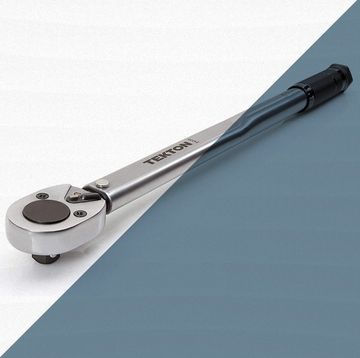
The Best Torque Wrenches for Your Toolset

The Best Portable Air Conditioners
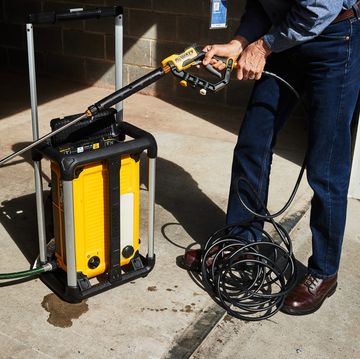
The Best Electric Pressure Washers

The 8 Best RV Generators of 2024

Filson 48-Hour Tin Cloth Duffel Review

The Best Memorial Day Generator Sales 2024

These Camp-Ready Generators Are 33% Off at Amazon

The Best Outdoor Daybeds for Lounging in Style

Discounted Gas and Electric Chainsaws for Spring
Best Portable Paddle Boards [2024]: Compact + Travel Ready
This article may contain affiliate links to which we are compensated if you buy. This comes at no extra cost to you.
Aren’t all Inflatable SUPs Portable Paddle Boards? I hear you ask.
Yes and no.
There is no doubt that inflatable paddle boards have made accessibility easier to most people including apartment dwellers. I don’t need to tell you that.
But there’s a segment that’s growing at a rapid pace in the inflatable paddle board community and that is Compact/ Portable/ Travel paddle boards.
These boards are meant to be even more compact than their original inflatable kin thanks to the ability to fold in half lengthwise. This makes the board more compact which means the bag can be almost half the size lengthwise.
This difference can save a lot of space which could mean the difference between taking the board more easily on a bus, train, or plane than not.
For our full list of the Best Inflatable Paddle Boards check it out here.
Table of Contents
- Best Compact and Portable Paddle Boards
Portable Paddle Board Buying Guide
Compact sup faqs, best compact and portable paddle boards .

Below are some of our favorite compact SUPs that make traveling and transportation that much easier. I’ve made sure to choose brands that I’ve tested or that have worldwide respectability coupled with fantastic customer service .
For a list of our Best Lightweight Paddle Boards click here.
Best Portable Paddle Boards List

Blackfin Ultra CX
- Dimensions: 10’6 X 31.5” X 6”
- Weight: 19.8 Lbs
- Max Capacity: 320 Lbs
- Materials: Cross Threaded Drop Stitch with Carbon Rails
- Best For: Paddlers who want a quick and manueverable SUP with portability.

iRocker All Around 11 Ultra
- Dimensions: 11' X 32” X 6”
- Weight: 21.4 Lbs
- Max Capacity: 290 Lbs
- Materials: Cross Thread Drop Stitch
- Best For: Taller Paddlers who want a portable SUP.

iRocker Cruiser Ultra
- Dimensions: 10’6” X 33” X 6”
- Weight: 21 Lbs
- Max Capacity: 300 Lbs
- Materials: Cross Woven Drop Stitch
- Best For: Paddlers who want a more stable portable SUP.

Red Paddle Compact 12′
- Dimensions: 12’ X 32” X 4.7”
- Material: In-house MSL Fusion Lamination
- Weight: 22.3 Lbs
- Maximum Capacity: 265 Lbs
- Best For: Paddlers who want a high quality touring portable board.

Nixy Huntungton Ultra Compact G4
- Dimensions: 9’6” X 32” X 6”
- Material: Dual Layer Fusion Laminate w/ woven drop stitch
- Best For: Smaller paddlers who crave manueverability.

Red Paddle Compact 9'6"
- Dimensions: 9’6” X 32” X 4.7”
- Weight: 16 Lbs
- Maximum Capacity: 209 Lbs
- Best For: Paddlers want a smaller, more manueverable lightweight SUP.
1. Blackfin Ultra CX (Intermediate Paddler Pick)

Specifications
- Dimensions: 10’6” X 32.5” ( Really 31.5” ) X 6”
- Material: Fusion Laminated/ Cross Threaded Drop Stitch
- Maximum Capacity: 320 Lbs
- Bag Dimensions: 10″ X 16″ X 21″
- Package Weight: 33.3 Lbs
Total Score: 8.8 (Averages of Below Scores)
- Stability 8
- Tracking 8.5
- Maneuverability 9
- SUP Construction – 9
- D Rings 8.5
- Deck Bungees 8.5
- Action Mounts: 7.5
- Handles 9.5
- Backpack 9.5
- Set-Up/ Take Down – 9
Why is it a Good Portable Pick?
The Blackfin Ultra CX is my number 1 pick for the best portable SUP due to a few reasons. It’s a well-made board that has incorporated a lot of good technology inside and it’s a really swift board to paddle! The responsiveness of this SUP is probably one of my favorite qualities about this board .
I had an absolute blast testing it out against windy conditions at the Nickelmekl river. It felt like a SUP that I would never get bored of. Why’s that? I’ll explain below.
On-Water Performance
I’ll get this out of the way now for some of you newer paddlers. If you are looking at this board as your first SUP it can be a good pick, BUT your learning curve will be steeper . When we are talking about the stability of the board it’s an area that lacks a bit compared to the All Around Ultra 11 or the Cruiser 11 Boards . I put this down to the SUP’s narrower shape, smaller tail and it’s width being about an inch less than what the manufacturer states.
Now onto the things that I loved about this SUP. It’s just super responsive and does exactly what you want it to do from a maneuverability standpoint. When doing a 360 using sweep strokes I was about to do it in 3.5 paddle strokes and 13 smaller side paddles to do a 360 .
The aspect that I was most impressed with was its responsiveness when it came to going around/ dodging parked sailboats in the marina. I could be paddling ahead and just put the blade in the water and the board would turn on a dime.
In terms of tracking and speed, this SUP did very well for a SUP of its size. Especially when paddling against the wind. Although it won’t be the best tracking nor the fastest paddle board on this list. It does a great job despite its average All Around paddleboard length.
Board Features and Design
The Ultra CX has too many features and designs to specifically talk about in this small section so I’ll get to the best parts (Also check out the Blackfin Ultra CX Review!). Something that I really appreciated about not just the Blackfin but all the other Ultra paddle boards is the fact that the accessories are very well thought out.
Firstly, the bag is very well designed . Because of this design, we were easily able to fit this SUP and a regular-sized All Around 11 board into my small Hyundai trunk with SUP gear and tennis rackets . Something you could not do with 2 regular-sized SUP bags.
Another thing I really appreciated was the inclusion of an electric pump . Sometimes SUP manufacturers will have sales where electric pumps come with the board but this inclusion is permanent. The iRocker inflatable pump is also rated as one of the Best SUP Pumps so it’s a bonus they included this.
You can see our Full Indepth Blackfin Ultra CX Review over here.
- One of my favorite “all around” SUPs I’ve paddled to date
- Very maneuverable and responsive in the water
- Accessories that come with the board are very well throughout and put together
- This board is a looker, especially the grey edition
- Speed and Tracking are pretty good for a board of its dimensions
- Not the most stable SUP on this list
- Maybe a bit more difficult for a brand-new paddler to master
2. iRocker All Around 11 Ultra (Tall Pick)

- Dimensions: 11’ X 32” ( Really 31” ) X 6”
- Maximum Capacity: 290 Lbs
Total Score: 8.7/10 (Averages of Rating Below)
- Tracking 8
- Maneuverability 8
For those of you who are taller and newer to the world of stand-up paddle boarding. This board will probably be one of the best picks you can choose for a compact SUP. Although that’s not to say it’s the most stable board in the world because it’s not . In fact, when I did a test between the Ultra 11 and the All Around 11 2020 model I found the former felt more stable in the water.
The All Around 11 Ultra, like the Blackfin Ultra CX , offers very well throughout accessories like the inclusion of the electric pump, and the custom-made bag that feels like a giant drybag backpack (it’s not a dry bag). Most importantly the portability of this package as the full bag dimensions with SUP inside is 10″ X 16″ X 21″.
The All Around 11 Ultra is a good jack-of-all-trades SUP in the sense that it does all the on-water performance aspects fairly well but does not excel in one specific thing. Which is a bit of a different approach from something like the Blackfin Ultra CX or the Red Paddle Compact 12 board .
I’ve put in at least 10 hours paddling this board in both coastal and lake conditions and it performed well in most conditions . The two-fin set-up in my mind definitely gives the board more responsiveness but takes a tad bit off of tracking ability. Although in our testing compared to the All Around 11 regular SUP the differences were not super noticeable.
The only condition where I thought this SUP was a bit more susceptible to being bullied was during windy days. This in my mind, is due to the board’s longer length and its lighter weight which made it a bit difficult to paddle against the wind. Although if you are a beginner paddler you shouldn’t be out in these conditions, to begin with ;).
In the Blackfin Ultra CX round-up, we talked about the accessories, so in this section, we will talk about the board itself since many onboard features are similar between the two.
The All Around 11 Ultra Features:
- 2 Detachable Fins (With tether lock)
- 3 Action Mounts
- Spit Deckpad
- 5 Rows of Removable Bungee Deck Webbing
Folding the SUP can be a bit tricky the first few times, especially when you come to realize that the SUP won’t fold exactly in half lengthwise. But it’s more than achievable as the bag is made to zip all the way open to allow the full SUP to fit.
The Ultra 11 has solid D-ring placements that allow you to add a kayak seat. Its deck bungees are big enough to stow a good amount of gear . I like to bring a cooler or deck bag with water bottles at the front and I like to place my little speaker and sandals in the rear of the board.
One thing I was not super keen on with the Ultra series was the 5 piece paddle . I understand they want to make it a 5 piece to make the paddle more compact but you do notice more play compared to a 3 piece SUP paddle. This is not so noticeable when doing some casual paddling. But when you are up against the wind, or you want to go faster you definitely feel the extra movement in the paddle thanks to the extra connection points.
You can see our Full Indepth iRocker All Around 11 Ultra Review over here.
- Well-thought-out Accessories
- The board does most on-water performance metrics well
- The board is more responsive compared to the original All Around 11
- You can fit a good amount of gear on this SUP
- Deck bungees are removable which gives you customization options
- Does not track as well as All Around 11 Original SUP
- Takes a few tries to figure out board folding pattern
- The handle does get in the way of your knees when kneeling on the board
3. iRocker Cruiser Ultra (Stability Pick)

- Dimensions: 10’6” X 33” X 6”
- Maximum Capacity: 300 Lbs
- Bag Dimensions: 10” X 16” X 21”
Total Score 8.6/10 (Average of Scores Below)
- Stability 8.5
- Tracking 7.5
- SUP Construction – 9
- Set-Up/ Take Down – 9
The iRocker Cruiser is probably the best “All Around” pick on this list in that it will be the best pick for a wide variety of paddlers that have different shapes and sizes .
The board’s 10’6” length coupled with its wider shape allows both small and large beginner paddlers to feel comfortable when first paddling this board. To boot this SUP has one of the highest maximum capacities on this list.
The Cruiser, like the All Around 11 Ultra and the Blackfin Ultra CX , comes in a tidy package. It includes a well-thought-out bag, the iRocker electric pump, 5 piece carbon shaft nylon blade paddle, a color-coded leash, and a repair kit.
The Cruiser line from the beginning has always been about getting newcomers into the water and getting them comfortable quickly . The wider tail does a good job of adding extra stability, especially when compared to the All Around 11 Ulta and Blackfin CX Ultra boards. At 33” wide it provides more stability than most compact boards can provide for a broad range of different-sized paddlers.
Being a cruiser-type board, the Cruiser Ultra won’t win any races, but it also won’t lag too far behind other Ultra boards in the iRocker line-up . In my experience, the twin fins give the board a bit less tracking ability compared to the original but it makes them more responsive than the original Cruiser series .
The Cruiser features a split deck pad that allows you to fold the board in half relatively easily. When folding the board in half lengthwise don’t expect a perfect fold, especially when you get toward the fins. As long as the board has been properly drained of air and mostly folded in half it will fit back into the bag.

The Cruiser is an underrated pick to pack some gear onto . It features 5 rows of removable bungees which allows you to customize what you put on the board. The Cruiser’s 300 lb “suggested” capacity also gives you a bit more freedom to put bigger items like coolers on top . Despite the heavy capacity this won’t be the most efficient board to tour due to the board’s wider shape and dimensions. But it’s great for a solid day’s paddle.
You can see our Full Indepth iRocker Cruise Ultra Review over here.
- One of the best picks on this list for beginner paddlers
- The board’s wider shape allows it to support a wide range of paddlers of different shapes and sizes
- Removable bungees make the board fully customizable
- I really like the cords attached to the fins that avoids you losing them
- Won’t be the fastest board on this list
- The 5 piece paddle has more bend due to more attachment points
- The handle can get in the way of your knees when kneeling on the board
4. Red Paddle Compact 12′ (Touring Pick)

- Dimensions: 12’ X 32” X 4.7”
- Material: In-house MSL Fusion Lamination
- Weight: 22.3 Lbs
- Maximum Capacity: 265 Lbs
- Bag Dimensions: 22” X 16.5 X 12.5”
- Package Weight: 34 Lbs
This board is best for the touring enthusiast who wants a portable paddle board to boot! The Red Paddle Compact is a great choice for those who want a bit more performance out of their SUP while maintaining a decent amount of stability.
The Compact 12 is one of the few touring paddle boards that fold in half lengthwise. This makes this an excellent pick for those more serious paddle boarders who want to explore not just their local area but the world without compromising the on-water performance they may be used to.
Being a touring board, the Red Paddle Compact 12 will be the best on the list for tracking and its glide due to its 12’ length and slender frame . Its stability is not half bad either though as it maintains the 32” “All Around” width and 12’ frame will make the board stable enough. The board’s 4.7” thickness also gets you closer to the water which adds some extra stability, especially for taller paddlers.
One thing that also unlocks its on-water performance is the fact that it has a twin FCS fin box . Meaning you can swap the twin fins for just about any other paddle board or surf fin that has the same designation. Meaning if you are paddling in shallower destinations you can swap for river fins, or if you are doing coastal touring you can go for touring fins that track straighter.
While the deck pad squares may not be the sleekest thing to look at they do give you direction on where to fold . Which I found was a very underrated feature with compact paddle boards. This will also save you time when packing up as you already have a guide on how to fold the board right to begin with.
In my opinion, Red Paddle makes some of, if not the highest quality paddle boards around, and the Compact should be no different. This comes from the fact that they use their own private facilities to manufacture the board . This means unlike the vast majority of SUPs out there, they have control of the whole manufacturing process in its entirety. Red Padds also boasts a .02% return rate as a result of the process.
- Great for Paddlers who want a compact touring board
- Has the best tracking and glide of anything on the list
- Board is 32” wide and 4.7” thick so it boasts some stability too
- Has twin FCS fin boxes for more customization
- The entire manufacturing process is made in-house
- The bag is bigger than other Compact bags
- I wish the board had a narrower profile to really grasp the touring angle
5. Nixy Huntington Ultra Compact (Small Paddler Pick)

- Dimensions: 9’6” X 32” X 6”
- Material: Dual Layer Fusion Laminate w/ woven drop stitch
- Bag Dimensions: 25” X 19” X 12”
- Package Weight: 30 Lbs
Total Rating: 8.7 (Average of Below Numbers)
- Stability 7.5
- Tracking 7.5
- Manueverability 9
- SUP Construction – 8.5
- Deck Pad 8.5
- Deck Bungees 8
- Action Mounts 7.5
- Setup/ Take Down – 9.5
The Nixy Huntington Ultra Compact is a great pick because of its smaller packaging thanks to the 9’6” frame for the SUP. It is labeled as a small paddler pick because it is ideal for folks that are about 5’10” and under . It’s also a great pick for adolescents or pre-teens and was in fact listed as one of the Best Kids SUPs .
Back to the question, the Nixy Huntington is a great casual SUP whose package takes up little room. In fact, you can take this SUP with you on a bike, bus, train, plane, or even your smart car! The Huntington Ultra Compact gives smaller paddlers a board that custom tailors their specific height and weight needs without being too bulky to paddle.
The area where this SUP will shine will be maneuverability . This is a great SUP to take in shallower rivers or mangroves where you need some maneuverability capabilities to navigate the area. The Good thing with the Ultra Compact board is that it has an FCS fin box designation so you can easily swap the 9” fins that come with the board with smaller 4.5” speed fins or 3” river fins.
The Huntington Ultra Compact G4, despite its weight, will be one of the slower SUPs on the list due to its shorter length . Although it must be said that the twin 9” fins do help the board track better than the single-finned Huntington series . Which is the non-compact version of this board.
In terms of stability, the board will be best suited to smaller folks. Taller folks that are 6’0 will have a bit more trouble on this SUP if they have limited experience with paddle boarding.
The Huntington G4 Ultra Compact backpack has actually taken an inch off over previous models in length, width and thickness . While this does not sound like much you will be thankful for the lesser dimensions as you are packing the board away with a trunk full of stuff.

The Huntington Compact offers a wide spacious deck pad which may be a good pick for those SUP yogis who want a good amount of room to place their feet or hands on deck.
The board features 3 action mounts and 5 rows of deck padding that allows you to add a good amount of gear on the SUP. Although be wary if you are a bigger paddler, the Ultra Compact has a maximum capacity of 250 lbs .
You can see our Full Indepth Nixy Huntington Ultra Compact Review over here.
- Great board for maneuverability
- Will be better suited to smaller paddlers
- 2 Fins are FCS which allows a bit of on-water customization
- The deck pad is wide and expansive, a good travel pick for SUP Yogis
- Not the best board for taller folks like myself
- Will be one of the slower boards on this list
6. Red Paddle Compact 9’6” (Lightweight Pick)

- Dimensions: 9’6” X 32” X 4.7”
- Weight: 16 Lbs
- Maximum Capacity: 209 Lbs
- Bag Dimensions: 22” X 16.5” X 12.5”
- Package Weight: Not specified
If you are looking for the lightest weight package possible and tracking is a bit of a second thought then this will be your correct pick. The Red Paddle Compact 9’6” features a bag that is almost exactly the size of a small portable suitcase. It’s all packaged in a well-made high-quality bag. In my experience, Red Paddle does not skimp out on anything when it comes to its SUPs and accessories.
The Compact 9’6” has a bit of a thinner rail compared to the other 6” boards on the list. This makes the Compact 9’6” an underrated surfing pick! This won’t be better than the Whip series for that purpose but its shape and size will be more surf-friendly for the average surfer to catch a few small waves on.
The 9’6” Compact is a great SUP for smaller paddlers that crave some maneuverability from their SUP. Like the Huntington Ultra Compact, this SUP has a shorter length. However, this SUP will be better for maneuverability due to its rounder tail and wider nose which allows it to be a board where you can catch waves while paddling by the sea-side coast.
Of course, this wider profile will have its disadvantages, especially when it comes to glide and tracking. I would limit this SUP to day paddles or something to use while on the surf.
This SUP won’t be ideal for taller paddlers who are just finding their legs due to the shorter length . You will always be on edge. If you are a shorter paddler with some SUP experience then you may love the options that this SUP provides.
Like the 12’ Compact, the 9’6” takes the guesswork out of the folding process due to the deck pad squares. It also comes in a more compact package than the 12’ model, as you would imagine when comparing a package that is two and a half feet shorter.
The 9’6” Compact gives you room to store medium-sized items upfront like drybags and has a separate loop on the bottom bungee row. However, in my opinion, this would not be my pick for bringing gear along.
The fins are click-and-go but can be compatible with FCS-made fins too which gives this SUP a bit more customization compared to the SUPs on this list with proprietary systems (iRocker). Being a hybrid surfboard this opens the doors to some fin experimentation. You can use traditional surf fins for surfing and then swap them with bigger touring fins when paddling longer distances.
- Underrated Surfing pick
- The board would be a great trick/ maneuverability specialized board for medium to smaller paddlers
- Deck pad squares take the guess work out of the folding pattern
- Both fins are FCS compatible
- The lightest weight board in the list makes it easier to carry to the shoreline
- Despite FCS designation, the boards size will not be great for longer-distance paddling
- Will not be a great pick for beginner paddlers who are tall
- Not the best board for hauling lots of cargo onboard

Below are some factors that I feel are important when choosing a Portable SUP.
Brand Reputation and Materials
This is often very overlooked but it could end up being the most important decision you make as it pertains to how long your SUP will last.
When looking at a compact/portable/ travel SUP you want a brand that has experience making high quality boards . If you choose something like an Amazon-style compact board then the materials may not be up to par which means you get a board that has a much shorter life span.
All the boards I’ve recommended on this list have had years of experience producing high-quality boards. But if you want to do some searching on your own I’d recommend looking at SUPs that have:
- 2 Year warranty on manufacturing defects minimum
- 30 Day return period
Amazon/ Big box SUPs won’t cut it as they are usually made of single layer PVC. This may allow the board to last a few years normally but if you add extra folds into the mix then it will start to wear away the materials over time.
Most Compact SUPs have a dual-layer fusion PVC material with cross-threaded drop stitching which means the PVC is machine laminated together and uses less glue and manual labor. The Cross threading in the drop stitch makes the SUP stiffer and makes the threading denser. Allowing the SUP to be used more and therefore last longer over time.
Size of the Compact Board
The size will determine who and where you will use the SUP. If you were to compare the longest SUP, the Red Paddle Compact 12’ to the smallest, Red Paddle Compact 9’6” you will see that their on-water behaviors will be vastly different from each other.
The Compact 12’ will go in a straighter line, have more speed due to its longer length, and will be able to be used for longer distances.
The Compact 9’6” SUP will be used for smaller paddlers who want to go for shorter journeys. It would also be a more optimal paddle board to use in tighter waterways like mangroves or smaller windy rivers due to its maneuverability.
“ I personally cannot tell you that one specific size is the best because there is no such thing. Everyone is made of different sizes and shapes which means one board will be ideal for one paddler compared to another. One thing I will say is that if you were looking for a board that encompasses most sizes reasonably well then 10’6” boards like the iRocker Cruiser are a great board to start off with. ” – Editors Notes
You can find out more about Paddle Board Sizing Guides here.
Portable Paddle Board Shape
The shape of a paddle board will determine what purpose it will best be used for and how it will handle certain conditions.

Most of the boards on this list are “All Around” paddle boards that are used as a Jack of All Trades kind of board . That is they can be used for many different activities, purposes, and waterways. As of now, there are not too many “Compact” specialty boards just yet as it is still a relatively new segment in the inflatable paddle board industry. But I reckon that will change in a few years.
Still, Some All Around boards will have slightly different shapes from others . If you were to compare the Blackfin Ultra CX to the iRocker Cruiser Ultra you will notice that their dimensions are very similar. However, you will notice that the Blackfin Ultra CX looks thinner as it has a more pointed tail and nose.
This small difference will make the Blackfin Ultra CX faster and track a bit better compared to the Cruiser Ultra. But the Cruiser Ultra will have the edge stability-wise as it has a wider surface area and a wider tail that gives you a bit of a wider platform to stand on.
Package and Board Weight
One of the main reasons you are getting a compact board is so that it takes up less space right? Most compact paddle boards will weigh no more than 25 lbs if made correctly. Their packages will usually hover around 30 to 35 lbs weight. They tend to be much lighter compared to bigger/ heavier boards like the Blackfin XL which weighs almost 30 lbs and has a package weight of 45 lbs plus.
Most of the weights of compact paddle boards on this list are fairly comparable with the Red Paddle Compact 9’6” being the lightest weight of the bunch at 16 lbs heavy.
Quality of Accessories

This is actually a pretty underlooked detail when people purchase portable paddle boards. But it’s just as important as any of the other factors we listed.
You don’t just want a lightweight paddle board, but you want a package that is comfortable to transport. Meaning the manufacturer doesn’t skimp out on the bag or any of the accessories included with the SUP.
“ A personal example that I like to use is the iRocker Ultra series. I think the way they designed their packages is brilliant. The bag zips completely open, is easy to get back in, has comfortable back padding, and includes an electric pump with a pouch. BUT the 5 piece paddle can be flimsy when you put more powerful strokes into the water. This is not the biggest deal in the world, but it’s just an example of things that a manufacturer can get right and other things they can improve upon. ” – Editors Notes
Below are some common FAQs or problems I’ve encountered with portable SUPs.
What Are The Best Portable Paddle Boards?
According to on-water testing and deep SUP research that I conducted. The best portable paddle boards go as follows:
Blackfin Ultra CX – (Intermediate Paddler Pick) iRocker All Around 11 Ultra – (Tall Paddler Pick) iRocker Cruiser Ultra – (Stability Pick) Red Paddle Compact 12′ – (Touring Pick) Nixy Huntington Ultra Compact – (Small Paddler Pick) Red Paddle Compact 9’6” – (Lightweight Pick)
The Blackfin Ultra CX was my favorite pick because of the responsiveness of the board in the water coupled with how well the board and accessories were put together.
What Is The Best Compact Paddle Board For Beginners?
I would give the nod to the iRocker Cruiser Ultra as it is the widest SUP on our list and also features the widest tail. These two features give the board the best stability, which is one of the most important aspects a beginner can have when starting out.
How Stable Are Portable Paddle Boards?
Portable paddle boards can feel a little less stable than some of their original inflatable cousins due to their stiffer construction. But they are more than manageable when you put some time into paddling them.
Why Are There Creases On The Board?
Some boards from the Ultra line I have noticed have creases already in them when you receive them. They won’t affect the performance or composition of the paddle board as they are mostly cosmetic. This often happens to boards that are launched as a new series.
How Do I Properly Store A Compact Paddle Board?
It’s best to store your compact paddle board in a dry area that is close to room temperature. It is also best to not keep the boards squeezed supremely tight as this can affect the materials of the board and its life span.
How useful was this post?
Click on a star to rate it!
As you found this post useful...
Follow us on social media!
We are sorry that this post was not useful for you!
Let us improve this post!
Tell us how we can improve this post?
Keep in mind that we may receive commissions when you click our links and make purchases. However, this does not impact our reviews and comparisons. We try our best to keep things fair and balanced, in order to help you make the best choice for you. As an Amazon Associate, I earn from qualifying purchases.
© Inflatable SUP Authority 1787 154 street Surrey, BC V4A 1W8 Canada
Phone: +1 (604) 761-8642
Save over $125 on Adventure SUPs | Free Shipping over $50

- Sea Turtle Donation Paddle Boards
- Dog Rescue Donation Paddle Boards
- Inflatable Paddle Boards
- Kayak Paddle Board Hybrids
- Hard Paddle Boards
- Yoga Paddle Boards
- Fishing Paddle Boards
- Touring Paddle Boards
- Surf Paddle Boards
- All Paddle Boards
- Multi-Person Paddle Boards
- Inflatable Kayaks
- Sit on Top Kayaks
- Fishing Kayaks
- Inflatable Fishing Kayaks
- Recreational Kayaks
- Tandem Kayaks
- Tandem Fishing Kayaks
- Accessories
- Paddle Boards
Your Cart is Empty
- $0.00 Subtotal

The Ultimate Guide To Traveling With An Inflatable Paddle Board
January 10, 2022 7 min read
How to Travel With an Inflatable Stand Up Paddle Board (iSUP)

One of the best perks of owning an inflatable SUP is, of course, the fact that you can travel with it. Their incredible portability and durable construction mean inflatable boards are made for exploring anywhere you want to go.
Inflatable paddle boards are most at home on the water, so there’s a few considerations you should make before you take your board on the road. As long as you plan and pack properly, you're going to have a smooth trip.
In this article, we’ll give you a breakdown of how to pack, check and fly with an inflatable paddle board, as well as the best ways to transport it on the ground. We have all the advice you need to safely transport your board by plane, car, bus, or train - so you can be well on your way to a perfect paddling session before you even hit the beach.
Ready to embark on the adventure of a lifetime? Here’s everything you need to know about how to travel with an inflatable paddle board:
Table of Contents
- Traveling By Air
- How to Pack Your SUP to Avoid Damage
Which Travel Bags to Use
How to pack your paddle, important airline information to check beforehand, paddle board carrier restrictions on flights, gear to bring along.
- Transporting on a Roof Rack
- Transporting in a Trailer
- Inside of a Vehicle/ In a Truck Bed
On a Train or Bus
The wrap up, how to fly with your stand up paddle board.
Ready to take your first flight with your board? It’s easier than you think to fly with an inflatable SUP board, even to the other side of the world! We know that planning air travel can come with its challenges, so we’ve put together this guide to make flying with an iSUP simple.
How to Pack your Paddle Board to Avoid Damage

However you’re planning on getting to your destination, there’s one crucial thing you can do to protect your board on its journey: Invest in a specially-designed paddle board travel bag .
These custom-built bags are shaped to accommodate your deflated SUP, and have all sorts of pockets to store your paddle, fins, and other accessories . Plus, they’re reinforced and padded for extra protection to ensure that your board arrives in perfect condition. Simply roll up your deflated board like a sleeping bag with the paddle and pump tucked inside, load everything into the bag, and you’re ready to roll.
Not every paddle board bag is created equal, so be sure to look for a durable design that protects your board and makes for easy carrying every step of your trip.
If you’re looking for the ultimate in quality and design, the GILI Rolling iSUP Backpack will knock your socks off. It’s easy to carry, crafted for the most epic journeys, and comes with premium padded shoulder and waist straps for maximum comfort. Its heavy duty wheels allow you to carry your bag like a regular backpack or take the weight off your back and roll your SUP bag like a suitcase.
Aside from looking slick, it’s also roomy enough to fit your pump and paddle inside, plus it’s loaded with extra pockets for carrying all your other gear. When you arrive at your destination, the top and side grab handles allow you to easily pull it off the luggage carousel.

Packing your paddle is easy when you have an iSUP backpack, and even more so if you invest in a travel-friendly model. We never leave home without our GILI Adjustable 3 Piece Travel Paddle - it’s made of feather-light aluminum, can be adjusted for all rider heights, and breaks down into 3 pieces to fit perfectly inside your board bag.
To keep your paddle and pump protected on the journey, we recommend rolling them up inside your deflated board before stashing everything in your iSUP backpack. This method keeps all your accessories secure, plus gives you the option to wrap your paddle blade and pump in some layers of extra padding for ultimate peace of mind.
Don’t get caught out by crazy excess baggage fees or hold-ups at the check-in desk! Most airlines have a 50lb checked bag weight limit, but this policy can vary between airlines, so it pays to do your research ahead of time. Most inflatable paddle boards in an iSUP backpack come in well under this weight and size limit, but it’s wise to use this pre-flight checklist before you book:
- Check dimension and weight limits with your chosen airline to ensure your iSUP bag will be allowed as a checked bag.
- Measure your packed board bag and cross-check its dimensions with your airline's height and length limit to avoid an oversized bag fee.
- Be sure to weigh all your gear beforehand so you can move any heavier SUP accessories to another suitcase and avoid an overweight bag fee.
- Plan for delays and arrive at the airport earlier than usual in case the gate agent wants to inspect your board.
- Check your destination’s local rules & regulations to find out about watersports permits and required safety gear like PFDs.
While a friendly greeting will get you a long way at the check-in desk (and potentially help you avoid any excess fees), it does depend on the gate agent’s discretion. Naturally, different airlines come with their own luggage restrictions, so be sure to check ahead of time so you can pick an airline that won’t gouge you with additional fees when you arrive.
Don’t forget to pack these other paddling essentials! The good news? Your iSUP backpack has plenty of room to fit more than just your paddle board, so load up the pockets with this other gear:
- Coiled Ankle Leash - to keep your SUP close if you take a tumble
- PFD - a safety essential that is required in many paddling destinations
- Dog Life Jacket - paddle with confidence and keep your furry friend afloat
- Dry Bag - for all those important things like your cell phone, wallet and car keys
- Camera Gear - Capture all the action and create memories that last a lifetime
- Fins - You’ll never forget to pack these again thanks to the special fin forward pocket on GILI’s Rolling iSUP Backpack !
How to Travel with an Inflatable Paddle Board by Ground
Inflatable SUPs give you a host of transport options on the ground, letting you get your board to the water’s edge without a hassle. Depending on your vehicle type, you can always keep your board inflated if you’ll be using it for consecutive days of your trip.
With an iSUP backpack, it’s even easier to transport. Hit the ground running with these tips on how to travel with inflatable paddle board by car, truck, bus or train:
Transporting an iSUP on a Roof Rack

If you’re traveling in a car with roof racks, you can leave your board inflated for transport. This is a good method if you’re traveling with friends and need to stack multiple boards too. Plus, you’ll save a ton of time deflating and re-inflating your board every time you arrive at a new paddling location!
If your vehicle doesn’t have roof racks installed, a set of rack pads and straps is a good work-around. These easy-to-install systems use foam blocks and strapping to secure your SUP right onto the roof of any vehicle , and only take a few minutes to install.
Here’s some things to keep in mind when transporting paddle boards on top of a car:
- Securely strap your inflated board to the roof without allowing too much wiggle room. This prevents wind gusting under the board as you drive, which can loosen the straps.
- Don’t over-tighten the cam buckle on your tie down straps, as excess pressure could damage your vehicle and board.
- In hot weather, be sure to release some air from your valve. High temperatures cause the air inside paddle boards to expand, which can place excess pressure on your board’s seams.
- Try not to park your car in direct sunlight for extended periods, as this can fade your board deck and damage its integrity. If you can’t avoid the sun beating down, stack your board with the deck covered or shielded from the harsh rays.
Not sure of the best method to transport your SUP on top of a vehicle? Check out our article on the Best SUP Roof Racks for Cars, Trucks & SUVs .
Transporting Your SUP in a Trailer
If you’ve got a trailer to transport your paddle boards in, you’re in luck. Trailers are super practical, as they’re great for people who aren’t tall enough to load SUP boards onto roof racks, plus have plenty of extra room to store your other gear or stack multiple boards.
Depending on the size and style of trailer, you’ve got two options:
- Leave your paddle boards inflated and strap them securely to the trailer frame.
- Pack deflated boards inside an iSUP backpack, then toss it in the trailer in a secure spot where it won’t get crushed or damaged.
How to Transport a Stand Up Paddle Board Inside a Vehicle or a Truck Bed
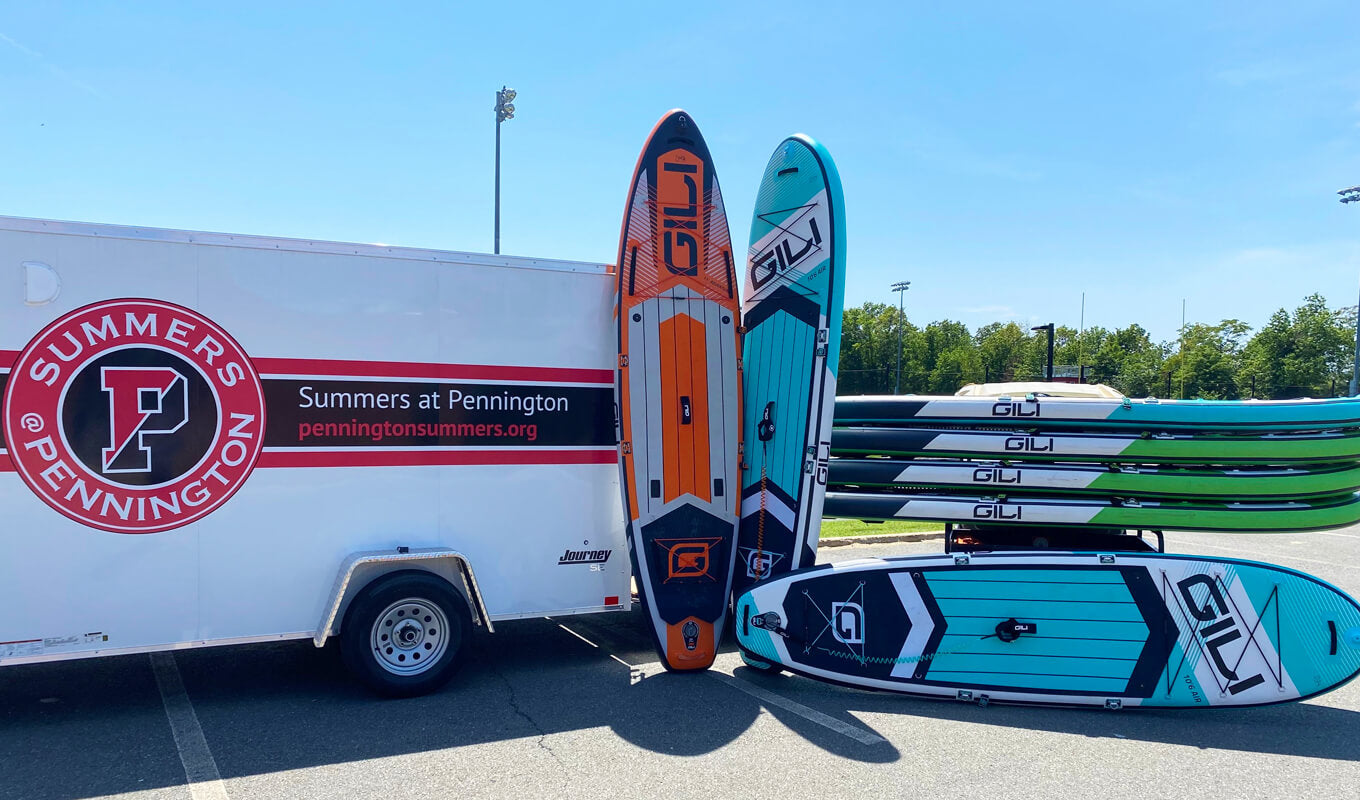
Generally, the best way to transport an inflatable SUP inside a vehicle is in its travel bag, stowed in the trunk or on a seat. When packed in its bag, your entire SUP kit takes up less room than a small suitcase.
On the flipside, if you’ve got a bigger truck or van at your disposal, you’ve got the option of leaving your board inflated. Just remember these key points if that’s the case:
- Never be tempted to force your board into a place it won’t fit, as this could damage its vulnerable edges.
- Leave a few inches around the fins to prevent any bumps or dings.
- If you can’t slide your board into the vehicle without a fight, it’s time to deflate it completely or consider a different carrying method.
- Resist the urge to try bending your board or letting a bit of air out to squeeze it in the vehicle - this can compromise the integrity of your board.
If you’re planning to take public transportation, we recommend you deflate the board and carry it in your iSUP backpack. Here’s some pro tips:
- To keep your board safe from theft or damage, keep it on your person or close by.
- If your iSUP backpack needs to go in storage beneath the bus, wait until last so you can stack your SUP on top of everyone else’s bags and prevent it from being crushed.
Touring distant lands with your inflatable paddle board is a breeze with these easy travel tips. Just deflate your SUP, roll it up like a sleeping bag, and you’re ready to ride. Here’s to new adventures and exploring the world with your GILI paddle board !
Chief Paddler - Jay has been surfing and paddling for over 5 years. When he's not dreaming up new stuff at GILI, he's writing articles about paddling, out paddling, or often traveling.
Leave a comment
Comments will be approved before showing up.
Also in SUP Expert Advice
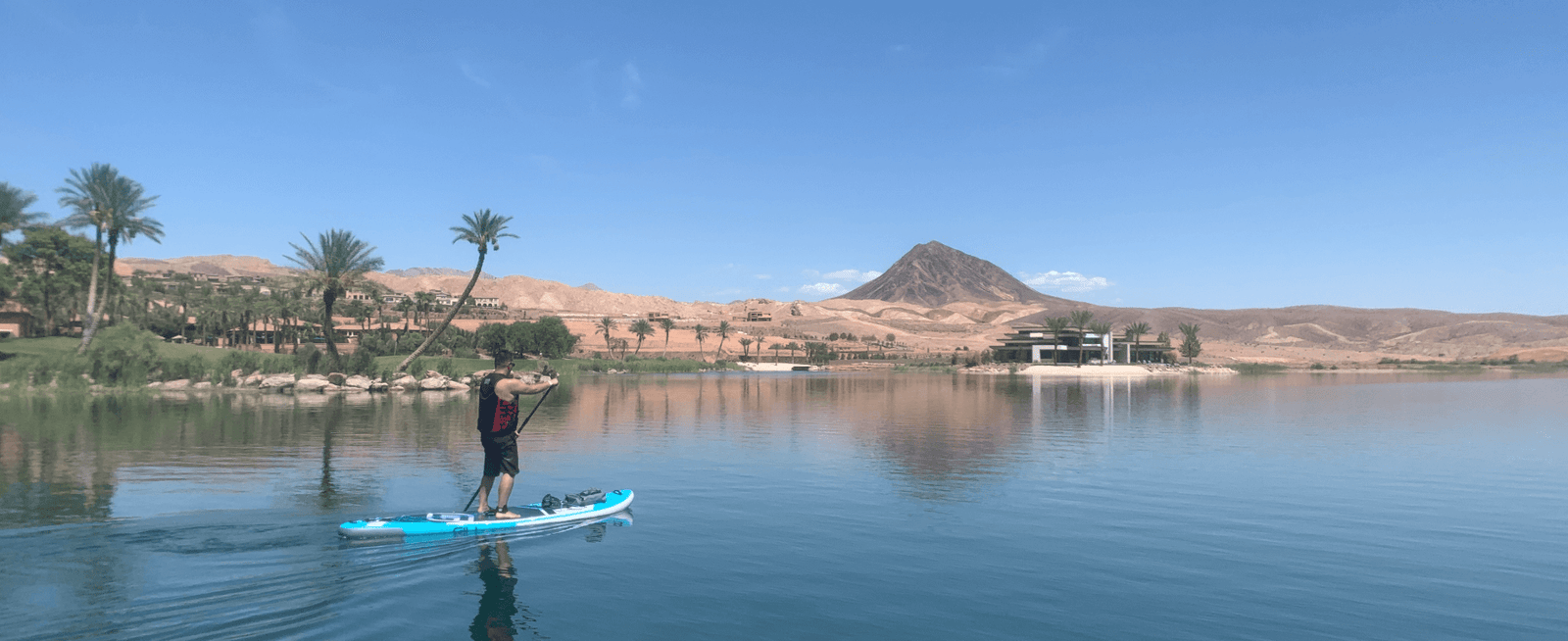
The Best Life Jackets (PFDs) for Paddle Boarding (SUP) in 2024
August 16, 2023 19 min read 2 Comments

How To Choose A Wakesurf Board: A Buyer’s Guide
August 07, 2023 11 min read

20 Unforgettable Things to Do in Myrtle Beach
June 07, 2023 12 min read
- Paddle Board Expert Advice
- Paddle Board Fishing
- Paddle Board Fitness
- Paddle Boarding Near Me
- Paddle Board Yoga
- Gear Guides
- Kayak Expert Advice
- Kayaking Near Me
- Canoe Expert Advice
When you use links on our website, we may earn a fee.
Best Inflatable Paddle Boards of 2024
Stand-up paddle boarding is a great way to get out on the water for exercise and exploration without the need for a lot of skill upfront. The introduction of inflatable stand-up paddle boards (iSUPs) has helped take the sport mainstream, given that inflatable paddle boards are much easier to store and transport than their rigid counterparts. Plus, they can cost hundreds or even thousands less than rigid SUPs, which makes them much more accessible to casual paddlers.
Still, even the cheaper iSUPs cost hundreds, and there are a lot of advertised features and add-ons to consider that can make an iSUP purchasing decision challenging. We talked to several paddle boarding experts and did extensive research to bring you the best inflatable stand-up paddle boards in 2024 for your style of paddling and budget.
Table of Contents
- Best Inflatable Paddleboards
- Things To Consider When Buying
- How We Chose
ISLE Explorer 3 Inflatable Hybrid SUP-Kayak »

High rigidity for better stability and glide
Convertible to kayak
Electric motor-ready
Lightweight
Kayak seat sold separately
Carbon-blend paddle is a bit heavy
For just a bit more than a cheap iSUP, you can get the ISLE Explorer 3, the well-built, just-released version of Isle’s best-selling inflatable paddle board. The rounded nose, 6-inch thickness, flat-planing hull, front and back bungee tie-downs, and single-fin setup are all fairly standard for a beginner to intermediate paddle board built for flat, calmer waters. Where the Explorer 3 differentiates itself is mostly in the build quality.
This newest edition of the Explorer introduces Isle’s AirTech construction, which has trickled down from the Pro series and moves from less-reliable glued seams to welded seams. This beefs up the durability and longevity of the board, which is rare in a board at this price point. That durability is underscored by a warranty that jumps to five years from two years with the release of this new model. At 10’6”, the paddle board is long enough to travel well over moderate distances but nimble enough with a single fin and lighter weight for novices to turn without too much struggle.
One unique feature of the Explorer 3 is the ISLE-LINK system that places webbing loops down the length of either side of the board. These provide all-purpose tie-down points but also the addition of accessories such as ISLE’s kayak conversion kit which adds a seat and foot brace. The Explorer 3 is also electric motor-ready, making this a versatile watercraft that can serve the purposes of a small boat, kayak, and SUP. The Bixpy K-1 motor clips into the fin box and lets you cover distances up to 5 mph without tiring yourself out. We like that ISLE keeps these add-ons optional to keep the initial cost down while giving you the choice to expand the board’s capabilities down the road.
You can also use ISLE-LINK to tether multiple boards together for a flatwater flotilla of chilling, yoga, or sunbathing. The paddle tie-down is also a seemingly minor feature that’s a big help when you just want to hang out and not worry about losing your paddle.
ISLE Pioneer 2 Inflatable SUP »

Affordable starter paddle board
Good all-around shape for beginners
Shorter warranty than updated version
Heavy for the size
If you’re not ready to spend $500+ on an iSUP but still want a high-quality paddle board, the previous edition of ISLE’s top-selling Pioneer board is deeply discounted after the release of the Pioneer 3, our top pick. The Pioneer 2 board dimensions are the same, with a good all-around shape, length, and width for beginners and intermediates looking to explore flat waters. The 34-inch width and 6-inch thickness provide enough stability and float to keep beginners upright, but is also maneuverable thanks to a medium length and single-fin setup.
The biggest differences between this previous edition Pioneer 2 and the updated Pioneer 3 are in the build. The Pioneer 2 weighs 5 pounds more and uses glued seams rather than the more trustworthy welded seams on the Pioneer 3. The warranty reflects this and is only two years, compared to five years on the Pioneer 3. Still, at almost half the cost, this very comparable board will save you a lot of money. It’s a great all-around iSUP from a trusted brand for a price similar to the cheapest options on the market from less reputable manufacturers.
BOTE Rackham Aero Inflatable SUP »

Purpose-built as boat/kayak alternative for fishing
Oversized for maximum stability when loaded up
Can drive with pedals or paddle
Lots of fishing-specific accessories available
Full fishing package is pricey
Bulky/heavy for just paddling around
Although people can fish from kayaks , with the rise in popularity of inflatable paddle boards, anglers have discovered that these simpler watercraft can deliver many of the same benefits in a cheaper, lighter, easier-to-store package.
However, as our contributor Justin Park notes from personal experience, smaller paddle boards don’t have sufficient weight capacity or space for you and your fishing gear. BOTE’s Rackham Aero board is purpose-built with fishing in mind and solves these shortcomings with an oversized platform and lots of smart add-ons. Most noticeably, the board is longer and wider at over 12 feet long and 38 inches wide. It’s also 7 inches thick, which is an inch fatter than most and contributes to the 400-pound maximum weight rating.
One of the key features is compatibility with BOTE’s Apex Pedal Drive system. This lets you ditch the paddle and drive the iSUP with your feet, freeing your hands to fish on the move instead of constantly switching between paddle and pole. (You can get the Apex Pedal Drive and all the fishing add-ons singly or all at once by purchasing the Rackham Fishing Package.)
The add-ons are smartly designed and work together to optimize the fishing experience on the board. The bucket and Bucket Rac provide a seat, cooler for drinks/fish, and rod holders all in one tight package that doesn’t eat up all your space and keeps everything close at hand. The one accessory not included that we recommend out of the gate is an electric pump. The oversized board takes up a lot of space in storage and it also requires a good session of hand-pumping to fill appropriately, so the convenience of the hands-off pump is worth the added cost.
Atoll 11’ Inflatable SUP »

Stable and easy to maneuver
Low initial cost
Durable construction
Low maximum weight, so not suitable for larger riders
Our contributor Justin Park has owned this medium-length all-rounder from Atoll for more than five years. He has found that it’s a durable, stable platform that does a great job of balancing stability with maneuverability. It’s also about as cheap as you can get for an iSUP without sacrificing quality. Because of its inherent balance, this is the board Park lends to friends who want to get out on a paddle board for the first time. The kit also comes with all the basics (aside from a PFD), including an ankle leash, so you’re ready to go out of the box.
When it comes to durability and build quality, Park finds the Atoll to be better than most lower-cost inflatable paddle boards. It's backed by a two-year warranty. Despite the beefy construction, the 315-pound weight limit means the largest riders will want to look at something truly oversized. But for everyone else, the 11-foot Atoll is plenty of board, even with gear loaded on.
Kokopelli Chasm-Lite »

Ultralight for easy carrying
Packs down small
Lifetime warranty
Lower flotation
Easily pushed around in rough water
While any inflatable SUP is going to be much more portable than a rigid board, most are still too bulky and heavy to carry for much more than half a mile. Kokopelli’s Chasm Lite is a purpose-built ultralight iSUP designed for those who want to take their paddling farther and further. At a mere 12.9 pounds, it’s the lightest iSUP you can buy, yet it’s still less than $1000.
The paddle is carbon fiber and disassembles into four short segments. The Nano pump is also tiny. Plus, it all packs neatly into the included waterproof roll-top backpack. This iSUP paddles well for how light and small it is, yet it's still thick enough at 6 inches to keep average-sized paddlers afloat.
The drawbacks are the same as with any lighter inflatable. You’ll want to take extra care not to damage the hull, as it’s thinner than beefy boards not concerned with weight. Park has tested it in choppy waters and wind; it gets pushed around more than heavier boards, and he could feel a bit of bowing underfoot. Still, this paddle board outperforms its specs, and there’s nothing better if portability is a high priority.
NRS Clipper 110 Inflatable SUP »

Displacement hull for better speed and tracking
High PSI for rigidity and power transfer
Quality high-pressure pump
Low maximum weight
No paddle included
Most inflatable stand-up paddle boards are built for casual paddling in relatively calm waters and feature a flat, planing hull built for stability and ease of use. If you want to cover longer distances and maintain speed in rougher waters, you want a displacement hull like the one on the NRS touring-oriented Clipper iSUP. Its hull uses multiple air chambers to create the required shape and is built more like a kayak or boat, which promotes better tracking and speed.
The NRS Clipper approaches rigid paddle board stiffness thanks to the woven drop-stitch construction combined with up to 20 psi inflation, unlike most iSUPs which top out at 12 or 15 psi. The efficient pump (included) helps, although reaching 20 psi requires some muscle and time, and we found it best to leave the board inflated if you can. The board also comes with a travel backpack, repair kit, and two types of interchangeable fins, but you’ll have to purchase a paddle separately.
Bluefin Cruise Carbon 15’ Inflatable SUP »

Large platform for two people
Light weight for the size
Included carbon-fiber paddle
Oversized for solo use
Low maneuverability
Most inflatable SUPs lack the floatation and surface area to comfortably accommodate more than a single paddler. Even solo paddle boards with high maximum weight ratings can feel cramped when you add a friend or dog. By contrast, the oversized, 15-foot-long Cruise Carbon from Bluefin provides room and stability while still allowing enough paddling dexterity for everyone to enjoy the ride. The carbon fiber paddle is a welcome inclusion that makes paddling the larger board a bit easier over the long haul.
Not surprisingly, the Cruise Carbon takes a bit longer to pump up (almost 10 minutes), but luckily the included pump has three inflation stages to minimize the effort. You can also consider an electric pump if you need to inflate and deflate after every use for transport or storage concerns. Despite the size and quality construction, the Carbon Cruise is relatively affordable and comes with a five-year warranty for peace of mind.
The Bottom Line
Inflatable paddle boards are easy to use, easier to store, and more affordable than rigid SUPs, making them a great choice for newer paddlers. They’re at their best on calmer waters, which is where most folks start out with paddleboarding anyway.
Choosing a wide paddleboard with a rounded nose and flat hull, such as our top overall pick the ISLE Explorer 3, will give beginners and intermediates a stable platform that’s easy to maneuver. If you’re looking at iSUPs as a boat replacement for activities like fishing or simply hanging out, consider an oversized specialty paddle board such as the BOTE Rackham Aero.
Things To Consider When Buying an Inflatable Paddle Board
Dimensions and shape: For beginners, the width of the board is the most important dimension to consider, as it has the biggest impact on stability. “Look for a wider, shorter, and thicker board for stability,” says Cameron Butler, a lifelong stand-up paddle boarder and editor of Outdoor Travel & You . “It may seem counterintuitive to go for a shorter board since a longer one would give you slightly better stability, but you are just starting out on the water. The last thing you want is to be exhausted from paddling and having a difficult time turning around or maneuvering around.”
The overall shape of a board gives you clues to its strengths, weaknesses, and intended use. Many entry-level boards have similar builds aimed at beginners and ease of use, with rounded noses, wider platforms, and shorter lengths of around 10 feet for mobility. “A wider board will be better for beginners as it provides a more stable platform,” says Colin Crozier, watersports buyer at Sturtevant’s ( Christy Sports ) who has sold and used SUPs for more than 10 years. “The wider and larger the board the more stable the platform will be from tipping. Most beginners would benefit from a board [that’s] 32-35 inches."
Longer, narrower boards are less stable but are better suited for breaking through rougher water and help you track straighter for faster speeds and more efficient paddling. “A longer board will give a straighter track and are what traditionally paddle boards have been for many decades. These longer boards are ideal for touring coastlines and speed,” says Butler.
Maximum weight capacity: One of the most important specifications to consider is the maximum weight capacity of a board. An inflatable that’s nearing its weight limit will start to bow or “taco” where you stand which can seriously hamper the board’s performance on the water.
Jimmy Blakely, VP of Product at Isle, says that there’s no standardized method of determining the listed weight capacities for iSUPs because of the number of factors that go into how well a board floats under load. Still, these are useful numbers to give a general sense of what a given board can handle and you can use the number to find the right board for you.
“Ensure the board can support your weight plus any gear. A general rule is to choose a board with a weight capacity at least 20% above your weight,” says Cameron Butler, lifelong stand-up paddle boarder and editor of Outdoor Travel & You . Blakely suggests staying 50 pounds below the maximum, based on the largest rider who will be using the board. This gives you room to add gear and keeps you closer to the sweet spot of the board’s load.
Accessories: Most inflatable SUPs come with a paddle, hand pump, repair/patch kit, and storage bag, at minimum and while this is usually enough to get started, there are several accessories to consider purchasing if they’re not included with your board.
Personal Floatation Device (or PFD) , colloquially called a “life jacket”: Butler says this is essential equipment (even if your kids say it’s “uncool”), especially on larger waters that get rough and may have riptides and currents that aren’t obvious. They may also be legally required depending on the body of water.
Leash: Most of the time on calm waters, your board will stay close, even if you have a dramatic fall off into the water. But surf and/or weather can conspire to take your board away from you quickly. Once while surfing in Hawaii, the author had a leash snap and a stiff offshore wind blew the board out to sea, never to be seen again!
Electric pump: If you leave your board inflated most of the time, this may be a luxury, but if you’re inflating and deflating for each use, it’s essential equipment that saves time and your arms. Butler suggests buying an electric pump immediately so that the chore of hand-pumping doesn’t deter you from using the board and utilizing the main advantages of an inflatable which is to deflate to make storage and transport simpler.
Weight and portability: Weight and portability go hand-in-hand and the relatively lighter weights of most inflatables are a major advantage over rigid boards for carrying your SUP to the water and back. Not surprisingly, larger SUPs will be heavier, but keep in mind they are also more unwieldy to carry when inflated. Wider boards, especially, can be challenging and even more so if you’re shorter or have shorter arms. While most iSUPS weigh around 20 pounds or less and are forgiving to carry over short distances, every pound matters more if you intend to haul your board longer distances such as hiking into a remote lake.
If weight is important, there are plenty of lighter boards on the market, but consider the downsides. Boards that prioritize weight savings may go lighter on hull materials which can render them less durable. They can also be pushed around more easily by strong winds and which can be frustrating to paddle in those conditions.
Warranty : For some products, warranties are nice to have but rarely get used. For iSUPs, a brand’s warranty can be a good indicator of the durability of the product over time and is worth considering in your purchase. The drop-stitch construction used in most inflatable SUPs is surprisingly durable—these aren’t glorified pool toys. Still, most boards are produced on assembly lines and are subject to defects just like any mass-produced product, so warranties are a nice insurance policy in the event your board wears prematurely.
Blakely from Isle Surf & SUP said that after switching from glued seams on their board’s rails to welded seams, their warranty claims dropped so significantly that they felt confident extending their warranty period from three years to five years. You can take that as an indication you should look for welded seams in your board, though it’s also evidence that warranties are often directly tied to the reliability of a product.
How We Chose The Best Inflatable Paddle Boards
Our contributor Justin Park consulted watersports experts and paddle board brand product managers to assemble our guide to the best inflatable stand-up paddle boards. These included Jimmy Blakely, VP of product for Isle Surf and SUP ; Cory Crozier, watersports buyer at Christy Sports who has sold and used SUPs for more than 10 years; and Cameron Butler, a lifelong stand-up paddleboarder owner and editor of Outdoor Travel & You .
With dozens of comparable inflatables available, Park filtered the pool of potential options through additional research on brands and models to select our top picks and also weighed his firsthand experience with many of the top models on the market. For each board, he evaluated features such as weight capacity, design, and warranty support. He also compared what sets each model apart from similar offerings in the same category. He only included iSUPs that provide great value for the class they fall within, rather than ones at the high end of the price spectrum.
WHY YOU SHOULD TRUST US
Justin Park is an experienced outdoor equipment expert specializing in snow sports, biking, watersports, and backpacking equipment. His award-winning journalism has appeared in national magazines, newspapers, and digital outlets from Popular Mechanics to Men’s Journal. He has tested and reviewed dozens of inflatable SUPs over the past 10 years and paddles weekly during the short summers near his home in Breckenridge, Colorado.
The first stand-up paddle boards were hardboards, built as essentially oversized surfboards made rigid by fiberglass or epoxy shells. These boards were, and often still are, expensive. Inflatables generally cost less than rigid boards, though many rigid boards now compete with inflatables on price, especially with higher-end inflatables.
The biggest advantage of inflatables for most beginner and intermediate paddlers heading out on relatively flat waters is the portability factor. Most SUPs are 10 feet or longer, making them difficult to transport on smaller vehicles at full size. They also create a storage issue in smaller living spaces, so the ability to deflate them makes it much easier to store them when not in use. The best inflatables today come close to the rigidity and performance of a hardboard, but if you're an advanced rider, especially one who wants to surf on your SUP, you’ll likely be looking at rigid boards.
The proper size board for you will depend on two main factors: the weight rating and length. Blakely, VP of Product at Isle, told us that maximum weight capacity tries to reflect displacement of water and depends in large part on the volume of air inside the board. However, because shape and other factors complicate matters, there’s no standardized method of determining the listed weight capacities for iSUPs.
Still, these are useful benchmarks and you’re ideally not pushing the weight limit on a board. If you’re within 50 pounds of the listed weight limit, you’re better off looking for something with a higher weight rating. Length affects performance and intended use. Longer, narrower boards are better for speed and longer tours while shorter, wider boards provide more stability for beginners and activities such as SUP yoga.
When it comes to durability, first and foremost, look for a longer warranty period. Not only does this give you a sense of how much a company stands behind its product, but it also provides insurance against the chance you get a lemon. No matter the level of quality control, there is always a chance of a manufacturer defect in the production process and because those defects can lead to an inflatable board not holding air, it’s important to be able to get a refund or replacement. Most iSUPs use a similar drop-stitch construction and while each will make claims about the durability of their particular proprietary process, you’re reliant on their claims to compare durability between brands.
A good basic practice to prolong the life of your board is to wash it after use, especially after exposure to saltwater, and store it out of direct sunlight in a cool dark place. Inflatable SUPs can safely be stored either inflated or deflated, but if storing deflated and rolled up, try not to roll the board too tightly. Blakely from Isle recommends rolling the board up fin-side out with accessories in the middle; this prevents too tight of a roll which can create creases in the material over time and create weak spots in the board's hull. If storing long-term while inflated, release pressure down to about 1-2 PSI.
Using a PFD, or personal flotation device , is always good practice for any watersports and any ability level and may be required depending on the jurisdiction where you’re paddling. If you’re paddling in cold waters, a wetsuit may be preferred to swimsuits in case you end up in the water. Especially for those who aren’t strong swimmers, an ankle leash can be a helpful accessory to make sure your SUP stays close in the event of a fall off your board.
About Our Team
Justin park.
Contributor

Jeff Kinney
Senior Editor
U.S. News 360 Reviews takes an unbiased approach to our recommendations. When you use our links to buy products, we may earn a commission but that in no way affects our editorial independence.

- Sports & Outdoors
- Water Sports
- Stand-Up Paddleboarding
- Stand-Up Paddleboards
Add to your order

- No Additional Cost: You pay nothing for repairs – parts, labor, and shipping included.
- Coverage: Plan starts on the date of purchase. Drops, spills and cracked screens due to normal use covered for portable products and power surges covered from day one. Malfunctions covered after the manufacturer's warranty.
- Easy Claims Process: File a claim anytime online or by phone. Most claims approved within minutes. If we can’t repair it, we’ll send you an Amazon e-gift card for the purchase price of your covered product or replace it.
- Product Eligibility: Plan must be purchased with a product or within 30 days of the product purchase. Pre-existing conditions are not covered.
- Terms & Details: More information about this protection plan is available within the “Product guides and documents” section. Simply click “User Guide” for more info. Terms & Conditions will be available in Your Orders on Amazon. Asurion will also email your plan confirmation with Terms & Conditions to the address associated with your Amazon account within 24 hours of purchase.
- Buy a lot of stuff on Amazon? Tons of items eligible for coverage, from the latest tech like laptops, game consoles, and TVs, to major appliances, sporting goods, tools, toys, mattresses, personal care, furniture, and more.
- Accidents happen. That’s why for your portable products we cover accidental damage from handling such as drops, spills and cracked screens. We also cover electrical and mechanical malfunctions, power surges, and wear and tear.
- Past and future purchases covered. 30 days after you are enrolled, all eligible past purchases (up to 1 year prior to enrollment) and future eligible purchases made on Amazon will be covered by your plan as long as you are enrolled.
- Fast, easy claims. Frustration-free claims, with most filed in minutes. We will fix it, replace it, or reimburse you with an Amazon e-gift card for the purchase price of your product (excluding tax). File at Asurion.com/amazon.
- No hidden fees. For just $16.99 a month + tax you’re covered for up to $5,000 in claims per 12-month period. *THIS PROGRAM IS MONTH-TO-MONTH AND WILL CONTINUE UNTIL CANCELED* Coverage for all products ends 30 days after the plan is canceled. Cancel any time.
2 Year Sporting Goods Protection Plan
Asurion complete protect: one plan covers all eligible past and future purchases on amazon.

Image Unavailable

- To view this video download Flash Player
BOTE Wulf Aero Inflatable Stand Up Paddle Board Kit Includes Accessories Adjustable Paddle iSUP Travel Bag Blow Up Pump Safety SUP Velcro Leash Multiple Sizes
Purchase options and add-ons, about this item.
- Explore the WULF Aero Inflatable Paddle Board by BOTE - a beginner-friendly, lightweight board with MAGNEPOD compatibility for ultimate water adventures.
- Dimensions: 10′4″ L × 34″ W × 6″ D
- Capacity: 250 LBS
- Board Weight: 20 LBS
- One (1) WULF Aero 10′4″ Inflatable Paddle Board One (1) 3-Piece Adjustable Aluminum SUP Paddle One (1) Coiled Leash One (1) Removable 10″ Aero Center Fin One (1) Aero Hand Pump One (1) Fabric Backpack Travel Bag
Frequently bought together
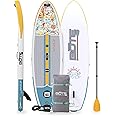
Top rated similar items

From the brand

BOTE Inflatable Paddle Boards

Visit the Store

BOTE Inflatable Kayaks

BOTE Docks & Floats

BOTE Inflatable Seating

BOTE Aero Seating

BOTE SUP & Kayak Accessories

BOTE PFD's

KULA & MAGNEPod

Product Description
Wulf aero wildly fun, impressively tough.
We've given it killer aesthetics that combine with functional innovation to create a very stable, lightweight, easy to paddle and most importantly great looking inflatable paddle board.
The Wulf is our new entry vessel to this lifestyle at a very affordable price.

LIGHTWEIGHT & PORTABLE
AeroULTRA technology means that it only weighs around 20 pounds.

SUPREMELY STABLE
33” width makes it easy for anyone to jump on.

FUN BEACH COMPANION
Use the included leash to stay connected to your board while paddling the shoreline.

MADE WITH AEROTECH
Our portable, highly durable Aero inflatable technology lets you take adventure with you wherever you go.
MEET THE LINEUP
Product information, technical details, additional information, videos for this product.

Click to play video

BOTE Wulf Aero MAGNEPod Compatible SUP
Looking for specific info, customer reviews.
Customer Reviews, including Product Star Ratings help customers to learn more about the product and decide whether it is the right product for them.
To calculate the overall star rating and percentage breakdown by star, we don’t use a simple average. Instead, our system considers things like how recent a review is and if the reviewer bought the item on Amazon. It also analyzed reviews to verify trustworthiness.
Customers say
Customers like the quality and stability of the paddleboard. They mention that it's a great beginner board and is sturdy.
AI-generated from the text of customer reviews
Customers are satisfied with the quality of the paddleboard. They mention that it is a great beginner board at a reasonable price.
"... Love the design ." Read more
" This board is amazing and easy to balance on with its wider body. Excellent for you and your kid and dogs! Plenty of room!" Read more
" Great product , good quality. It didn’t take us long to set it up." Read more
" This board is amazing and design is very pretty. Highly recommend buying an electric pump for it…saves a lot of time and effort...." Read more
Customers find the paddleboard very stable, sturdy, and easy to inflate. They also say it's wide and great for fun.
"Obsessed with this board! Very stable being wide and great for exercise!..." Read more
"My first time buying a SUP and love how light weight and stable it is...." Read more
"Had so much fun .. sturdy , lightweight and easy to inflate and deflated !" Read more
Reviews with images

- Sort reviews by Top reviews Most recent Top reviews
Top reviews from the United States
There was a problem filtering reviews right now. please try again later..
- Amazon Newsletter
- About Amazon
- Accessibility
- Sustainability
- Press Center
- Investor Relations
- Amazon Devices
- Amazon Science
- Sell on Amazon
- Sell apps on Amazon
- Supply to Amazon
- Protect & Build Your Brand
- Become an Affiliate
- Become a Delivery Driver
- Start a Package Delivery Business
- Advertise Your Products
- Self-Publish with Us
- Become an Amazon Hub Partner
- › See More Ways to Make Money
- Amazon Visa
- Amazon Store Card
- Amazon Secured Card
- Amazon Business Card
- Shop with Points
- Credit Card Marketplace
- Reload Your Balance
- Amazon Currency Converter
- Your Account
- Your Orders
- Shipping Rates & Policies
- Amazon Prime
- Returns & Replacements
- Manage Your Content and Devices
- Recalls and Product Safety Alerts
- Conditions of Use
- Privacy Notice
- Consumer Health Data Privacy Disclosure
- Your Ads Privacy Choices
Press Herald
Account Subscription: ACTIVE
Questions about your account? Our customer service team can be reached at [email protected] during business hours at (207) 791-6000 .
- Arts & Entertainment
Fear you’ll never hear your favorite band live? These Maine tribute shows might do the trick
See homages to David Bowie, Prince, The Cure and The Rolling Stones in Portland this week, and other shows coming this summer.

You are able to gift 5 more articles this month.
Anyone can access the link you share with no account required. Learn more .
With a Press Herald subscription, you can gift 5 articles each month.
It looks like you do not have any active subscriptions. To get one, go to the subscriptions page .
Loading....
If you’ve never seen a tribute act perform the songs of artists that are either too big to play in Maine or who have passed away, there’s a way to do a whole bunch of that this week in Portland.
There are also tribute shows happening in venues around the state all summer long.

A Strange Day is the Portland-based tribute to The Cure. Photo by Seth D. Warner
Let’s start with Portland-based A Strange Day, a tribute to British alternative act The Cure, fronted by singer and guitarist Seth Warner.
The band will perform The Cure’s second album, “Seventeen Seconds,” in its entirety, along with some hits and other cuts at Portland House of Music on Thursday.
The album was released on April 18, 1980. Lead singer and guitarist Robert Smith turned 21 three days later. The single “A Forest” marked the band’s debut on the U.K. Singles Chart, where it reached the No. 31 spot. The song remains a setlist staple at The Cure’s live performances.
Warner said he put himself in the shoes of Cure fans when deciding what album to cover. “What I would like to hear from a Cure band is a dive into the specific eras that surrounded each record, and ‘Seventeen Seconds’ set the tone for the more introspective and gloomy textures and themes.” Advertisement
As for Warner’s favorite “Seventeen Seconds” tracks, he said, “I really like ‘At Night’ for its dynamic potential, and the edgy and angsty ‘M.'”
The band took its name from the track “A Strange Day” from The Cure’s 1982 album “Pornography.”
Along with Warner, the band is Pete Dugas (keys), Andrew Hodgkins (drums), Matt Kennedy (synth/sax), Kevin O’Reilly (bass), Casey Urich (trumpet) and Corey Urich.
Angel Butts, a copy editor living in Westbrook, has seen The Cure more than 100 times on three continents and at least 10 countries, including Latvia and Colombia. “They’re like breathing to me. They have this massive catalog and it spans every possible mood, I don’t know of another band with a palette like that. “Seventeen Seconds” is among her favorite of the band’s 13 studio albums.
Butts has seen The Cure play the “Seventeen Seconds” album all the way through three times. “One of those shows stands as the best show I’ve ever seen in my life. The Cure: Reflections, Nov. 27, 2011 at the Beacon Theatre in New York City.”
Butts said she and her 13-year-old daughter will be attending the A Strange Day show. “I think she’s more excited than I am.” Advertisement
A Strange Day 8:30 p.m. Thursday. Portland House of Music, 25 Temple St., Portland, $12 in advance, $15 day of show, 21-plus. portlandhouseofmusic.com
Another British act that will likely never perform in Maine is The Rolling Stones. With more than 30 albums, the band achieved legendary status decades ago. Singer Mick Jagger and guitarist Keith Richards are both 80, and the band is currently on tour and will be at Gillette Stadium in Foxboro, Massachusetts, on Thursday.
There are still tickets left for that show, but you can save yourself hours of traffic jams and a lot of more by instead heading to Aura on Saturday to see Satisfaction: The International Rolling Stones tribute show. Or maybe you’ll see the real deal and then keep the party going here in Maine.
Satisfaction has been slinging Stones hits for over two decades and has played more than 4,000 shows. Chris LeGrand’s take on Mick Jagger is pretty convincing, and he and the band will surely be pleased to meet you.
Satisfaction: The International Rolling Stones Tribute Show 9 p.m. Saturday. Aura, 121 Center St., Portland, $15, $25.50, 18-plus. auramaine.com

The Prince/Bowie tribute act performing live. Photo by Tammie Birdwell
David Bowie and Prince died within five months of each other in 2016, at the ages of 69 and 57, respectively, and their losses were felt by millions of fans around the world. Advertisement
With contributions that are impossible to quantify, both artists left behind a legacy of music that lives on through radio play, home listening and tribute shows.
Boston-based musician Eric Gould loves both artists and is the bandleader of a Prince/Bowie tribute coming to Portland on Saturday. The band is a revolving lineup of players from all over the country.
Gould plays bass and designs the setlists. For this show, the musicians are Cal Kehoe (guitar, vocals), Adrian Tramontano (drums), Sammi Garrett (percussion, vocals), Josh Schwartz (baritone sax, vocals), Rob Somerville (tenor saxophone), Rob Volo (trombone) and Kiran Edwards (keys).
Gould said that, to him, Prince embodies soul, creative arrangement and precision. “His music has the best energy and makes you feel on top of the universe.”
He described Bowie as having a voice and character that is completely unique.
“It is powerful and epic and decadent,” said Gould, who has made a career out of finding unique connections through the songbooks of artists. “It is such a treat to present music people know and love in a way that is fresh to the ears. This combination brings so much joy to everyone on and off stage.” Advertisement
Prince/Bowie 8 p.m. Saturday. Portland House of Music, 25 Temple St., Portland, $25, 21-plus. portlandhouseofmusic.com
Other upcoming tribute shows
The Peacheaters: An Allman Brothers Band Experience, Friday. Jonathan’s, Ogunquit, $31 to $72.50. jonathansogunquit.com
Sweet Baby James: James Taylor Tribute, Saturday. Vinegar Hill Music Theatre, Arundel, $30 to $45. vinhillmusic.com
Studio Two: The Early Beatles Tribute, June 9. Vinegar Hill Music Theatre, Arundel, $30, $35. vinhillmusic.com
Magic Bus: A Tribute to The Who, June 14. Vinegar Hill Music Theatre, Arundel, $30. vinhillmusic.com Advertisement
The The Band Band, June 21. Vinegar Hill Music Theatre, Arundel, $45, $55. vinhillmusic.com
Bruce In The USA, June 21. Aura, Portland, $20 to $39.50. auramaine.com
Elvis Tribute Show, June 22, July 20. Jonathan’s, Ogunquit, $29 to $70. jonathansogunquit.com
Higher Ground: A Tribute to Stevie Wonder, July 20. Vinegar Hill Music Theatre, Arundel, $40. vinhillmusic.com
Studio Two: The Early Beatles Tribute, July 6. Jonathan’s, Ogunquit, $41.50 to $82.50. jonathansogunquit.com
Johnny Cash Tribute Show, July 7, Aug. 10. Jonathan’s, Ogunquit, $29 to $70. jonathansogunquit.com Advertisement
Rose Alley: A Tribute to Jerry Garcia, June 28. Vinegar Hill Music Theatre, Arundel, $23. vinhillmusic.com
Runnin’ Down A Dream: The Tom Petty Tribute Band, July 13, Nov. 14. Jonathan’s, Ogunquit, $35 to $76. jonathansogunquit.com
The Elton John Experience, July 21. Jonathan’s, Ogunquit, $29 to $79. jonathansogunquit.com
Zach Nugent’s Dead Set, Aug. 1. Vinegar Hill Music Theatre, Arundel, $25. vinhillmusic.com
The Stray Horses, Aug. 8. Vinegar Hill Music Theatre, Arundel, $25. vinhillmusic.com
Wake Up Mama: The Allman Brothers Tribute Band, Aug. 24. Vinegar Hill Music Theatre, Arundel, $25. vinhillmusic.com
Success. Please wait for the page to reload. If the page does not reload within 5 seconds, please refresh the page.
Enter your email and password to access comments.
Forgot Password?
Don't have a commenting profile? Create one.
Hi, to comment on stories you must create a commenting profile . This profile is in addition to your subscription and website login. Already have a commenting profile? Login .
Invalid username/password.
Please check your email to confirm and complete your registration.
Create a commenting profile by providing an email address, password and display name. You will receive an email to complete the registration. Please note the display name will appear on screen when you participate.
Already registered? Log in to join the discussion.
Only subscribers are eligible to post comments. Please subscribe or login first for digital access. Here’s why .
Use the form below to reset your password. When you've submitted your account email, we will send an email with a reset code.
Send questions/comments to the editors.
‘American Idol’ star Julia Gagnon to pursue a career in music, starting with a Maine tour
In camden, a story of wealthy neighbors, ocean views and over $1.7 million in fines, right-wing protest banner adds new wrinkle to maine flag referendum, cracking the ‘recode’ that could decide portland’s housing future, brunswick starts overhaul of downtown sidewalks, sparking concern among businesses, member log in.
Please enter your username and password below. Already a subscriber but don't have one? Click here .
Not a subscriber? Click here to see your options

IMAGES
VIDEO
COMMENTS
Best Touring Stand Up Paddle Board: Red Paddle Co Sport 11'3". Best Ultralight/Packable Paddle Board: Kokopelli Chasm-Lite. Best Stand Up Paddle Board/Kayak Hybrid: Tahe 10'6" Beach SUP-Yak + Kayak Kit. Best Multi-Person Paddle Board: Gili 15' Manta Ray.
Best Overall, Runner-up: ROC Inflatable Stand Up Paddleboard Pack at Amazon ($600) Jump to Review. Best Budget: FunWater Stand-up Paddle Board at Amazon ($270) Jump to Review. Best Stability ...
Best Overall: Surftech Lido Stand Up Paddle Board With Paddle at REI ($955) Jump to Review. Best Budget: Pau Hana Malibu Classic Stand Up Paddle Board at REI ($629) Jump to Review. Best ...
The most unique travel bag design we've seen is the one made by Red Paddle Co., which comes with the MSL 10′ 6″ Ride SUP. Great for minimal approach hikes, the SUP offers the option to fully ...
In short, this well-constructed, 19.8 lb SUP is a great investment for paddlers looking to travel with a high-performance SUP, but don't want to be bogged down with a large, heavy gear bag. 2. Red Paddle Co. 11'/9'6 Compact ( See Full Review) Check Prices. Pros.
The paddle is also designed to fit into a smaller bag. With a regular inflatable paddle board, you typically get a 3-piece paddle. With a compact board, you get a travel paddle that breaks down into 4 or 5 pieces. The boards are typically lighter and thinner than a standard paddle board.
The 6 Best Stand Up Paddle Boards of 2024. We bought and tested SUP boards from Surftech, Boardworks, Starboard, SIC Maui, and more to find the very best. By Sara James and Marissa Fox. Wednesday March 13, 2024. After researching scores of stand up paddle boards, we bought 8 of the best models currently available for this competitive lineup. We ...
iRocker All-Around 11' Ultra: Best All-Around Compact iSUP. 11'0" x 31" x 6" | 21.6 lbs. Bag Size: 21"x16"x10" | Kit Weight: 33.3 lbs. Read Full Review Here. Check Price. The iRocker All-Around 11' Ultra iSUP earns our pick for the Best All-Around Compact iSUP because it does a fantastic job of balancing size, weight ...
Best stand-up paddleboard for yoga. Glide 02 Lotus Inflatable SUP. $899. Inflatable | Yoga | 10' x 35" x 6"| 400-pound capacity. To confidently practice your Vinyasa flow on the water, your ...
Best inflatable paddle board. ISLE Pioneer 2.0. $445 at ISLE. View details. $700 at iRocker. Best paddle board for travel. iRocker 10' All Around Ultra. $700 at iRocker. View details.
Best Inflatable Standup Paddleboards. Best Overall SUP: BOTE HD Aero. Best Budget SUP: ROC Paddle Board. Most Portable SUP: iROCKER All-Around Ultra. Best Stability SUP: RETROSPEC Weekender Plus ...
On-Water Performance. Being a touring board, the Red Paddle Compact 12 will be the best on the list for tracking and its glide due to its 12' length and slender frame. Its stability is not half bad either though as it maintains the 32" "All Around" width and 12' frame will make the board stable enough.
How to Travel With an Inflatable Stand Up Paddle Board (iSUP) One of the best perks of owning an inflatable SUP is, of course, the fact that you can travel with it. Their incredible portability and durable construction mean inflatable boards are made for exploring anywhere you want to go. Inflatable paddle boards are m
At 10'6", the paddle board is long enough to travel well over moderate distances but nimble enough with a single fin and lighter weight for novices to turn without too much struggle.
We considered packability, comfort, and manageability while testing. Credit: Jenay Aiksnoras. The lightest boards in our lineup are the ROC Inflatable SUP, FunWater 11, and Badfish Flyweight, weighing just 17 to 19 pounds. The Isle Switch and the Bote Breeze Aero follow closely behind.
We bought and tested SUP paddles from Werner, Kialoa, Aqua Bound, NRS and others to discover which are the best for your next aquatic adventure. By Jenay Aiksnoras and Marissa Fox. Tuesday April 16, 2024. We've evaluated dozens of SUP paddles over the last 7 years with 13 of the market's top options in this review.
This item: BOTE Wulf Aero Inflatable Stand Up Paddle Board Kit Includes Accessories Adjustable Paddle iSUP Travel Bag Blow Up Pump Safety SUP Velcro Leash Multiple Sizes . $424.15 $ 424. 15. Get it May 31 - Jun 5. Only 9 left in stock - order soon. Ships from and sold by BOTE. +
Price not available. #1. South Bay Universal Inflatable Paddle Board/iSUP Bag. The South Bay Universal inflatable paddle board bag is designed by surfers and paddlers with attention to detail and the needs of those in the paddle board community. The bag is very durable and roomy.
Moscow Oblast ( Russian: Моско́вская о́бласть, Moskovskaya oblast) is a federal subject of Russia. It is located in western Russia, and it completely surrounds Moscow. The oblast has no capital, and oblast officials reside in Moscow or in other cities within the oblast. [1] As of 2015, the oblast has a population of 7,231,068 ...
Elektrostal is a city in Moscow Oblast, Russia, located 58 kilometers east of Moscow. Elektrostal has about 158,000 residents. Mapcarta, the open map.
Elektrostal. Elektrostal ( Russian: Электроста́ль) is a city in Moscow Oblast, Russia. It is 58 kilometers (36 mi) east of Moscow. As of 2010, 155,196 people lived there.
In 1938, it was granted town status. [citation needed]Administrative and municipal status. Within the framework of administrative divisions, it is incorporated as Elektrostal City Under Oblast Jurisdiction—an administrative unit with the status equal to that of the districts. As a municipal division, Elektrostal City Under Oblast Jurisdiction is incorporated as Elektrostal Urban Okrug.
A Strange Day 8:30 p.m. Thursday. Portland House of Music, 25 Temple St., Portland, $12 in advance, $15 day of show, 21-plus. portlandhouseofmusic.com